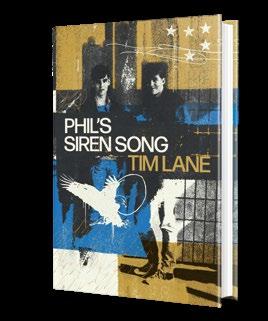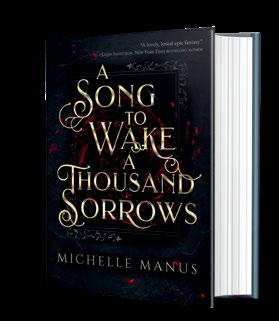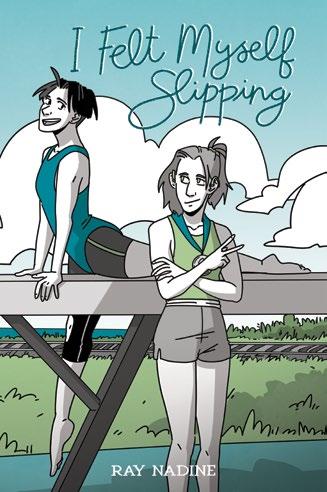FEATURING 337 Industry-First Reviews of Fiction, Nonfiction, Children’s, and YA Books



FEATURING 337 Industry-First Reviews of Fiction, Nonfiction, Children’s, and YA Books


The artist and author headlines a special issue dedicated to graphic literature
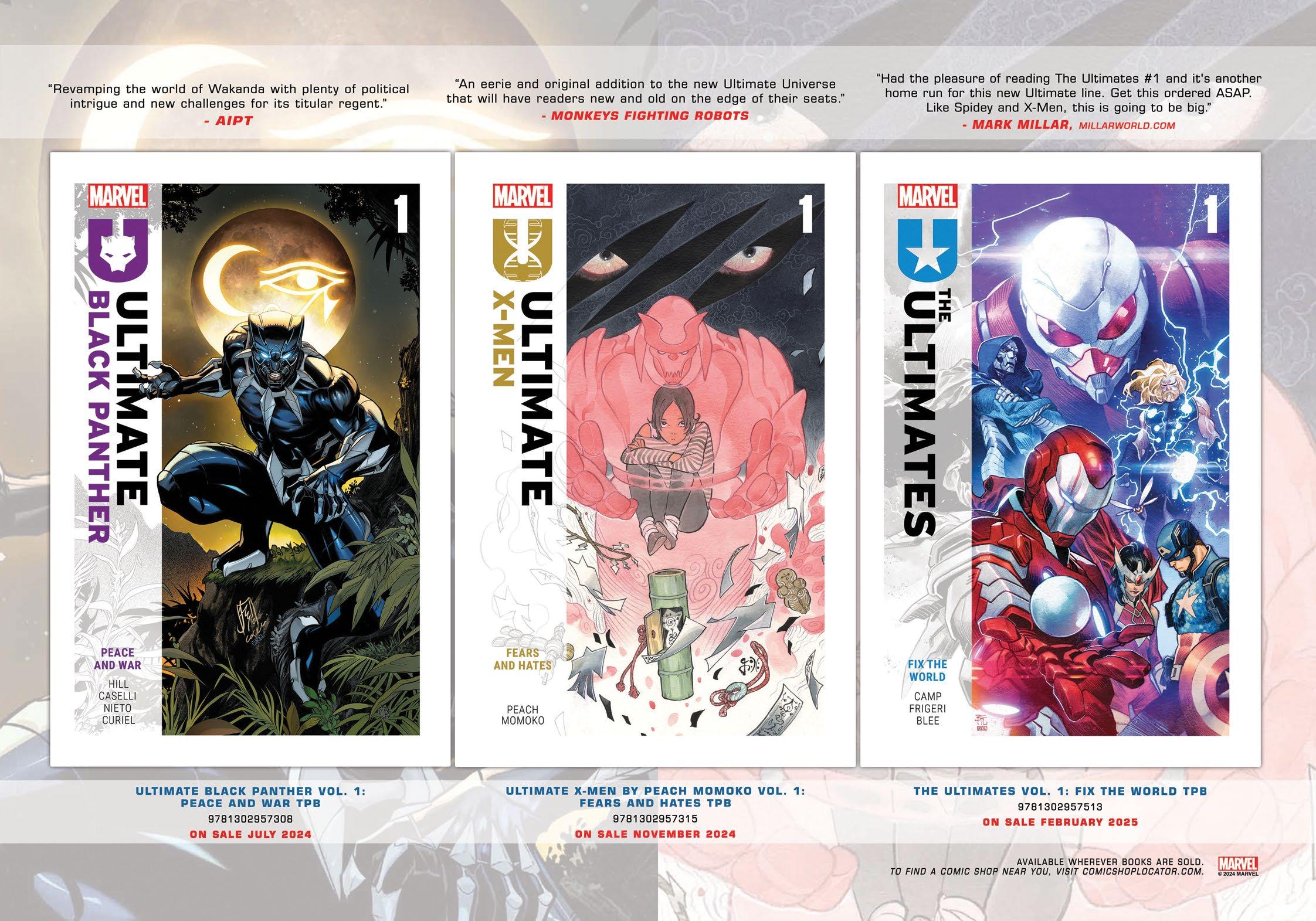


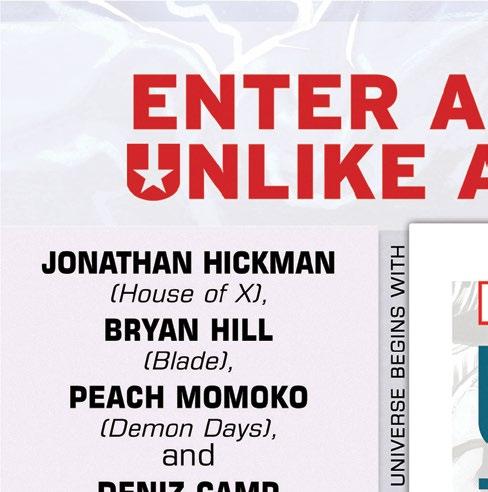








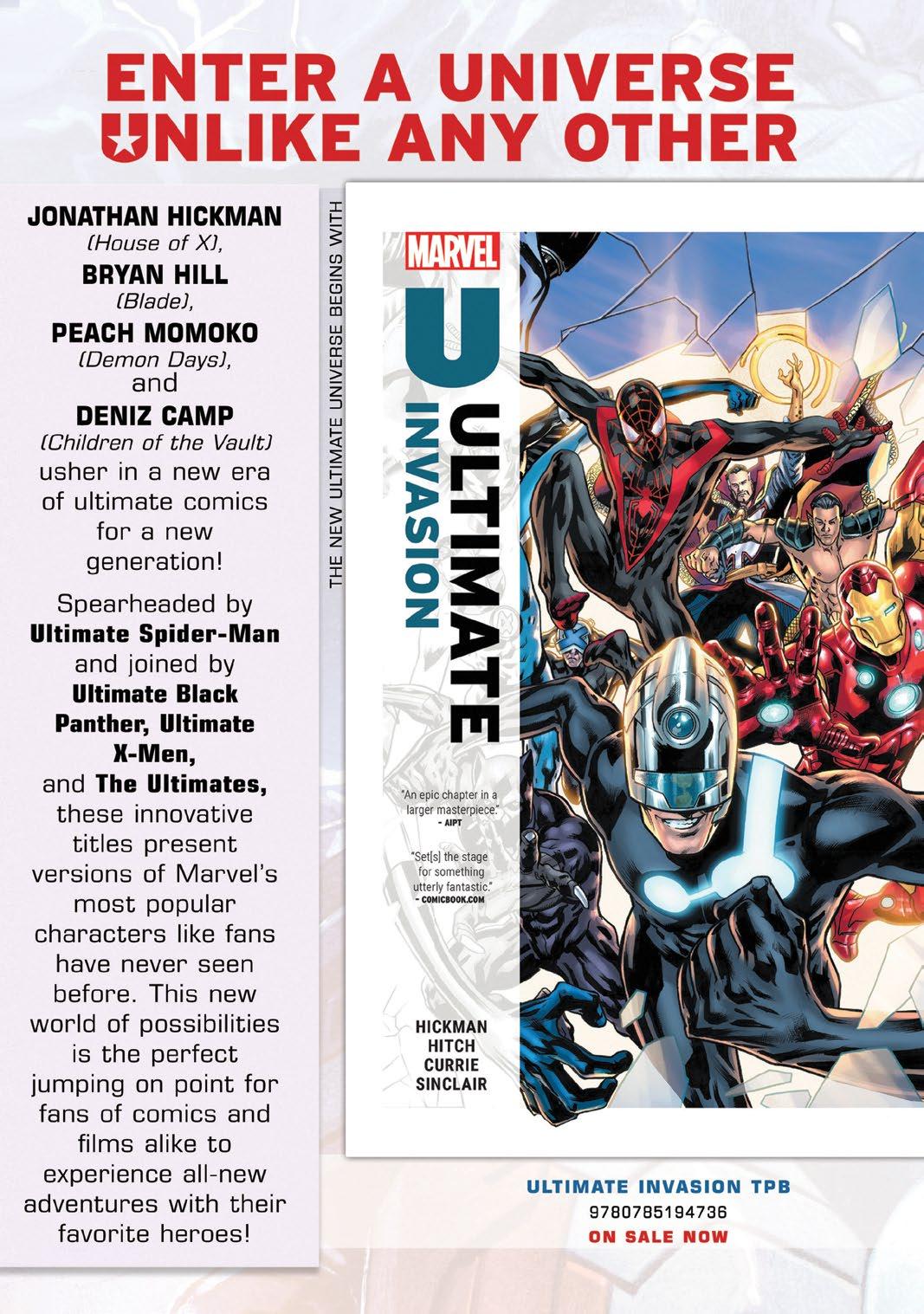




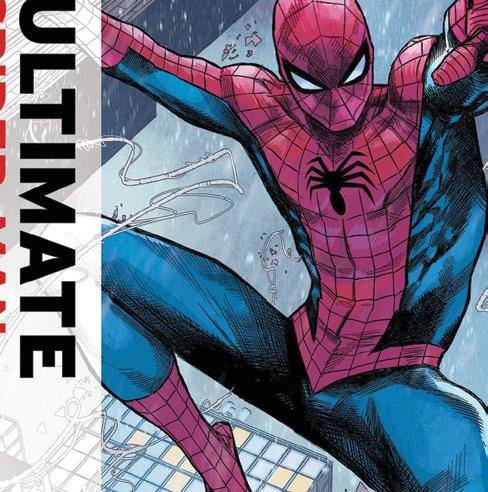




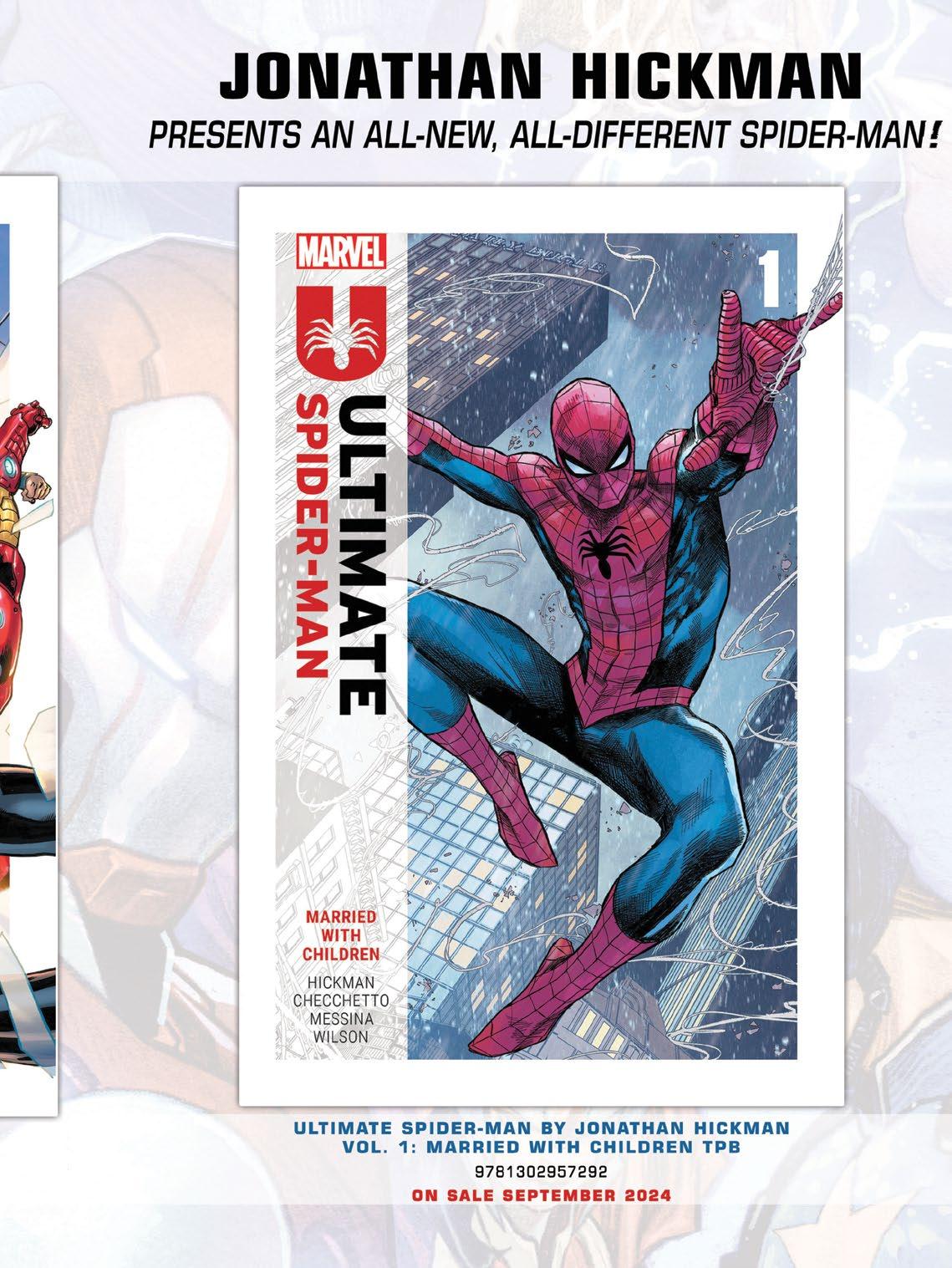


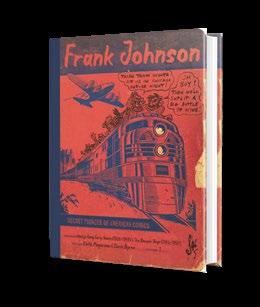
FANS OF GRAPHIC literature have waited a long time for My Favorite Thing Is Monsters: Book Two (Fantagraphics, May 28), the conclusion to Emil Ferris’ 2017 debut, a thematically rich, visually stunning work that seemed destined to take its place alongside classics such as Maus and Fun Home The book is framed as the diary of Karen Reyes, a young queer girl growing up in 1960s Chicago who imagines herself as a werewolf while setting out to solve the murder of her upstairs neighbor, a troubled Holocaust survivor. I can’t even begin to do justice to the swirling, densely crosshatched artwork done in ballpoint pen on notebook paper. Monsters is simply the kind of book that people obsess over—just go check it out, if you haven’t already.
Which is to say that when we began planning our second annual Graphic Lit Issue this spring, there was really only one choice for the cover. When Emil Ferris agreed to contribute a never-before-published self-portrait for the cover—werewolf included!— that just sealed the deal. You can read Ferris’ interview with contributor Connie Ogle on page 12, which includes the exciting revelation that there’s already a prequel to Monsters in the works.
Elsewhere in the issue you’ll find interviews with artist/ authors John Vasquez Mejias, Johnnie Christmas, and Maia Kobabe, whose debut graphic memoir, Gender Queer, remains one of the most challenged books in America—testimony to the singular (and, for some, threatening) power of storytelling in words and pictures. Our editors
Frequently Asked Questions: www.kirkusreviews.com/about/faq
Fully Booked Podcast: www.kirkusreviews.com/podcast/
Advertising Opportunities: www.kirkusreviews.com/book-marketing
Submission Guidelines: www.kirkusreviews.com/about/publisher-submission-guidelines
Subscriptions: www.kirkusreviews.com/magazine/subscription
Newsletters: www.kirkusreviews.com
For customer service or subscription questions, please call 1-800-316-9361

also highlight outstanding new graphic literature for all ages in their columns and booklists.
While the format grows with such innovative new work, there’s also been an overdue push to recognize the artistry of comics past. One of the most thrilling additions to the graphic lit canon is Frank Johnson, Secret Pioneer of American Comics: Volume 1, edited by Keith Mayerson and Chris Byrne (Fantagraphics, Feb. 24).
Johnson was a genuine outsider artist who began drawing a comic called “Wally’s Gang” in 1928, when he was just 16; he worked variously as a musician and shipping clerk while continuing the comic, drawn in pencil in ruled notebooks, for 50 years. It was never published—and quite possibly never seen by anyone—until Johnson’s death in 1979. The new book collects the “Wally’s Gang” comics from 1928 to 1949, along with a stand-alone called “The Bowser Boys” (1946-1950), about some Bowery bums on a perpetual
quest for the next bottle of wine—an underground comic avant la lettre, as Mayerson observes. I can’t wait for future volumes.
Meanwhile, a mainstream cartoonist like Ernie Bushmiller (1905-1982)— whose “Nancy” comic strip has remained in print since 1938—is increasingly recognized as an artistic pioneer whose style had an impact on everyone from Andy Warhol to Joe Brainard. “Nancy” has now been collected in multiple volumes, the latest being Nancy & Sluggo’s Guide to Life: Comics About Money, Food, and Other Essentials (New York Review Comics, May 14), which finds the frizzy-haired kid and her foil hustling for the better things in life. The volume highlights the ingenious simplicity of this beloved, occasionally reviled, strip, which seemed to formulate the elemental vocabulary of comics as it went.







Co-Chairman
HeRBeRT SIMON
Publisher & CEO
MeG LABORDe KUeHN mkuehn@kirkus.com
Chief Marketing Officer
SARAH KALINA skalina@kirkus.com
Publisher Advertising & Promotions
RACHeL WeASe rwease@kirkus.com
Indie Advertising & Promotions
AMY BAIRD abaird@kirkus.com
Author Consultant
RY PICKARD rpickard@kirkus.com
Lead Designer KY NOvAK knovak@kirkus.com
Kirkus Editorial Senior Production Editor
ROBIN O’DeLL rodell@kirkus.com
Kirkus Editorial Senior Production Editor
MARINNA CASTILLeJA mcastilleja@kirkus.com
Kirkus Editorial Production Editor ASHLeY LITTLe alittle@kirkus.com
Copy Editors
eLIZAB e TH J. ASBORNO BILL SIeveR
Magazine Compositor
NIKKI RICHARDSON
Contributing Writers
GReGORY MCNAMee MICHAeL SCHAUB
Co-Chairman MARC WINKeLMAN
Editor-in-Chief TOM BeeR tbeer@kirkus.com
President of Kirkus Indie CHAYA SCHeCHNeR cschechner@kirkus.com
Nonfiction Editor eRIC LIeBeTRAU eliebetrau@kirkus.com
Fiction Editor LAURIe MUCHNICK lmuchnick@kirkus.com
Young Readers’ Editor LAURA SIMeON lsimeon@kirkus.com
Young Readers’ Editor MAHNAZ DAR mdar@kirkus.com
Editor at Large MeGAN LABRISe mlabrise@kirkus.com
Senior Indie Editor DAvID RAPP drapp@kirkus.com
Indie Editor ARTHUR SMITH asmith@kirkus.com
Editorial Assistant NINA PALATTeLLA npalattella@kirkus.com
Indie Editorial Assistant DAN NOLAN dnolan@kirkus.com
Indie Editorial Assistant SASHA CARNeY scarney@kirkus.com
Mysteries Editor THOMAS LeITCH

Colleen Abel, Reina Luz Alegre, Jeffrey Alford, Paul Allen, Kent Armstrong, Heather Rose Artushin, Mark Athitakis, Diego Báez, Nada Bakri, Audrey Barbakoff, Robert Beauregard, Elizabeth Bird, Sarah Blackman, Amy Boaz, Jessie Bond, Elissa Bongiorno, Hannah Bonner, Kimberly Brubaker Bradley, Nastassian Brandon, Susan Breitzer, Jessica Hoptay Brown, Justina Bruns, Cliff Burke, Jeffrey Burke, Timothy Capehart, Catherine Cardno, Hailey Carrell, Tobias Carroll, Charles Cassady, Alec B. Chunn, Amanda Chuong, Tamar Cimenian, Carin Clevidence, Caridad Cole, Rachael Conrad, Emma Corngold, Jeannie Coutant, Perry Crowe, Maya Davis, Michael Deagler, Dave DeChristopher, Elise DeGuiseppi, Steve Donoghue, Anna Drake, Gina Elbert, Lisa Elliott, Ilana Bensussen Epstein, Joshua Farrington, Katie Flanagan, Cynthia Fox, Mia Franz, Ayn Reyes Frazee, Jenna Friebel, Robbin Friedman, Nivair H. Gabriel, Elisa Gall, Maura Gaven, Carol Goldman, Danielle Galván Gomez, Melinda Greenblatt, Valerye Griffin, Vicky Gudelot, Tobi Haberstroh, Geoff Hamilton, Peter Heck, Lynne Heffley, Loren Hinton, Zoe Holland, Katrina Niidas Holm, Natalia Holtzman, Julie Hubble, Kathleen T. Isaacs, Kristen Jacobson, Wesley Jacques, Jessica Jernigan, Betsy Judkins, Mikayla Kaber, Maya Kassutto, Ivan Kenneally, Katherine King, Stephanie Klose, Lyneea Kmail, Andrea Kreidler, Carly Lane, Christopher Lassen, Tom Lavoie, Hanna Lee, Judith Leitch, Donald Liebenson, Maureen Liebenson, Elsbeth Lindner, Coeur de Lion, Barbara London, Patricia Lothrop, Mikaela W. Luke, Kyle Lukoff, Isabella Luongo, Kaia MacLeod, Michael Magras, Thomas Maluck, Joe Maniscalco, Collin Marchiando, Emmett Marshall, Michelle H Martin, Gabriela Martins, J. Alejandro Mazariegos, Dale McGarrigle, Zoe McLaughlin, Don McLeese, Kathie Meizner, Tara Mokhtari, Clayton Moore, Lisa Moore, Andrea Moran, David Moscovich, Liza Nelson, Mike Newirth, Mimi Nguyen, Therese Purcell Nielsen, Sarah Norris, Katrina Nye, Tori Ann Ogawa, Mike Oppenheim, Nick Owchar, Andrea Page, Derek Parker, Sarah Parker-Lee, Hal Patnott, Deb Paulson, John Edward Peters, Jim Piechota, Christofer Pierson, Vicki Pietrus, Shira Pilarski, Margaret Quamme, Kristy Raffensberger, Darryn Reams, Caroline Reed, Stephanie Reents, Amy Reiter, Nancy Thalia Reynolds, Jasmine Riel, Alyssa Rivera, Erica Rivera, Kelly Roberts, Lizzie Rogers, Gia Ruiz, Lloyd Sachs, Bob Sanchez, Meredith Schorr, Gretchen Schulz, Gene Seymour, Karyn N. Silverman, Linda Simon, Margot E. Spangenberg, Mo Springer, Allison Staley, Allie Stevens, Jenn Strattman, Mathangi Subramanian, Jennifer Sweeney, Desiree Thomas, Renee Ting, Lenora Todaro, Jenna Varden, Katie Vermilyea, Christina Vortia, Francesca Vultaggio, Elliott Walcroft, Kerry Winfrey, Marion Winik, Livia Wood, Bean Yogi, Jean-Louise Zancanella
EVEN NOW, 38 years after the publication of Art Spiegelman’s Maus , there are still people who think that graphic novels are less serious than nonillustrated fiction or that they’re just for kids. But when you add illustrations to text, a whole new level of artistry is possible, as proven by some of the wonderful books that have come out this year.
In The Jellyfish (Pow Pow Press, May 1), author and illustrator Boum uses the gelatinous creature as a stunning metaphor for her own vision problems. The book opens with Odette, a young Montreal woman, sitting in an ophthalmologist’s office as she’s told, “Miss Biset-Yu, it seems you do in fact have a

jellyfish in your left eye.”
The next page shows a small jellyfish floating over Odette’s head, and in the pages that follow it’s hovering around, sometimes on top of her hat, other times seeming to watch her go about her life—working at a bookstore, taking care of her pet rabbit, and beginning a relationship with a woman named Naina. Then the jellyfish starts growing.
“Boum’s startling use of perspective and her placement of the jellyfish that float through every page…create a near perfect symbiosis between narrative and art,” according to our starred review.
Leela Corman’s Victory Parade (Schocken, April 2) is an Expressionist look at

life in Brooklyn’s Jewish community during World War II. Rose Arensberg works as a riveter in a shipyard and finds some happiness in the bed of a veteran who lost his leg in the war that her husband is still fighting; she lives with her daughter, Eleanor, and Ruth, a refugee from Nazi Germany who channels her anger into professional wrestling. Rose dreams of death and dismemberment, with legs floating through the air. “Corman’s figures are striking, with angular bodies and faces, the latter punctuated by downturned lips and enormous eyes ringed by darkness,” according to our starred review. “Vivid watercolors enhance the uncanny atmosphere, hues spilling and pooling into visceral shapes and strata.”
David Small is best known for children’s books, but Stitches , a graphic


memoir of his difficult childhood, was a bestseller in 2009. Now he’s written The Werewolf at Dusk (Liveright, March 12), a book of three graphic short stories that explore the monsters lurking in a trio of older men. The title story is based on a short by Lincoln Michel and begins with a man recalling the way he used to wake up in strange places, covered with blood.
“That was a long time ago,” he says. Now he’s an old man who can’t keep up with a squirrel, let alone run through the city with the legs of a wolf—but he’s still scared of himself.
“Small’s linework is striking in its expressiveness and energy, figures and forms leaping across the page while eyes and lips simmer with emotion,” our starred review says. “Broad patches and layers of color imbue the illustrations with a gorgeous painterly quality.”
Coming this month is Rescue Party (Pantheon, July 23), an anthology of 140 comic strips created at the height of the Covid-19 pandemic, edited by Gabe Fowler. Our starred review calls it “an invaluable time capsule and an arresting expression of the human condition.”

Laurie Muchnick is the fiction editor.
The latest graphic novel from Burns follows a group of young white suburban friends, centering on the sputtering relationship between a warm, friendly redhead and the awkward artist making her the focus of his new story.
Brian would rather sit in the kitchen and draw tentacled aliens than join the party out in the front room. But when Jimmy, his longtime home-movie collaborator, casts Laurie, a new addition to their friend circle, in their next 8 mm film, Laurie’s warmth and beauty tempt Brian to step out of his mind and fully into the present. Brian’s art (ranging from the uncanny to the explicit) and fleeting moments of connection between them keep Laurie in Brian’s orbit, and the
story alternates between their perspectives, capturing both Laurie’s sense of isolation when Brian gets lost in his appreciation for and creation of movies and Brian’s bittersweet awareness of his drifting, ever-creating mind. As Brian attempts to translate the strange visions in his head (and sketchbook) into a science fiction film shot with friends at a secluded cabin, he sinks deeper into his cinematic escapism while Laurie engages with more immediate pleasures. An aura of horror infuses the pages, with bulbous aliens floating through blue skies and raining down mysterious capsules, dead-eyed stares and skipped medication setting nerves on edge, and time’s unyielding march robbing

even pleasant moments of lasting significance. Burns’ clean lines, heavy shadows, and rich colors sumptuously convey the pebbled texture of alien flesh and the rolling waves of Laurie’s hair, while his dialogue and narration crisply capture everything from flirty, friendly banter to awkward and painful self-analysis. His paneling swiftly moves
the story along, through both slice-of-life moments and fantastical worlds, occasionally juxtaposing character moments with shots from the films Brian loses himself in, evoking the massive gap between fixation and passion.
A striking celebration of cinema’s power and a chilling acknowledgment of its limitations.
Aitken, Molly | Knopf (304 pp.) | $28.00 Sept. 10, 2024 | 9780525658399

A novel set in 13th- century Ireland detailing the life of the first woman in that country to be convicted of witchcraft. Everyone in Kilkenny knows Alice Kyetler. Her father, an innkeeper and a lender, has passed his business onto her. As a woman banker, she is shrewd; as a marriage prospect, she is intimidating, with her independence and fearlessness. Eventually she marries William Outlaw, another moneylender, with whom she has a son and a daughter. Outlaw is no match for the fiery Alice—he lacks interest in her, especially sexually, much to her impatience—and when their daughter dies, a shattered Alice’s eyes begin to rove elsewhere. After Outlaw himself dies, Alice moves from one wealthy husband to the next, each one dying under circumstances that set the rumor mill humming, eventually culminating in an unprecedented accusation that will change history forever. For those who have read books like Madeline Miller’s Circe or Natalie Haynes’ Stone Blind, the story’s contours are familiar, at least at first: A woman with a bit too much power, pride, and ambition gets put in her place by a society all too eager to uphold conventions. But Aitken herself eschews convention: The historical novel, usually stuffed with worldbuilding and contextual detail, here unfolds via a lyric impressionism, moving like skipped stones through Alice’s life from girlhood to old age. As the novel hits the middle of Alice’s story, these stones skip faster, upping the tension. And unlike, say, Circe, Alice is less a misunderstood woman than, like many of history’s greatest figures, villain and victim in one, complex and elliptical. “Did you never wish to know what it is to be ordinary, unseen?” Alice is asked as a young woman. “No, and I certainly never will,” she replies. An incredible medieval life rendered in incandescent flashes.
Kirkus Star
Alam, Rumaan | Riverhead (288 pp.)
$30.00 | Sept. 17, 2024 | 9780593718469
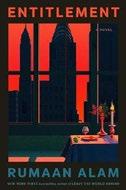
A billionaire philanthropist’s ambitious young protégé wants her slice of the pie. Whereas Alam’s previous book, Leave the World Behind (2020)—a National Book Award finalist and the basis for a Netflix film—focused on cataclysmic external threats, his new novel explores a threat from within: ambition. Or maybe that’s not quite right, because the blinding ambition of Alam’s protagonist, Brooke Orr, a Vassar-educated Black woman raised in New York City by a mission-driven white mother, is shaped by the world in which she finds herself and is propelled by its inequities. After years in an unrewarding teaching job at a Bronx charter school, Brooke, 33, takes a job as a program coordinator at 83-year-old white billionaire Asher Jaffee’s charitable foundation and is embraced as his protégé. But once Brooke has been welcomed into Asher’s place of privilege, she believes she is entitled to all it can provide: the designer clothes, the fancy meals, a space to call her own, and, more than anything, the power to change lives, to save souls. As Brooke makes increasingly ill-advised decisions, the tension slowly and compellingly builds toward a dizzying conclusion that feels both surprising and inevitable. Here, as always, Alam’s facility for vividly setting a scene or finding just the right detail or metaphor, his ability to journey inside the minds and emotions of a range of people, and his willingness to unflinchingly and insightfully address issues of race, class, gender, and age are on full display. An exploration of the ways that access or proximity to money can dramatically shift perspective and skew purpose, identity, and behavior, the novel considers a question central to today’s America: If money equals
freedom, what does that mean for people who don’t have it?
Cements Alam’s status as a talented truth-teller willing to tackle tough issues with grace, generosity, and sensitivity.
Alharthi, Jokha | Trans. by Marilyn Booth | Catapult (272 pp.) | $27.00 Aug. 13, 2024 | 9781646222070

The latest novel from Alharthi— winner of the International Booker Prize for Celestial Bodies (2019)—explores the lives of three Omani women. The story starts with a nursing mother literally dropping her infant daughter in a moment of shock and grief. The baby is rescued by another villager, Saada, who nurses her with her own daughter, Asiya. Called Ghazaala, or Gazelle, the baby grows up as Asiya’s “milk-sister,” always preferring her foster mother Saada’s household over her own. Then a twofold tragedy strikes, rendering Asiya motherless; she departs the village without saying goodbye, disappearing from Ghazaala’s life. As in the justly celebrated and more ambitious Celestial Bodies, Alharthi employs a circular, layered approach to storytelling. The narrative moves forward and backward in time, sometimes dizzyingly, and covers the lives of many characters. Much of the book is in third person, though one thread is narrated by Ghazaala’s university friend Harir. Obsessed by the memory of a mysterious girl who was briefly her neighbor, Harir unwittingly comes into possession of the truth about the tragedy still haunting Ghazaala. Alharthi mines rich material with her details of Omani history, like the country’s system of ancient canals and the fortunes once made in pearls; Asiya’s drunkard father tells the girls about ghosts in the abandoned mansions of former pearl magnates: “the divers
whose lungs had exploded in the depths of the Gulf...the boat captains who’d been weighed down by debt... the English consul, wearing his dust-laden chest medals...the slaves whose backs had been broken by the heft of the pearl caskets.” Other sections are less compelling, like Ghazaala’s unhappy pursuit of men who remain unavailable and opaque. A book about searching for love—both parental and romantic—and reckoning with the past.
Kirkus Star
Almodóvar, Pedro | Trans. by Frank Wynne | HarperVia (240 pp.) | $26.00 Sept. 24, 2024 | 9780063349766

The noted Spanish director delivers a series of contes à clef, giving his merrily transgressive takes on life a good literary workout.
“This collection of stories (I call everything a story, I don’t distinguish between genres) demonstrates the intimate relationship between what I write, what I film, and what I live,” writes Almodóvar, the creator of films such as All About My Mother and Women on the Verge of a Nervous Breakdown. The declaration is a touch cryptic, but what follows is often strange and sometimes shocking, as with his opening story, “The Visit,” in which the putative sister of a man molested by priests in boyhood confronts one of them; he accuses her of dressing like a prostitute, to which she retorts, “I don’t particularly like the way you dress either.” For those who know Almodóvar’s films, the surprise ending won’t come entirely as a surprise. In another story, an actor, León, desperate for a project, contemplates a top-to-bottom rewriting of the classic L’Amore, Roberto Rossellini’s adaptation of a play by Jean Cocteau, its star the luminous Anna Magnani; in León’s vision, it will
Sometimes surreal, sometimes prurient, sometimes discomfiting.
THE LAST DREAM
become a love story between men: “The lover is bisexual....Bisexuality is the great neglected topic of the sexual revolution.” It doesn’t play out. Perhaps the most eccentric tale portrays an aristocratic vampire who comes calling on, again, a priest whose blood flows after self-flagellation; says the vampire, who could have sunk his teeth into the scenario but professes no interest in “vampirizing,” “I am like your mystics; I like to be alone, left to follow my own devices and desires.” Jesus, Barabbas, the singer Chavela, Isabella and Ferdinand, and, yes, the vampire all show up in these oddly delightful stories, no one doing quite what they’re expected to do.
Sometimes surreal, sometimes prurient, sometimes discomfiting— and every page worth reading.
Attenberg, Jami | Ecco/ HarperCollins (240 pp.) | $28.00 Sept. 24, 2024 | 9780063039841
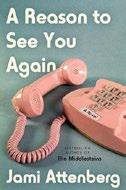
Attenberg follows the women of one family for almost four decades, exploring how each woman’s selfimage and ambitions impact—and are impacted by—the others.
In 1971, the Cohens spend Saturday nights as a family playing Scrabble in suburban Chicago. Ailing Holocaust survivor Rudy loves his family but maintains a separate, private life. His wife, Frieda, struggles with anxiety and insecurity. Mild-natured 16-yearold Nancy knows she will always be
less special than her brilliant, emotionally intense sister, 12-year-old Shelly. With Rudy’s early death a few years later, the family splinters. Frieda moves to Florida and spirals into alcoholic poverty. Shelly becomes a rising star in Seattle’s tech startup world. Nancy quits college to have a baby, embracing the debatable security of a shaky marriage. Careerist Shelly cannot relate to defensively domestic Nancy, and both avoid contact with troubled Frieda. In the years that follow, the women’s professional and emotional trajectories twist and turn in predictable yet sometimes surprising ways. Nancy’s daughter, Jess, grows into a young woman more comfortable in her skin (literally, given her tattoos) than her forebears and becomes their point of connection. While Attenberg organizes the narrative around vaguely ironic subject headings—“Affairs,” “Emergencies,” etc.—her message is clear: Belonging to a family can be redemptive, whatever its deficiencies. Sexual identity and secrecy are other major themes. Undercurrents of romantic love between women sprout and flourish, while male characters fare badly. Only Rudy, whose homosexuality remains a secret until uncovered by Shelly and a delighted Jess years after his death, is lovable. The straight men are detestable. Both Nancy’s husband and Shelly’s boss do considerable harm thanks to “wandering dick disease.” Shelly’s husband is an obnoxious irrelevance. Attenberg can be harsh; her wry authorial voice creates an emotional distance even from the women, as do her occasional asides telegraphing the future. But the vicissitudes of her characters are undeniably absorbing.
A sometimes sweet, sometimes bitter take on family dynamics.
Balibrera, Gina María | Pantheon (368 pp.)
$28.00 | Aug. 20, 2024 | 9780593317235
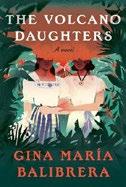
A captivating rendition of early-20th-century El Salvador.
Graciela and her four closest friends grow up on a coffee plantation nestled on a volcano, surrounded by the “joyful ferocity” of their mothers’ love. Their lives on the estate are simple but vibrant. They think little of men, including their fathers, until a man from the capital comes looking for Graciela. Her absent father was the second-in-command and spiritual adviser to the ambitious general referred to as El Gran Pendejo, and he has died. She is summoned to the capital to pay her respects and there meets her long-lost sister, Consuelo, who was kidnapped from their village by her father as a gift for his barren wife. Both now trapped under the thumb of the general, the two reluctantly grow close until El Gran Pendejo, who has bloated into a full-fledged dictator, unleashes unspeakable terror on the nation’s Indigenous population. The inhabitants of their home village are massacred, including Graciela’s childhood friends, who narrate this tale from beyond the grave. In prose that, while supple, does not stray from the harshness of history, the voices of these four murdered girls unite in a ghostly chorus to project the story of their friend and her sister, survivors of genocide. Their visions of Graciela and Consuelo are riveting; the two women, both striking characters, build physically separate but spiritually linked lives in California and Paris in the 1930s. Balibrera eulogizes the lives lost in La Matanza, the real-life 1932 massacre of the Pipil people by the Salvadoran government, and underscores the value of holding one’s culture close, even when it threatens to disrupt just-scarring wounds. Despite the singular narratives sanctioned by those in power, “every myth, every story, has at least two versions,” and “if you don’t
Ardent and intimate, a novel of physical and psychological vistas.
MAMMOTH
tell it properly, if you say it too quietly, you erase everyone’s face as you go.” The resilience of sisterly bonds forms the backbone of this swirling, heart-wrenching debut.
Baltasar, Eva | Trans. by Julia Sanches And Other Stories (144 pp.) | $17.95 paper Aug. 6, 2024 | 9781916751002
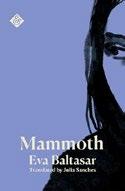
A young woman leaves Barcelona in search of the identity she believes she can find only in isolation.
On her 24th birthday, the narrator of this finely observed novel orchestrates a gathering that is “actually a fertilization party in disguise.” Since she was in college, she’s lived in an airy Barcelona apartment where she can hear the lions’ “ancient, roaring sorrows” from their cages in the nearby zoo, and now she works in a university position interviewing the elderly for a sociology study on longevity. Her colleagues view the data processing software they use in their work as an intermediary “spiritual guide” that will lead them to miracles of comprehension, but the narrator is overcome by “the desire to gestate, to have life course through [her] body, to create.” When her anonymous birthday coupling—her first with a man— doesn’t result in a pregnancy, she decides that, like the zoo animals, she is living her life in a cage. Thus, in “a rusty old Peugeot the size of an egg carton,” she sets off on a journey that takes her ever farther from the epicenters of human society until she ends up
at Cal Llanut, an isolated farmhouse high in the mountains where she feels she will finally find the solitude she needs to live “cleaved to the rock like a root, sucking up nutrients until every finger, every tooth, every last one of [her] thoughts is worn through.”
Meanwhile, her desire to have a child is as strong as ever, and those twin impulses—to isolate and to increase— fuel her in the pursuit of a kind of life that befits the austerity and self-reliance of her new landscape. At turns dazzling and brutally bitter, this slender volume refuses to clarify its intentions but rather allows its major themes an uneasy coexistence similar to the one the main character forges for herself. While this decision may frustrate readers looking for a comprehensive outcome to the speaker’s experiment in radical self-determination, Baltasar’s startling, poetic prose continues to sing long after the book has come to its indeterminate conclusions.
Ardent and intimate, a novel of physical and psychological vistas.
Barton, Fiona | Berkley (400 pp.)
$29.00 | Aug. 27, 2024 | 9781984803078

Three women seek the truth about a murder in the Sussex town of Ebbing for three very different reasons. When hairdresser Karen Simmons is found dead in Knapton Wood the morning after her latest search for likely men at the Neptune pub, it falls to DI Elise King, still recovering from
her mastectomy and chemotherapy, to investigate. At the same time, Kiki Nunn, a feature reporter for Sussex Today, sees the case as her ticket back from puff pieces to real journalism. The two women, who’ve already tangled on earlier crimes, work at cross purposes, with Kiki stirring pots Elise wants left alone and going public with information Elise wants to keep secret. Elise’s inquiries will uncover unlovely revelations about Noel and Evelyn Clayton, who found the body, and Ash Woodward, the quiet handyman who was sweet on Karen. And Kiki’s decision to flesh out her investigation of the Band of Brothers—who boast online of their conquests of the women they hold in contempt—by dipping herself into the online dating pool will have harrowing complications of its own. Karen’s murder proves even more devastating for nurse turned receptionist Annie Curtis, who’s never recovered from the killing of her firstborn son, Archie, in Knapton Wood 16 years ago. Though the police swiftly arrested Nicky Donovan, a pedophile who killed himself in custody, for Archie’s murder, Annie is agonized both to feel the old wound being ripped open and to be racked by the unbearable suspicion that Nicky was innocent and Archie’s killer is still at large. A compelling demonstration of the sad truth that there’s no neutral way to conduct a murder investigation. Everybody pays.
Bassett, Janelle | Univ. of Nebraska (196 pp.) $19.95 paper | Sept. 1, 2024 | 9781496240330
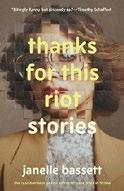
An acerbic examination of family and femininity. The stories in this collection plumb the performance of womanhood. Daughters, wives, girlfriends, and caretakers writ large
reflect on their prescribed familial roles, their bodies, their professions, or their solitude with dry wit. Broken into three sections—“External Riots: Threats and Violence,” “Internal Riots: Secrets and Lies,” and “Laugh Riots: Growing and Trying”—the book grapples with what it means to come of age, as well as understand oneself, within a still very gendered world. In the opening short story, “More Restrictive Than Supportive,” the narrator’s controlling mother warns her at every opportunity that she may be kidnapped. As a result, “my wildest private daydream was to walk down the aisle of fake flowers at Joann Fabrics, alone, imagining that the plastic flowers were catcalling me while demeaning me passive-aggressively, like those golden afternoon blooms from Alice in Wonderland .” In “Full Stop,” a housewife joins a voice actor to drive to Jefferson City to protest the most recent abortion ban. Rather than enraged or emboldened by the political mission, the jaded narrator palpably feels the futility of their efforts. “[My sign] was surrounded by signs that said ‘TRUST WOMEN,’ which in our present circumstances seemed like an advanced directive. Perhaps we should have started with ‘SEE WOMEN’ and worked upward from there.” In “Safe Distances,” a mother goes through her closet with her daughter though she’d “rather not admit to my child that, for me, distance is the key to closeness.” In all of Bassett’s narratives, there is a tension between knowing someone versus being known, seeing versus understanding. Though characters may make attempts at community building or closeness, there remain the persistent, prevalent internal riots that make people strangers to others—and to themselves.
Stories that will amuse and entertain fourth-wave feminists.

Bellinger, DeMisty D. | Univ. of Nebraska (164 pp.) | $21.95 paper Sept. 1, 2024 | 9781496241306

For more fiction reviews, visit Kirkus online.
Stories that center on the mundane— and yet richly observed— lives of marginalized people. In many of Bellinger’s stories, nothing particularly notable occurs. Or rather, what occurs is commonplace and deeply, tenderly human. These often very brief stories are not concerned with grand, sweeping plots or unexpected twists; instead, they mine the complex, often fraught relationships between characters. In one story, a violinist’s “one-day stand” leads her to reflect on past relationships; in the story “Awesome Everywhere,” a widow grieving the loss of her husband to suicide begins an affair with the mother of a girl in her daughter’s high school play. In “Jubilee,” Bellinger studies a cautious mother who dresses her daughter in baggy clothes and keeps her hair short so as not to attract unwanted male attention. Often, these stories stand at the intersection of identity: Many characters are both Black and queer, and subtly confronting their places in a society that is wary of them. In one particularly poignant story, a young Black professor struggles to establish herself at a small and predominantly white college; she doubts and second-guesses each action, worrying about how she will come across to white people—if she leaves the door of her office closed, will colleagues think her standoffish and unfriendly? At their best, these stories illuminate the prosaic lives of their characters, exposing both anguish and hope. Generally written with gentle clarity, though sometimes veering into enigmatic lyricism, Bellinger’s prose is honest and unflinching.
A thoughtful, observant collection of short stories from an important voice.
Blas, Terry & Matty Newton | Illus. by Lydia Anslow | Oni Press (208 pp.) | $19.99 paper
Aug. 13, 2024 | 9781637154540
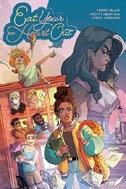
An aspiring young fashionista leaves Idaho in pursuit of her dream in this graphic novel. Blanca has just graduated from high school, but her controlling mother already has her whole future mapped out for her. This plan starts with business school and does not end with Blanca working as a fashion designer, which is what she wants for herself. So, while her mom’s out of town at a real estate conference, Blanca runs away and heads to…New York, of course. She quickly discovers that New York is a tough town—especially for someone who’s not a fast walker by nature—but she gets a break when a guy at a coffee shop notices her sketching. Soon, she’s living in a brownstone full of men, most of them gay and most nurturing dreams as big as Blanca’s. Emile is saving up for cooking school. Evan has a plan for revitalizing the bar where he performs as Thai Dishes. Andy just wants to figure out who he is. Brady hopes to make it as a photographer— and to hook up with the house’s one bona fide success, a model named Nic. Meanwhile, Blanca’s mother is searching for her. And our heroine’s realization that her new boyfriend might not be who—or what—he says he is adds a note of drama. Anslow’s artwork is fun, and there’s a one-page panel set in the American Museum of Natural History that is absolutely terrific. Aguirre’s colors are as vibrant as the imagery is dynamic. The writing is lively, and it’s nice to see that the authors didn’t feel the need to translate the Spanish; instead, they let context and pictures help those who don’t know the language. And if there’s a special award for inventing drag queen names, Blas and Newton deserve it for “Salvador Dalí Parton.”
Spirited and inclusive, this is a fresh take on the coming-of-age tale.
Burns, Edward | Seven Stories (240 pp.) $27.95 | Sept. 10, 2024 | 9781644214077
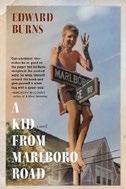
Memories of the cusp of adolescence, delivered with a strong dose of Irish Catholic storytelling. Filmmaker and actor Burns sketches out the events of a summer during which his fictional (perhaps!) narrator encounters change almost everywhere he looks. The 12-year-old son of Catholic parents who have moved from the city to Gibson, a Long Island suburb, he’s painfully aware of the transformation that his older brother, Tommy, underwent when he became a teenager. He fears becoming the same sort of asshole himself. Torn between his strong bond with his parents, particularly his melancholic mother—who notices and rues all signs of change in the family, the neighborhood, the world—and a wish for independence and time with friends, Burns’ young raconteur relates family history and personal obstacles, trying to make sense of it all. A grandfather’s funeral offers the narrator an opportunity for a trial run at storytelling but the effort is only moderately successful—it wasn’t a funny story but he’s allowed to stay at the grown-up post-wake festivities anyway. A last-minute effort at writing a poem for religion class has better results and garners approval at school as well as a prize (but also the opportunity to be ridiculed by classmates). A dawning awareness of his mother’s unhappiness and a subtle deterioration in his parents’ relationship provide the anxious narrator with
lessons in what his father refers to as “another blessing of an Irish upbringing”: sweeping “all the shit we don’t want to talk about” under the rug. Burns succeeds in transcending that tradition while weaving together a series of bittersweet, personal, and wryly humorous episodes into a portrait of the titular kid who grew up on Marlboro Road and must have been the most perceptive person there.
An endearing and insightful comingof-age story.
Campbell, Jane | Grove (320 pp.) | $28.00 Aug. 20, 2024 | 9780802162885

A novel about love and loss in the long century after World War II.
In 1946, a woman writes a letter to a man with whom she had a romantic encounter after he saved her from a bomb blast during the Blitz in Liverpool five years earlier. She believes that her daughter might be his, though she has married another man and lives a happy life. She asks her brother to send it, but he doesn’t, because days later she and her husband are killed in a car accident, leaving their daughter an orphan. Fast-forward 50 years or so, and that daughter, Agnes, is grown up, her own daughter is getting married, and her uncle decides he should give Agnes the letter at his grandniece’s wedding. He’s read the missive, and he knows that, through a series of uncanny coincidences, Agnes has already met the man who might be her
Spirited and inclusive, this is a fresh take on the coming-of-age tale.
father. Indeed, he has become part of her extended family. This is not a spoiler. These connections are revealed in the first section of the novel, which alternates between the long, leisurely first-person narratives of Agnes’ uncle, Agnes herself, and the man who might be her father. The novel’s true subject is not will or reason, the engine of many plots, but rather the opposite: the murky unconscious. The 17th-century Dutch philosopher Baruch Spinoza comes up repeatedly, with all three characters quoting some version of his critique of free will: “If a stone that had been thrown had consciousness it would believe that it had chosen its own trajectory.” Each character slowly comes to feel the force of loss, the way the past “tends to leak into the present all the time,” and the deep mystery of love and connection. Campbell probes these complicated ideas in clear, shimmering prose, turning the characters’ engagement with their psyches into something quite intoxicating.
A heady and heart-filled debut novel by an author whose first story collection was published when she was 80.
Coile, Mason | Putnam (224 pp.) $27.00 | Sept. 10, 2024 | 9780593719602

A bored, sadistic AI terrorizes a couple and their guests. Agoraphobic robotics engineer Henry can’t bring himself to leave the house he shares with his wife, pregnant computer engineer Lily. Consequently, his lab is in the attic and he relies on Lily to procure whatever supplies he needs. Thanks to Henry’s efforts, the residence has military-grade security and is “cybernated to a degree far beyond the capacity of any store-bought smart device or talking appliance.” Toys such as a giant mechanical dog and a bike-riding doll rove the rooms under
A bored, sadistic AI terrorizes a couple of engineers and their guests.
WILLIAM
their own power. And then there’s Henry’s main project, William—an independent AI capable of creative thought and seated inside a legless robot with bulging eyes and fake rubber skin “the color of curdled milk.” Henry keeps William locked in the lab, hidden even from Lily— allegedly because William isn’t ready, but in truth because he unnerves Henry. Then Lily invites work friends Paige and Davis over for brunch. After Henry sees Lily and Davis being surreptitiously affectionate, he panics and interrupts by offering to introduce his creation. Lily, Paige, and Davis are initially stunned by William’s conversational skills, but that astonishment turns to fear when William intentionally injures one of them. “While I can’t feel,” he explains, “I can bear witness to feeling. Create it in others. Amplify it. And what experience is more profound than suffering?” This callousness coupled with William’s thirst for knowledge and mastery of the too-smart home’s controls portend trouble for everyone involved. Though some moments of this cinematic tale truly terrify, the back half takes a turn toward camp, lessening the overall impact. Still, the pseudonymous Coile maximizes his premise’s inherent tension using nightmare imagery and an uneasy third-person-present narration shot through with powerlessness, paranoia, and dread.
Gleefully lurid fun.

Reed Farrel | Blackstone
| Aug. 13, 2024 | 9781982627485

September 11, 2001, hangs like a heavy cloud over this second case—make that second gaggle of cases—for Det. Nick Ryan Jr. of the NYPD. Anyone who knows Nick’s real name knows that he wears many hats, has many skills, and goes by many different identities, from a street person to a fixer for a top law firm, as he carries out a series of highly specialized off-the-books missions assigned by a mysterious arranger he knows only as Joe. So Nick’s exactly the right person to be on hand and rescue Jonathan Lansdale Jr. from the crooks about to murder him at Fresh Kills, the storied Staten Island landfill. When Jonathan’s wealthy mother, Victoria Lansdale, wants to thank Nick by taking him out for hot dogs and climbing into his bed, he accepts one of these gifts but declines the other. But not all of Nick’s strength or cunning can save his honorary uncle and aunt, retired cop Tony Angelo and his wife, Rosa, from getting killed by the hit man who breaks into their home. Vowing to avenge the deaths of these beloved family friends, Nick struggles to bring his latest assignment to completion at the same time. It’s a case whose roots go back over 20 years to the death of Vlado Markovic, the one and only murder victim in the five boroughs on 9/11 who wasn’t killed in the collapse of the Twin Towers on that fateful day. Nick is pretty sure he knows who stabbed and shot Tony and Rosa; his only questions are who
The acclaimed graphic novelist reflects on the long-awaited conclusion of My Favorite Thing Is Monsters
BY CONNIE OGLE
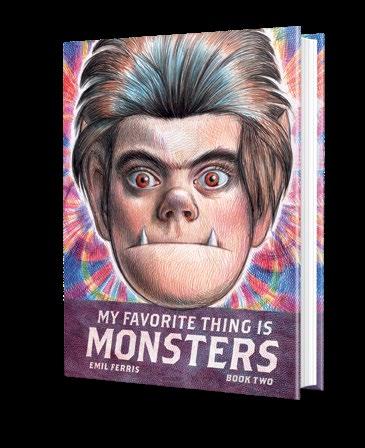
My Favorite Thing Is Monsters: Book Two
Ferris, Emil Fantagraphics Books | 412 pp. $44.99 | May 28, 2024 | 978168396927
READING EMIL FERRIS’ graphic novel masterwork, you might believe the author/ illustrator views the world with a cynical eye. This is understandable. My Favorite Thing Is Monsters: Book One (2017), about a girl who longs to be bitten by a werewolf and transformed into an immortal, touches on poverty, sexual assault, turbulent political times, murder, and the Holocaust. Menace gleams from every page of the exquisite crosshatched artwork. Twisted faces loom. Threats lurk. And that’s just from the real-life monsters.
But Ferris, who has faced more than her share of darkness, finds hope in the struggle.
“Marcus Aurelius said, The obstacle is the way,” she says on the phone from her home in Evanston, Illinois. “That means to me that no matter how difficult things are, the payoff for staying in it is great.”
That is true for Ferris, 61, as well as her protagonist Karen Reyes, a mixed-race queer kid growing up poor in 1960s Chicago, who becomes obsessed with investigating the death of her neighbor Anka, a Holocaust survivor. In My Favorite Thing Is Monsters: Book Two, published in late May by Fantagraphics, Karen continues unraveling Anka’s life and her desperate attempt to save children in a concentration camp; copes with her mother’s death; and frets about her older brother Deeze, who is involved in nefarious plots she’d rather not consider.
The road to Book 2 has been rocky. A now-settled lawsuit between Ferris and Fantagraphics delayed the sequel’s publication (a prequel, Records of the Damned, will be eventually published by Pantheon). Even writing the books was difficult: Ferris, who had been cleaning houses for a living, contracted West Nile virus at 40—bitten by a mosquito with monstrous results—leaving her paralyzed and demoralized with a 6-year-old daughter.
Then, in the hospital, she had a vision that indicated her path would shift.
“It was really weird,” she says. “I don’t really know how my feet were oriented, but the doctors were piercing them with needles, and I wasn’t moving.…I had the vision that my feet suddenly pointed in the opposite direction.”
Her path did swerve. She learned to walk again, though she still uses a cane. She enrolled in and graduated from School of the Art Institute of Chicago. And now, Monsters is complete, a testament to determination, a unique vision, and—dare we say it?—an almost supernatural storytelling power.
The following conversation has been edited for length and clarity.
You worked on My Favorite Thing Is Monsters for more than a decade. Is it strange to still be talking about it after all this time?
The only thing that’s really weird is that I wanted to put so much more into the second book than I was able to because of the time constraints. Four hundred pages go by faster than you think.
Did you ever think you wouldn’t finish it?
I was hopeless many times in the process of doing this. It was the kindness of other people that saved me. I was blessed. We don’t do everything on our own.
I did not think there was going to be an audience for the book. There was no certainty of its value. People helped with advice or whatever else they could. I had one friend who came to visit me, and he started reading it and said, “You have to finish this. You just have to.” He was working as a parking garage attendant, and he started sending me $20
every few days so I could eat. We had two Whole Foods in the neighborhood, and I would go back and forth for free samples. So I got through it.
Why was it so important to you to tell this story?
I felt like I had to take this interesting time that I lived through and create a way of talking about it; it felt to me like we were entering a period of tyranny, and I wanted to challenge that. I wanted to say: Here are other periods of tyranny other people have endured. They made choices that are very difficult. I guess I wanted to talk about that. I wanted my readers to recognize the time they were in and to recognize their power. That felt really important. I thought if we didn’t forget, if we remembered the horror and the brutality that can be exacted upon human beings, we might not repeat that. Right now we’re seeing genocide in Gaza, and so I was wrong about that. I’m very sad all the time.
In a way, the student protests today are reminiscent of parts of Monsters. I love our students today. An awful lot of people have woken up to the reality that we all have human rights. Bombing people in tents who have been dis-
placed and forcing the world to watch, it’s abominable.…I wrote the book because I knew so many survivors growing up, and kids of survivors, too. We saw the damage a genocide does generation after generation.
Do you have a negative view of humanity?
I think we are wonderful. What I regularly see in my city are people who stop their cars if they see someone fall down. People will move to the other side of the street to help someone in need. I think that’s humanity.
Karen says that she makes sense out of life’s dark side by writing and drawing. Are you the same?
Yes, but I think being a parent or a cook or an interior decorator does, too. Almost anything if you do it and are truly invested. It was terribly boring to clean people’s houses. When I had the best time was when I made a bed and straightened a pillow and thought: I really hope you have wonderful dreams. Energetically offering a blessing on all the things the family would touch. I think everything we do matters, even those things we think are mediocre and mundane.
Monsters also feels like a love letter to the Art Institute of Chicago. Can you lose yourself in a painting like Karen does? Yes! I was allowed to be at the Louvre and spend time there and see these residency paintings I’d never seen before. Sometimes if I’m upset by something, I will witness what I need to bear witness to and do what I can, and then I will remember those paintings. I try to take myself back into those paintings, hear the sound of wheels on cobblestones or smell the food on the table or look out the window in the Vermeer and see what’s beyond that room.
What do you want readers to take away from Anka’s story of survival?
Her deciding the most important thing was life and choosing it even though the compromise would be extraordinary. People say it’s such a dark story, but the only way Anka could make a choice to save these children is that she believes it’s possible to heal. That to me is not dark.
So you see Monsters as a hopeful story, in the end?
Without a doubt. There’s so much hope. We can’t lose that.
Connie Ogle is a writer in Florida.
I did not think there was going to be an audience for the book. There was no certainty of its value.

hired the assassin and why. Everything about Coleman’s latest production is grimly overscaled, from the international conspiracy behind the sky-high body count to the hero’s Bond-like sex life. Something for everyone, though maybe a little too much for some readers.
Coles, Donyae | Amistad/ HarperCollins (336 pp.) | $28.00 July 2, 2024 | 9780063228092
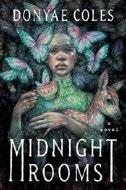
In 1840, an Englishwoman fights for her sanity—and her life—when she marries into an exceedingly rich and mysterious family. Orabella Mumthrope is the 26-year-old orphaned daughter of a white father and a Black mother; she’s living with her uncle, who grudgingly puts up with the arrangement, when Elias Blakersby shows up one day asking for her hand in marriage. It’s clear from the moment Orabella meets him that not everything is as it seems. Elias’ appearance is unkempt and his manner undeniably strange, but Orabella is thoroughly seduced by him and agrees to his proposal, leaving behind her family and friends for a new life at the Blakersby family estate. When Orabella and Elias arrive at Korringhill Manor, she discovers a home that has—in typical gothic fashion—fallen into decay. Elias’ family is less than welcoming to his new bride. While some of them are curt and distant, others act far too familiar with Orabella, treating her like a rare creature meant to be on display. Stranger still are the nightmarish bacchanalian dinner parties during which they seem to take on animalistic qualities. Despite Orabella’s initial misgivings, Elias convinces her they will have a long and happy life together as long as she does what she’s told and stays in her room at
night. But the longer Orabella spends locked behind the doors at Korringhill, the harder it becomes to tell reality from dreams. While this novel has many of the trappings of a classic gothic, its supernatural undertones make it stand out. At times it feels like a fever dream, and will undoubtedly leave readers confused as they try to parse out what exactly is happening to Orabella within the dimly lit halls of Korringhill; the narrative becomes increasingly unclear as the story progresses.
A hallucinatory and hair-raising gothic horror story that suffers from a disjointed style.
Downes, Anna | Minotaur (384 pp.)
$28.00 | Aug. 27, 2024 | 9781250868015

Two damaged women band together to find the sister of one of them, who went missing during a solo tour of Australia. Phoebe Sweeney is, or was, a massage therapist and yoga instructor who rejoiced in the prospect of circumnavigating Australia by herself. Beginning with the long drive north from Perth, she left pictures and posts on social media as she went. Her silence since Valentine’s Day devastates her sister, Katy, a Sydney schoolteacher who resolves to retrace Phoebe’s steps in her own HiAce van in search of her. Her quest is fraught from the beginning, since Vivi Green, another solo traveler, has already vanished from the region. And things rapidly get creepy when Katy encounters two different strangers, a man and a woman, who want to join her. Katy brushes off the man, who claims to know a good deal about her and Phoebe, but she can’t abandon Lily, the injured woman who climbs out of another van, approaches her, and begs for help. So she takes her in, shares stories with her, and invites her along. She’d certainly act
differently if she knew that Lily was really Beth Randall, a thief on the run from Lucas Cleary, her abusive partner in crime. But then Katy has secrets of her own that Beth can’t imagine. Although the geographic sweep of the two women’s journey is vast, the list of characters is tiny. So Downes builds suspense by deftly unpacking one layer of deception after another, never forgetting that her two travelers face danger not only from each other but from every man who catches sight of them.
The Australian Tourist Board will never endorse this road-trip nightmare. But readers are likely to recommend it highly.
Emerson, Jessica Elisheva Counterpoint (320 pp.) | $27.00 Sept. 10, 2024 | 9781640096530

An Orthodox Jewish soap opera, for mature audiences only. Like every other wife in her Southern California community, Rina Kirsch is “the invisible hero of the relentless Jewish calendar,” and Emerson’s debut gives a dire, almost furious sense of the cleaning, cooking, hosting, and gift giving this entails. Usually when you read pages and pages about food and cooking, it makes you hungry, but here the long lists of ingredients and dishes evoke not pleasure but the repetitive, draining female labor involved in their procurement and production. The pleasure center of Emerson’s debut is not food but sex, but even there the pleasure sometimes mingles with revulsion. As the novel opens in June 2011, the men in Rina’s husband’s circle have decided to permit themselves an evening of wife swapping: “It’s a thing that people do. It helps marriages last.”
The swap is described in the graphic terms that are a consistent feature of this intensely carnal novel; think A Sport and a Pastime for Haredi Jews, and get ready for sentences like this: “Sometimes at home he would beat off while thinking about
beating off at class to his mikveh fantasies.” In any case, being “traded” for an evening to another man is for Rina an indelible, unforgivable betrayal. Nine months later, she begins an affair with a rabbi and soon after she meets Will Ochoa, the teacher of an evening painting class her husband suggests she take. Rina and Will quickly realize that what is happening between them is real love, the kind that requires you to read Wallace Stevens’ “The Man With the Blue Guitar” out loud during intercourse, the kind that can cause a complete rupture with life as you know it. The plot continues to unfold at a breakneck pace, including vehicular trauma, unexpected pregnancy, religious conversion, life-threatening illness, and more, as the brute force and inexorable rhythms of orthodoxy thrum continually in the background.
Intense, uninhibited, at times overwrought, this bold debut is unlike anything you’ve seen before.
Evenson, Brian | Coffee House (256 pp.) | $19.00 paper Sept. 10, 2024 | 9781566897099
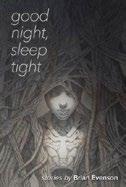
This collection of unsettling stories blurs the lines between dream and reality, life and death, human and not, Bradbury and Borges. An award-winning fantasist who’s been compared to Kafka, Evenson combines matter-of-fact verbal precision with anything-goes conjecture. The strongest pieces here, such as the title story, leave it unclear whether they’re illuminating psychological disturbance or supernatural terror. A man remembers how his mother, on rare occasion, would tell him stories that would scare him in a way that no mother ever should. His mother has no memory of this, nor would anyone else think it likely of her. But now that he has a son of his own, he reluctantly takes the boy to visit his grandmother, and the man’s
worst fears are realized. The reader must determine whether the protagonist has suffered a total breakdown or has been right all along. Following that is the even stranger “Vigil in the Inner Room,” in which a mother—there’s a lot of focus on mothers—orders her daughter, Gauri, to hold vigil at the bedside of the girl’s recently deceased father while her brother, Gylvi, stands guard outside the doors. Both of them know their roles, for they’ve done this each time their father has died, “several dozen deaths.” In “Untitled (Cloud of Blood),” a painting causes the death of anyone who has the misfortune to possess it, or maybe causes them to die by suicide, and keeps a tally of the deceased on the back of its canvas. Some stories are a little heavier-handed, more like science fiction parables, concerning climate change, class warfare, and the myth of free will. Some humans behave inhumanly while their bionic constructions have learned to develop (or approximate?) an ethical dimension. Call it speculative or SF, fantasy or horror, this is fiction that keeps the reader off balance, unsure, and nervous.
Jackson, Curtis with Aaron Philip Clark Amistad/HarperCollins (272 pp.)
$27.99 | Sept. 3, 2024 | 9780063312906
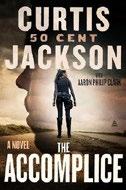
Desmond Bell, a traumatized Black Vietnam veteran turned professional thief, runs afoul of a powerful Texas family after acquiring proof that it
profited from the trans-Atlantic slave trade in this novel by Jackson, aka rapper 50 Cent.
Bell has in his possession a damning slave manifesto, which he lifted along with $2 million in Spanish gold from a hidden safe in an old bank in Waxahachie. His blackmail demands are that the right-wing, oil-rich white Duchamp family pay him $5 million for the document—and cancel shifty son Corbin’s run for president. That puts Bell in the crosshairs of Katz, a nihilistic killer working for the family. Enter Nia Adams, the first Black female Texas Ranger, who has to contend with not only Katz and company but also the underlying bigotry around her. Everyone has secrets. Nia is a closeted lesbian in a long relationship. Bell’s real name is Al Bouchard, which he changed after black-market dealings in Vietnam made him a marked man. After his Vietnamese wife was killed in a car crash that was meant to kill him, he faked his death and that of his daughter, Amara, who also survived the crash, and escaped to the U.S. as Desmond Bell. There, his “atomic” anger and remorse drive him to coldblooded acts of violence that cost him an ally in Nia. Written with the excellent crime fiction veteran Clark, Jackson’s first work of adult fiction is an assured, classically rendered effort. Though the twisty ending is wobbly and the novel lacks the depth of Southern gothics by Attica Locke and S.A. Cosby, it has its own special qualities—including a soundtrack in which patriotic Vietnamese hymns get swapped on a karaoke machine for the author’s “P.I.M.P.”
A satisfying thriller that knows its way around the form.
This is fiction that keeps the reader off balance, unsure, and nervous. GOOD NIGHT, SLEEP TIGHT
Jansma, Kristopher | Ecco/ HarperCollins (272 pp.) | $30.00
Aug. 13, 2024 | 9780063352896

The physical suffering and psychological trauma inflicted on the Dutch people during the Nazi occupation influences the survivors and subsequent generations.
Drawing on his own family history, Jansma’s new novel spans multiple generations of a New Jersey clan with Dutch origins. At its center is matriarch Mieke Geborn, a baker’s daughter who endured World War II in the Hague and offers a child’s-eye view of the German occupation, as well as the massively destructive V2 bombs fired at Britain from the town’s seashore. Her family takes in Professor Willem Naaktgeboren, an old friend of her father’s, along with his wife and children, who were bombed out of their Rotterdam home. Naaktgeboren’s son, Rob, becomes Mieke’s constant companion and, much later, her husband. A none-too-surprising cast of characters shares their apartment building, including Jewish and gay neighbors and a keen Nazi sympathizer. This historic narrative alternates with a more contemporary account of Mieke (now 80) in America, which has been her home for 50 years. Her grandson, Will, comes to visit, and there are reminiscences about Will’s father’s mental health issues, as well as considerations of some recent stresses on Will himself. A third element, a series of whimsical/philosophical/mythical chapters voiced by eels, recounts fairy
stories and historical aspects of Dutch life. The eels may have the best lines. Other than the grimly vivid description of near-starvation during the Hunger Winter of 1944-45, there’s a lack of intensity to both the wartime and contemporary storylines, connected though they are by themes of lost fathers, heritage, and mental burdens. An oblique take on a dark episode of wartime endurance.
Karakaš,
Sept.

A harrowing novel traces the evolution of a fascist soldier. The Ustaša were a fascist organization that once governed Croatia. Today, they are best known for their ties to the Nazis and for their brutal actions during World War II. Early in Karakaš’ novel, we learn that its protagonist, first encountered in 1945 hiding in the woods, is wearing a Ustaša uniform. In fact, the reader learns this before learning the protagonist’s name, Mijo. Soon enough, Karakaš reveals more about Mijo, including his plans to eventually surrender to the authorities. “I’ll turn myself in within two or three months, not right away while the blood’s still boiling,” he tells his wife during one of his furtive visits to his old home. There’s something almost quotidian about these trips, which also includes cleaning out stables and worrying about the health of the cattle living
Where does the human race go from here? This book is a radical answer.
UNDER THE EYE OF THE BIG BIRD
there. From the glimpses we get of his thoughts, it seems that Mijo has a philosophical attitude: “The thought flashed through his mind of all the human bones that would be carried off by beasts for years after the war.” What, then, led this man to fight on the side of fascism? Gradually, the novel moves back in time to reveal more aspects of his character, including chapters set before the war and in 1941. It’s there, especially a scene in which Mijo hesitates when asked to butcher a rooster, that the awful contradictions of one man’s life come into focus. As this stark novel reaches its conclusion, it becomes apparent that this isn’t a book that abounds with easy answers; there’s no “a childhood trauma made Mijo fight for fascism.” Instead, the novel leaves Mijo suspended in an agonizing kind of narrative purgatory.
An unsettling look at one man’s moral drift.
Kawakami, Hiromi | Trans. by Asa Yoneda Soft Skull Press (288 pp.) | $27.00 Sept. 3, 2024 | 9781593766115
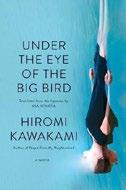
Where does the human race go from here? This book is a radical answer to a dark question. This speculative, artful, and deeply confusing novel sketches out the end of the world while simultaneously positing nearly unthinkable solutions and grappling with fundamental questions about identity, evolution, memory, and individualism. Over 14 tangentially connected, sometimes intertwined stories set across generations, Kawakami infuses her ethereal fiction about future civilization with both scientific inquiry and an acute sense of wonder about the human condition. The opener, “Keepsakes,” introduces the world on its way out, no longer sustainable by natural means.
Humans are now cloned in factories and sourced from the DNA of animals as well as people. Designated caregivers called mothers raise children while watchers keep different communities isolated from one another. In “Narcissi” and “Green Garden,” we learn the extent of the cloning involved and begin to meet outliers who don’t fit in. While the science fiction concepts at play aren’t as onerous as the long-spanning timelines in Iain Banks’ The Culture or Liu Cixin’s Remembrance of Earth’s Past trilogy, there’s no easy narrative arc here, either. We get a little more explanation in “Echoes”: “As a result of multiple impacts and other catastrophic events, the human population was in free fall.” But Jakob O’Neal and his partner, Ian Chen, have a plan to divide up the remaining human population in order to force evolution to do its job. Ironically, not much of this speculative future has to do with technology at all—in some timelines, rudimentary technology still exists, while in others, people start to develop inherent changes, among them photosynthesis, clairvoyance, and other superhuman abilities. Yet despite all these fantastic elements, Kawakami is more interested in people and their makeup, introducing a prophet in “The Miracle Worker” and the pains of love in the bookended stories “Love” and “Changes.”
A wild take on humanity’s last stand and our flawed understanding of who we are.
Krasznahorkai, László | Trans. by Ottilie Mulzet
New Directions (512 pp.) | $18.95 paper
Sept. 3, 2024 | 9780811231534

Krasznahorkai’s latest postmodern experiment explores small-town discontents in post-unification eastern Germany.
“Your voice is so fucking insipid, Florian, are you some Jew or what?” So bellows “the Boss,” the head of a clutch
of neo-Nazis in a Thuringian backwater smack in the heart of the new Germany. Apart from idolizing Hitler, the Boss is also a hectoring concertmaster who owns a cleaning company (its ominous all-caps slogan “ALLES WIRD REIN, ALL WILL BE CLEAN”). It’s good for business but enraging all the same that someone is spray-painting sites associated with Johann Sebastian Bach, one of the Boss’ many obsessions, with graffiti signed “WOLF HEAD.” The subject of the Boss’ meltdown is Florian Herscht, a gentle and dim giant who is fascinated by particle physics, even if he doesn’t understand it, and harbors fears of dentists, tattoos, and the end of the world. About the latter he regularly writes to German premier Angela Merkel, warning of the impending apocalypse. Reminiscent of the similarly dim but good-hearted giant of Günter Grass’s The Tin Drum , Florian strains to understand what is happening in tiny Kana, now populated by immigrants from Eastern Europe and from even as far away as Vietnam. While the Boss rails against his neighbor Ringer, “a Jew, meaning he was part of the conspiracy,” the wolves are indeed returning, as are magical birds and other signs and portents of the very apocalypse that Florian worries about. In a long book with only one terminal punctuation mark, not easy to read but graced by a certain poetry, Krasznahorkai allegorizes globalism and nationalism, gets in digs at complacent burgers and ardent environmentalists, and illustrates, through Florian and other characters, how thinly the veneer of civilization lies atop a thick crust of savagery. Brilliant, like all of Krasznahorkai’s books—and just as challenging, though well worth the effort required.

Kirkus Star
Jimi Hendrix Live in Lviv
Kurkov, Andrey | Trans. by Reuben Woolley HarperVia (416 pp.) | $19.99 paper Aug. 13, 2024 | 9780063354548

A Ukrainian city finds itself under siege from a series of threats straight out of an Alfred Hitchcock movie or an episode of Scooby-Doo, Where Are You!
For more by László Krasznahorkai, visit Kirkus online.
“You know… some cities only exist so people can dream about going there,” one character tells another in Kurkov’s novel, originally published in Ukraine in 2012. “And sometimes the dreaming is more important than the going.” Now in English, his story paints a dreamlike portrait of Lviv, a major city in western Ukraine, and a strange mystery that dares to be solved. Chief among the sleuths are Taras, a young man who drives patients with kidney stones on cobblestone streets to shake them out; Alik, an old hippie who joins his long-haired brethren every September in Lychakiv Cemetery to memorialize Jimi Hendrix (whose right hand is rumored to be buried there); and Captain Ryabtsev, a former KGB officer who once spied on Alik and wants to be his friend. Such eccentric characters are a Kurkov staple, and so is the surreal situation confronting them: Rumors abound that a prehistoric sea may be rising under Lviv, which would explain a spate of violent seagull attacks and a strong smell of iodine that won’t go away. The search for an explanation forms the backdrop to Taras’ tender romance with Darka, a currency exchange clerk who’s allergic to handling money. Captain Ryabtsev goes on a similar search, and Kurkov’s characterization of the captain, who lost his sense of purpose when the Soviet Union collapsed, strikes a sad note in an otherwise lighthearted tale. Though the novel isn’t overtly political,
Ryabtsev’s crisis of identity echoes Ukraine’s more than 20 years into its independence. And when Taras gets home after a kidney stone session and hears the national anthem on the radio—“The glory and freedom of our Ukraine has not yet perished”—reading those words now is much more poignant than it was when Kurkov first wrote them.
Kurkov gives us a rich cast of endearing characters and a glimpse of life in an old city on the eastern edge of Europe.
Lambert, Kevin | Trans. by Donald Winkler | Biblioasis (224 pp.) | $16.95 paper Sept. 3, 2024 | 9781771966207

An architect’s travails.
Award-winning Canadian novelist Lambert weaves a hypnotic narrative, smoothly translated from French by Winkler, about greed and inequality, hypocrisy, and, not least, a “dangerous notion of purity” emerging from vociferous public clamor. The novel is centered on internationally acclaimed architect Celine Wachowski, renowned for her design of New York and Tokyo skyscrapers; the Abu Dhabi Guggenheim Museum; and luxury residences in Paris, New York, Los Angeles, and the Hamptons, for clients including Sigourney and Meryl, Madonna and Julianne. The host of a Netflix series, Old House, New House, Celine congratulates herself on educating viewers about “architecture, design, urbanism, and the history of little-known cultures.” As the novel opens, she is overseeing the construction of a vast complex in the outskirts of her native Montreal for the headquarters of the corporate monolith WeBuy. Located on “unceded Indigenous territory,” the complex, she feels certain, will revive a decrepit area, commercially and aesthetically. She is
Leegant’s vivid narrative voice drives a compelling collection.
unprepared, then, for the eruption of protests against the building and, soon, against her. A two-part New Yorker article digs deeply into her work and life, underscoring the “social cost” of her creations, which are “reserved for only a tiny segment of the population,” accusing her of exploitation, racism, and sexism. Older intellectuals sign editorials excoriating capitalist ideology; “young detractors and women who spoke up called her an abuser, she had committed symbolic rape….” Well versed in the theoretical underpinnings of social and cultural debates, Lambert skewers “the fascist old guard that is behind the current right-thinking left”; the pretensions of the conspicuously virtuous, such as Celine’s employee who carries a vegan leather bag and dresses “in an armour of European linen made 50 percent from sustainable materials”; and Celine’s slippery, self-serving transformation.
An astute critique of entrenched power.
Leegant, Joan | New American Press (309 pp.) $18.00 paper | May 1, 2024 | 9781941561324

A collection that ranges from Israel to the United States tackles displacement in all its varieties.
The key to Leegant’s latest book lies in its title: In one way or another, all the stories in this collection depict characters who have been displaced, whether by geography, mental illness, or the various particularities of their own lives. In “The Baghdadi,” an American expatriate to Israel encounters an Iraqi
emigrant whose stories prompt her to reflect on her own failed marriage. In “Remittances,” another American-born woman has moved to Israel to escape a violent trauma. “Wild Animals,” which is set in New York and unfurls over the course of an extended family dinner, might be the collection’s best: Leegant’s talent for dialogue, swift characterization of complex human lives, and the many resentments and allegiances that tangle a family’s dynamics are on wonderful display. “Now out from the kitchen came the other aunts,” Leegant writes, “timid Claire and peacemaking Thea, wearing Ruthie’s mother’s aprons and surveying the table that stretched to the living room where the men sat on couches sipping Scotch and rye and ignoring the babies crawling over their feet.” But Leegant’s thematic insistence on displacement can at times feel heavy-handed or even relentless, as if the same notes were being sounded again and again. The book’s structure takes a similar approach: The volume is split into two parts, “East” and “West,” with stories in each part primarily based in Israel and the U.S., respectively. By the end, one begins to wish for a bit less insistence on the literal; a bit more metaphor, or even just a slightly looser interpretation of Leegant’s major concerns, would have gone a long way. Despite some heavy-handedness around the thematic focus, Leegant’s vivid narrative voice drives a compelling collection.

For more by Joan Leegant, visit Kirkus online.
Kirkus Star
Locke, Attica | Mulholland Books/ Little, Brown (320 pp.) | $29.00 Sept. 3, 2024 | 9780316494618

Locke resolves the loose ends of her award-winning trilogy of novels set along East Texas’ Highway 59—beginning with Bluebird, Bluebird (2017) and Heaven, My Home (2019)—in ways at once gratifying and unsettling.
The year 2020 finds Donald Trump still in the White House and Texas Ranger Darren Mathews struggling toward as much peace of mind as a proud yet vulnerable Black man can find. What’s kept him especially vulnerable is the looming threat of indictment by an ambitious district attorney for obstructing justice in the murder of a white nationalist, the principal problem being that Darren knows he’d be found guilty. “He wasn’t entirely sure he didn’t deserve to be indicted. Wasn’t sure either that he didn’t deserve a medal.” Either way, Darren decides he can no longer function as a Ranger under this cloud, so he turns in the badge he’d once proudly worn. When he comes home after resigning, he finds his estranged mother, Bell, waiting for him. Darren has many reasons for not wanting to talk to her, beginning with an assortment of resentments from his childhood and culminating with the fact that she gave the weapon used in the aforementioned murder to the DA. “I was trying to protect you,” she insists, which Darren doesn’t believe. Nor does he believe that she’s sober after years of alcoholism. But she’s not here to stir up old grievances. Bell’s asking him to find a Black student at Stephen F. Austin College who disappeared from a sorority house where Bell’s been working as a maid. At first, Darren’s too wound up over his mother
coming into his life again to even consider her request, so wound up that he tumbles into his own nightmarish round of hard drinking, but he eventually decides to take the case. And there’s much more to it than anybody connected with the school or the girl’s all-white sorority bothers to acknowledge. The trail leads to a town called Thornhill, which is dominated by a family-run corporation with deep political connections and vaguely sinister control over its employees. This case may lack something of the edgy, violent nature of the crimes in the two earlier books. But Locke’s main order of business here is with Darren’s reckoning and reconciliation with a past as full of deceit and false leads as even the most elaborate whodunit.
We’ve missed Attica Locke’s deft and wise way with the crime novel. We want more.
Mara, Andrea | Pamela Dorman/ Viking (368 pp.) | $29.00 Aug. 20, 2024 | 9780593831434
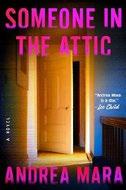
A TikTok trend threatens a family’s sense of safety—and may be connected to a previous crime. Most people are probably familiar with this urban legend: a babysitter receives creepy, threatening phone calls and later finds out they’re coming from inside the house. Mara offers a more complex, grown-up version of that legend here, updated to include TikTok and hidden cameras, but the sense of dread is similar: What would you do if someone seemed to be filming themselves inside your house? Julia has recently relocated with her family from California to Ireland to return to her roots and escape an unsavory incident involving her teenage daughter, Isla. She and her ex-husband, Gabe, are divorced but share
custody and living space with the two kids in a luxurious gated community; when an anonymous user starts posting videos on TikTok that seem to show the inside of their house, Julia is spooked but figures it’s probably a really good fake. She’s got a lot on her mind, from Gabe’s secretive behavior to Isla’s teenage drama to the memories raised by her return. She and her three best friends grew up in this town, and it’s also where one of them, Donna, died tragically nearly 20 years ago. When another friend dies of what seems to be an accidental drowning just after Julia’s arrival in Ireland, Julia and her one remaining friend, Eleanor, are forced to confront the pain of the past as they look for clues to who is posting the increasingly alarming videos. Are the neighbors who they say they are? What happened to Donna’s socially awkward brother? Is Julia’s son telling the truth when he says there’s a man watching him at night? Mara skillfully layers red herrings and discoveries at a satisfying pace, sprinkled with a few flashbacks that lend even more insight into Julia as a tough and resilient character. The ending rushes a bit, offering a few too many neat bows to tie up all the threads, but it’s a minor complaint. Well paced and creepy—especially if you’re alone in the house while you read.
Kirkus Star
McCarthy, Cormac | Illus. by Manu Larcenet | Abrams ComicArts (160 pp.) $24.99 | Sept. 17, 2024 | 9781419776779

A suitably dark graphic treatment of McCarthy’s post-apocalyptic masterpiece. French artist Larcenet delivers a full 21 frames before McCarthy’s main characters, a father and his preadolescent son, speak.
>>>
Kairos, written by Jenny Erpenbeck and translated by Michael Hofmann, took home the award.
Kairos, written by Jenny Erpenbeck and translated by Michael Hofmann, has won the International Booker Prize, given annually to “the finest single work of fiction from around the world which has been translated into English and published in the U.K. and/or Ireland.”
Erpenbeck and Hofmann were announced as the winners at a ceremony in London.
Kairos, published in the U.S. last June by New Directions, follows Katharina, a 19-year-old woman, and Hans, a writer in his 50s, who have an affair in East Berlin in the late 1980s, as East Germany heads toward a collapse. A critic for Kirkus wrote of the book, “The personal and the political echo artfully in the last years of the German Democratic Republic.”
Erpenbeck is the first German author to win
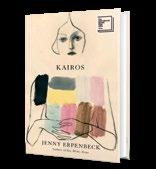
the award; she was previously longlisted for the prize in 2018 for Go, Went, Gone, translated by Susan Bernofsky.
Eleanor Wachtel, the chair of judges for the prize, said in a statement, “In luminous prose, Jenny Erpenbeck exposes the complexity of a relationship between a young student and a much older writer.…
Michael Hofmann’s translation captures the eloquence and eccentricities of Erpenbeck’s writing, the rhythm of its run-on sentences, the expanse of her emotional vocabulary.”
The International Booker Prize was first awarded in 2005; for its first six years, it was given to a writer in recognition of their entire body of work. Previous books to have won the award include The Vegetarian, written by Han Kang and translated by Deborah Smith, and Flights, written by Olga Tokarczuk and translated by Jennifer Croft.
—MICHAEL SCHAUB







Knopf will publish the Japanese author’s The City and Its Uncertain Walls this November.
A new novel by legendary Japanese author Haruki Murakami will hit bookstore shelves later this year.
Knopf will publish Murakami’s The City and Its Uncertain Walls, translated by Philip Gabriel, in the fall. The novel was originally published in Japanese in 2023.
Murakami is the world’s best-known Japanese author, with his books routinely becoming bestsellers around the globe. He made his literary debut in 1979 with the novel Hear the Wind Sing and went on to write several more, including Hard-Boiled Wonderland and the End of the World, The Wind-Up Bird Chronicle, Norwegian Wood, and 1Q84

The City and Its Uncertain Walls, Knopf says, takes place in a city that Murakami briefly wrote about in HardBoiled Wonderland and the End of the World
“A love story, a quest, an ode to books and to the libraries that house them, and a parable for these strange post-pandemic times, The City and Its Uncertain Walls is a singular and towering achievement by one of modern literature’s most important writers,” the press says.
Knopf says it will celebrate the release of the novel with a series of midnight release parties at bookstores across the nation.
The City and Its Uncertain Walls is slated for publication in the U.S. on Nov. 19.—M.S.

That’s fitting: In the original novel, the father is grimly taciturn, while the boy is full of anxious questions: Are we the good guys in the piece? Are the bad guys going to eat us? Larcenet’s landscape is the dark, dead land of nuclear winter; in an afternote, he admits to liking snow, though atop every snowbank here, it seems, there’s a corpse. Larcenet’s rendering of the father looks nothing like the Viggo Mortensen of the film, for, as he writes in an afterword, “I’ve been racking my brain to avoid any reference to the movie adaptation.” Instead, the man looks like one of the hirsute Trumpets who stormed the Capitol. But then, so do all the other grown-ups, personal hygiene having fallen victim to the irradiated world of the future.
McCarthy’s story is simple: The man and the boy have to head south to find a place they hope isn’t frozen solid. On the way, wheeling a shopping cart, they have to keep their few possessions safe from scavengers while avoiding gangs of roving, cannibalistic brigands. The son remembers a few hallmarks of the old world, praying that a dead family whose larder they’ve raided “are safe in heaven.” Dad, meanwhile, is full of more instructive notes: “You forget what you want to remember and you remember what you want to forget,” he remarks amid an endless landscape of tortured corpses and detached skulls. The story, as with McCarthy’s work in general, ends happily only if you count mere survival as a satisfying resolution. Larcenet’s brooding black-and-white drawings suit the original perfectly.
Read McCarthy’s novel first to appreciate the subtlety of Larcenet’s superb graphic adaptation.

Addictively engaging, serious fiction from an underappreciated master.
HIGHWAY THIRTEEN
Kirkus Star
McFarlane, Fiona | Farrar, Straus and Giroux (272 pp.) | $27.00 | Aug. 13, 2024 9780374606268

McFarlane contemplates the ripple effects of violent crime in 12 intricately layered stories based on an actual string of serial killings in 1990s Australia.
The diverse stories travel across decades and continents. The criminal investigation never becomes the central plot; the killer himself, here called Paul Biga, remains offstage while his victims appear only in fleeting mentions or glimpses. The protagonists’ connections to the crimes range from close to barely tangential. Timing matters, one story traveling back to 1950, when Biga’s future mother is 8 years old, another heading forward to a 2028 true-crime podcast. The opening story introduces the crimes’ physical reality, following a reluctant visitor to the forest where Biga’s victims had been found years earlier and where a sense of evil, and sexual, possibility still pervades. In 2003, an elderly woman’s lingering shame over her adolescent love for another girl resonates more powerfully than her more recent memories of Biga as her neighbor. Secret sexuality permeates characters’ lives, as does paranoia. Readers share a young woman’s growing fear in 1996 as she follows news reports that reveal a disquieting number of traits her boyfriend shares with an unidentified
killer on the lam. Is it protective or paranoid maternal instinct pushing another woman to warn her younger sister against marrying a vaguely creepy boyfriend a decade earlier, in 1986? McFarlane uses the adventures of British schoolgirls in 1995 Rome to create misleading fear and tension before revealing a character who symbolizes resilience in the book. The travails of a politician unfortunately named Biga running for office four days after Paul Biga’s arrest offers discomforting comic relief. Given the large role media influence plays throughout, inevitably a television series about Biga shows up in 2024. So does Covid-19 in 2020, putting into perspective a single serial killer’s insignificance in a world reeling with global crises. However entertaining, McFarlane’s stories continually remind readers that behind truecrime stories’ escapist pleasure exist real death and human pain. Addictively engaging, profoundly serious fiction from an underappreciated master.
Mitzner, Adam | Blackstone (266 pp.)
$26.99 | Aug. 13, 2024 | 9798212185912

A washed-up track star back in his hometown for the worst reason in the world resolves to investigate a death nobody but him thinks is suspicious. Sean Kenney has competed with his brother ever since they both ran the 1600-meter event at East Carlisle High School.
Although Michael Kenney was so fast that he was nicknamed Kick, Sean was even faster—until his failure to make it to the Olympics left him drained of ambition and will and identity, after which he left town and cut all ties with his family. When his sister, Katie, visits him in New Orleans after two years of silence on both sides to tell him their father’s early-onset Alzheimer’s disease has killed him, he returns with her to New Jersey, only to find that Michael Sr. is still alive; it’s Kick who’s died, but Katie thought if she told him the truth he wouldn’t have come home. The police are satisfied that Kick, a wealthy investment banker, shot himself, but Sean, who had spoken to him on the phone hours earlier, is certain they’re wrong and sets out to prove it. The major problem isn’t the evidence against Sean but the likelihood that, if Kick was murdered, the killer was almost certainly someone very close to both brothers: Kick’s wife, Jenny; Katie or her husband, Ben Whitting; or Rachel Fischer, Kick’s ex-girlfriend and Sean’s ex-lover, whom Sean promptly takes up with again because it was “the only way I could think of to turn back time.” In the end, Sean, who thought he wanted to learn the truth about his brother’s death, discovers a great deal more than he wanted to.
Twisty and affecting. The last twist is one too many, but the sorrow and love shine through to the end.
Kirkus Star
The Seventh Veil of Salome
Moreno-Garcia, Silvia | Del Rey (336 pp.)
$28.99 | July 16, 2024 | 9780593600269
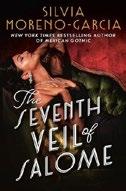
A bitter actor goes to war with a Hollywood newcomer in this historical novel. It’s 1955, and Hollywood can’t stop talking about The Seventh Veil of Salome, a film that its beleaguered screenwriter calls “one of those sword-and-sandal flicks” and a
“picture with a camel, a palace, and a garbage plot thinly inspired by a Biblical story.” The film has been in the works for years; one of the reasons is that its director has had trouble finding an actor for the title role, the first-century princess who plays a part in the New Testament. The director finally settles on a 21-year-old Mexican newcomer named Francisca Severa Larios Gavaldón, whom the studio renames Vera Larios. Vera’s rapid ascent irks Nancy Hartley, “a professional party girl more than she was an actress,” who nevertheless badly wanted the role herself. Nancy also wants Jay Rutland, a handsome jazz pianist who has his eyes set on Vera. Nancy is a racist with a nasty temperament—“God help the person who incurred her wrath”—which means she has no intention of letting Vera go unpunished. Meanwhile, Vera tries to adjust to her new life in Hollywood, deal with her overbearing mother, and avoid the unwanted attentions of a sex-pest actor who believes he’s entitled to her body. Moreno-Garcia’s novel is told from a variety of perspectives, and she captures each voice perfectly, with dialogue that’s artfully and subtly reminiscent of Golden Age movies. She also proves to be an expert at building suspense—she telegraphs that Vera and Nancy’s rivalry will end explosively, but still manages to end the novel with a genuine surprise. The author has proved with previous books like Mexican Gothic (2020) and Velvet Was the Night (2021) that she’s a master storyteller who can move among genres with ease, so it’s no surprise that this foray into historical fiction is intelligent, exciting, and written absolutely beautifully.
A rousing success: Moreno-Garcia proves, once again, that she is a master of her craft.
Moriarty, Liane | Crown (512 pp.)
$27.00 | Sept. 10, 2024 | 9780593798607

What would you do if you knew when you were going to die?
In the first page and a half of her latest page-turner, bestselling Australian author
Moriarty introduces a large cast of fascinating characters, all seated on a flight to Sydney that’s delayed on the tarmac. There’s the “bespectacled hipster” with his arm in a cast; a very pregnant woman; a young mom with a screaming infant and a sweaty toddler; a bride and groom, still in their wedding clothes; a surly 6-year-old forced to miss a laser-tag party; a darling elderly couple; a chatty tourist pair; several others. No one even notices the elderly woman who will later become a household name as the “Death Lady” until she hops up from her seat and begins to deliver predictions to each of them about the age they’ll be when they die and the cause of their death. Age 30, assault, for the hipster. Age 7, drowning, for the baby in arms. Age 43, workplace accident, for a 42-year-old civil engineer. Self-harm, age 28, for the lovely flight attendant, who is that day celebrating her 28th birthday. Over the next 126 chapters (some just a paragraph), you will get to know all these people, and their reactions to the news of their demise, very well. Best of all, you will get to know Cherry Lockwood, the Death Lady, and the life that brought her to this day. Is it true, as she repeatedly intones on the plane, that “fate
A bitter actor goes to war with a Hollywood newcomer in this historical novel.
THE SEVENTH VEIL OF SALOME
won’t be fought”? Does this novel support the idea that clairvoyance is real? Does it find a means to logically dismiss the whole thing? Or is it some complex amalgam of these possibilities? Sorry, you won’t find that out here, and in fact not until you’ve turned all 500-plus pages. The story is a brilliant, charming, and invigorating illustration of its closing quote from Elisabeth Kübler-Ross (we’re not going to spill that either). A fresh, funny, ambitious, and nuanced take on some of our oldest existential questions. Cannot wait for the TV series.
Botanical Gardens, an accessible-onlyto-the-rich paradise of greenery, frolicking animals, and fresh air walled off to shut out the city’s grit, graffiti, litter, and soot. But the family’s perfect vacation takes an unfortunate turn when the children wander off and get lost, setting in motion a string of events that endangers the family’s power to stay together. Writing with precision, insight, sensitivity, and compassion, Phillips renders the way love and family bonds—between partners, parents and children, and siblings— can act as a balm and an anchor amid the buffeting winds of a fast-changing, out-of-control world.
A perceptive page-turner with a generous perspective on motherhood, identity, and the pitfalls of “progress.”
Phillips, Helen | Marysue Rucci Books (272 pp.)
$27.00 | Aug. 6, 2024 | 9781668008836

W hat happens when the forests are gone, surveillance cameras are ubiquitous, and AI-programmed robots do the work?
Set in a future altered by climate change and technology that may feel uncomfortably close at hand, Phillips’ new novel again shows her talent for finding warmth, humanity, and connection within an all-too-conceivable dystopian landscape. The action begins with May Webb, an unemployed mother of two elementary school students, undergoing a procedure designed to alter her features just enough to confound facial-recognition software. (The procedure is performed, as are many tasks in the world of the novel, by a robot with a soothing demeanor called a hum.) For surrendering her face to this experiment, May—whose AI-communication job has recently rendered itself obsolete and whose husband, Jem, has been laboring to keep the family financially afloat working gig-app-facilitated odd jobs—is paid the equivalent of 10 months of her previous salary. She immediately splurges on a three-night stay for the family in the idyllic
Picoult, Jodi | Ballantine (544 pp.)
$27.00 | Aug. 20, 2024 | 9780593497210
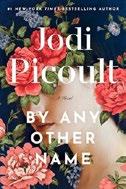
Who was Shakespeare? Move over, Earl of Oxford and Francis Bacon: There’s another contender for the true author of plays attributed to the bard of Stratford—Emilia Bassano, a clever, outspoken, educated woman who takes center stage in Picoult’s spirited novel. Of Italian heritage, from a family of court musicians, Emilia was a hidden Jew and the courtesan of a much older nobleman who vetted plays to be performed for Queen Elizabeth. She was well traveled—unlike Shakespeare, she visited Italy and Denmark, where, Picoult imagines, she may have met Rosencrantz and Guildenstern—and was familiar with court intrigue and English law. “Every gap in Shakespeare’s life or knowledge that has had to be explained away by scholars, she somehow fills,” Picoult writes. Encouraged by her lover, Emilia wrote plays and poetry, but 16th-century England was not ready for a female writer. Picoult interweaves Emilia’s story with
that of her descendant Melina Green, an aspiring playwright, who encounters the same sexist barriers to making herself heard that Emilia faced. In alternating chapters, Picoult follows Melina’s frustrated efforts to get a play produced—a play about Emilia, who Melina is certain sold her work to Shakespeare. Melina’s play, By Any Other Name, “wasn’t meant to be a fiction; it was meant to be the resurrection of an erasure.” Picoult creates a richly detailed portrait of daily life in Elizabethan England, from sumptuous castles to seedy hovels. Melina’s story is less vivid: Where Emilia found support from the witty Christopher Marlowe, Melina has a fashion-loving gay roommate; where Emilia faces the ravages of repeated outbreaks of plague, for Melina, Covid-19 occurs largely offstage; where Emilia has a passionate affair with the adoring Earl of Southampton, Melina’s lover is an awkward New York Times theater critic. It’s Emilia’s story, and Picoult lovingly brings her to life.
A vibrant tale of a remarkable woman.
Platzová, Magdaléna | Trans. by Alex Zucker Bellevue Literary Press (256 pp.) | $17.99 paper Aug. 6, 2024 | 9781954276291

The life of Felice Bauer, one-time fiancee of Franz Kafka, as imagined by a Czech novelist who makes herself part of the story. Relatively little is known about Felice outside of the trove of letters Kafka wrote her (which she kept hidden for decades; he destroyed all her letters to him). Drawing on the Letters to Felice and years of research, Platzová paints a picture of a refined, well-liked, and resilient woman—the opposite of the brooding, self-doubting Kafka. When his stories became hot items after decades of neglect (he died in 1924), so did the letters.
Struggling to get by in Los Angeles after the death of her banker husband, with whom she escaped the Nazi threat in Europe with their children in 1935, she sells the letters to department store magnate turned publisher Salman Schocken for $8,000 with the understanding that they would be donated to the National Library in Jerusalem after publication. To her son’s dismay, they were sold at auction after Schocken’s death for $605,000. Jumping back and forth across the 20th century, from Europe to California to Israel to New York, and with extended appearances by Max Brod, Ernst Weiss, and Grete Bloch, the novel skillfully blends myth, reality, and rumor. An actor comes forth claiming to be Kafka’s son by Bloch (who died at Auschwitz). Platzová somewhat awkwardly enters the novel to explain some of her creative choices and offer a first-person account of her real-life interview with Bauer’s son Henry (renamed Joachim in the book). The novel does what it sets out to do in removing Felice from Kafka’s shadow, but at the cost of telling us little about their relationship. “I find no great story here, just an everyday courageousness that manifests itself mainly in perseverance,” writes Platzová. A noble theme, but not one that turns the pages.
An ambitious but less than transcendent work of historical fiction.
Star
Porter, Regina | Hogarth (352 pp.)
$29.00 | Aug. 6, 2024 | 9780593241868

cast of diverse New Yorkers, this time met during the spring of 2020. It opens with a list poem about the Union Square Greenmarket, then moves to a chapter called “Daily Cleanse” that starts with this sentence: “Mr. Harper takes sex in doorways.” Theo Harper, a white man we never like much, works in real estate. He has an open marriage to a pregnant white woman named Darla Jacobson, whose mother is living in Paris and who counsels Theo to get Darla out of the city for “breathing room and fresh air.” Darla’s best friend is Ruby Black, a Black woman who owns a restaurant in Union Square with her husband, Katsumi Fujihara. There’s also Xavier Curtis, “The Teenager in the Cardi B T-Shirt” (this and a number of other images are illustrated with small photographs), whose uncle lives in the same Park Slope building as Theo and Darla. Xavier is isolating in his uncle’s empty apartment. It’s a bit unclear where all this is going until a subordinate clause in the fourth chapter reveals that Darla, on the drive upstate to follow her mother’s advice, “turn[s] off her cell phone, which would remain off until it was found in the woods a month later.” The main plot revolves around Darla’s disappearance after a fight with Theo on a hike during which he discloses that he has a Black ancestor; he becomes the main suspect in the police investigation. At the same time, we explore the back- and side stories of the other characters, finding nuggets of practical information and advice along the way—why dull knives are more dangerous, the use of cream of tartar to remove bathtub rings, a guide to the club scene in Japan, and
this advice about loss, offered by a private investigator named Yvonne Tender: “Seek out the living and find little things to love until something or someone worth loving comes along.” Meanwhile, a second mystery plot involving 9/11 surfaces. The novel eventually settles its gaze on matters of race and class, underlined by its breathtaking ending. This restless, intentionally unsettling novel establishes Porter as a distinctive, confident literary voice.
Powers, Richard | Norton (400 pp.) $29.99 | Sept. 24, 2024 | 9781324086031

A story of friendship, technology, oceans, and a small island. Powers juggled nine lead characters in The Overstory (2018), his Pulitzer Prize–winning novel. Here he wrangles just four, but the result is almost as complicated. Two nerdish boys, Rafi Young and Todd Keane, bond in high school over chess and Go. In college, Rafi falls in love with Ina Aroita, a Hawaii-born Navy brat whose mother is Tahitian. The men fall out shortly after brainstorming over Todd’s idea for a computer game called Playground. This strand of the novel is told in retrospect by Todd at age 57, addressing an unidentified “you,” after he receives a diagnosis of dementia with Lewy bodies; he’s an unreliable narrator in
Deep in the heart of the Covid-19 lockdown, a pregnant Brook lynite goes missing. Porter’s sophomore novel again features a large
This unsettling novel establishes Porter as a distinctive literary voice.
RICH PEOPLE HAVE GONE AWAY
more than one way. Interspersed are scenes in later years on the French Polynesian island of Makatea, scarred by phosphate mining and down to a population of 82, including Rafi and Ina and the novel’s fourth lead, an elderly Canadian scuba diver named Evelyne Beaulieu. Her lifelong love of the diversity and preciousness of aquatic life provides the book’s other narrative strand and its environmental theme. Through Todd, Powers sketches the computer and social media revolutions, from early coding to gaming to AI. The counterpoint to this high-tech history is Makatea, a paradise lost to industrial mining that decades later must decide whether to accept a consortium’s lucrative proposal to use the island to build floating autonomous cities. This is a challenging novel, fragmented but compelling, with fine writing on friendship and its loss and on the awe and delight the ocean inspires. Along with its environmental warnings, the book carries an intriguing look at the ways people and animals play, as in the boys’ competitive chess, the antics of manta rays, the allure of computer games, and what a meta-minded author might do with his readers. An engaging, eloquent message for this fragile planet.
Puyana, Alejandro | Little, Brown (448 pp.) $30.00 | Aug. 20, 2024 | 9780316571784

Youthful decisions come to haunt the lives of Venezuelans living through decades of social and political upheaval. Puyana’s debut novel launches with a propulsive, pulse-quickening prologue set during a day of massive political protest in 2002. María, a single mother and housekeeper living in the Caracas barrio, is home for the day as the city
braces for demonstrations and counter-demonstrations. When, caught in gunfire, her beloved 9-year-old son is shot and seriously wounded, María’s frantic search for help and transport to medical care vividly illustrates the abysmal conditions endured by impoverished Venezuelans (even after years of revolutionary activity). Chaos in the hospital leads to a civilian assisting at Eloy’s surgery. What follows is an expansive chronicle of the interwoven lives of people who began as true believers in the Movement of the 1960s, centering on the experiences of Stanislavo Atanas, the privileged son of European émigré doctors who escaped the Holocaust. His involvement with the guerrilla forces becomes fraught but does bring him love with Emiliana Rodríguez, an Indigenous nurse secretly assisting those forces. When tactical expediencies and a poor decision on Stanislavo’s part rupture the romance, their lives proceed on separate courses. It’s only much later in life that a world-weary and less idealistic Stanislavo learns of Emiliana’s journey (and what his role in her destiny was). An action-packed narrative carries Stanislavo through those decades, and Puyana delivers graphic portraits of the seats of power and wealth as well as life in the Venezuelan barrios, jails, and jungles. Stanislavo’s later career as a journalist allows Puyana to convey the complexities of the country’s military and political situations, but ultimately the saga is one of love, loss, and opportunities for recognition and redemption.
Cinematic settings, evolving characters, and an explosive plot support a story of love and politics.
Resnick, Benjamin | Avid Reader Press (304 pp.) | $26.04 Sept. 10, 2024 | 9781668066638

After the state of Israel disappears into a black hole, antisemitism becomes the law of the land. As Resnick’s disturbing debut opens, Ethan and Ella—a tech journalist and a photographer—bond over the joy of launching a paper airplane from the rooftop deck of their co-working space. That might sound like a meet-cute, but this dark dystopian drama is no romantic comedy. The connection between the two characters, both Jewish, she the single mother of a 6-year-old named Michael, is forged in a climate of worldwide dread, in a city filled with random violence and robotic killer dogs. Ella lives in a part of the city called the Pale, which will soon become the only neighborhood in which Jews can live; this is one of myriad allusions to the years leading up to the Holocaust in Europe. After the First Event (the disappearance of Israel) and the Second Event (numerous similar “anomalies” tear the fabric of reality in cities around the world), many people believe that Jews are in on this situation or benefiting from it in some way; this unleashes further individual and state-sponsored acts of antisemitism. Meanwhile, it’s true that the anomalies are portals that exert a gravitational force only on Jews, who can step through to be transported to a mysterious parallel world. The portrayal of Jews in the
Cinematic settings and an explosive plot support a story of love and politics.
FREEDOM IS A FEAST
book will not be comfortable for all readers. For example, the characters seem to agree that you can always identify a Jewish person just by looking at them; if this point is being held up to scrutiny rather than asserted as fact, that is not clear. The implications of the title, too, are discomfiting. Is Resnick, a rabbi in Pelham, New York, suggesting that this type of deep division between the Jews and everyone else is the “next stop”? Of what?
This creepy tale must be making a point about antisemitism, but the SF elements complicate it beyond clear translation.
There Is a Rio Grande in Heaven
Reyes Jr., Ruben | Mariner Books (240 pp.)
$28.00 | Aug. 6, 2024 | 9780063336278

A debut collection of stories centered on the Salvadoran diaspora. Salvadoran American storyteller Reyes threads together tales blending family dynamics and the migratory challenges of the Latin American diaspora with an edge of the uncanny, surreal, and outlandish. In “He Eats His Own,” Neto, a successful professional in Los Angeles and the child of Salvadoran immigrants, takes increasingly dangerous steps to satisfy an obsession with homegrown mangoes even as it unravels his relationship, leads to the deaths of relatives, and threatens to imprison his only surviving relation, an orphaned cousin who sobs when Neto gifts him a mango sapling, “an intense fear spreading from his throat all the way down to his green thumb.” In “My Abuela, the Puppet,” the narrator’s grandmother slowly morphs into a marionette, beginning with her oversize orthopedic sneakers, until her knockoff Louis Vuitton handbag
transforms into felt and her thinning frame leaves errant tufts of wool on bedsheets and her wheelchair. Abuela the Puppet hangs on a wall in the living room until one night she sings out in a strong voice: “Ay, ay, ay, ay, canta, y no llores.” A series of searing vignettes punctuates the collection. Each one is titled “An Alternate History of El Salvador or Perhaps the World,” and they reimagine infamous episodes from Salvadoran history, such as the quick defeat of 16th-century colonizers or the ghastly rearrangement of Indigenous remains into the shape of a dinosaur that will be named Maximilianodon , for the tyrant dictator who thought “drawing a little bit of blood once in a while was part of the job.” Tethered to historical fact and enlivened by speculative elements, Reyes’ fiction brings into focus the troubling legacies that stalk so many Central American nations: the enduring “belief that we can bury our monstrosities underneath a pile of ash and bones.”
Haunting, tender, and profound meditations on the experiences of Central American migrants and their families.
Sands, Stella | Harper/HarperCollins (256 pp.) $18.99 paper | Aug. 6, 2024 | 9780063345300

A hard-drinking, hard-living young genius uses her superior understanding of the English language to solve crimes.
Growing up in the povertystricken armpit of rural Cypress Havens, Florida, Maggie Moore had her life change at 14 when her best friend, Lucy, went missing. Seven years later, having also lost her mother and graduated high school and college early, Maggie is honing her intense interest in English language and syntax as a graduate student, hoping to pursue a job in forensic
linguistics. When her handsome professor selects her both to help the local police with a stalking case by analyzing several texts from the perp and to serve as his assistant, she’s flattered and excited. The first opportunity pays off when Maggie uses her knowledge of Cajun dialect to help catch the stalker turned rapist; soon after, the police reach out again when a young girl, the daughter of a friend of the police chief, is abducted. But Maggie’s life, held together with tequila and bravado, begins to spiral out of control when her professor reveals himself to be an egotistical and predatory misogynist. At the same time, she is beset by regrets and painful memories of Lucy’s disappearance. Detective Silas Jackson, a tough and laconic local cop, elects to help her look for Lucy and is there to pick her up when the going gets really tough. Tattooed and pierced, diagramming sentences from famous novels and movies as a coping mechanism, Maggie is a refreshingly original heroine with literary sensibilities, a potty mouth, and no patience for the patriarchy. Despite the thriller construct, there is not a lot of action in the story, but unusual investigation tactics—and a brash new protagonist—lend the book energy and interest, and Sands leaves the door open for a sequel. Grammar nerds rejoice!
Staple, Elizabeth | Doubleday (288 pp.)
$28.00 | Aug. 13, 2024 | 9780593686171

A football team loses its head coach, and its media relations director loses her way. When she was an intern, Poppy Benjamin was at the stadium before sunrise compiling and delivering daily clips packets. Fifteen years later, she’s the media
FIVE-STAR STRANGER
relations director for the Syracuse Bobcats, one of the few powerful women in an industry ruled by men. The story alternates between these two seasons. Poppy’s first year with the Bobcats also sees the introduction of talented new coach Red Guillory and the tense thrill that is an undefeated season. Now, Guillory is dead and it’s Poppy’s job to answer, dodge, or spin away the barrage of questions. Then Poppy receives a note that reads, “I know what you did. Tell the truth or pay the consequences. You have five days.” Rising through the ranks of a major league football team has given Poppy plenty of experience in sacrifice: She has no partner or children, she leaves parties to rescue drunk athletes from clubs before they can be spotted, she buries the truth for a living. As she pinballs from crisis to crisis, the note in her purse is a reminder not only of potential looming consequences, but of the price she has already paid. The 15-year time jump highlights how Poppy changes as well as how she becomes habituated to everything around her that does not. While she’s no longer an intern clutching hot coffee to prevent her mostly male colleagues from pushing her into walls, she is, in many ways, still at their mercy. Poppy’s adult mind reckons with and recasts the memories of her youth. While at times verging on moralistic, this story buzzes with all-too-familiar frustration at injustices. In the doubts and thrills of her story, Staple echoes the moment in a game when a bone-crunching collision has a player carted off the
field. Are we allowed to enjoy this?
Should the game still go on?
An endorphin-fueled, heart-hammering sprint.
Kirkus Star
Tang, Kat | Scribner (240 pp.)
$27.00 | Aug. 6, 2024 | 9781668050149

An unhappy young man tries to redeem himself, and make a living along the way, by fulfilling the fantasies of strangers.
The unnamed narrator of Tang’s provocative, self-assured debut has been working for a decade as a “Rental Stranger,” performing as boyfriend, wingman, brother-in-law from out of town, despondent mourner at a funeral, or whatever other role his clients need in order to impress their friends and relatives, as long as it doesn’t involve any emotional attachment or carnal activity. Haunted by the death of his depressed actress mother when he was a teenager, he does his best to lose himself in his work. His longeststanding role is as father to Lily, who is now 9. Because her mother, Mari, wanted a stable male figure in Lily’s life, the Stranger has been picking her up from day care and then school once a week since she was 2, in the guise of a long-distance trucker father. More recently, he has begun playing the role of an alcoholic brother to creative writing student Darlene, who wants to make her
writing more realistic. As Lily grows more suspicious of what her “father” is doing when he’s not around, Mari’s life takes a new direction, and the relationship between the narrator and Darlene tests the narrator’s boundaries, he begins to wonder if it’s time for a change of career. Peeks into how the narrator handles his many assignments, which include a public proposal to a woman trying to make her lover jealous, add humor to what could otherwise be a melancholy tale. Tang plays deftly with the conventions of romantic comedy, tempting the reader to long for the promise of happy endings and then throwing cold water on those hopes and embedding sharp ethical dilemmas in a cocoon of diverting dialogue. A smart look at people-pleasing taken to its illogical extreme.
Torre, A.R. | Thomas & Mercer (352 pp.)
$16.99 paper | Aug. 20, 2024 | 9781662519574

A children’s party that turned fatal a generation ago seems headed for an equally gruesome remake. It might seem hard to find two people with fewer points of contact than Leewood Folcrum, who’s serving a life sentence in California’s Lancaster Prison for his murderous attack on his daughter, Jenny, and two friends who attended her 12th birthday party all those years ago, and Perla Wultz, a go-getting apartment manager who lives an hour away in Brighton Estates, a gated Pasadena community, with her well-to-do husband, data scientist Grant Wultz, and their daughter, Sophie. But fans who’ve devoured Torre’s earlier suspensers will know to expect worse developments than they could imagine themselves. The presentation of Perla as an obvious narcissist who’s amused by her own
falsehoods is an obvious tell. So is the fact that Lee has agreed to do a series of interviews with Timothy Valden, a graduate student writing a dissertation on confessions and deceptions, but is determined to keep him from learning the real truth about the Folcrum party. And there’s the rapid approach of Sophie’s 12th birthday, which she plans to celebrate with two friends her mother invited for a sleepover. To say more would spoil the revelations and shocks that Torre, rapidly shifting from one player’s first-person perspective to another’s, has planted with her usual diligence. But even savvy veterans who predict every twist will still keep turning the pages compulsively as the mystery curdles into suspense. The story hurtles to an anticlimactic climax that presses the question: Just how happy did you want the ending to be?
Tremblay, Paul | Morrow/ HarperCollins (288 pp.) | $27.00 June 11, 2024 | 9780063070011

When an unreleased cult movie is rebooted, the surviving member of the original film’s crew grapples with psychic whiplash. Even though it’s not steeped in horror lore like the bangers being cranked out by Stephen Graham Jones or Grady Hendrix, this captivating take is tailor-made for fans of Stephen King and Jordan Peele alike. A cautionary tale with elements of indie movie darlings The Blair Witch Project , Blue Velvet , and River’s Edge, this chronicle of hometown kids trying to make a cheap slasher flick is shockingly memorable and deeply disturbing. Our unnamed narrator is the last survivor of the eponymous movie, filmed in the summer of 1993. Their Horror Movie concerns teens who
torture one of their own—the narrator’s role is that of the Thin Kid, akin to the Slender Man of urban legend—and suffer the consequences. In the mix are the film’s obsessive director, Valentina; a handful of cast and crew; and the film’s ethereal screenwriter, Cleo, whose presence is most fully felt within the pages of her unusually personal screenplay. After a bewildering tragedy, the film was never released. Decades later, Valentina uploads a few scenes, some stills, and the screenplay to the internet, inspiring the modern-day reinvention. With his crewmates long dead by mostly natural causes, the narrator reluctantly agrees to capitalize on his infamy, eventually agreeing to participate in a hot horror reboot. Revolving between the original production and the big-budget reimagining, Tremblay deftly sidesteps genre tropes and easy laughs for a truly disturbing experience inside some very troubled heads. “Don’t get me wrong, it’s going to be a great movie,” cautions our Thin Kid. “You’re all going to see it. Most of you are really going to like it.… Will the movie be something you take with you, that stays with you, burrows into and lives in a corner inside you? That, I don’t know.” A fever dream about despair and regret that will stay with you long after the credits have rolled.
Whitaker, Chris | Crown (608 pp.)
$27.00 | June 25, 2024 | 9780593798874

A one-eyed boy becomes a monster’s prey in this chilling tale of missing children. Thirteen-yearold Missouri boy Joseph “Patch” Macauley was born with one eye, so he wears an eye patch and imagines himself a pirate. In 1975,
he sees a masked man assaulting a girl in the woods. He attacks the man and saves her, but the predator kidnaps him instead. Patch eventually wakes in total darkness in a cellar where a different girl secretly visits him, heard but always unseen. He learns that her name is Grace and that there have been other girls down there before. Grace paints vivid word pictures of the places she’s seen and of stories by authors like Steinbeck. “Pray and stay alive,” she whispers to Patch. Eventually he escapes, but she is nowhere to be found. Searching for Grace is the underlying thread in a complicated quest that takes unexpected turns over the years and might well bring heartbreak. Meanwhile, the bodies of three girls turn up locally, and their parents grieve. Is the town doctor responsible for their deaths? A local school photographer? Both? Patch paints an image of Grace based only on what he’d heard from her in the cellar; then come more paintings and displays in an art gallery—an implausible achievement for an untrained artist. Meanwhile, Grace may be anywhere, and he must find her whether alive or dead. By now an adult, he “pinball[s]” from state to state, meeting with “a dozen families looking for a dozen lost girls.” To sustain himself he robs banks with an unloaded flintlock, and he shares his loot with organizations that are looking for missing children. He has “reasoned the truest proof of life [is] pain,” and he vows that he will die before he quits his search. This is much more than a whodunit, though it fills that bill well. It is also a richly layered tale of love, loss, and hope.
A grim theme with a compelling and complex plot.


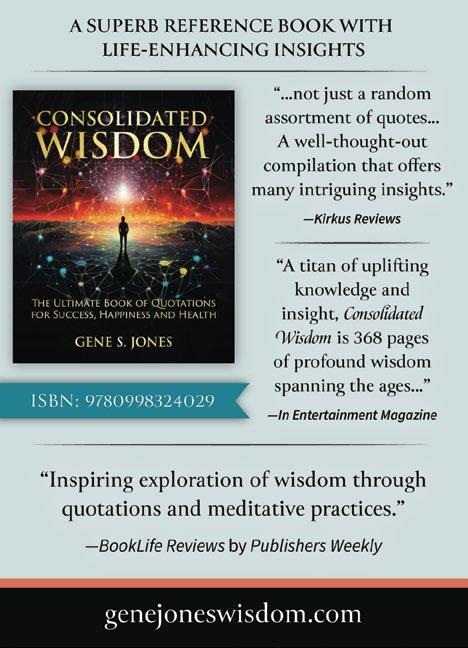

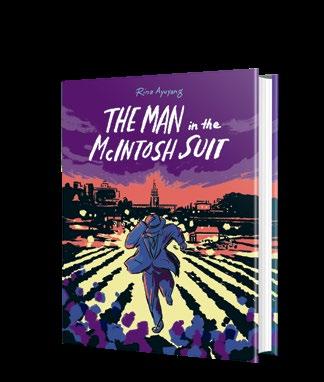

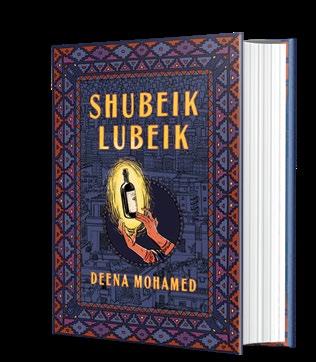

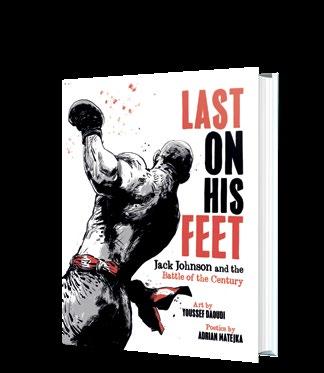
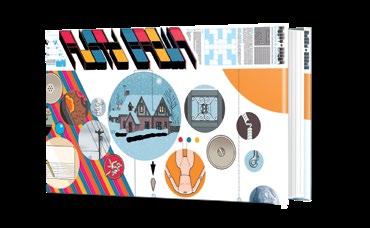
Atkinson, Kate | Doubleday (320 pp.)
$30.00 | Sept. 3, 2024 | 9780385547994

In his sixth outing, Jackson Brodie finds himself trapped in an Agatha Christie novel that is also a Jackson Brodie novel. The story begins with Jackson attending a murder-mystery weekend at “one of England’s premier stately homes.” Lady Milton, the doyenne of Burton Makepeace House, is confused by the large cast of characters. The private investigator himself can’t wait for this farce to be over. “It hasn’t even begun properly yet,” Detective Constable Regina Chase informs him. This setup is as delicious as it is improbable; there is no one in popular fiction less likely to enjoy a whodunit starring Reverend Smallbones and Countess Voranskaya than Atkinson’s world-weary (but intensely empathetic) private investigator. Before we get a chance to see how this situation unfolds, though, the narrative jumps backward a week to introduce Jackson’s latest clients. Hazel and Ian, the twin offspring of the late Dorothy Padgett, have hired the former police detective because someone—probably Dorothy’s carer—has stolen a Renaissance painting that hung in her bedroom. Next, Atkinson reintroduces Lady Milton, whose estate boasted a Turner until someone—probably the cleaner—absconded with it. This chapter, which is just over 20 pages, is followed by a chapter spent in the company of Reverend Simon Cate. This is 16 pages that feels like a lot more. Rereading the opening scene at this point gives one the sense that Atkinson is describing her own novel: There are too many characters, and it’s a bit slow. This is funny in the way that Atkinson is often funny, but the critique stands. By the time he returns, even Jackson seems
attenuated. Reading about him reading about art theft is about as exciting as it sounds. The pace does pick up, eventually, and fans who stick around will get what they came for. Even when she’s not at her best, Atkinson is still pretty good.
Bailey, Maggie | Crooked Lane (256 pp.)
$29.99 | Aug. 20, 2024 | 9781639107995

A retreat planned to boost sales at a failing fabric store goes awry when the participants start dying. Measure Twice, the fabric store Lydia Barnes runs in Peridot, Georgia, has been the center of her life ever since she bought the place from Fran, whom she thinks of as her fairy godmother. Unfortunately, it’s in dire straits financially. So Lydia accepts Fran’s invitation to offer a three-day sewing retreat at her home on Cherry Log Mountain in the hope of jump-starting the store’s fortunes. Fran’s place is a substantial mountain home with stunning interior spaces and drop-dead views. Lydia knows almost everyone who signs up, but there are some personality challenges and plenty of snippy exchanges. When one of the guests stuffs too many deviled eggs in the garbage disposal, Lydia calls attractive handyman Auden Williams to help—and it’s a good thing, too, because he warns them about an approaching ice storm that they hadn’t known about (since they’d turned their phones off for the retreat). While Auden helps them prepare for the storm, Lydia goes off to look for Fran to tell her about their emergency plans—but she finds her murdered in her bedroom. There’s no way the police can come until the storm ends, so Lydia, who was already involved in an earlier murder, resolves to do some investigating on her own. The group tries to keep busy
sewing by hand, but the secrets that emerge paint them all as possible killers, and a second death forces Lydia to dig deep to find the culprit. An icebound version of a lockedroom puzzle featuring limited suspects, unlimited suspicions, and a dash of romance.
Bell, Alice | Vintage (352 pp.) |$18.00 paper Sept. 3, 2024 | 9780593470657

Following their launch in Bell’s debut, Grave Expectations (2023), dynamic duo Claire (human) and Sophie (ghost) have returned to solve crimes in their own bumbling, endearing way. When true-crime-loving Claire Hendricks is invited/coerced by her friend Basher to join him and Alex, his 19-year-old nonbinary nibling, on a getaway at a wellness resort on Spike Island off the coast of Ireland, she expects a relaxing break for her and her supernatural bestie, whom only she can see and talk to. Claire’s life is usually far from relaxing. Not only is she tethered for life to Sophie, who died as a teenager, but she also has the power to communicate with other ghosts—a power that’s often frustrating since ghosts can be pretty needy. Unfortunately for Claire, this vacation is not the relaxing sojourn she’d hoped for. First, the resort is accidentally overbooked, and the other guests are a group of annoying university friends of the owner, Minnie. Then, Claire stumbles upon a ghost pirate, Cole Tovey, who wants her help figuring out who stole his treasure. And finally, to add even more drama, one of the guests turns up dead. Claire must deal with the somewhat unwanted advances of resort guest George Lyons, Sophie’s newfound independence, and suspicions that she may actually be the murderer (that’s just what happens when you have the habit of, to the
A
baker’s ascent is disrupted by the murder of her high school nemesis.
untrained eye, walking around talking to yourself all the time), all the while trying to catch the murderer. Bell does little to add depth to any of the characters, and Basher and Alex in particular are given an unfortunate back seat. If you’re looking for chilling twists and layered plotlines, look elsewhere. But if you’re up for a joyful romp (despite the abundance of murder) and goofy characters, this is the mystery for you.
A charming read for fans of the occult.
Bivald, Katarina | Poisoned Pen (432 pp.)
$16.99 paper | Aug. 13, 2024 | 9781728295763

An explosion in an English village leads an author to seek inspiration for her languishing project through informal investigation. Author and observer Berit Gardner has settled in Great Diddling, the perfect place to avoid writing her next novel. The citizens are simultaneously low-key and richly backstoried, which is perfect for Berit, who’s keen on taking in the sights and people around her without causing too much of a stir while she waits for inspiration to strike. Berit’s plans for respite go sideways when she’s invited to a tea party at Tawny Hall. Daphne Trent’s home is a testament to her everlasting love of books of all types, and the gathering promises to be a time for Berit to mingle among other townspeople and their tales. But getting to her destination, she’s nearly sidetracked
by a gift from her literary agent in the form of Sally Marsch, a new assistant who arrives on her doorstep unbidden. As both of them struggle to recover from the disorienting circumstances, Sally and Berit make it to the tea party in time for disaster to strike as a blast in Tawny Hall kills one guest and destroys several highly loved books. Berit’s natural reaction is to be intrigued. Because the deceased was well loathed, DCI Ian Ahmed has quite a task at hand. Poking into villagers’ lives in his outsider role proves fruitless, so he enters into an uneasy alliance with Berit, whose keen observational skills flush out secrets that some villagers have been working overtime to keep hidden. Slowly unearthing the connections between past and present provides pleasure to both the heroine and her audience. On the charming side of humorous and self-consciously charming.
Burns, Valerie | Kensington (288 pp.) $17.95 paper | July 23, 2024 | 9781496738240

A budding baker’s ascent is disrupted by the murder of her high school nemesis. Former social media influencer Madison Montgomery is making her mark in the tiny town of New Bison, Michigan. Thanks to the recipes her great-aunt Octavia left her, she’s revitalized Baby Cakes bakery. Attending the First Baptist Church has connected her with the local Black community, and
caring for Baby, the mastiff Octavia left her along with Baby Cakes, has led to an even closer connection with handsome veterinarian Michael Portman. So why would Maddy even care that Brandy Denton, who made high school hell for Maddy, has turned up in her new hometown? Because after high school, Brandy continued to torment Maddy, stealing away her fiance. And because Brandy tries batting her Botox-enhanced eyes at Michael. But mostly because Brandy turns up dead inside Baby Cakes, threatening Maddy’s newfound success and happiness. Because state trooper Robert Roberts focuses his investigation almost exclusively on Maddy, she gets to see what it’s like to be fighting not for a friend but for her own hard-won reputation. It won’t take long before she learns whether her success is a flash in the pan or whether her new community will abandon her at the first whiff of scandal. Her ordeal tests her growing bond with Michael, as well as her changing relationship with her father, Admiral Jefferson Augustus Montgomery, who’s proud of Maddy’s success but wants to protect his little girl from all harm.
A protagonist who juggles selfdoubts, a strong sense of self-worth, and a drive to succeed.
Hambly, Barbara | Severn House (256 pp.)
$29.99 | Sept. 3, 2024 | 9781448311057

The moral compass of an English expatriate will not let her ignore some of Hollywood’s more sordid exploits. After losing her husband, family, and fortune to World War I, Emma Blackstone has been reduced to working as a dogsbody when she’s rescued by her American sister-in-law, Kitty Flint. Kitty, aka Camille de la Rose, is a lovely but terrible actress of the silent screen whose affair with the studio
THE RIVER VIEW
head allows her to keep churning out movies. Emma, who’s ignored all sorts of illegal and morally repugnant activity, finds that she can’t ignore the treatment of child star Little Susy Sweetchild on the set of Kitty’s latest film. Susy provides financial support for her beautiful but untalented actress mother, Selina Sutton, who’s unconcerned when her daughter is almost trampled by a horse while shooting a scene. Susy bravely keeps working with only her cat, Mr Gray, to help calm her fears. Emma, who serves as chaperone, Pekingese wrangler, and occasional scriptwriter, has also just accepted a part-time job sorting out the paperwork left behind by a UCLA professor who died, possibly by murder, in his office. When Susy and her mother are kidnapped, Emma is appalled by the studio’s attempts to avoid paying the ransom. Susy’s father is a drunk and her grandfather and aunts are all trying to get custody of her in order to live off her considerable earnings, which her mother spends entirely on herself. With help from her lover, cameraman Zal Rokatansky, Emma embarks on a search for Susy, whom she fears no one cares about enough to rescue from what may be an inside job gone wrong.
Exciting adventures and thorny mysteries gain gravitas from pointed social commentary.

Hannah, Darci | Kensington (320 pp.)
$27.00 | Aug. 20, 2024 | 9781496747440

A chef and her grandmother attempt to solve a spooky ancient mystery, leading to a very modern murder.
Bridget “Bunny” MacBride, raised on a Scottish farm, works for grumpy celebrity chef Mary Stobart in Connecticut. She’s thrilled to be offered a job as chef on Food and Spirits , Mealtime Network’s new show. What she doesn’t know is that the show’s spirits aren’t potent potables but things that go bump in the night. Bunny, who knows all about ghosts, is appalled but can’t turn down her crack at stardom. So she joins cameramen Cody Jenkins, Ed Franco, and Mike Miller; producer Trig Gunderson; show creator and ghost hunter Brett Bloom; and fake psychic medium Gifford McGrady in heading for Bramsford Manor, a stately English home run as a hotel. Bramsford is one of several places that has a story about the Mistletoe Bride, who vanished while playing hide-andseek on Christmas Day in 1700, only to be found by her husband 50 years later trapped in a chest in the attic. Bunny heads right to the kitchen, where head chef Lilly Plum shows her the ropes and orders what Bunny will need to make a feast that will lure the bride, spotted by many over the years, into camera range. As it turns out, only Bunny and the
grandmother she calls in to help have any real psychic ability. After a white rabbit leads Bunny to find manor historian Marcus Bean’s corpse stuffed into the mistletoe chest with Bunny’s missing knife in his chest, she must uncover the truth to stay out of jail.
The intrepid heroine battles ghosts, her past, and a clever killer while serving great meals through it all.
Harrison, Jamie | Counterpoint (352 pp.) $28.00 | Aug. 6, 2024 | 9781640096325

To the relief of Jules Clement fans, the former sheriff and his beloved Caroline have returned to Blue Deer, Montana, in 1997, following a year of travel, in this first installment of Harrison’s series since Blue Deer Thaw (2000). Caroline is back working part-time in the Absaroka County sheriff’s department, but Jules has sworn off law enforcement and juggles jobs as an archeologist and private detective. About to build their dream house along the river, they have a 10-month-old baby whose constant physical presence becomes the novel’s symbol of hardy innocence. Domestic calm does not preclude comic, homicidal mayhem, though. A seemingly inconsequential death shows up on the first page, and soon Absaroka County is awash in questionable suicides, fatal accidents, mysterious murders, deadly family feuds, equally deadly land disputes, and random body parts. Responding to a request from his mother, Jules begins investigating the details surrounding the death of his father, Ansel, a popular sheriff gunned down while giving a routine speeding ticket more than 25 years ago. Soon, Jules senses friends are keeping secrets from him. Meanwhile, because Jules and Caroline keep their professional
lives separate and don’t always fully communicate—“the mysteries of cohabitation” are a definite theme here—they miss some obvious connections among the myriad plotlines. Aside from Ansel’s killing, these involve ancient gravesites interfering with a proposed right of way, the complicated ownership of a potentially valuable ghost town, the murder of an unpopular retired priest, and a missing acting sheriff. Expect the usual host of darkly colorful local characters, plus some shadowy Russians passing through. Characters and crimes come so fast and furiously that they clog up the first third of the book. Once the novel relaxes, patterns start to emerge. That the villain is obvious midway through doesn’t matter. What’s riveting is the ethical conflict Jules unearths: protecting (or surviving) the people you love versus defending justice. Serious issues here, but they take a back seat to Harrison’s sharp, bordering-on-absurdist humor.
Kuhn, Cynthia | Crooked Lane (304 pp.) $29.99 | Aug. 20, 2024 | 9781639100705

A library fundraiser turns deadly. The planners of a grand Gala Week to raise money for the library in Silvercrest, Colorado, consider themselves fortunate to have former resident Whitney Wilton and other cast members from the popular TV show Chasers on hand. Tabitha Baxter, leader of the gala committee, rules with an iron hand and has plenty of enemies to show for it. Emma Starrs, who’s given up her job on the academic tenure track to return home and run the family bookstore, Starlit Bookshop, has arranged a mystery panel, and Tabitha’s obliged to work with her
though she doesn’t like giving up any control. Things go sideways when Whitney’s niece and assistant, Lyra, passes out in a pile of cupcakes— and, later, her dead body is found in a freezer. Emma’s friend Jake Hollister, a detective who’s also a member of her writing group, is put in charge of the case. Emma’s success in solving a previous murder encourages her to do a little sleuthing, and since Lyra’s death has upended the gala plans, she agrees to help out despite Tabitha’s resistance. Disaster strikes again when the band backs out, someone cancels the reservation for the pre-party, and the Baxter Ballroom at Silvercrest College, the venue for the grand ball and silent auction, burns to the ground. In a superhero performance, Emma finds workarounds while reviewing motives for murder among both Hollywood stars and figures from Whitney’s past. She benefits from the clues provided by a series of near-deaths.
A mystery filled with secrets, animosity, and enough romance to lighten the mood.
Lloyd, Catherine | Kensington (272 pp.) $27.00 | Aug. 20, 2024 | 9781496740649

A penniless aristocrat in Regency England becomes quite the detective. Lady Caroline Morton is lucky in her employer. Mrs. Frogerton, for whom she works as a companion, may have gotten her money from trade, but she’s both shrewd and kind. Caroline’s father, the Earl of Morton, had left her and her sister, Susan, in a perilous position, and although Mrs. Frogerton generously pays Susan’s school fees, Susan is furious with Caroline for sending her away to school. One morning, Caroline is
surprised to receive a letter from her father’s solicitors regarding his will, and even more surprised when an aunt leaves her and Susan each 500 pounds. A few days after a visit to the law firm that hints there’s something odd about her father’s newly discovered will, Mr. Smith, the solicitor, vanishes and his office is ransacked. Well-born Inspector Ross, who’s investigating the case, has feelings for Caroline based on their work on earlier cases. Because the will is now missing and Mr. Smith, found in a hospital, is later murdered, Mrs. Frogerton insists that they investigate, in case money is actually due Caroline. Caroline soon hears stories about valuable South African mines owned by the DeBloom family, whose mother was involved with her father and whose son has a romantic interest in Caroline. Susan, not to be outdone by all the ructions in London, runs away from school, encouraged by her cousin Mabel, who threatens to carry Susan off to America unless Caroline shares her new inheritance. Caroline ends up putting her life in peril for her ungrateful sister.
A complex case with plenty of dead ends, surprises, and romantic interludes.
Lourey, Jess | Thomas & Mercer (331 pp.) $16.99 paper | Sept. 3, 2024 | 9781662513985
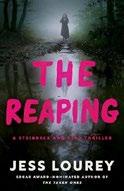
In an insular town in Northern Minnesota, a series of crimes stretches two Bureau of Criminal Apprehension agents to their limits. Harry Steinbeck is a rigid forensic scientist whose partner, Evangeline Reed, is intuitive and tends to bend rules. Both have pasts that haunt them. When Harry was a teenager, his sister vanished and was never found; Van grew up in a cult run by a charismatic grifter with an
iron hand. Their latest assignment involves a cold case that’s turned hot since a body was found with a crushed skull and shotgun wounds—just like the earlier victims. Back in 1998, the entire Korhonen family was murdered while they slept in the town of Alku, where all the villagers are descendants of Finns originally driven out of their country under suspicion of witchcraft. Almost everyone in town works at the Carlton County Treatment Center, originally a hospital, then a psychiatric institution, and now basically a nursing home for serial killers. The dead man, Peter Weiss, was a nurse there. Harry usually avoids Duluth, where his mother still lives, because he blames himself for never having found his sister. The new, or old, case just adds to his guilt and stress. All the Alku families bear a strange resemblance to one another. That includes head psychiatrist Pekka Tervo, who’s married to a dead ringer for Nurse Ratched, and who can’t admit that the old and new cases are connected. The adult residents of Alku are keeping their secrets so closely guarded that only their children can help Harry and Van find the truth.
Mystery and horror mix in a creepy novel whose suspenseful ending hints at a very special sequel.
Maxwell, Alyssa | Kensington (304 pp.)
$27.00 | Aug. 20, 2024 | 9781496736215
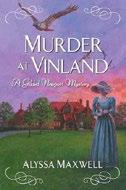
A series of horrific and inexplicable attacks on women provide a reporter a chance to solve yet another murder among the aristocrats of 1901 Rhode Island.
Though she still lives in Newport, journalist Emma Cross Andrews left society reporting behind to pursue other stories after
Juxtaposing the lives of ordinary people and the seriously rich enhances this tale of love, hate, and murder.
MURDER AT VINLAND
she married wealthy newspaper owner Derrick Andrews. On the one hand, Emma’s been reluctantly accepted by the Four Hundred as a relative of Cornelius and Alice Vanderbilt. On the other, her long-standing friendship with Newport Police Detective Jesse Whyte has involved her in many upper-crust murders. A luncheon at Vinland, a Viking-inspired mansion, in support of the Audubon Society attracts Second Lady Mrs. Theodore Roosevelt and the cream of Newport society, who in deference to the Audubon supporters have forgone their usual extravagantly feathered hats. At the luncheon, where she detects undercurrents of tension, Emma meets Amity Carter and her niece, Zinnia Lewis, newly arrived from Florida and friends of Vinland owner Florence Twombly. Amity has recently inherited the empty property next door to Emma’s, which she and Derrick have been hoping to buy; they want to build a new house there and turn her family home into a school. Delighted to learn that Amity approves their plans, Emma invites her and Zinnia to leave their hotel and stay in her guest room until they return to Florida. Things work out less well for luncheon guest Lottie Robinson, who has apparently been poisoned by an unidentified toxin delivered in petit fours and is not expected to survive. As other poisonings follow, Emma investigates a collection of motives ranging from broken engagements to insufficient devotion to protecting wildlife.
Juxtaposing the lives of ordinary people and the seriously rich enhances this thorny tale of love, hate, and murder.
Meyer, Nicholas | Mysterious Press (285 pp.)
$26.95 | Aug. 27, 2024 | 9781613165331

As World War I rages, Holmes serves, solves, and spies, and Watson faithfully records. Fifty years after topping bestseller lists with The Seven-Per-Cent Solution , which put Sherlock Holmes’ drug addiction front and center, Meyer continues to offer his own puckishly provocative version of the legendary sleuth. In his sixth resuscitation of Holmes, sturdily narrated once more by Dr. John Watson, the detective is a war hero, a fighter for social justice, and something of a diplomat as well as a brilliant crime reconstructor who solves the baffling shipboard murder that provides a trans-Atlantic version of the traditional lockedroom mystery. The tale begins in 1916, when Watson is treating casualties of World War I, in which Holmes valiantly served and was injured. They debate the case of Roger Casement, an Irish nationalist currently on trial in Britain for treason. Casement, like many other characters here, was a real historical figure. Meyer weaves him into the
episodic narrative along with sly Alice Roosevelt Longworth, U.S. Ambassador to Mexico Henry Fletcher, and several others, and includes vintage photos and documents as well. The Sherlockian mystery is solid and delightful on its own, but Meyer’s portrait of this moment in history adds a surprising and fascinating bonus. An additional meta layer is provided by an imaginative introduction in the form of a letter Meyer receives from a Japanese industrialist, along with the pages of Watson’s diary that account for the bulk of the novel. Ingenious international froth studded with historical tidbits.
Nickson, Chris | Severn House (224 pp.)
$29.99 | Sept. 3, 2024 | 9781448314409
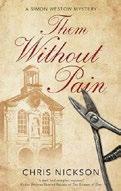
In 1825, Leeds is industrious, unhealthy, and dangerous for rich and poor alike. Although thieftaker Simon Weston has made a good living for his family and the assistants who’ve become like family, his latest job puts them all in danger. Simon is hired by Sir Robert Foley to recover four valuable silver cups that are especially precious to his family. Shadowed by his newest assistant, Sally, once a feral child, Simon hears that old buildings are to be destroyed to broaden a street. Something is rumored to be hidden in a secret room in one of those buildings once used by silversmith Arthur Mangey, who was hanged for
coin clipping over a century ago. Oddly enough, Sir Robert’s cups, which were likely stolen by his valet, were made by Mangey. The secret room turns out to contain the murdered body of valet Thomas Kendall, but no cups. Simon’s former assistant Jane left Simon after losing a finger in a knife attack, but she can’t leave her past behind. Jane agrees to help Simon by looking for clues in a collection of books and papers owned by a Mangey expert named Armistead. Meanwhile, Simon and Sally check out all the usual suspects, with no luck until Armistead is also murdered. Jane and Sally get their own case when a homeless beggar is almost killed by a man who goes on to murder others in a highly disturbing manner. As the sleuths slowly accumulate clues that point to the cups, Simon finds his most dangerous enemy in himself when he loses his confidence and makes mistakes that could kill him. Well-drawn characters, plentiful historical details, and a real feeling for Leeds in all its gritty glory.
Oldham, Nick | Severn House (224 pp.) $29.99 | Sept. 3, 2024 | 9781448314416

A London police officer is surprised to find her new rural post equally challenging and dangerous. A suspenseful prologue follows octogenarian Bart Morrison wandering away from his nursing
home and drowning after he meets an apparently dangerous unnamed person. From there, Oldham’s new novel runs on parallel tracks.
Sergeant Jessica Raker’s first day on the job in Lancashire, on the Irish Sea in the northwest of England, is far from routine. She’s been at her new station for only 10 minutes when a distress call comes from Dead Man’s Stake, a farm where a fireman’s being held hostage. Jess and Samira Patel, her new partner, arrest Bill Ramsden, the armed, drunken farmer who’s responsible for the fuss, but not before being subjected to harassment from the hostage. “I was going to say, thank God you’re here,” the firefighter says. “But is this the best the police can offer?” Jess’ backstory, unfolded in alternating chapters, explains her abrupt transfer from London to Lancashire. While responding to an alarm at Royale’s Jewellers in Greenwich, Jess killed armed robber Terry Moss, triggering both a mob contract on her life and a serious rift in her marriage to Josh, who, in a mind-boggling coincidence, was in the shop at the time of the robbery. Where next for this couple and their two children? Oldham heightens the tension via short, punchy chapters. The plot turns at length to the layered mystery surrounding the elderly Morrison’s death. Oldham’s tidbits of local color and invitingly fleshed-out portraits of Jess’ coworkers hint at the direction his new series will likely take, balancing Jess’ personal and professional challenges. A tangled rural mystery unraveled by a determined heroine.

Polito, Frank Anthony | Kensington (304 pp.)
$17.95 paper | Aug. 20, 2024 | 9781496750051

When a young woman in a wedding dress plunges from a balcony to her death, is it a tragic accident or murder?
Peter Penwell and JP Broadway, the stars of the reality TV show Domestic Partners , are bringing their skills to Woods Hall, a new project in the Detroit suburb of Pleasant Woods. Once a beautiful family home, the house has fallen into disrepair, and rumors abound that it’s haunted. Twenty-five years earlier, the owner’s bride, young Emma Wheeler-Woods, died by falling off a balcony while wearing a replica of Princess Diana’s wedding gown during a Halloween party. While the legal status of Emma’s death has never been determined, everyone says her spirit hasn’t left the house since that fateful night. Peter and JP are totally up for the challenge when Fiona Forrest, who’s just inherited Woods Hall, hires them to bring the house back to its former grandeur. The project offers the perfect combination of fix-it-up and potential mystery, just the way Peter and JP like. As the projects get underway, though, a series of events makes the two men unsure of whether the house is really haunted or they’re just having really bad luck. The Domestic Partners, who are also lowercase domestic partners, decide they need to find the truth about Emma even if it means doing some amateur
detective work. A series of detours, like a potential new pet, serve as both additions to and distractions from the main event.
A fun read that might have been stronger if it had been all mystery or all something else.
Pryor, Mark | Minotaur (304 pp.)
$29.00 | Aug. 13, 2024 | 9781250330604
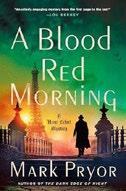
A police detective struggles to keep order in Nazi-occupied Paris. No detective would normally be assigned to investigate a murder that took place in front of his own apartment building. But nothing is normal under the German occupation. So when Chief Louis Proulx barges into Henri Lefort’s office on the last day of December 1940, the homicide detective doesn’t have the luxury of passing the case off to another detective because there are none. Interrogating his neighbors, however, proves tricky. The Millers, who live on the top floor, have disappeared, perhaps due to interference from Gerald Darroze, a third-floor tenant. Claire Raphael is engaged in a liaison with Obergruppenführer Maximillian Zoeller. The building’s superintendent, who’s fled to his native Greece, has been replaced by his charming young niece, Natalia Tsokos, who takes a suspiciously strong shine to Henri right away. No one is exactly on the up and up, not even Henri’s good friend Princess Marie Bonaparte,
A tense tale of people forced to survive with limited options.
who has access to quite a bit more food and wine than her ration card would permit. Once the victim is identified as Guy Remillon, a French snitch in the pay of the Germans, the pressure on Henri to solve the case grows. But does Henri even want to solve the murder of someone working for his city’s occupiers, much less deploy the limited resources that Remillon’s German employers permit him?
Pryor’s hero has his work cut out for him in this tense tale of people forced to survive with limited options.
Schellman, Katharine | Crooked Lane (320 pp.)
$30.99 | Aug. 20, 2024 | 9781639108411

A resolute Regency-era widow solves another mystery while navigating societal life in London. It’s 1817. Young widow Lily Adler, who’s earned a modest reputation for unraveling mysteries, is known as a Lady of Quality—that is, a discreet investigator. So it’s no surprise that Sarah Forrest and her fiance, Mr. Clive, ask for her assistance in unraveling a mystery surrounding her inheritance. Did Sarah’s father really put it under the control of his brother? But the fact that the request involves stealing a will from Sarah’s supposedly nefarious uncle triggers a moral dilemma for Lily. While Lily sympathizes with Sarah’s distress, she’s torn. And then Clive, whom Lily knows to be unscrupulous, tries to blackmail her, threatening to spread malicious gossip about her. Having constructed an elegant and engaging world over four previous mysteries, Schellman reintroduces her supporting cast in the several chapters Lily takes to decide on a course of action. Lily’s two closest confidantes are Ofelia, Lady Carroway, a young heiress recently arrived
from the West Indies, and Amelia Hartley, Lily’s “temporary companion,” who’s enjoying her first season in London society. The relationship between Lily and Captain Jack Hartley, Amelia’s brother and the best friend of Lily’s late husband, Freddy, remains stuck in the friendzone, eliciting much private agonizing for both parties. A murder provides a jolt of juice and a thickening of intrigue, but the lives of the three single London ladies remain persistently more interesting than what turns out to be a modest mystery wrapped in an elegant, romantic comedy of manners. There’s little doubt that Lily will discover the identity of the killer. But how smoothly will the course of true love run? That’s the real mystery. An engaging immersion in period romance with a whodunit chaser.
Tracy, P.J. | Minotaur (304 pp.) | $28.00 Aug. 20, 2024 | 9781250334350

The latest outing for LAPD homicide Det. Margaret Nolan and her squad is a pair of felonies that she’s convinced add up to a single case despite the lack of connecting tissue.
Why would Bruce Messane, the co-founder of Peppy Pets, miss the biggest business meeting of his life, his sit-down with the food mogul who’s interested in buying the high-end dog food company for $100 million? Because he’s dead in
his car in Culver City, that’s why. The vanishing of the deal, which would have been a bitter blow to Messane’s story of self-made success if he weren’t already dead, has dire consequences for chief financial officer Cynthia Jackson, one of Messane’s many ex-lovers, who owns 15% of Peppy Pets, and for retired veterinarian Rome Bechtold, Messane’s former partner, who may have inherited the 70% Messane owned. But that isn’t even the worst news Bechtold has to deal with, because less than 24 hours later, his wife, Nicole, is kidnapped by someone who pointedly doesn’t demand any money. Learning of the abduction despite the kidnappers’ threats to harm Nicole if her husband doesn’t keep quiet, Maggie Nolan can’t believe the two crimes aren’t connected. Her attention will be demanded by a bumper crop of complications. Despite Cynthia’s insistence that Messane would never steal from his own company, it looks like he’s been doing exactly that. And the notorious Los Zetas mob seems to be involved as well. Tracy knits the strands together conscientiously, though not dazzlingly, and the main effect of the final curtain will be to leave you waiting for the next installment.
Red meat for fans who want their procedurals as densely tangled as a real-life cop’s job.

Wortham, Reavis Z. | Poisoned Pen (384 pp.) | $16.99 paper Aug. 20, 2024 | 9781728256733

Self-described cattle cop Tucker Snow and his kid brother, Harley, stumble into yet another case that takes them a long way from cattle.
For more by P.J. Tracy, visit Kirkus online.
Tuck’s job description as special ranger for the Texas and Southwestern Cattle Raisers Association may not sound very exciting, but he keeps finding new ways to get into trouble. The latest involves the death of rancher Mitch Ramsey, who’d already lost a leg to cancer, and the sudden sale of his place to a shadowy collective. Wendel Cross, an agent for ChemShale, hints that he’s willing to pay Tuck plenty for certain information he never quite describes, and he indicates that he’s in a position to make Tuck’s life miserable if he doesn’t help out. Tuck’s life, of course, has already been miserable ever since the death of his wife and younger daughter in a collision with a car driven by a meth addict, but at least he and Harley have recovered Chloe, his remaining daughter, from the abusive meth dealer who kidnapped her. Piqued by Cross’ challenge, Tuck looks around for signs of criminal activity in Red River County and finds not only the usual cattle rustling, one round of which serves as a prologue to his latest case, but a mind-boggling array of higher-tech felonies. The leading players include perfect heroes, dastardly villains, in-betweeners, conspirators who mix virtuous and evil impulses, and free agents who can turn on a dime from bad guys to good. The plotting is erratic, but the pattern behind all the crimes and misdemeanors is clear: “The whole world is made from petroleum products” and suffers from the unimaginable harms they cause. Part Western, part mystery, all action.





Tobias Santelmann
The actor will play the Oslo detective in Netflix’s adaptation of Jo Nesbø’s novels.
Tobias Santelmann will play the lead role in Jo Nesbø’s Detective Hole, a new Netflix series based on the Norwe-
gian author’s series of crime novels, according to the Hollywood Reporter Santelmann, the Norwegian actor known for his roles in Kon-Tiki, Hercules, and Out Stealing Horses, will play Harry Hole, an Oslo police detective with unorthodox methods who struggles with mental health.
Hole first appeared in Nesbø’s 1997 novel, The Bat ; the novel was translated into English by Don Bartlett and published in the U.S. in 2013. Several more novels featuring the detective followed, including Nemesis, The Leopard, and, most recently, Killing Moon

The first season of the Netflix adaptation will be based on The Devil’s Star, which follows Hole on the trail of a serial killer in Oslo. Joel Kinnaman, the Swedish actor known for his work in the series The Killing and House of Cards and the films RoboCop and Suicide Squad, will play Tom Waaler, a corrupt Oslo police officer. Nesbø is among the show’s writers and executive producers.
Nesbø told the Hollywood Reporter, “All readers of the book series have their own

vision of what Harry Hole would look like, and they should be allowed to keep that. [But] we will create a Harry that is based not only on the books but on the actor Tobias Santelmann and everyone involved in this project—both in front and behind the camera. For me, storytelling isn’t about serving people what they think they want, but what they didn’t know they wanted.”—M.S.


Welcome to the graphic literature issue. Look for my list of Graphic Nonfiction Everyone Should Read on page 69, highlighting a few essential graphic-lit works of the past two decades (with more online). Here, I feature four significant books of graphic nonfiction from the year so far.
It seems fitting to begin with one of the most outspoken visual artists of the 21st century: Chinese exile Ai Weiwei. Zodiac: A Graphic Memoir, written with Elettra Stamboulis and illustrated by Gianluca Costantini (Ten Speed Press, Jan. 23), “blends manifesto and fairy tale,” as our reviewer described the work in a starred review. This edifying follow-up to Ai’s first memoir, 1000 Years of Joys and Sorrows, consistently and provocatively criticizes China’s authoritarian political system, closing with a sharp observation relevant to anyone pursuing a creative endeavor: “Any artist who isn’t an activist is a dead artist.”
Feeding Ghosts: A Graphic Memoir by Tessa Hulls (MCD/Farrar, Straus and Giroux, March 5) is one of
the most compelling memoirs of the year so far, graphic or not. “In her astonishing first book,” wrote our critic in a starred review, “Hulls sets out to discover not only what happened to her grandmother and how [certain] events shaped her mother’s upbringing, but [how they] informed her own relationship with her mother and the world around her.” The art recalls the work of Charles Burns or David B., as Hulls “analyzes not only the cultural and historical context of her grandmother’s and mother’s lives, but also her own motivations, assumptions, and failures to truly understand and empathize with that maternal line.” It’s a

psychologically and emotionally charged page-turner, “a work that glimmers with insight, acumen, and an unwillingness to settle for simple answers.”
Another graphic memoir that refuses easy interpretation is Heavyweight: A Graphic Memoir (Morrow/HarperCollins, June 25). In a starred review, we called out Solomon J. Brager’s debut as “an intense, brilliantly conceived graphic memoir announcing the arrival of a new talent to watch.” The author is unrelenting in their excavation of family history, investigating stories about the Holocaust that “mesmerized Brager almost as much as those about their great-grandfather Erich, mythologized as the man who beat Joseph Goebbels in a boxing match.” This is no straightforward graphic recounting of the author’s life. As our review notes, Brager “uses their formidable skills as an artist to transform that research journey into a unique comic book–style narrative that interweaves tales of their


inherited past with their own imperfect recollections.”
Unique among this assemblage of graphic works is The Puerto Rican War: A Graphic History by John Vasquez Mejias (Union Square & Co., May 14), a remarkable feat of graphic storytelling about a little-known piece of history. “Seized by the U.S. after the war against Spain and turned into an unwilling economic colony,” as our review explained, “Puerto Rico spawned a liberation movement after World War II.” Not content to merely describe the forgotten history, Vasquez Mejias employs an arresting “woodblock method [that] lends density and gravitas to the work that command attention; each centimeter of each panel is rich in visual detail, inviting readers to linger over the page.” (Read an interview with Vasquez Mejias on page 52.)
Eric Liebetrau is the nonfiction editor.


This chillingly meticulous chronicle of a dozen escapees from a Nazi extermination camp underscores the mechanics of heroism and the fallibility of memory.
Journalist Heath, a National Magazine Award winner, ably narrates the disturbing story of the camp at Ponar, Lithuania (“never a work camp”), where 70,000 Jews were rounded up, shot, and dumped in pits, beginning in July 1941, only to be disinterred and burned to hide the evidence. Throughout, the author expertly highlights the grisly contradictions and trauma of the Holocaust. Although what happened at Ponar had been documented by the end of World War II, the story was relegated to a
footnote for the next 30 years. The author masterfully resurrects the events, tracing accounts of the 12 men who miraculously escaped through a tunnel they dug at the killing pits on the night of April 15, 1944. As Heath recounts, they had been among 80 Jewish prisoners who were sent to the pit site to perform the grisly duties of digging up the decomposed corpses and burning them on towering pyres—so that, in the “magical thinking” of the Nazis, no trace of the crimes would be left as the Soviet troops advanced. However, not only did the 12 men escape and tell their stories— many not believed, though one testified at Nuremberg— but some of the inhabitants of

the forest town also saw what was going on, including a journalist neighbor who documented the activity in a diary that was later found and published in 1999. Heath painstakingly sifts through the conflicting accounts over the decades, analyzing discrepancies, details, and
contradictions. Ultimately, he learned, just like the survivors, “of how great the distance could be between speaking out and being heard.” Utterly absorbing in its powerfully detailed horror and inspiring redemption—a must-read in Holocaust studies.
Kirkus Star
Abramsky, Sasha | Bold Type Books (288 pp.) | $30.00 Sept. 3, 2024 | 9781645030430

A view of the MAGA-wrought culture wars as they play out in small towns. Abramsky, author of The American Way of Poverty and The House of Twenty Thousand Books, chronicles his visits to red islands in mostly blue states, such as Sequim, Washington, which was torn apart by antinomian politics during the pandemic. The county’s medical officer tried to head off the virus by requiring masks and restricting bars and restaurants to vaccinated patrons. It worked, and in the capital, officials “extended the proof-of-vaccination mandate to include the entire state of Washington.” Her strategy earned death threats, propelled by people who make significant money spreading lies. Abramsky ranges to places such as deep-red Shasta County, California, where locals seriously discuss secession when things like virus-control mandates arrive from the faraway capital and where political action is often a reaction to progressivism, such that “a half-century-plus of social change was being litigated and litigated again on a daily basis.” It’s in small-town America where the culture wars are being fought the most fiercely: where experts come under attack, where books are banned, where school boards are taken over by people intent on dismantling public education. More than that, as Abramsky illustrates at numerous points, in those small towns, where progressives are most often a distinct minority, those wars are being fought between right-wingers and farther-right-wingers, complete with litmus tests of ideological purity. Fortunately, it seems that more moderate forces are in the ascendant.
After the pandemic, writes the author, many voters returned to the center: “The majority…wanted their local public officials to be laser-focused on issues such as housing rather than going down rabbit holes about QAnon, about the evils of public health responses to a once-in-a-century pandemic, about stolen elections.”
An excellent, fearless work of political reportage in the face of America’s violent discontents.
Kirkus Star
Allen, Roland | Biblioasis (416 pp.)
$19.95 paper | Sept. 3, 2024 | 9781771966283

A celebration of the joys of putting pen to paper. British publisher and diarist Allen brings his love of notebooks to a lively, wide-ranging history of bound blank pages. Notebooks, he writes, “interest me as a technology that has had tangible effects on the world around us.” The author started keeping a journal in 2002: “Writing a diary made me happier; keeping things-to-do lists made me more reliable (which in turn made those around me happier), and I learned never to go to a doctor’s appointment, or a meeting of any kind, without taking notes of what I heard.” Wondering how and when notebooks were invented and why their use spread, he decided to fill a historical gap with the results of his own sleuthing. After an overview of record-keeping in the ancient world— diptychs, papyrus, and parchment—Allen begins in 13th-century Florence, where ledgers, first on parchment and later on paper, a superior product imported from Provence, became indispensable for business. Books of paper became indispensable for many artists, as well, who developed their techniques in sketchbooks. Notebooks grew in popularity, finding
uses in the home to keep track of accounts or compile personal anthologies of entries such as prayers, medical recipes, riddles, and poems. Those anthologies evolved into commonplace books, favored by Erasmus and W.H. Auden, among others. Ships’ logs, travelogues, recipe books, and naturalists’ findings are just a few of the many uses for notebooks across the centuries. Isaac Newton, Swiss naturalist Conrad Gessner, and Charles Darwin recorded their discoveries in notebooks; Leonardo da Vinci worked out inventions. In treating chronic pain or PTSD, physicians have found that for patients, keeping a diary has “proven therapeutic value.” As an intimate repository for thought, notebooks, Allen amply shows, are essential.
An enthusiastic, informative cultural history.
Ansari, Sadiya | House of Anansi Press (224 pp.) | $18.99 paper Aug. 13, 2024 | 9781487012373

A Pakistani Canadian journalist investigates the life of her mysterious Pakistani grandmother, a woman who abandoned her family to follow a lover.
Ansari never understood Tahira, the taciturn grandmother who lived with the author’s family for a decade until she died. Then an aunt casually revealed that Tahira had once walked out on seven children to be with another man. The “strict code of propriety” that governed family interactions kept Ansari from asking questions. However, when she was studying journalism in graduate school, Ansari began to probe her grandmother’s past through interviews with family members, historical research, and travel to Pakistan. She learned that Tahira had once dreamed of receiving an education, only to be forced into marriage at 14 to protect
A
often chilling— account of tangled webs, addled minds, and the evil that men do.
THE DEVIL AT HIS
her family’s economic interests. She became a widowed mother of seven 20 years later just as India was undergoing Partition. Her Muslim faith forced her to move north as a refugee to the new nation of Pakistan, where she struggled to raise her children. It was during this time of hardship that Tahira, lonely and without male protection, met a widower who dazzled her with his knowledge of poetry. Her eldest son, who disapproved of disregard for rules surrounding remarriage, forced her to choose between her lover and children. Tahira chose the former and endured disappointment from her lover and the pain of being separated from children she loved. Ansari succeeds in her goal to recast a vilified grandmother into a feminist heroine who struggled for self-determination in a culture that allowed her no choice. Yet as she reveals, the whole project of writing about Tahira raised many difficult issues, “inflicting damage [on loved ones] under guise of just doing my job” as an investigative reporter committed to the principles of ethical journalism. A thoughtful and informative memoir and familial investigation.
Apfel, Iris | Ed. by Laura Dozier
Abrams (288 pp.) | $50.00
Aug. 20, 2024 | 9781419776601

A multimedia celebration of the life of an iconic style maven. Throughout this glossy treasure trove of flare and fanciful grace, Apfel (1921-2024)
brings numerous elements of her career to vivid life. Split into sections focusing on the significance and interconnectedness of creativity, color, courage, playfulness, and longevity, the book offers continuously illuminating ideas on style, culture, and creativity. “Creative work gives me life,” writes the author, while “design feeds my soul.” Eye-catching photographs leap off the page as Apfel generously shares personal images and commentary about her early life, family, world travels, and affinity for vibrant, prismatic “happy colors.” The author’s heart and soul shine throughout her discussions of her oversize, bold jewelry, eyewear, and distinctive clothing as well as in a memorable photo of her seated in her ultrabright sitting room on her 100th birthday. Apfel delivers heartfelt stories of her creatively adventuresome life as an interior designer and manufacturing entrepreneur with her husband, Carl (her wedding dress was pink and strapless)—and how the “osmosis” of soaking up a host of multicultural experiences influenced the gaiety of her daily life and informed her sartorial aesthetic. Whether designing distinctive textiles, rugs, or clothing, Apfel’s myriad sources of inspiration and motivation always involved bright hues, unique and interesting patterns and textures, layered coloring, and the assistance of superstar designers. The author also offers sage advice on life, based on how she lived hers—e.g., trusting gut feelings, exploring one’s imagination, and living genuinely. “If I could remain one age forever, I wouldn’t,” she writes. “I don’t believe in that. I enjoy being alive. I enjoy people. I enjoy experience. I enjoy work. There is very little I don’t enjoy. Perhaps that’s the secret? Enjoy as much as you can.”
A delightful posthumous treasury to a flamboyant life embraced in full color.
Kirkus Star
The Devil at His Elbow: Alex Murdaugh and the Fall of a Southern Dynasty
Bauerlein, Valerie | Ballantine (480 pp.)
$32.00 | Aug. 20, 2024 | 9780593500583
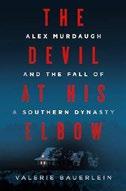
A fly-on-the-wall study of the infamous South Carolina attorney and murderer. Alex Murdaugh—which he pronounced “Ellick Murdick,” in the local Scots-influenced dialect—was a bundle of complexities, writes Wall Street Journal reporter Bauerlein, who also worked for The State newspaper in Columbia, South Carolina. “He was fundamentally unreadable,” she writes, “a walking mirage, always performing one role or another: devoted husband and father, connected friend, grantor of favors, defender of the downtrodden.” He was also an addict who stole millions from his clients, funneling the money into drugs and alcohol as well as misguided investments. Murdaugh was an equal-opportunity grifter, and so powerful in the Lowcountry where he lived that everyone looked the other way until the fateful night on which he shot his wife and son to death. So it had been for generations of Murdaugh power in Hampton County, where, one lawyer quipped, “A jury trial is the mechanism for the redistribution of wealth.” In his own jury trial, as Bauerlein reports after giving a blow-by-blow account of the grisly murders, Murdaugh sighed, “Oh, what a tangled web we weave.” And weave he continues to do: Sentenced to two life terms, Murdaugh has established a new fiefdom behind bars: “He had left behind the ruins of one empire. Now he was building another.” The cautionary lesson for readers is not that crime doesn’t pay—in Murdaugh’s case it did, and richly—but that eventually, even those who have gotten away with it for years receive their comeuppance. Though a latecomer in the Murdaugh sweepstakes—the first of at least three other books, John Glatt’s
Tangled Vines, appeared a year ago—Bauerlein’s gracefully written, thoughtful treatment is by far the best.
A memorable—and often chilling— account of tangled webs, addled minds, and the evil that men do.
Becker, Amanda | Bloomsbury (272 pp.) $29.99 | Sept. 10, 2024 | 9781639731862

A journalist chronicles the state of reproductive rights in the U.S. in the year following the Supreme Court’s decision to overturn Roe v. Wade. When Becker read the news that the Supreme Court was about to overturn Roe v. Wade, the seminal decision legalizing abortion, she knew she had to write a book about the devastating effects. “Recording this moment in our history is a form of bearing witness to that shared trauma,” she writes. In this urgent chronicle of the year after Dobbs v. Jackson Women’s Health Organization the case that overturned Roe —Becker shadows a collection of individuals fighting courageously for reproductive rights. In Maryland, she talked to the founders of a clinic that provides second and third trimester abortions. In Alabama, she interviewed the executive director of the West Alabama Women’s Center, who had to excuse herself from an interview on CNN when her lawyer texted her that the Dobbs decision meant that she had to stop abortion services at the center immediately. In Arizona, Becker had an eye-opening discussion with a family-planning doctor to try to understand why a state in which 64% of people believe “abortion should be legal in all or most cases” has some of the most restrictive abortion laws in the country. Throughout, Becker provides fascinating historical context, ranging from an
account of canvassing in ancient Rome to the origins of abortion regulations passed in the U.S. in the late 1800s. The author masterfully uses individual case studies to delve into specific aspects of the current state of reproductive rights, illustrate broader trends, and make poignant, trenchant connections between them. Her conversational tone and expertise on her subject matter render this an excellent primer on life after Dobbs
A beautifully crafted, thoroughly researched account of the state of reproductive rights after the Dobbs decision.
Black, Richard | Melville House (128 pp.) | $17.99 paper Aug. 6, 2024 | 9781685891350

A deep dive into the technologies and policies that will lead the world into a clean-energy regime—or not. “A clean energy system now exists that can eliminate the need to burn fossil fuels almost completely, without compromising anyone’s way of life.” So writes energy analyst Black, who identifies as the principal obstacle to that system the commanding presence of politics, so often dominated by the interests of fossil fuel producers. Five technologies and practices are in place that can change the world, writes the author—foremost among them renewable power generation (through wind and solar, primarily, and decidedly not through nuclear power, which he opposes). Another technology is electricity storage in the form of advanced, smart batteries, and still another is the development of “green hydrogen.” These technologies, Black notes, “are not quite the whole picture,” for they need to be assembled into a coherent system “where smart appliances respond to demand and hence prices.” One such appliance would be a dishwasher that can calculate when peak demand is down so that electricity prices are the lowest, thereby saving money for the owner and optimizing the electrical
system at the same time. And it’s not just about money: In the author’s well-reasoned argument for clean energy, he describes the liberating power of breaking away from a fossil-fuel economy in which consumers are hostages who “have to pay whatever price the seller is asking”—rather than, at scale, producers of energy via, say, solar panels whose surplus can be fed into the grid. Best of all, Black notes in closing, these five technologies “help create markets for each other,” very unlike the closed loop of an oil economy that poses ever greater dangers to the planet. Of much interest to readers concerned with energy, global economics, and life hacks alike.
Blakemore, Richard | Pegasus (512 pp.)
$35.00 | Aug. 6, 2024 | 9781639366330

Although a malefactor throughout history, the stereotypical pirate appeared in the turbulent decades from 1650 to 1730, and this is an entertaining account of that era.
In his first nonacademic book, Blakemore, who teaches social and maritime history, opens with a summary of post-Columbus Europe, when nations seemed mostly at war; even when they were at peace, they burned with envy at Spain, which had hit the jackpot in the New World. Many other European nations’ colonies turned up no mountains of gold and silver, but war offered the opportunity of raiding Spanish cities or seizing their treasure ships, an occupation open to entrepreneurs. Individuals could obtain official permission to attack enemy commerce and sail off in their own “privateers” to do so. Francis Drake, who delivered a fortune in Spanish wealth to Queen Elizabeth, was considered a pirate in Spain for actions that were legal in England. The Peace of Westphalia in 1648 vastly reduced conflicts between
AND THE ROOTS OF RHYTHM REMAIN
European imperial powers but left a mass of unemployed “freebooters.” Furthermore, the agreement did not apply in the New World, where maritime plundering continued without official support. Traditional accounts portray pirates as captains of rogue warships preying on peaceful commerce, but it was more profitable, if riskier, to loot seaside towns. Blakemore’s iconic figure is Henry Morgan (1635-1688), a successful Welsh privateer who continued raiding after it became illegal. The so-called golden age of piracy lasted until the 1730s, and the author’s lively account features the well-known (Blackbeard, William Kidd), along with more obscure figures. Blakemore concentrates on the Caribbean and Atlantic sea lanes but does not ignore the rest of the world, and he pays close attention to European governments, which became increasingly concerned with suppressing piracy and, despite severe difficulties, enjoyed some success. Compelling maritime history.
Boland, Eavan | Norton (448 pp.)
$24.99 paper | Sept. 3, 2024 | 9781324074281

How a poet found her vocation and rejoiced in it. In this collection of essays by influential Irish poet Boland (1944-2020), editor Randolph, a British academic, includes some selections from published prose collections, as well as a number of previously uncollected articles, including a long, unpublished draft of “Daughter,” a powerful piece about motherhood and
poetry. “As time went on,” writes Randolph, “Boland’s prose grew clearer in focus and purpose; she argued that a poet’s work is not just to write their poems, but also to contribute to the critical conversation in which they will eventually be judged.” Autobiography drives many of these early pieces from Boland’s 1995 book, Object Lessons. As a young woman, she had “entered into a life for which poetry has no name.” Nonetheless, before she was 20, she was “sure” she was a poet. She bemoans “lacking the precedent and example of previous Irish women poets.” Other essays examine the political poem, “who writes it and why”; the “fusion of the sexual and the erotic” in her own poems; and the influence of other women poets, especially Adrienne Rich and Elizabeth Bishop. In her 2011 book, A Journey With Two Maps, Boland explored how “an apparently monolithic poetic past was transformed into a conversation I could join and change”— as the “radical and disruptive” Elizabeth Barrett Browning had. A mother, Boland enthusiastically resurrects the “domestic poem.” In the last section, there’s a delightful 2003 piece about a “piece of rough magic”—i.e., a computer and Boland’s feelings typing poems into an “unlimited horizon.” A witty 2008 piece touches on the “quirks and absurdities about the poet’s fit in the world.” In another, a despondent Boland wonders, “Why have so few women, in the history of poetry, been citizen-poets?” This wide-ranging collection is sound testimony to Boland’s “fit” in the world.

Kirkus Star
Boyd, Joe | ZE Books (760 pp.) | $40.00 Sept. 3, 2024 | 9798988670025
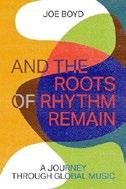
The noted record producer, sound engineer, and musicologist surveys the many sounds the world has to offer.
The title is from Paul Simon, whom Boyd, author of White Bicycles, met back in the 1960s when Simon was in the process of making a Martin Carthy treatment of the old folksong “Scarborough Fair” his own. But borrowing is the nature of the game, and musicians are often a step behind the times. Even as Simon, enamored of Zulu music, was recording Graceland, “on home ground, world music’s biggest sellers—Le Mystère des Voix Bulgaires, Buena Vista Social Club, Ladysmith Black Mambazo—were considered old-fashioned, even reactionary.” The kids, in other words, weren’t listening. Instead, hip-hop reigns in Ghana, the Rolling Stones in Rio, and heavy metal in Hungary—though Boyd adds, “even the hardest-core Hungarian heavy metal headbanger will acknowledge a fondness for Muzsikás, Márta, and táncház,” traditional sounds that world music–loving hipsters began to eat up courtesy of Peter Gabriel, David Byrne, and other explorers. Boyd’s leanings are catholic, his enthusiasms varied, and he engagingly explores how Ry Cooder gathered the traditional Cuban musicians who made up Buena Vista, Herb Alpert scrapped light jazz for mariachi, and so on. Readers should prepare for a flood of disparate data that adds up to something more than trivia: Argentine bassist Leopoldo Thompson “may have been the first anywhere to deliver percussive slaps to this normally bowed instrument”; Elvis Presley was crazy for Dean Martin and Jerry Lewis, and thus “Dean Martin’s Italianate crooning is all over Elvis’s vocal style”; “Wimoweh” owes its title to “Pete
Seeger’s mishearing of uyimbube”; and much more. It’s marvelous, sometimes careening adventure, as Boyd darts from one musical obsession to another. A grand treat for musicophiles and an entertaining walk through world music, leading readers to countless sounds and styles.
Kirkus Star
America First: Roosevelt vs. Lindbergh in the Shadow of War
Brands, H.W. | Doubleday (464 pp.)
$35.00 | Sept. 24, 2024 | 9780385550413

A fine account of one of the most famous opponents to America’s entrance into World War II. Historian Brands, bestselling author of numerous books on American history, writes that while nearly everyone today considers Hitler a loathsome figure, this was not the case throughout the 1930s. When Germany’s army marched into Austria and Czechoslovakia after 1938 and talk of another war began, U.S. Congress quickly proclaimed neutrality. Two years later, polls showed that most Americans were opposed to getting involved, and Roosevelt, accustomed to telling voters what they wanted to hear, regularly assured Americans that he agreed. Still an international hero, Charles Lindbergh visited Europe that year, receiving red carpet treatment, meeting national leaders, and touring factories that were contributing to the war effort. He came away with a low opinion of Britain and France, but he praised Germany’s
order, prosperity, and military technology. After its September 1939 invasion of Poland, he spoke on national radio to warn Americans not to interfere. He kept a diary and journalists vacuumed up his opinions, so Brands has no trouble describing the vivid clash of ideas between his two principal subjects. Lindbergh joined the isolationist America First Committee, but his Midwestern “simplicity” often harmed his cause. A fall 1941 speech urging Jewish Americans to stop pushing the nation toward war produced media outrage. During a 25-minute speech in Iowa, Lindbergh “not only destroyed his reputation—he expected this—but simultaneously discredited the antiwar movement and killed any plausible alternative to [Roosevelt’s] globalist vision.” Toward the end of this gripping, if unedifying tale, Brands adds that Lindbergh was wrong about only “one big thing”: that Americans would recoil from the responsibility as they did after World War I. “Lindbergh saw the path ahead and found it appalling,” writes the author. “Americans trod the path and found it irresistible.” Another winner from Brands.
Clarke, Rachel | Scribner (256 pp.)
$28.99 | Sept. 10, 2024 | 9781668045435
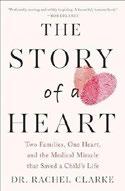
A British doctor explores how organ donation and transplant permanently intertwined the lives of two families.
Max Johnson, a 9-year-old
A fine account of one of the most famous opponents to America’s entrance into World War II.
“soccer-playing, tree-climbing, playfighting force of nature,” was the last person anyone thought would need an organ transplant. However, when a virus invaded his body and fatally damaged his heart, Max took his place on a list of British children awaiting organs. Clarke, author of Breathtaking and Dear Life, shows how the heart of another life-loving 9-year-old, Keira Ball, found its way into Max’s chest just in time to save his life. A little girl who loved horses, Keira was in a car accident that severely injured her mother and brother. Paramedics resuscitated her heart, but tests later revealed that Keira’s injuries had left her brain-dead. As her grief-stunned father struggled to comprehend his loss, an older sister made the preternaturally compassionate suggestion that Keira’s organs be donated. Clarke follows the path of Keira’s heart from its listing with the UK’s Organ Donation and Transplant Hub to its perfectly executed surgical retrieval, made just as Max underwent the surgery that would allow him to accept a new heart. Interweaving other stories about surgeons like Clarence Walton Lillehei and Christiaan Barnard, who advanced “heart transplantation from a state of wild speculation into sober reality,” the author also examines the moral and emotional complexities that surround organ donation itself. Max survived to live the teenage life Keira did not, yet as Clarke makes clear, that difficult surgery ultimately provided palliative care rather than the restoration of a normal lifespan. Thoughtful and sensitive, this book not only illuminates a little-discussed topic but also reveals that just as medical science has wrought miracles, it has also raised “profound questions about what it means to be alive.”
A poignantly celebratory tale.

Coe, Tyler Mahan | Illus. by Wayne White Simon & Schuster (512 pp.) | $35.00 Sept. 3, 2024 | 9781668015186

Coe turns his acclaimed podcast series into an entertaining history of the deep roots of American popular music and show business.
The ostensible subjects of this book, which is based on the second season of the podcast that shares its name, are indeed George Jones and Tammy Wynette, the briefly married occasional collaborators who dominated country music from the 1960s to the 1980s. Jones is still considered the “Greatest Country Singer Ever” by fans and fellow musicians, while Wynette is best remembered for her “anti-feminist” anthem “Stand by Your Man.” The pair shared formative relationships with one of Nashville’s great producers, Billy Sherrill, who, in addition to nurturing their sound on vinyl, helped construct their public personas via a carefully curated catalog of songs hinting at an abiding love between them. In fact, Jones and Wynette were each uniquely troubled human beings who, at the height of their respective careers, struggled with addiction, mental illness, bad relationships, and bizarre behavior bordering on criminality. Coe’s podcast became a hit for taking an unusually meandering, even scholarly approach to its subject matter, which this book replicates. The narrative takes sudden, surprising deep dives into tangentially related areas—e.g., a history of pinball machines and jukeboxes, the recipe for moonshine, bullfighting’s metamorphosis from quasi-religious festival to proletarian sport and fashion inspiration, and much more—leaving readers to sort out the relevance. “It’s not necessary to cover such wide-ranging territory through abrupt twists and turns,” writes Coe, “while largely leaving the reader to connect the dots for
themselves….But that is what I’ve chosen to do because it’s a lot more fun. There’s a difference between handing someone a twenty dollar bill and handing them a treasure map.” White’s illustrations are an added treat.
A gifted storyteller with vast cultural knowledge, Coe has given readers not just a map, but a true treasure.
Cohen, Brian Tyler | HarperCollins (224 pp.)
$27.99 | Aug. 13, 2024 | 9780063392885
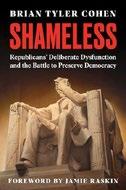
A progressive political commentator offers his insights into the dysfunction that characterizes the modern Republican Party. In his debut book, Cohen argues that the “Party of Lincoln” has been hijacked by “a burgeoning extremist faction for whom compromise is unacceptable and chaos is the goal.” Furthermore, “this reality is getting exponentially worse year after year—and as citizens, we are becoming dangerously numb to it.” The authoritarianism Republicans now represent threatens American democracy, and the assaults on decency and common sense, as made by the likes of Marjorie Taylor Greene, pose grave dangers. Drawing on conversations with historians, constitutional scholars, former senators, attorneys, and Biden administration cabinet members, Cohen suggests that GOP dysfunction comes from a perverse desire to break—rather than reform—a government system they believe is too large to function well. Before Trump became the party’s “racist, misogynist, anti-everything narcissist” center of gravity and just after Obama’s 2008 election win, Republicans like Newt Gingrich were laying the groundwork for a strategy built on opposition for partisan gain. Others, like Mitch McConnell, would pursue that strategy relentlessly throughout both Obama’s and Biden’s
tenures as president. At the same time, they transformed “human wrecking ball” Donald Trump into the GOP standard-bearer who gave them license to “openly court white supremacists and neo-Nazis, who now march proudly down our streets.” However dismal the current political landscape, Cohen still believes that the situation can be salvaged if Americans recognize the power of their own agency. Rather than take refuge in helplessness, the author suggests that citizens must not only continue to participate in democracy, but they must also actively persuade those who have lost faith—and who now constitute the margins on which modern “elections are won or lost”—to participate as well.
A refreshingly bold and candid voice.
Cook, Jesselyn | Crown (272 pp.)
$30.00 | July 23, 2024 | 9780593443255
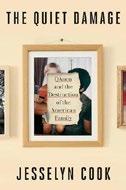
W hen Trump tweets a typo, is it secret code? As this odd report from the land of conspiracy theory demonstrates, plenty of people think so. NBC News investigative reporter Cook examines five families who have been swallowed up, in some way or another, by the outlandish claims of QAnon. It doesn’t take much to see that buying into the ideas that space lasers are causing forest fires, that Tom Hanks enjoys torturing children, and that pedophiliacs congregate in pizza parlors is an expression of mental illness. However, as the author recounts with considerable empathy, that illness is a kind of death by despair, one to which elderly and isolated people are especially vulnerable. In one instance, a widowed mother, emotionally broken, denounced her son for voting for “your beloved China Joe” instead of Trump, who she believed was going to orchestrate a massive roundup of Deep State personnel on December 22, 2020. In another case study, a woman in >>>


IN 1898, AT the end of the Spanish-American War, Spain surrendered its colony of Puerto Rico to the United States. The United States installed a new territorial government, shored up the police, and, while making Puerto Ricans U.S. citizens in 1917, cracked down hard on a rising independence movement. Fifty years after the conquest, the Puerto Rican flag was banned, and a network of police informants kept a careful watch on anyone thought to harbor thoughts of a free Puerto Rican nation.
In 1950, small episodes of armed revolt broke out on the island. The U.S. Air Force bombed one rebel holdout, the mountain town of Jayuya. At almost exactly the same time, two Puerto Rican nationalists attempted to assassinate President Harry Truman in Washington, killing a police officer. Two years later Puerto Rico was declared a commonwealth with a nonvoting member in Congress. The independence movement continued to simmer, and in 1954 a nationalist leader named Lolita Lebrón and three
With woodblock prints, the artist tells the little-known story of the Puerto Rican independence movement.
BY GREGORY MCNAMEE
others opened fire inside the Capitol, wounding five legislators.
Ask the proverbial person on the street about these events, even in Puerto Rico, and you’ll likely be met with a blank look. That’s where John Vasquez Mejias’ new book, The Puerto Rican War: A Graphic History (Union Square & Co., May 4) comes in, blending solid history with striking woodcuts that tell the story of that struggle for independence.
Vasquez Mejias, 51, is the son of Puerto Rican immigrants who moved to New York’s Spanish Harlem in the 1950s, “but as [my parents] had kids they whisked us off to Long Island,” he explains. Determined to be an artist from a young age, he studied studio art in college, then earned a master’s degree in education and became an art teacher in the New York City public schools. “One day this woman came to the school and said, ‘I can get you a job right now, but it will be more like missionary work with a lot of Dominican kids and Puerto Rican kids.’ I and one other person raised our hands: ‘Sign us up!’”
Vasquez Mejias, who now makes his home in the Bronx, pursued other passions while teaching. One was singing in a punk rock band, which he still does—“I’m really just sort of yelling melodically”—and the other was studying Caribbean history and working on his book.
Asked why the events he describes in The Puerto Rican War are so little known, he offers a blunt reply: “The broadest thing to say is that nobody cares. Who knows why some things get picked up in history and some things don’t? When I was in high school, I had a teacher who was Irish, and I learned a lot about Irish history. But I kept thinking, are you going to mention Puerto Rico even once ? And he didn’t. But then I was invited to do a show at a gallery in Puerto Rico, and the owner, who was about my age, didn’t know anything about it either. When he was in school, it wasn’t part of the curriculum.”
That Vasquez Mejias did come to know the story was thanks to his parents, “who are very proud Puerto Ricans and would tell me about culture and history at home.”
His father, a veteran of the U.S. Marines, was particularly incensed by the fact that the Puerto Rican flag had been outlawed for so long, and he wasn’t shy about making his feelings known. “I’d been making comics about being an art teacher for a while by then,” he says. “But I said about everything I had to say, so I started thinking about what else I wanted to do. Well, here’s this thing that’s been on my mind and my family’s mind for all this time, and I thought I’d tell that story. That really put the fire under me.”
Vasquez Mejias returned to his student days, reviving an interest in printmaking and painstakingly carving wood blocks. “I was teaching full time all day, and then I’d come home, eat dinner, and work until I was exhausted. Although I got better and faster as I worked, it still took me six years to make the book. If people see me carving, they’ll comment on how fast I am, in fact, and I tell them, ‘Yeah, but it took me 20 years to get this fast.’ Of course, I look at my daughter, who makes art with her iPad, and it makes me feel like an antique.”
With echoes of Picasso, Diego Rivera, the German expressionists, and other modernist masters—plus a nod, Vasquez Mejias hastens to add, to Jack Kirby of Marvel Comics fame—and printed with dense black and gray inks, The Puerto Rican War sat unpublished for a bit after completion. Then he self-published it, with a newspaper printer in Queens running off 1,000 copies. “Thanks to a website and social media, it really took off,” he says. “People loved it. So I got a grant and printed 2,000 more. By word of mouth and the internet, social media, it just started taking off more and more. Then one day I got an order from the Metropolitan Museum of Art, and they put the book in a show, and it took off even more.”
The original edition of The Puerto Rican War now resides in
the museum’s permanent collection. Meanwhile, a friend with whom he had drawn comics long before, Jay Sacher, had signed on as a senior editor at Union Square and acquired the book for trade publication in a handsome hardcover edition. “As soon as it came out,” Vasquez Mejias reports with a laugh, “my dad said, ‘Yep, now it’s going to get banned.’”
Vasquez Mejias is now looking more closely at the life of Lolita Lebrón, the revolutionary leader who was radicalized after the U.S. governor of Puerto Rico ordered the police to shoot into a crowd of unarmed demonstrators in 1937. (The governor was removed from office but not otherwise punished.) “You know, they were just going to unfurl the Puerto Rican flag and fire their pistols in the air, but one guy got carried away and wounded five congressmen,” he says of the 1954 attack on the Capitol. “Lebrón was a
seamstress, like my mom and my aunts who came to New York at about the same time. They were expecting to be killed, but they were taken alive and were sentenced to life in prison, although President Carter released them in the late ’70s.”
Meanwhile, quietly, a Puerto Rican independence movement endures, occasionally making the news, as when Congress resolved in 2022 to allow a referendum considering the question of national sovereignty. “Some people want statehood, some people want things to stay as they are,” Vasquez Mejias says. “Since I’m who I am, I talk mostly with the people who are interested in independence. I’m a little baffled that the whole island isn’t for independence, but I don’t know. I’m baffled by a lot of things in politics.”
Gregory McNamee is a contributing writer.
Although I got better and faster as I worked, it still took me six years to make the book.

failing health came to believe that “vaccines didn’t just cause autism anymore,” but were part of a government conspiracy. Behind all of this misguided thinking are hucksters making a profit, whether selling horse medication as a cure for Covid-19 or survival kits for the zombie apocalypse. “In this regard,” writes Cook, “QAnon was a microcosm of the Trumpian Right: a more extreme and insular product of harmonized lies from right-wing politicians, media figures, and influencers”—and all with profit in mind. Hard reality—the loss of jobs, marriages, family, friends—can sometimes turn QAnon believers around. But overall, Cook concludes, “what we’re facing is as much a wellness crisis as it is a disinformation crisis,” one that will require an army of therapists to deal with.
A dispiriting but eye-opening hop down the QAnon rabbit hole, where plenty of literal madness lies.
Cowen, Josh | Harvard Education Press (224 pp.) | $34.00 paper Sept. 10, 2024 | 9781682539101

A professor of education policy examines how a small group of wealthy conservatives developed a rationale to privatize schools and support school vouchers.
Cowen, “an expert on school choice who spent formative professional years working with and around leading voucher advocates,” makes a solid argument that vouchers do more harm than good. To demonstrate his point, he examines the individuals and organizations that have promoted—and continue to promote— voucher programs. He begins by showing how the voucher concept originated as a reaction to Brown v. Board of Education. At the beginning, Milton Friedman suggested that parents, rather than government, should have the right to determine where
their children went to school. The emergence of a powerful conservative movement (and figures like Charles Koch and Betsy DeVos) a few decades later brought the issue to the cultural fore. Cowen examines the development of the first voucher program in Milwaukee in the early 1990s and how the wealthy, right-wing Bradley Foundation used its money and political influence to “legitimate vouchers as a school reform strategy.”
A federally funded program in Washington, D.C., which was itself shepherded into existence by conservative “foot soldiers,” followed. Turning to his own experiences, Cowen suggests that research advocating voucher programs is itself the product of the same wealthy, Christian nationalist networks. At the same time, that research has not been enough to counter the “utter, empirical disaster” that the school voucher system became in the 2010s. Donald Trump reignited the voucher controversy, transforming it into an ideological debate that would have repercussions in later Supreme Court rulings that allowed parents to use voucher money on private religious schools. While this book will likely not interest general readers, educators and education-policy specialists will no doubt appreciate Cowen’s attention to detail and thoroughness.
A well-researched book for the public policy crowd.
DeRozan, DeMar with Dave Zarum Harmony (240 pp.) | $28.00 Sept. 10, 2024 | 9780593581261
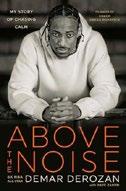
A six-time NBA All-Star and two-time Olympic basketball gold medalist tells the story of how his sport helped him find the peace of mind and security he did not know as child. Compton native DeRozan grew up amid constant hardships and danger, and he learned early to ask questions only when he had to and otherwise “mind [my]
own business.” His escape was playing basketball, which began as a pastime. But when he started watching VCR tapes of old NBA games his father swapped with neighbors, DeRozan quickly became obsessed with the seemingly superhuman skills of legends like Julius Erving, Alex English, and Kareem Abdul-Jabbar. As the author’s own athletic talents become more evident, his father encouraged his pursuit. However, the lessons his father taught him on the court were never easy and sometimes drove the author to tears. Yet the focus basketball instilled in him ensured that DeRozan avoided the rampant drugs and gang activity around him. A McDonald’s All-American team member in high school, he earned an athletic scholarship to USC, and he was drafted ninth overall by the Toronto Raptors in 2009. DeRozan marveled at the luxuries his new life afforded him and his family, but at the same time, he was forced to realize just how brutal the NBA business world—with its unannounced trades and sudden teammate departures—could be. As he recounts in this surprisingly honest tale, his greatest—and perhaps most humbling lesson—came from being forced to acknowledge his own limits after realizing he suffered from depression. However much he accomplished on the court and off, DeRozan was still a product of an unforgiving environment that forced even the most successful to bear the weight of “growing up in [a] cycle of pain, fear and forging onward,” despite countless “scars.” Heartfelt and inspiring.
Dias, Elizabeth & Lisa Lerer | Flatiron Books (448 pp.) | $32.99 | June 4, 2024 | 9781250881397

A thorough investigation into how Roe v. Wade fell.
“The antiabortion movement succeeded because most people did not believe it
would.” So write Dias, national religion correspondent for the New York Times, and Lerer, a Times political reporter, who interviewed hundreds of people and reported from 16 states and the District of Columbia. The authors organize the 36 chapters into four chronological parts. “The Righteous Fight” begins with the huge influence of Marjorie Dannenfelser, an antiabortion activist who viewed the movement as “a spiritual battle about what it means to be human.” The authors go on to chronicle the history of Planned Parenthood, long supported by Republicans. In the second part, “The Political War,” Dias and Lerer delineate how that support turned into opposition as the organization came to represent “the diminished power of traditional religion, gender roles, and families in American life.” In a culture where Democratic voters proved to be unmotivated by abortion, the antiabortion movement was reemerging and gaining momentum among Republicans, especially social conservatives. “For more than forty years, the antiabortion movement was David, fighting Goliath,” write the authors, “but the country had shifted, and they were giants.” The third section, “The Chessboard,” covers Trump’s election and details how he garnered support among antiabortion voters. Following his victory, liberals were caught off guard; they had no planned response to the threat against abortion rights. In “The Fate of the Nation,” the authors examine Brett Kavanaugh’s confirmation and how the Supreme Court became “more conservative than at any other point in modern history.” At that point, antiabortion leaders were able to flip the court. The book’s greatest strength is the authors’ comprehensive and incisive approach to explaining that “Roe did not just fall once, on June 24,
2022. Roe collapsed over a transformational decade.”
Devoid of rhetoric, this evenhanded work exemplifies outstanding reportage.
Dupont, Carolyn Renée | Prometheus/ Globe Pequot (224 pp.) | $21.95 paper Sept. 17, 2024 | 9781493085989

A historically based argument for abolishing the Electoral College as a major step toward a better democracy. It’s not breaking news to observe, as Dupont does, that the Electoral College is tightly bound up in the history of slavery. She adds a subtle nuance to the point, however: The slaveholding states gained an advantage during the Constitutional Convention by counting enslaved people as three-fifths of a person for census purposes, with the result that South Carolina could command more clout in the national legislature than, say, New Jersey. More pressing was the insistence by the slaveholding and smaller states that direct voting be blocked; since enslaved people could not vote, it would have given the populous northern states an edge over the South. “Slavery did not cause the framers to choose an Electoral College,” writes the author. “But slavery did prompt the Convention repeatedly to reject popular election in preference for Congress selecting the president.” She drums on the no-direct-vote trope a few times too many,
A cautionary tale about the (frequent) pitfalls and (infrequent) profits in the cryptocurrency game.
but to a useful end—namely, that the winner-take-all system of the college effectively disenfranchises huge numbers of voters, from the 6 million Californians who voted for Trump in 2020 to the larger number of Texans as compared to New Yorkers who voted for Biden. A proportional Electoral College would see Texas as a purplish state where Republicans hold only a six-point advantage, at least for the moment. Put another way, a California electoral vote represents 717,000 voters, whereas a Wyoming electoral vote represents 193,000. In the end, Dupont persuasively urges, the Electoral College is a vestige of slavery and white supremacy that “amounts to blatant and extreme political inequality”—good reason for doing away with it. Repetitive, but with good points to make against an institution whose time has passed.
Eliason, Nathaniel | Portfolio (304 pp.) 30.00 | July 9, 2024 | 9780593714041
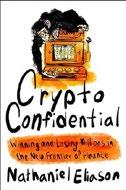
A cautionary tale about the (frequent) pitfalls and (infrequent) profits in the cryptocurrency game. Borrowing a page and title from Anthony Bourdain’s Kitchen Confidential, Austin-based “crypto insider” Eliason delivers the same sort of behind-closed-doors exposé of how things really work, in this case the shadowy world of cryptocurrency. He opens with a personal tale, chronicling how he watched aghast as the trading operation he’d put into place was hacked by a potential blackmailer. The hacker had something to work with, a nice pot of digital money that Eliason had assembled, and which represented early success: “A year earlier, I never could have dreamed of making this kind of money.” Blame it all
on his desire to learn how to code and then realizing that other coders weren’t slogging at 9-to-5 jobs but instead gambling on crypto and making considerable, if often evanescent, fortunes. As Eliason and many other tech writers have shown, crypto is a gamble, one based on riding a boom until just before it busts and then selling while the selling is good. There’s plenty of potential left in crypto, argues the author, especially given the inherently liberating possibilities of blockchain technology. There’s also all the risk inherent in praying that the “greater fool theory” will hold long enough for the investor to make a few bucks—or a few million bucks—in the crypto marketplace. Eliason’s anecdotes are both entertaining and instructive, and unlike many books on Bitcoin et al., this one doesn’t require background in either computers or economics. More useful, and worth the price of admission, are his notes on the warning signs of disaster, one in particular being “when you think you’ve figured out the game and you’re about to get insanely rich.”
Essential reading for anyone playing—or thinking of playing—in the crypto sandbox.
Fitzgerald, Melissa & Mary McCormack
Dutton (608 pp.) | $35.00
Aug. 13, 2024 | 9780593184547

A celebration of all things West Wing from a pair of former cast members. As the Trump presidency battered the norms of American democracy and Covid-19 forced citizens to nest indoors, the White House TV drama, which originally aired from 1999 to 2006, enjoyed a second life as a tribute to steady leadership. Fitzgerald and McCormack, who played assistant press secretary and deputy national security adviser, respectively,
A haunting, jagged, sparkling narrative puzzle in which the pieces deliberately refuse to fit.
QUESTION 7
strive to evoke the show’s upbeat, pro–public service spirit throughout this book, dishing anecdotes about the series and spotlighting the charitable endeavors of its cast and crew. The authors gained excellent access to key figures on the show, from creator Aaron Sorkin (who wrote the foreword) to stars like Martin Sheen, Rob Lowe, and Alison Janney, down to the Steadicam operator (a crucial role on a program infamous for its “walk-and-talks”). There’s plenty of insider trivia—e.g., Eugene Levy was once a candidate to play grumpy communications director Toby, Hal Holbrook was in the running to play President Jed Bartlet, and Sheen financed regular cast-and-crew trips to Las Vegas. The authors dedicate chapters to a handful of episodes especially beloved by the show’s fans (aka Wingnuts) and explore the show’s legacy since its end among creative and political communities. (Lin-Manuel Miranda notes cases where he unconsciously borrowed West Wing patter for Hamilton.) The book is mainly hagiography, with participants celebrating the close-knit family vibe on the set and lamenting low points like the death of John Spencer, who played Bartlet’s chief of staff; touchy subjects, like Lowe’s departure over salary, are handled gently, almost apologetically. A nonpartisan history of the show remains to be written, but this is satisfying on its own terms, determinedly refusing to see “government” as a four-letter word. A gauzy but thorough exploration of a prestige-TV standard-bearer.

To
Kirkus Star
Flanagan, Richard | Knopf (288 pp.)
$28.00 | Sept. 17, 2024 | 9780593802335

The noted Australian author spirals through personal and collective history searching for connections between past and present, but often distrusting those that appear.
Flanagan, author of The Narrow Road to the Deep North, finds the struggle to create a credible memoir troubling, since most autobiographical work must be constructed from “the lies we call time, history, reality, detail, facts.” In this distinctly nonlinear example of the form, the author pulls at threads connected to key, often traumatic events. One of these nodes is the years his father spent in a Japanese internment camp during World War II. Flanagan notes that he almost certainly would have died of starvation were it not for the atomic bombs dropped on Hiroshima, leaving the author conflicted about the devastating loss suffered in Japan combined with the fact that he would never have existed without the catastrophe. He reaches back to tie the bomb to the life and work of H.G. Wells, who first conceived it in one of his lesser-known novels, and to Hungarian physicist Leo Szilard, who was captivated by Wells’ novels and who first conceived of the idea of a nuclear chain reaction. Another node is Flanagan’s shards of memory of his parents, including his mother’s last words before her death at 95: “Thank you all for coming. I have had a lovely time.” A third key element of this fascinating work is Flanagan’s prolonged
near-death by drowning as a river guide when he was 21, to which he refers frequently throughout the book—and then at horrifying length in the final section. “Everything ever since,” he writes, “has been an astonishing dream….Perhaps this is a ghost story and the ghost me.”
A haunting, jagged, sparkling narrative puzzle in which the pieces deliberately refuse to fit.
Frankl, Viktor E. | Trans. by Joelle Young Beacon Press (144 pp.) | $21.95
Aug. 20, 2024 | 9780807020432
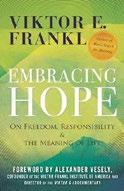
A celebrated psychotherapist and philosopher offers insight into why humanity must persevere in its quest to find meaning in everyday life.
Frankl, the author of international bestseller Man’s Search for Meaning, has long been considered one of the most influential thinkers of the 20th century. Yet not all of his work has been translated or made available to wider reading audiences. The four pieces that comprise this collection—three essays and one interview with the author on Canadian TV—were written or transcribed between 1946 and 1984; all deal with the inevitability of human suffering and eternal struggle to find hope and peace. In the opening essay, the author reflects on the transience of human life and the responsibility of each individual to not only “recognize opportunities for meaning” but also fulfill them despite any suffering that person may be experiencing. Turning tragedy into triumph and suffering into an achievement mitigates transience, opening the door to meaning, and all depends on individual choice because, as Frankl explains in the piece that follows, meaning “can be found irrespective of the environmental situation.” In the third essay, the author suggests that such modern-day ills as fanaticism and
collectivist thinking are really signifiers of the existential emptiness that arises from feelings of purposelessness. The way human beings can move past that emptiness is by resisting the temptation to do nothing and—and, as Frankl discusses in the last essay—taking “responsibility (for choices and actions) in the face of transience” and suffering. These essays are without a doubt the products of the difficult, often alienating century in which they were written, but the wisdom—and, perhaps more importantly, hope—they offer during a time of competing global emergencies and the threat of human extinction is both comforting and necessary. Decades-old writing that remains timely.
Ganz, Marshall | Oxford Univ. (232 pp.) $29.99 | Aug. 1, 2024 | 9780197569009

A spirited, encouraging handbook for progressive organizing. Less confrontational than Saul Alinsky’s Rules for Radicals, Ganz’s book grows from similar circumstances: Freedom Summer, antiwar activism, labor organizing. “One of the most profound—and useful—lessons I learned in Mississippi was the difference between resources and power,” writes the author. Black people may have not had political power, but they surely had the resources to organize and resist. By the author’s lights, that organization and resistance is all about nurturing democracy, meaning “the equal value of each person’s voice in making collective decisions about the good of the whole.” In this spirit, people working in organizations for change must be led by true leaders who are listening to them, taking their voices and experiences into account, and giving them responsibilities whose fulfillment are their own reward. Here, to name one helpful instance,
Ganz contrasts the treatment of a phone-bank volunteer calling to encourage voters to support a favored candidate: In one case, she’s stuck in a corner with a script and a cookie; in another, she’s encouraged to converse with the person on the other end of the line and depart from the script while delivering the essential message—i.e., being creative and owning a piece of the effort. Ganz identifies five interlocking practices that speak to achieving change and ensuring organizational continuity. Updating Rabbi Hillel, he encourages his readers to tell stories and act in ways that address the famous question, “If not now, when?” Writing in a friendly, open manner and with strong attention to detail—“Be very specific about the date, time, and place. Do not be shy. Be certain. And be joyful (if appropriate)”— without being persnickety or holier-than-thou, Ganz encourages meaningful action for change. The user’s manual that progressives have been missing until now—highly recommended.
Gottlieb, Iris | TarcherPerigee (240 pp.) | $18.00 paper Aug. 20, 2024 | 9780593712771

A writer and illustrator examines filthy truths about the global trash system. In the modern world, garbage is complicated. “For some it’s a treasure, for others it’s invisible, and for more it’s an enormous human and biological hazard,” writes Gottlieb, author of Seeing Science, Natural Attraction, and Everything Is Temporary. In their latest book, Gottlieb examines not only the history of trash and where modern trash goes, but also the many different types of waste that constitute the monolith known as trash. Preindustrial cultures lived close to the waste they produced, and they
repaired their possessions, which were made from natural materials. Industrialization changed all that by laying the foundation for modern mass-consumer society, complete with toxin-spewing factories, massive landfills, and incinerators. Gottlieb suggests that in rich countries such as the U.S., these “arms” of the industrial world tend to be invisible, especially to wealthier residents who can choose to live away from the results of their consumption. That invisibility also helps residents to think less about the consequences of throwing away billions of pounds of textiles, paper products, and especially plastics, which, even if “greenwashed” as recyclable, do not make the products eco-friendly or sustainable. In keeping with their desire to raise reader consciousness about the extent of the trash problem, Gottlieb also examines the other, less-discussed but no-less-problematic forms of waste derived from computer manufacturing, hospitals, sewage systems, the funeral industry, and space exploration.
Thorough and disturbing but also engagingly illustrated with informal black-and-white drawings, the book reveals how the choices offered as a way out of the trash morass (e.g., recycling) not only are “intentionally confusing” but also do not set up consumers—or societies or the planet—for anything other than failure.
A must-read for anyone who cares about understanding how the Earth got “trashed.”
Griswold, Eliza | Farrar, Straus and Giroux (352 pp.) | $30.00 Aug. 6, 2024 | 9780374601683
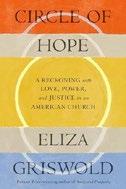
A chronicle of a progressive evangelical church that fell into infighting and eventual decline.
In a landscape that emphasizes
rightward-leaning evangelicalism, New Yorker writer Griswold offers the counterpoint of a “radical evangelical” church. Founded by Gwen and Rod White in 1996, Circle of Hope had grown to four congregations in greater Philadelphia by the time the author began following them in 2019. The pastors helped their members overcome painful past religious experiences and performed acts of companionship and service in their gentrifying neighborhoods. Like countless other organizations, Circle of Hope lurched toward a crisis of identity in 2020, confronting both the pandemic and the nationwide reckoning with racist systems of oppression. As each pastor attempted to lead, their shared mission and collaboration began to fray, leaving the church at a precipice. A crucial conversation about the tension among personal devotion, social activism, and institutional loyalty sits at the center of Griswold’s text, especially meaningful in the current political environment. The author’s own history makes her an especially powerful voice, and she offers an engaging mix of sympathy and reserved skepticism. However, flaws in narrative structure and spotty details muddle the chronology and significance of each interaction between the pastors and other church leaders. Griswold devotes much attention to shifting alliances and personal slights whose impacts seem out of proportion to their presentation, leaving more profound and pertinent themes—racism, sexism, the blind spots of founders and leaders, and the relationship between political and religious identity—simmering under the surface. The author titles each chapter with the name of one of the pastors she profiles, but she presents an array of perspectives in each section, jumping back and forth among people and events along a relatively condensed timeline. This lack of clarity diminishes
the impact of Griswold’s well-intentioned investigation. Tangled and murky, despite glimmers of a hopeful, alternative faith.
Gumbs, Alexis Pauline | Farrar, Straus and Giroux (528 pp.) | $35.00 Aug. 20, 2024 | 978-0-374-60327-4
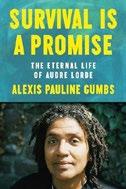
A celebration of a tireless advocate. Gumbs, a queer Black feminist poet, pays homage to Audre Lorde (1934-1992), drawing on her subject’s poetry, published prose, and the trove of archival sources—including journals and her own hair—that Lorde donated to Spelman College. Responding to Lorde’s evocation of nature in her works, Gumbs describes her book as a “cosmic biography where the dynamics of the planet and the universe are never separate from the life of any being.” Stars, hurricanes, and even whale songs feature in a narrative notable for lyrical prose and unabashed admiration. Disability shaped Lorde’s childhood, notes the author. She didn’t speak until she was 5, and she stuttered when she finally did speak; in addition, she was visually impaired. Her parents, Caribbean immigrants, were strict. Lorde recalled “constant and unpredictable punishment” but also her father’s reverence for books, which nurtured her love for reading. She tested into the prestigious Hunter High School, where she found her first love; when she took her own life, Lorde was devastated. After graduating, although she won a scholarship, her family couldn’t
A defiant woman sensitively and incisively portrayed. SURVIVAL IS A PROMISE
afford to pay tuition, so she worked her way through Hunter College, which was free, spent a year at the University of Mexico, and continued on to Columbia’s School of Library Service. Gumbs offers thoughtful analyses of Lorde’s poems, as well as the pressures and pleasures of her life: friends and lovers; marriage to a white gay man; motherhood; divorce; and recurring cancer. Her most enduring relationship was with Black feminist scholar Gloria Joseph. The first Black faculty member in the English department at John Jay College of Criminal Justice, Lorde subsequently taught poetry at Hunter College. Throughout a storied career, her commitment to Black feminist communities—and to speaking out against injustice, racism, and oppression—was unwavering.
A defiant woman sensitively and incisively portrayed.
Hammad, Isabella | Black Cat/ Grove (80 pp.) | $18.00 paper
Sept. 24, 2024 | 9780802163929

A speech delivered by the author in September 2023 at Columbia University, with an afterword on Gaza.
“The Palestinian struggle for freedom,” writes British Palestinian novelist Hammad, author of The Parisian and Enter Ghost, “has outlasted the narrative shape of many other anticolonial liberation movements that concluded with independence during the twentieth century, and it is becoming more difficult to hold fast to the old narratives about the power of narrative.” The author opens by referencing Edward Said’s 1975 book, Beginnings, addressing her choice to begin in the middle of stories, specifically “the shifting narrative shape of the Palestinian struggle in its global context.” She views Said, primarily, as a literary scholar, crediting his “engagement with fiction as an heir to a
particular kind of humanism…that commits itself to crossing boundaries between cultures and disciplines.”
Acknowledging that most of her own writing has been about Palestine, Hammad illustrates this with a story that also demonstrates anagnorisis, which Aristotle described as “a movement from ignorance to knowledge.” She interweaves her thoughts on narrative structure and aims—e.g., “The material we draw from the world needs to undergo some metamorphosis in order to function, or even to live, on the page”; “Literary anagnorisis feels most truthful when it is not redemptive: when it instead stages a troubling encounter with limitation or wrongness”—with examples of comparative literature as well as Palestinian history, including her great-grandfather’s life and the continued persecution of Palestinians by Israel. “Narrative shape can comfort and guide our efforts,” writes Hammad, “but we must eventually be ready to shape-shift, to be decentered…in the project of human freedom, which remains undone.” The anti-Zionist afterword addresses Israel’s attack on Gaza nine days after the author’s speech and the ongoing war: “Do they really believe they can obliterate the Palestinian will to life?” Simultaneously scholarly and righteously impassioned.
Hanson, Rachel M. | Univ. of South Carolina (208 pp.) | $22.99 paper Aug. 20, 2024 | 9781643364933

A harrowing debut memoir in which the author describes her extremely difficult childhood. When she was 12, Hanson recalls, “my family of eight lived in a two-bedroom trailer in Sullivan County, Tennessee, and nearly every night for dinner the children ate popcorn.” Her mother was a cruel woman who aligned her family with strict, vaguely religious guidance:
School was “evil,” so attendance was forbidden, and any effort to be social or independent was quickly branded sinful. Vengeful and manipulative, she leaned on preteen Hanson for child rearing. “I was rough,” Hanson writes, “a girl with bitten nails and rashes on my hips from carrying the children she kept having.” The author quickly learned that “there was no safe space under my parents’ roof.” The specter of mental illness lurks beneath these distressing vignettes. Hanson’s mother had “good days” quickly followed by “a relapse of the unknown sickness [she] claimed to have.” Later she writes, “I suspect she did pray, sometimes getting the answers she wanted between burning herself with cigarettes and sleeping the day away.”
The author tried to run away from home, finally cutting ties at 18. Though understandably haunted by memories of the younger siblings left behind, she recognizes the impossibility of living a healthy life and remaining connected with her family. Hanson’s tender, lyrical prose offers an unsuspecting sense of solace and hope. Despite all she has faced, it’s clear that the adult who emerged from relentless trauma is capable of compassion. While she doesn’t seek forgiveness or answers—“I understand we can never go back and that things cannot be set right”—she strives to accept her awful past for what it was and take yet another step away from it, onward.
A book about disturbing experiences, related with cleareyed catharsis and memorable prose.
Harrington, Brooke | Norton (192 pp.) $22.00 | Sept. 17, 2024 | 9781324064947

A Dartmouth sociology professor explores the complex, supersecret world of offshore finance. When Harrington, author of Capital Without Borders,
Alex Gibney is adapting the author’s memoir about his near-fatal stabbing attack.
A documentary based on Salman Rushdie’s memoir Knife: Meditations After an Attempted Murder is in the works, Variety reports.
Rushdie’s book, published in April by Random House, is his account of the 2022 stabbing attack in Chautauqua, New York, that nearly killed him. The legendary author of Midnight’s Children and The Satanic Verses lost vision in one eye and use of one hand after the assault.
In a starred review, a critic for Kirkus praised the memoir as “a graceful meditation on life and death that captures Rushdie at his most observant and lyrical.”
The adaptation will be directed by Alex Gibney, the acclaimed and prolific Oscar-winning documentarian behind films such as Enron: The Smartest Guys in the Room; Going Clear: Scientology and


the Prison of Belief ; and The Inventor: Out for Blood in Silicon Valley.
The documentary will contain footage shot by Rushdie’s wife, writer and artist Rachel Eliza Griffiths, as well as interviews and archival photographs.
“I’m delighted we have Alex working with us on this film,” Rushdie said. “We have long admired his brilliant work, from Taxi to the Dark Side and Going Clear to his recent portrait of Paul Simon. There couldn’t be a better person for the job.”
Gibney said it was “a delight and an honor” to work on the documentary.
“The opportunity to make this film about his recovery— in the broadest sense of the term—comes at a critical time,” he said. “It gives me hope.”—M.S.






The Message is a new work of nonfiction by the author of Between the World and Me.
A new nonfiction book by Ta-Nehisi Coates is coming later this year.
One World will publish Coates’ The Message this fall, the press announced in a news release. In the book, it says, Coates “travels the world to explore how the stories we tell—and the ones we don’t—shape our realities.”
Coates worked as a journalist before publishing his first nonfiction book, The Beautiful Struggle: A Father, Two Sons, and an Unlikely Road to Manhood, in 2008. He followed that up seven years later with Between the World and Me: Notes on the First 150 Years in America, which became a bestseller and won both the Kirkus Prize and the National Book Award.
Since then, he has published several comic
books; another nonfiction book, We Were Eight Years in Power: An American Tragedy ; and a novel, The Water Dancer
The Message is composed of three essays, focused on Senegal, South Carolina, and Palestine. One World says that while working on a book about writing, Coates “found himself grappling with deeper questions about how our stories—our reporting and imaginative narratives and mythmaking—expose and distort our realities.”
“Written at a dramatic moment in American and global life, this work from one of the country’s most important writers is about the urgent need to untangle ourselves from the destructive nationalist myths that shape our world—and our own souls—and embrace the liberating power of even the most difficult truths,” the press says.
The Message is scheduled for publication on Oct. 1.—M.S.


For a review of Between the World and Me, visit Kirkus online.
began studying offshore finance in 2007, she found that almost no data existed about those taking advantage of the system. Knowing she could not directly access wealthy individuals herself, she made a plan to earn wealth manager credentials so she could access them through their financial managers. Through classwork and interviews with her colleagues-intraining, the author learned that the system was less a scheme for tax avoidance and more a “platform for an elite insurgency opposed to…equality before the law, economic stability [and] free markets.” Staying hidden is critical to the success of offshoring projects because “secrecy confers impunity.” She argues that part of what makes this system so insidious is the way it has repurposed the legal and financial infrastructure of the old imperial era for the new transnational elite. These practices have in turn transformed former poor ex-colonies like the Bahamas into law-free zones where deals that support the illegal enrichment of the already wealthy can take place. At the same time, the lure of wealth and profit have brought even rich democratic countries like the U.S. (which boasts a few of the most popular offshore centers in the world) into the plutocratic wealth management game. Apart from publicly shaming the individuals who use the system, Harrington suggests that one effective way of curbing their activities is cutting the connection between the superrich and their managers. In a world where everything else can be bought, “trust is not a commodity and cannot be purchased easily from another provider.” Intriguing and timely, this book will be of interest not only to academics, but to anyone seeking an understanding of the hidden forces behind global wealth inequality.
Illuminating, accessible reading.
Henion, Leigh Ann | Algonquin (336 pp.)
$30.00 | Sept. 24, 2024 | 9781643753362

A lyrical, fascinating story about exploring the secret world of darkness and the remarkable creatures within it.
In today’s hectic, digitally focused world, writes Henion, we have become too used to an excess of illumination: the unblinking screen, the persistent streetlight, the overbright room. Furthermore, we have lost a sense of the presence of darkness and an understanding of what happens there. The author explored this idea in her 2016 book Phenomenal: A Hesitant Adventurer’s Search for Wonder in the Natural World, but in her latest, she dives deeply into a world that is unknown to most readers. She begins with fireflies, which are plentiful in the mountains of North Carolina, where she lives, as well as glowworms and night-traveling salamanders. She chronicles her travels through her area and further afield, encountering guides and naturalists who are studying nighttime creatures. The animals and birds that come out at night can be difficult to spot, but Henion finds that her eyes and spirit can slowly adapt to the darker, more natural world. She also describes the plants that bloom under the moonlight, often with strange structures and rich perfume to attract moths and insects. In a striking chapter, the author examines the luminous fungi known as foxfire, which has a beauty all its own. She recounts her experience of making fire from natural materials as evening
writes with poetic grace.
NIGHT MAGIC
gathered and how she felt connected to the long line of humanity. There is a sense of renewal throughout, and she realizes the importance of occasionally escaping from the world of unrelenting, artificial light: “It is only by the power of light and the grace of darkness that we’re able to rest and rise, then rest and rise again.” Henion writes with poetic grace, blending her journey of discovery with the natural wonders in our own backyards.
Hernandez, James Lee & Brian Lazarte
Grand Central Publishing (352 pp.)
$30.00 | Aug. 6, 2024 | 9781538720110

A twisty tale of a forgotten scam and the devoted FBI agents who brought it down. Documentary filmmakers Hernandez and Lazarte, who created the titular HBO series, recount the strange story of con artistry taken to the stratosphere. The chief con, known as “Uncle Jerry,” was a blowhard former cop who talked his way into heading security for an ad agency with an unusual account: handling McDonald’s Monopoly game, which readers may remember from a few decades past. For many years, thanks to Uncle Jerry’s machinations, “all of the winners who walked into various McDonald’s restaurants across the country, waving a winning game piece and claiming a victory over the gods of chance, were cogs in a skillfully crafted conspiracy of fraud.” For a time, Uncle Jerry’s chief lieutenant was a near-stereotypical gangster from the Colombo Mafia family. The setup involved finding a mark to take a winning ticket and then kick back half, plus pay taxes on the whole shebang. Millions of McDonald’s dollars later, the perpetrators had burned a few people in their con. Enter an informant, whose surprising
identity the authors reveal at the end, and a forensic accountant from an FBI field office who figured out how to milk confessions from the minions by pretending to be a promotional filmmaker working for McDonald’s. The enterprise fell apart thanks to that oldest of destructive forces, greed. “Most of the ‘criminals’ in this story were merely good people who made a bad choice,” the authors write sympathetically; oddly, some paid a higher price for their greed than did the real criminals. In any event, though heavily covered by the media, the scam went into immediate obscurity, overshadowed by the catastrophic attacks of 9/11. Though most of the bad guys are deeply unappetizing, true crime buffs will enjoy the cat-and-mouse game of catching them.
Hoppe, Jessica | Flatiron Books (272 pp.)
$29.99 | Sept. 10, 2024 | 9781250865229

A Honduran Ecuadorian journalist and mental health advocate explores substance abuse in her family and its relationship to immigrant and racial trauma.
Born in San Antonio in 1982, Hoppe was the first-generation American child her parents believed would have everything they did not. Coming into the marriage, her parents achieved their own personal firsts like mothering without abandonment and fathering without violence. What they didn’t realize was that the American dream they chased across the country would demand “the sacrifice of our physical and mental health.” It would also cause the author to fall victim to the alcoholism that destroyed her maternal grandfather. College, the great American gateway to a shining future, brought with it stresses for Hoppe, as well, including a heavy work and class schedule and expectations of moving directly into a well-paying job. It also became the place
where, overwhelmed by responsibility, she learned to see alcohol as the cure-all “solution” to hardship and the systemic injustices she faced as a brown-skinned woman. As her drinking worsened, Hoppe began forgetting incidents involving extreme, often dangerous levels of intoxication. She eventually found her way to therapy and Alcoholics Anonymous, only to discover that AA had no room for stories that involved the social inequities Hoppe knew had fueled her alcoholism. “Race-related trauma was labeled terminal uniqueness,” she writes, “and dismissed as a false projection of my self-centered ego.”
As the author fought her way back to sobriety, she uncovered healing truths about relatives who had suffered from addiction and about the real yet unacknowledged founders of the modern recovery movement, Native Americans. As this raw, at times unsparing memoir probes the meaning of the American dream for immigrants, it also reveals the sickness inherent in all white supremacist projects, including those meant to heal. An illuminating and intense reading experience.
Hrdy, Sarah Blaffer | Princeton Univ. (432 pp.) $29.95 | May 14, 2024 | 9780691238777
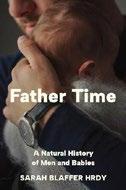
A revolutionary look at the “mother” in men. Hrdy is the visionary anthropologist who, with colleagues, discovered the importance of allomothering (co-parenting by groups other than the mother) to the evolution of big-brained humans. Our brains are so complex that they need years to fully mature, which could have slowed Homo sapiens’ population growth and led to extinction. However, with allomothers—often, menopausal women with time to help raise children—primary mothers could produce more children faster, ensuring
survival. The work rocked anthropology, but Hrdy wasn’t done. Recently, watching her son-in-law take exquisite care of his infant, she began to wonder if she needed to redefine the term allomother. She tested her saliva, and that of her husband, for the nurturing hormone oxytocin before and during a period when they cradled their grandchild. Her oxytocin rose significantly. The shocker: Her husband’s oxytocin levels rose slowly at first, but within hours, matched hers. Soon after, the author discovered that tests for nurturing hormones, from estrogen to prolactin, delivered similar results in many men worldwide after prolonged exposure to babies. Are men as endocrinologically transformed and neurologically transformed, in both frontal cortex and evolutionarily ancient brain areas, as women by prolonged close proximity to babies? If so, does this mean men can “mother”—biologically—as well as women? Hrdy plunged into research, taking her from current labs and hunter-gathering groups back to the Pleistocene. She found the answer was, very likely, yes and yes. Together with that earlier work, Hrdy has now gone a long way to persuasively argue that humans, female and male, are more communal than competitive and that this quality, more than any other, has led to our primacy in the animal kingdom.
A mesmerizing, masterfully written book on the transformative power of human parenting.
Kirkus Star
Hutton, Robert | Pegasus (384 pp.)
$32.00 | Sept. 3, 2024 | 9781639367160

The rollicking tale of an eccentric but talented British military officer who deceived the Nazis on an unprecedented scale. Journalist Hutton has
written a second book describing a little-known aspect of British secret operations as entertaining as his first, Agent Jack. His hero is Dudley Clarke (1899-1974), who enlisted in 1916 and remained in the service. By the outbreak of World War II, he had served under leading generals who appreciated his skills in military intelligence. He played a role in creating the British Commandos but came into his own in the North African campaign, where British forces were outnumbered by the enemy and then—with the arrival of Erwin Rommel and his Afrika Corps—outfought. Energetic and imaginative, Clarke assembled a talented following that included magicians, stage designers, and technicians as well as warriors. He convinced the German high command that the British army possessed more divisions and tanks than they actually did; when retreating in disorder, they were actually luring Rommel’s forces into a trap. In the run-up to the great battle of El Alamein, Clarke employed a small army of builders and artists to create fake tanks and bases in the southern desert, where the British did not intend to attack, and to disguise an equally enormous number of genuine tanks and bases in the north, where they did. Hutton has hit the jackpot with his subject, a vivid character who kept a revealing diary. Despite the traditional portrayal in Hollywood depictions, deception was not the work of brilliant rebels opposed by unimaginative generals. An ambitious career officer, Clarke impressed superiors, especially Montgomery, who was supportive. “The British army spent the first half of the war losing,” writes Hutton. “Commanders were eager to hear ideas that might help them win.”
A delightful account of a crucial piece of the Allied victory.

Star
Jähner, Harald | Basic Books (480 pp.) $35.00 | Sept. 3, 2024 | 9781541606203
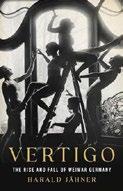
A vivid history of Germany after its defeat in World War I.
German journalist Jähner, author of Aftermath: Life in the Fallout of the Third Reich, reminds readers that the 1918 surrender came as a terrible shock to a people largely untouched by the war whose distant army was retreating but still in good order. Most soldiers were happy to go home, but a minority enjoyed being “proud warriors” and despised the disorderly democracy that had replaced the Kaiser only slightly less than German communists, who were anxious to join the Bolshevik revolution in progress across the border. There followed several years of murderous instability, economic upheaval, and failed coups before Germany achieved a measure of stability. Communists and extreme-right parties joined the government. Both exerted a malign influence, hated democracy, and proclaimed that a government cabal had betrayed the nation in 1918. Despite this dismal landscape, the 1920s featured a golden age of art and a revolution in lifestyles. Readers seeking an overall history of this era should consult Eric D. Weitz’s Weimar Germany: Promise and Tragedy. Jähner does not ignore politics, but mostly this is an outstanding cultural history. “The gender debates about LGBT+ are by no means an original development of the early twenty-first century; they had a massive prelude a hundred years ago,” writes the author, who also offers useful insights on literature, dancing, architecture and design, automobiles and city traffic, cinema, fashion, and even hairstyles. One dismal legacy of the Weimar era is hatred of the government, which, perhaps as a consequence, did not attract outstanding leaders. Jähner’s final chapters on the depression years reveal a
democracy quietly dying. By 1933, the Nazis were Germany’s largest political party, and its takeover was peaceful and entirely legal.
A gripping account of a nation’s experiment in democracy.
Kenny G with Philip Lerman Blackstone (302 pp.) | $28.99
Sept. 24, 2024 | 9798200756674
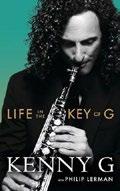
A distinguished musician talks about how a “skinny, white, nerdy guy” named Kenneth Gorelick became one of the bestselling artists of all time.
As Kenny G (b. 1956), a Seattle native, relates, his love affair with the saxophone began in fourth grade when he first saw it played on The Ed Sullivan Show. After his parents rented one for him, he became “hypnotized by the physicality of it.” A natural musician, the author quickly learned to read music and play the instrument. Only after the high school band rejected him during his freshman year, though, did he begin the daily “intense practice regimen” that transformed him into a first-chair player and dedicated musician. His life changed forever when Jim Gardiner, the school’s Black composer in residence, introduced him to Grover Washington, whose work the author studied with the meticulousness that became one of his defining musical characteristics. “One session doesn’t do it,” he writes. “You have to come back to it over and over and over. Which is another reason that I still practice three hours every day.” Later, at around the time the author took up his trademark soprano saxophone, Gardiner recommended him to R&B superstar Barry White, who needed a replacement sax player “with a soulful feel” for his band. From that point on and for the entirety of the college career that followed, the author played professionally. He joined Jeff Lorber’s jazz fusion band, where he became known as “Kenny G” and met producer Clive Davis, who
offered him the chance to record as a solo artist. Warm, thoughtful, and upbeat, this candid memoir about a life dedicated to—and enriched by—music will appeal to Kenny G’s many fans and to music aficionados with an interest in the rise of the smooth-jazz sound. Feel-good reading from a feel-good musical artist.
Kiser, Stephanie | Sourcebooks (336 pp.) | $17.99 paper
Aug. 6, 2024 | 9781728298160
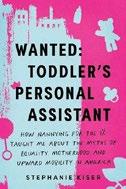
A nanny’s glimpse into the homes of some of America’s wealthiest families.
After graduating from college, Kiser set out for New York, seeking to become a writer. Quickly realizing that writing wasn’t going to pay the bills, she became a nanny for the ultrawealthy. “I’m waiting outside the school pickup line sandwiched between Drew Barrymore and a cousin of George W. Bush,” she writes on the first page. “Steve Martin and his wife are a few spots ahead.” Eventually, the shiny newness of their celebrity status wore out, as she discovered that most of New York’s uber-wealthy reap their lavish benefits off the backs of hardworking Americans. She also came to understand that they will always have the upper hand due to a rigged financial system. On the other side of that coin, Kiser shows parents struggling to provide for their children (including herself), many of whom are unable to afford new clothes, let alone expensive Versace onesies. After getting burned out from the long hours and demanding nature of her job, the author admits, “The people I worked for had all the markers of success: savings, assets, a beautiful home, children they could easily provide for. I had a few thousand
in the bank and a 24/7 work mentality. My life looked so much better than it had growing up, but I wondered now if I had lost more than I had gained. Was I actually doing well, or had people who had far more than I did just tricked me into believing I was?” Despite the constant hurdles she jumped over and the unfairness and hypocrisy she saw every day, humor and wit pervade her page-turning tales, allowing a lightness to peek through her poignant, pertinent employment experiences.
A unique examination of persistent wealth inequality in the U.S.
Ledecky, Katie | Simon & Schuster (256 pp.)
$28.99 | June 11, 2024 | 9781668060209

At 27, an Olympian and record-holding swimmer reviews her journey to excellence.
Ledecky was an up-and-coming club swimmer in Washington, D.C., when her coach asked her to begin keeping a journal, recording details of her practices and “something special” she did each day. He said she should feel free to “jot down anything else she wanted to write.” An extraordinarily focused athlete whose life has been blessedly free from tragedy, the young swimmer had no dirt to report, and that is also the case with her memoir. “My goal was to better myself through swimming,” she writes. “To discover who I was and what I was made of. The pool provided the ideal instrument for that journey. The Olympic medals, the world records, those are incredible achievements. But I’m more gratified by how swimming has
shaped me. How the pursuit has molded me into the best version of myself.” This sets the tone: upbeat, generic, sometimes a little stuffy in the manner of a self-conscious term paper. On competing alongside Michael Phelps for the first time, she writes, “To say that experience was surreal is to do a disservice to the word.” Between the chapters covering the phases of her career, Ledecky offers sections on each of her immediate family and grandparents, all exceptional people with rare drive—among them a Czech immigrant, a Midwestern farm girl, and a Jewish woman in New York. Though family history is important to her, this hagiography gets to be a bit much. However, for those interested in granular detail about Ledecky’s stroke, training techniques, motivational habits, experiences with the Covid-19 pandemic and drug testing, and thrilling wins and successes, this book will serve as relevant preparation for watching her in this summer’s Paris Olympics.
A trove of detail for aspiring swimmers and serious fans of the sport.
Leone, Marianne | Gracie Belle/ Akashic (232 pp.) | $25.95
Sept. 3, 2024 | 9781636141923

An actor, screenwriter, and essayist reflects on how caring for five small dogs helped her come to terms with the death of her quadriplegic, nonverbal son. Canines became a fixture in Leone’s life in 1994, when her then-6-year-old son, Jesse, made it clear he wanted a dog. The author and her
husband bought him a bichon frise puppy named Goody, and they nicknamed him the “Prince of Dogs.” Twelve years later—and a few months after Jesse passed away in his sleep and Leone was diagnosed with cancer—Goody died. Mourning her son and struggling to regain her health, the author realized that she also grieved for Goody. Seeking a way to heal, she adopted two quirky, cage-traumatized bichons, Lucky Dog and French Fry. Leone loved them deeply and pampered them with everything from the freedom to roam and play and $1,500 dog beds to filet mignon steaks brought home from fancy dinner parties. The bichons warily returned Leone’s affection while she wrestled with maternal grief by writing a memoir about Jesse. Like her son, the dogs were loved unconditionally, but their emotional scars would “be there forever, like mine.” Their deaths during the pandemic spurred the author to find two new rescue dogs, Titi and Sugar, to whom she wanted to reintroduce “their innate dog joy.” While Leone came to understand that all the dogs she cared for embodied some part of Jesse and his love, she also came to accept that her grief, the very thing that had brought the dogs to her, was something she would carry for the rest of her life. Candid and bighearted, this book about the healing power of animal companionship will warm the hearts of animal lovers and general audiences alike.
Joyful, affecting reading about love and family.
Mahbubani, Kishore | PublicAffairs (336 pp.) | $21.99 paper Aug. 13, 2024 | 9781541703049

A frank career assessment by the longtime Singaporean diplomat whose tenure paralleled the decades of Lee Kuan Yew’s stewardship of the country into the international arena.
An intimate view of Singapore’s stunning rise since independence.
LIVING THE ASIAN
CENTURY
A descendant of Hindu Sindhi people who left what became Pakistan during Partition, Mahbubani (b. 1948), author of The Great Convergence, was born in Singapore, where his father worked as a laborer. Often drunk and mired in gambling debts, his father was not a stable provider, and the author, his mother, and his sisters struggled to make ends meet. At the same time, they lived amicably among Malay, Chinese, and Muslim neighbors, as Singapore was an entrepreneurial hub fighting for independence from Great Britain and then from the Federation of Malaysia. As the strong-armed Lee Kuan Yew steered the tiny state toward modernization and greater prosperity, Mahbubani “became convinced that the only way for me to progress was to steadily shed my primitive Asian prejudices and replace them with the advanced thought of Western civilization.” In 1967, he writes, “one of the greatest miracles of my life happened.” He was granted a President’s Scholarship to attend the University of Singapore. Although Mahbubani hoped to become a philosophy professor (“Plutarch was right—education isn’t about filling a bucket; it’s about lighting fires”), he joined the Foreign Ministry largely to support his mother, and he served for more than three decades. The author writes about his admiration of Lee, who was close to Ronald Reagan, as well as the importance of Singapore’s election to the UN Security Council in 2001. Mahbubani credits Lee with being able to stand up to the U.S., like David to Goliath, and the author went on to serve as dean of the Lee Kuan Yew School of Public Policy. He is a straightforward, prolific, influential commenter on Southeast Asia. An intimate view of Singapore’s stunning rise since independence.
Mandelbaum, Michael
Oxford Univ. (336 pp.) | $34.99
Sept. 3, 2024 | 9780197782477

Profiles of eight “supremely significant” male world leaders, from virtuous to genocidal. Mandelbaum, author of The Rise and Fall of Peace on Earth, The Four Ages of American Foreign Policy, and other books of global history, writes that these men changed the world during the 20th century—largely the first half, a disastrous period featuring history’s two most destructive wars and its worst economic depression. Since this is political history, beginning with Woodrow Wilson is reasonable. His idealistic vision of a world in which democracy and self-determination replace power politics failed after World War I, but it caught on after 1945—peaking during the Cold War but steadily receding since. The remaining seven choices are unsurprising. Readers may grumble at Stalin’s absence, but Mandelbaum makes a convincing case that Lenin deserves priority for leading an obscure splinter party to power in the collapsing Russian empire and creating the institutions and vicious mindset that Stalin inherited. Most readers will agree with the inclusion of Hitler, Churchill, Roosevelt, and Mao Zedong. Gandhi did more than any individual to make India a nation and launched the worldwide collapse of colonialism following World War II. David Ben-Gurion was the central figure in the creation of Israel, which still plays an outsize role in world affairs. History buffs will encounter little new information but
enjoy the insights of a fine historian. Older readers will experience the uneasy sensation that there is less than meets the eye in the great victory of WWII. Mandelbaum casts a gimlet eye on all his subjects. The five democratic leaders come off better than Lenin, Hitler, and Mao, but he does not deny the increasing appeal of hyperpatriotic autocrats who are now taking power around the world—legally, the author reminds us, just as Hitler did. Often perceptive but never groundbreaking.
McGraw, Meridith | Random House (336 pp.) | $32.00 Aug. 6, 2024 | 9780593729632

Out of the White House, Trump rages. McGraw, a national political correspondent at Politico, makes her book debut with a close look at Trump’s life as ex-president, much of the time spent at Mar-a-Lago, his “decadent, sprawling, gilded mansion on the sea.” Trump bought the estate in 1985, converting it 10 years later into a posh club and resort, where “membership costs hundreds of thousands of dollars up front, plus annual fees of $14,000.”
Drawing on interviews with politicians and aides, source notes from her reporting, and published articles, McGraw reveals Trump denying his presidential loss and plotting ways to burnish his political clout. He constantly whipped up conspiracy theories. Frustrated after being banned from Twitter, he founded Trump Media LLC to give him an internet presence in Truth Social, and he encouraged Republicans to grovel for his backing in upcoming races. “Believing—or at least peddling—Trump’s falsehoods about the election,” McGraw writes, was “a litmus test for a Trump endorsement.” Republicans who had voted for his impeachment were targeted for defeat. The much-publicized FBI raid of his
premises in the summer of 2022 proved a fundraising boon. “More than ever,” writes the author, “he would become his own rallying cry. I am suffering for you would become his gospel.” McGraw chronicles Trump’s fury over books warning against the perils of another Trump presidency, as he kept close tabs on who was—and wasn’t—defending him. He dubbed the Jan. 6 committee the “Unselect Committee of political Hacks and Thugs.” He refused to take the blame for Republicans’ poor showing in the midterms, “the worst performance by an out of power party in decades.” McGraw ends with his victory in the Iowa caucuses, auguring the dismaying prospect of another Trump presidency, fueled by his desire for apocalyptic revenge.
Informative but largely unsurprising.
Michel, Casey | St. Martin’s (368 pp.) $30.00 | Aug. 27, 2024 | 9781250286055

A timely exposé of American lobbyists who degrade democracy and weaken human rights. In the spirit of Progressive Era muckrakers, Michel, an investigative journalist and author of American Kleptocracy, reveals the shamelessness, venality, and moral turpitude of those who work to influence federal legislators and the public in order to advance antidemocratic foreign interests. These foreign agents include public relations, law, and consulting firms and former governmental officials. The author traces the origins of the problem to Ivy Lee, who, in the 1920s and ’30s, launched the public relations industry, and Paul Manafort, whose work in the 1980s spurred “a new age of
unrepentant Americans willing to sell their services to dictators and autocrats abroad.” Lee worked for Nazi Germany and, prior to that, “whitewashed” the Soviet Union, while Manafort earned his infamy by enabling Russian interference in the 2016 presidential election. He also served as Donald Trump’s campaign manager, was later convicted of numerous crimes, and subsequently was pardoned by the president he helped elect. Trump, Michel notes, was “the first president to solicit foreign aid for election help.” Though working in distinctly different eras, Lee and Manafort emboldened an industry that enhances despots by exploiting the “right to petition” elected representatives. As the author shows, foreign governments also collaborate with universities, nonprofit foundations, and think tanks to burnish their image, change U.S. law, and undermine opponents. Remedial legislation, such as the Foreign Agents Registration Act and the Lobbying Disclosure Act, is mostly ineffectual. This is an industry without a moral compass, and Michel’s outrage is palpable and justified. Any thoughts that foreign lobbying produces benefits for the U.S. seem farcical. “It may be time to…finally bar Americans from lobbying for foreign regimes,” he writes.
A provocative and alarming account of the political cesspool known as foreign lobbying.
Petro, Melissa | Putnam (288 pp.)
$29.00 | Sept. 10, 2024 | 9780593714997

A memoir and guidebook about recovering from shame. Years ago, after her employer discovered that she used to work in the sex industry, Petro was demoted from her job as a teacher in the South Bronx. Petro, now a freelance writer, resigned amid “unrelenting humiliation.”



By Alison Bechdel


David Small


Darrin Bell
Roz Chast
Kristen Radtke
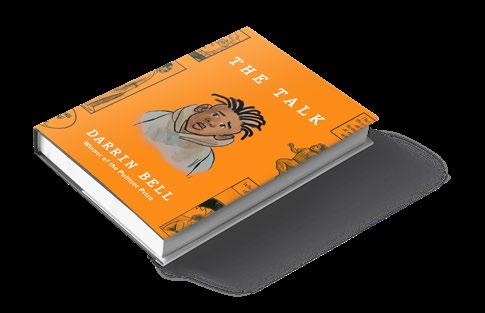


CHERNOBYL ROULETTE
More recently, when her special-needs son was exiled from the public school system, she wrestled with shame and feeling “like a pariah.” Loneliness often begets shame, Petro explains, which is why she repeatedly emphasizes the importance of connection. “Let’s get our shame out there on the table,” she writes, “and pick over its carcass, together.” The author interweaves her personal story with revelations gleaned from interviews with “real women talking about their self-conscious feelings and fears of inadequacy”; a broad look at the cultural roots of woman shaming; and a multifaceted approach to personal and collective healing. “Recovery isn’t a straight line,” writes the author. “I think of recovery and shame resilience as synonymous. Both are a struggle to trust people in a world where people have proven themselves untrustworthy.” Petro divides the book into two sections: “Identifying Shame” includes chapter headings such as “Perfect Monsters: How Society Weaponizes Shame Against Women,” and “Overcoming Shame” contains chapters such as “First Comes (Self) Love: Putting Ourselves First” and “Happier Endings: We Are More Than Monogamy and Mothering.” Though spirited and encouraging, the text suffers somewhat from repetition—e.g., “Here’s what we can all do to reclaim ourselves and banish shame: start to tell our own truths” and “The cure is telling and claiming our stories.” Petro’s primary qualifications are her experiences, dogged curiosity, and commitment to spreading compassion and understanding about shame and its many ramifications in the lives of women.
An earnest and sincere book fueled by a clear belief in sharing as a means of catharsis.
Phillips, Lee | PublicAffairs (368 pp.)
$30.00 | Sept. 10, 2024 | 9781541702950

An overlooked scientist gets her due.
In his debut book, Phillips celebrates a German Jewish mathematician whose groundbreaking eponymous theorem was “one of the, if not the, single most important result in theoretical physics.” Emmy Noether (1882-1935) grew up in an era of German history when women had few rights. The daughter of a mathematician, she audited courses at “the [world’s] center of mathematics,” Göttingen University, and then at the University of Erlangen. She earned a doctorate in 1907. Unable to secure an academic position, however, she worked as her father’s unpaid assistant, even teaching his classes while publishing her own research, becoming an “expert in something called the theory of differential invariants.” Throughout the book, the author delves deeply into the insular world of mathematics. After Noether returned to Göttingen, Einstein arrived. He benefited from brilliant colleagues, including Noether, even though, Phillips notes, they may not have met. He did express gratitude for her “tutelage” in correspondence. In fact, Noether often assisted others without any interest in credit. She “was a mathematician’s mathematician, believing that mathematics should be
enjoyed for its own sake, without any thought of application,” and her elegant 1918 paper “reached a new understanding of the beauty and harmony found in nature” and had “important implications for cosmology.” In 1922, writes the author, “the Minister of Science, Art and Public Education…promoted her to the lowest professorial rank.” After Noether was purged by the ascendant Nazis, she went to Bryn Mawr, where she worked with graduate students, conducted her own research, and traveled weekly to Princeton’s Institute of Advanced Study to deliver a lecture. Following her death, mathematical societies around the world held memorials. The text is dry and mathematically overwhelming at times, but the author duly highlights Noether’s impressive achievements. An accessible, fairly workmanlike biography.
Plokhy, Serhii | Norton (256 pp.)
$29.99 | Sept. 3, 2024 | 9781324079415

A timely study of how nuclear power plants and the unpredictability of war make for a frightening cocktail. Of the many awful stories to emerge from Russia’s invasion of Ukraine, perhaps the most chilling are those involving nuclear power plants. Plokhy, a Harvard professor who has written about both Ukrainian history and nuclear issues throughout his long career, notes that the effects of the 1986 Chernobyl disaster continue and the area is still contaminated—although the facility is manned by several hundred personnel who have the unenviable job of monitoring and overseeing the reactors. The problem is that the Exclusion Zone constitutes the most direct route from Russia to Kyiv. When the Russians appeared, the outgunned Ukrainian guards and technicians surrendered, but once the invaders were in control, they did not
seem to know what to do. Many of the Russian soldiers were unaware of the history of the place, although some had been told that the plant was manufacturing nuclear weapons. It was a tense time for everyone, but when the tide of war turned, the Russians were glad to leave the zone. Another crisis emerged when Russian forces attacked the Zaporizhia plant in the south. The Ukrainians fought and were eventually overwhelmed, but there were fears that the battle might have damaged the plant’s safety mechanisms. Innovative repairs prevented any dangerous leaks, but it was a close call. Plokhy manages to cut through the fog of Russian disinformation to keep the complex story straight, and interviews with key figures on the Ukrainian side add a personal dimension. He calls for strict rules to protect nuclear facilities in times of conflict, although there is no guarantee that warring parties would abide. Plokhy capably chronicles a disturbing tale, underlining how close the world came to another nuclear catastrophe.
Posnanski, Joe | Dutton (384 pp.)
$30.00 | Sept. 17, 2024 | 9780593475522

The author of Why We Love Baseball gives us 100 reasons to look forward to football season.
Posnanski is a practiced sportswriter, but here, following his top-50 treatment of baseball, he’s an enthusiast with an uncommonly broad grasp of football history. He opens with a splendid anecdote about Dick Butkus, renowned for smacking into his opponents hard enough to send them into the next zip code. When Raquel Welch, whom Butkus played alongside when he became an actor, professed wonder that people called Butkus mean, a crewmember replied, “Don’t pick up a football.” The author, old enough to remember when football was a
Sunday-only televised sport, connects to the game at a fan’s level, sometimes elevating it to a religion. As he writes, while biblical scholars credit Jesus with somewhere between 37 and 40 miracles, “football, miraculously, has more.” One, ranking 14th on Posnanski’s 100 list, was the famed “Hail Mary” that Roger Staubach pulled off in December 1975—a pass that, while Staubach didn’t necessarily invent it (Posnanski inserts a brief history that stretches back three more decades), was a last-ditch, desperate temptation of fate that actually worked. Voilà: a miracle, just as when Joe Montana lured an opposing Dallas line into coverage that left his receiver wide open to make a game-closing touchdown after San Francisco came far from behind, all of which Posnanski sets up with the offhand opening, “Joe Montana was on the smaller side, and his arm didn’t wow you, and he seemed a little bit frail”— and yet, a miracle, and pick no. 11 of 100. It would spoil the fun to reveal the No. 1 moment, but suffice it to say that those readers who witnessed it will surely share Posnanski’s appreciation. A learned but lightly delivered pleasure for fans of the gridiron and its history.
Kirkus Star
Radclyffe, Oliver | Roxane Gay Books/Grove (352 pp.) | $28.00 Sept. 17, 2024 | 9780802163158

A transgender man comes to terms with his identity. Born into a wealthy English family, Radclyffe began life as a girl in denial about her crushes on other women. After coming out as gay, the author visited the Bluestockings bookstore in New York City, a short train ride from the Connecticut home where Radclyffe was masquerading as a housewife despite suffering from hair and weight loss and random moments of pain
associated with gender dysphoria. At Bluestockings, the author met and began dating a woman. When they slept together, Radclyffe imagined having a phantom penis, which, in retrospect, he recognized as a possible sign that he was transgender. However, only after getting a divorce and falling in love with another woman did he come out as a man. Although his relationship didn’t survive his transition, Radclyffe found acceptance among his chosen family, his parents, and his children. Perhaps most importantly, he discovered self-acceptance and learned that his identity didn’t negate his ability to be a loving and effective parent. “The world had tried to tell me that I couldn’t care for myself,” he writes, “and also for my children, that I couldn’t be trans and queer and be a source of stability.…Whatever my failings as a parent—and I knew there had been many—my children would walk out into the world armed with all the tools I’d once lacked: courage, curiosity, the confidence to form their own opinions and trust their own instincts.” This book is consistently frank, vulnerable, perspicacious, and insightful, covering an impressive variety of aspects of the transgender experience in intimate, lyrical language and dry, compassionate humor. The author’s analysis of privilege is particularly refreshing, as is his description of transitioning as a parent.
A stunning memoir about discovering one’s identity late in life.
Randall, David K. | Mariner Books (304 pp.) $32.99 | Sept. 17, 2024 | 9780063371408
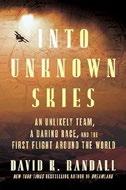
An exciting tale of traversing the world in fragile machines with crude instruments a century ago. Flying across oceans, or even around the world, is now so
Robey romps through a roll call of movies that Hollywood would rather forget.
BOX OFFICE POISON
commonplace that the main complaint is often about insufficient legroom. However, for two decades after the Wright brothers flew at Kitty Hawk, North Carolina, the idea of long-distance flight was dismissed as fanciful. The remarkable 1924 race to circumnavigate the globe has been largely forgotten, but journalist Randall, author of Dreamland and Black Death at the Golden Gate, sets out to correct the record. The author notes that by the early 1920s, the U.S. had fallen behind most other countries in aviation technology, and the military showed little interest. The exception was Billy Mitchell, an irascible officer who believed that the next war would be fought in the air. He hit upon the idea of an international race to stir public interest, even though there were few American companies capable of meeting the engineering requirements. Eventually four Douglas World Cruisers, hardy two-seat seaplanes, were designed and built. A half-dozen countries entered the contest, although it was an odd sort of competition, with no common starting point or date. Moreover, the Americans flew west, while the Europeans flew east. The persistent problems were bad weather, fuel shortages, and mechanical breakdowns. Incredibly, after 175 days and 26,345 miles, averaging 72.5 miles per hour, the American team made it home, the only team to finish. Though Congress and military officials remained unimpressed, there was a blossoming of companies that saw the potential in moving mail, freight, and passengers. All this makes for an interesting story, and Randall handles it well, providing an engaging, colorful read. With careful research, Randall capably assembles the tale of the race that put the world on the path to modern aviation.
Robey, Tim | Hanover Square Press (320 pp.) $32.99 | Nov. 5, 2024 | 9781335147318

Hollywood producers are never as smart as they think they are, says critic Robey, and a lengthy list of lemons proves it.
Schadenfreude is a German word which means finding enjoyment in the misfortune of other people, and it is never more fun than when applied to Hollywood hucksters with more dollars than sense. Robey, a film critic of long experience, has a great time reminding them of their missteps, failures, and outright debacles, delving into the background of 26 clunkers. The history of flops goes back a long way, to the days of silent cinema and Intolerance. Its cast of thousands and huge sets consumed cash by the bucketload, but Hollywood never learns from its mistakes, and the process was repeated in a string of historical epics like Land of the Pharaohs. Other failures, such as the ruinously expensive Cutthroat Island, were plagued by creative conflicts between, well, everyone involved. Looking to sequels for surefire hits, Hollywood bet big on Speed 2: Cruise Control, but it sank without a trace. Babe 2: Pig in the City failed to capture its predecessor’s charm and instead became a dark nightmare. The idea of relying on popular source material yielded Catwoman, which not even a whip-wielding Halle Berry could save, and the abysmal Cats, about which the less is said the better. But there is no excuse for disasters like Alexander, The
Adventures of Pluto Nash, and Gigli Robey has a great time with all this, although he notes that streaming and global distribution are making it more difficult to assess the financial losses of a turkey. In any case, Box Office Poison is a fun read, and it asks a key question: What were they thinking? With sardonic wit, Robey romps through a roll call of movies that Hollywood would rather forget.
Rosen, Christine | Norton (272 pp.)
$29.99 | Sept. 10, 2024 | 9780393241716
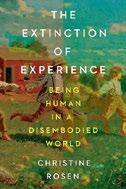
A senior fellow at the American Enterprise Institute explores how modern technology is causing different types of embodied human experiences to disappear. Technology has permanently changed the way humans interact with the world, causing many experiences to be mediated rather than direct. According to Rosen, this mediation has caused our understanding of experience to become so “disordered” that “we can no longer assume that reality is a matter of consensus.” She argues that part of the problem is that people now tend to prefer virtual interactions over face-to-face ones. A major issue with mediated communication, however, is that it leads to a blunting of human interaction skills, as well as a host of negative psychological effects, including anxiety and low self-esteem. Yet despite these pitfalls, people willingly compromise empathy and well-being for the convenience and “seamless ease and comfort” of digital interaction. Reliance on technology has also rendered certain types of activities, such as handwriting, obsolete. While this may not seem like a big loss for younger generations, Rosen cites research that suggests how humans “lose measurable cognitive skills” when they forgo instruction in cursive writing. More disturbingly, as technologies advance, they
encourage users to see the world and themselves as needing the transformations offered by the latest apps or electronic devices. Everything in the world—from long-distance travel to loneliness— becomes “just another solvable engineering problem” that data-collecting megacorporations like Google or Meta use for their own profit. Meanwhile, what gets lost is an appreciation for the physicality of the world and for the sometimes inconvenient but always unique experience of human embodiment. Engaging and impeccably researched, this book serves as an important reminder that survival during this time of accelerated global change will depend on humanity’s willingness to impose intelligent, self-preserving limitations. Timely, well-informed reading.
Rosenberg, Jane | Hanover Square Press (320 pp.) | $30.00 Aug. 13, 2024 | 9781335008046
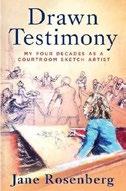
Perhaps the best-known courtroom sketch artist working today looks over a long career and discusses her métier.
“I reach for the primary tool of my trade, a pastel pencil, and begin to draw,” writes Rosenberg. All those recent drawings of Donald Trump, Michael Cohen, and Stormy Daniels (“a slightly ethereal figure, hovering ghostlike behind Cohen”) in that New York City courtroom were the product of that pencil, just a few of the thousands of drawings Rosenberg has produced over the years. Starting off as a portraitist, she “put the ‘starving’ in starving artist,” then stumbled into courtroom art, freelance work that’s unpredictable and hard to plan around. Over her long career, she writes, it “has been considered the ultimate dying art.” Fortunately for her, some legal proceedings ban cameras; fortunately, too, art can sometimes convey
human character and emotions in ways that elude photographers and videographers. So it was, she writes near the opening, that in the initial trial of Ghislaine Maxwell, she was able to capture the nuances of a woman who seemed to regard the courtroom as a theater stage and was responsive to Rosenberg’s presence: “She may have been wearing a mask almost throughout, but even with half a face she was giving me more to work with than many I have drawn across my long career.” A mask over Zoom impeded her ability to capture Derek Chauvin, the police officer who murdered George Floyd, which “meant that my sketches were even more of a jigsaw puzzle than normal.” With a cast of characters including John Gotti, Woody Allen, Bernie Madoff, Mark David Chapman, Bill Cosby, Susan Smith, and Tom Brady, and with smart commentary on technique, Rosenberg delivers stories for every true-crime buff—and aspiring courtroom artist.
A revealing look at an often-overlooked aspect of the legal system.
Slepian, Dan | Celadon Books (224 pp.) $30.00 | Sept. 3, 2024 | 9781250897701

A TV producer’s journey into the hellish landscape of wrongful convictions.
Slepian, a veteran producer of Dateline, narrates his involvement in a series of outrageous cases of wrongful conviction and long-term imprisonment. “My innocence work,” he writes, “had become a way into understanding the tragic consequences of America’s system of mass incarceration—for the innocent, the guilty, and all of society.” Beginning with the notorious Thanksgiving 1990
murder of a Palladium nightclub bouncer, the cases illuminate how, during New York’s high-crime years, authorities would overlook exculpatory evidence and dubious prosecutions. This investigation led the author to Sing Sing Prison and to “JJ Velazquez, the soul of this book,” who was jailed following witness misidentification in the murder of an ex-cop running a gambling parlor. “When I first met JJ in 2002” while working on a story for Dateline, writes the author, “I’d gone into my investigation skeptical of his innocence. By 2011, I was certain of it.” His focus intensified as he learned about more inmates at Sing Sing, including the “Bronx Six,” railroaded for two 1995 murders: “So many lives ruined, and for what? As I looked at the case, all I could see were bumbling cops hell-bent on making arrests as quickly as possible.” As he continued his investigation, Slepian encountered resistance, as damning information emerged about the NYPD bowing to political pressure for convictions. In addition to chronicling the plights of his subjects, the author includes his own perspective and self-deprecating background as a lifelong TV nerd turned outsider advocate, yet the narrative voice is brisk and punchy, contrasting with depictions of New York’s “bad old days” and the nightmarish circumstances of the wrongly convicted. The result is a gripping, highly effective true-crime synthesis. An excellent addition to the body of work documenting a pervasive societal injustice.
Smith, Andrew | Atlantic Monthly (464 pp.) $28.00 | Aug. 20, 2024 | 9780802158840

How algorithmic code works and what it means for our future. As Smith, author of Moondust and Totally Wired , explains, com-
NEVER SAW ME COMING
puter code operates according to a “haunting alien logic” that grants extraordinary—and, in some ways, frightening—powers. The author tracks the history of coding from early computing pioneers to contemporary innovators in machine learning, while also documenting his own attempts to learn coding language as a means of understanding how our virtual worlds are being constructed. Smith provides refreshingly accessible accounts of the theoretical contributions to the field made by such early luminaries as Ada Lovelace, George Boole, John von Neumann, and Alan Turing and of the coding cultures that currently exist at high-tech companies around the globe. The author gives readers a vivid sense of the potential of new developments in AI, as well as the forbidding threats to privacy and human autonomy posed by the systems. The book also includes insightful commentary on the psychological impact of immersing oneself in the abstractions of code and on the workplace dynamics that fuel a rather ruthless and antisocial mode of innovation. There is, the author makes abundantly clear, a very real cost to relinquishing control of our lives to machines and machine logic. Smith dedicates the book to “those who would move slow and fix things,” and he presents his work as a guide to both comprehending and appropriately resisting the emergence of toxic forms of digital mediation. The author concludes that activism on this front will require a concerted effort informed by the high stakes involved: “Big Tech pushback and lobbying against moderation of their power will be as intense as the motor and oil industries’ decades-long war on climate science, and for the same reasons.”
An engaging plunge into the world of code and its transformative implications.
Pocketed $40
Smith, Tanya | Little, Brown (448 pp.)
$32.00 | Aug. 13, 2024 | 9780316569163

The remarkable adventures of an expert grifter. Growing up in Minneapolis in the 1970s, Smith became aware of stark economic inequality. Her family was middle class, but her father, who owned a music venue, interacted with the superrich. “As a child,” she recalls, “I was dazzled by their wondrous shows of glamour and seemingly carefree living.” By the time she was a teenager, though, she was also dismayed by poverty in her community. In her debut memoir, Smith recounts her astounding career in crime, which began with her desire to help the needy.
Honing computer skills, she became adept at fraudulent bank transfers.
“Between the ages of fifteen and sixteen,” she writes, “I managed to void people’s utility bills, at least temporarily, around three hundred times. I also handled a few overdue mortgages.” Soon, she began to covet money for herself, “caught up in the thrill of transactions, by what money could do and the men it could attract.” Over one summer and fall, she made more than $2 million. She showered men with gifts, including designer clothes, cars, jewelry, and cash. One after another, she discovered they were cheating on her and stealing from her. With a cadre of accomplices, it was only a matter of time until someone slipped up, and soon the police and FBI got wind of her scams. They were sure, though, that she worked for a white mastermind. As one racist
detective said, “Neeee-grroes murder, steal, and rob, but they don’t have the brains to commit sophisticated crimes like this.” Smith was convicted of bank and wire fraud, incurring a longer sentence than some famous white-collar criminals. “You know they’re hassling you because you’re Black and a genius,” her lawyer told her, a conclusion that Smith does not dispute. An action-packed chronicle of deceit, betrayal, and greed.
Tendler, Anna Marie | Simon & Schuster (304 pp.) | $29.99
Aug. 13, 2024 | 9781668032343

A chronicle of a woman’s life upended by severe depression and anxiety after a difficult childhood. In her unreserved memoir, artist Tendler exposes her consistent struggle with depression and self-harm since she was a teenager. In early 2021, at age 35, after decades of severe anxiety and depressive behavior successfully managed by medication, the author’s self-injury tendencies, disordered eating, and suicidal ideation resurfaced. Following her therapist’s advice, she checked herself into a “full-blown psychiatric hospital,” covered in self-inflicted scissor cuts. Seeking out the source of her mental illness, Tendler reflects on her childhood, when she struggled socially and was bullied in grade school. She also tolerated volatile, incompatible parents who “toughed-out” her illnesses with homeopathic remedies, only resorting to conventional medicine after her raging infections became unbearable. Craving love and validation, Tendler dated boys (and a series of older men) “who would pay attention to me.” Her coping mechanisms were cutting and her dog, Petunia. The author writes candidly of her adult years prior to her breakdown when she attended graduate school for fashion, until the mandatory solitude of the
Covid-19 pandemic exacerbated an already simmering depression. The author concludes with a psychiatric dual diagnosis, though Tendler contends that some of the source of her rage and depression has been her complicated relationships with men. The author’s calm, affable narration belies the seriousness of her condition, and the striking detail she provides offers readers a clear sense of the rigorous inpatient psychotherapy process meant to disarm anxiety and return a sense of normalcy. While Tendler admits that her condition is a lifelong struggle, the book ends on a hopeful note, with the author on the path to maintaining a happy, structured life. She does not elaborate on her former marriage to comedian John Mulaney.
An intensive, conversational portrait of one woman’s battle with mental illness.
Thompson, Wright | Penguin Press (496 pp.) $35.00 | Sept. 24, 2024 | 9780593299821

A native son dissects one of Mississippi’s most shocking racist crimes. With deep roots in Clarksdale, “one of those faded Delta farm towns,” Thompson, author of Pappyland, grew up not far from the place where a farmer named J.W. Milam and a storekeeper named Roy Bryant kidnapped Emmett Till, who had allegedly made suggestive remarks to Bryant’s wife. The sadistic killing took place in the barn of Thompson’s title, which for a long time afterward “was just some guy’s barn, full of decorative Christmas angels and duck-hunting gear…hiding in plain sight, haunting the land.” When a sign was erected, years after Till’s murder, white racists tore it down; a second one was shot full of holes. The barn still stands. Ironically, Thompson notes, the town where Till
was murdered was named for the daughter of one of the founders of the Ku Klux Klan—but for all that, he adds, the KKK never gained much of a foothold among white Delta families, the racist murder notwithstanding. Thompson ranges widely in telling Till’s story, with one character a Black sharecropper who saw the boy’s freshly spilled blood on the floor of the barn and left the state, returning 50 years later when the Department of Justice reopened the murder case. The author’s story, intended for readers “everywhere the poison of the Lost Cause has spread,” offers hope for a more racially equitable Mississippi. Eventually justice did arc the right way, at least after a fashion: Till’s mother noted that her son’s killers were shunned by the white community after the killing, no one would rent land to Milam, and, she concluded, “before long, cancer got both of them. They lost their lives for what they did to my boy.”
A profoundly affecting, brilliantly narrated story of both an infamous murder and its unexpected consequences.
Toler, Pamela D. | Beacon Press (288 pp.) $29.95 | Aug. 6, 2024 | 9780807063064

A biography of Sigrid Schultz (1893-1980), who reported from Germany from the 1920s to the end of World War II.
Toler, a translator and author of Heroines of Mercy Street, provides an adept, engaging portrait of her subject. Schultz was born in Chicago, the daughter of a Norwegian painter and his German-born wife. Brought up in a cosmopolitan community, she was fluent in French and
German by the time her family moved to Europe in 1901. After a spell in Germany, where her father had several commissions, they settled in Paris. She traveled widely, attended classes at the Sorbonne, and added Norwegian and Italian to her stock of languages. In 1913, the family moved to Berlin. When World War I broke out, her father’s commissions dried up and she taught English and French to wealthy families to pay the bills. Then, in 1919, Chicago Tribune reporter Dick Little offered her a job as interpreter and cub reporter in the paper’s Berlin office. Schultz accompanied him to interviews, connecting with important people who became valuable sources when she began writing her own stories. She proved adept at dodging the gatekeepers—and later, the Nazi censors—to get the facts. In 1926, she was appointed chief of the Tribune ’s Berlin office, a position from which she reported on the rise of Hitler. By 1941, the growing war forced her to return to Chicago. After D-Day, she became a war correspondent for McCall’s Magazine and was among the first reporters to see the concentration camps following liberation. After the war, she tried finding other writing work but never recovered her early success—partly because of poor health. Still, as Toler makes amply clear, she left a brilliant firsthand account of a dramatic era in 20th-century history. A fascinating portrait of a trailblazing reporter who was an eyewitness to history.
Tosh, Will | Seal Press (304 pp.) | $30.00 Sept. 17, 2024 | 9781541602670
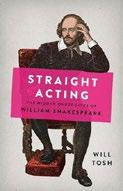
Was Shakespeare queer? A researcher makes the case. Tosh, head of research at Shakespeare’s Globe, insists that the Bard was “a queer artist who
drew on his society’s complex understanding of same-sex desire to create some of the richest relationships in literature.” Tosh, who uses the term queer because it “encapsulates far more than it excludes,” bemoans the determination of others “to scrub away any signs of homoeroticism” in Shakespeare’s work, from the sanitizing of relationships like that of Romeo and Mercutio in Romeo and Juliet to the “pathbreaking sonnets of queer desire” that are often read aloud at opposite-sex weddings, “dusted off, de-queered and put to safely straight use.” The author presents a vigorous argument for Shakespeare as “one of our most prolific poets of queer love.” He charts his subject’s maturation as an artist, from his upbringing to his literary apprenticeship in London, “the default capital of homoerotic desire,” to the influence of such figures as the “sexy iconoclast” Christopher Marlowe, whose Edward II, “a study of queer kingship,” had “a transformative effect on the way Shakespeare wrote history plays” and gave Shakespeare “a queer dramaturgy that took seriously the range of ways in which a person might love.” Speculative vignettes at the beginning of each chapter that muse upon Shakespeare’s “artistic evolution” add little, and Tosh tries too hard to be poetic (“The people in a young man’s life were lacquered with a sort of pious sealant”) and funny (The Affectionate Shepherd , a work of romantic literature, was a “supersized” version of Virgil’s second Eclogue, “in every respect bigger, longer and uncut”). Still, this is a lively analysis of Shakespeare’s life and work, with close readings of his plays and claims that will likely spark fresh debate. A thoughtful portrait of Shakespeare’s sexuality and its effect on his literary output.
Ugrešić, Dubravka and Merima Omeragić
Trans. by Ellen Elias-Bursać | Open Letter (120 pp.) | $14.95 paper | Sept. 17, 2024 9781960385253
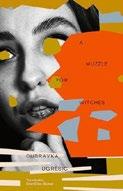
A celebrated writer and thinker answers smart questions about misogyny, nationalism, resistance, and the nature of art.
Respected for both her fiction and scholarly work, Ugrešić (1949-2023) became the first woman to win the NIN Award—Yugoslavia’s highest literary honor—in 1988. When Yugoslavia was riven by ethnic conflicts and fights for independence a few years later, the author became a pariah for her anti-war stance. The book’s title alludes to one of the epithets hurled at her during this time. Though she left her home, she never stopped writing about the place of her birth and the violence that tore it apart. This collection of interviews with Omeragić is her final published work. In “Women and the male perspective,” Ugrešić illustrates the pervasive power of misogyny by describing the life of her novel Steffie Cvek and the Jaws of Life, from inception to critical reception and transformation into a movie that turned her feminist fiction into cheap laughs at the expense of women. Elsewhere, the author recounts how the literary curiosity and experimentation of her youth had devolved into prose grounded in misogyny, bigotry, and dirty jokes by the 1980s. “The implanting of cultural memes” is an incisive exploration of how populism and digital media have blurred “the boundaries between culture and subculture, high and low, elite and
commercial, authentic and imitational.” Even as Ugrešić offers astute critiques of international phenomena, her thoughts always come back to Yugoslavia. She celebrates the subversive power and linguistic richness of children’s books while lamenting the didactic turn Yugoslavia’s children’s literature took when divided by nationalism. As she surveys the contemporary cultural landscape in the former Yugoslavia, she finds them “seriously compromised. Because how can a culture founded on the principle of ethnic exclusivity call itself a culture?”
Sage closing remarks from a vital public intellectual.
Warner, Shayna Maci | Abrams (304 pp.)
$28.00 | Aug. 27, 2024 | 9781419762574

An examination of queer representation in the TV industry.
“My first loves were television and women,” writes Warner, a bisexual writer from Brooklyn, at the beginning of this spotlight of the history of queer people in TV. The author investigates how queer characters have evolved on screen over the years and how media representation has affected the community, and they highlight a new “rainbow” roster of openly queer and gender-fluid characters making their way to the screen. Drawing on more than 70 years of history, Warner explores the limitations so frequently placed on queer people trying to make it in the industry and calls for audiences to not only pay attention to queer artists, but celebrate them and allow for evolution. With the mass production of content and ubiquity of streaming services, queer representation is deviating from being an exception to the rule; instead, it is becoming prominent and praised. Although there is always more space to be made for characters across the spectrum of the
queer community, Warner shows how the industry has evolved since the early days. Especially interesting are the author’s discussions of a refreshing variety of actors and the roles that stood out, including Rosie O’Donnell on The L Word and Nancy McKeon on The Facts of Life. “On November 19, 1980,” writes Warner, McKeon “rode her motorcycle onto Diff’rent Strokes, a spin-off of The Facts of Life, and into the hearts of burgeoning dykes across America.”
Ending the journey on a bittersweet note, they write, “no matter how dire Hollywood’s queer landscape may seem, regardless of whether the glittering, briefly prolific Rainbow Age of Television has actually come to its close, that doesn’t change the fact that we, flesh and blood queer people, are never really alone.”
A thoughtful, well-researched cultural study.
Werth, Barry | Simon & Schuster (448 pp.) $30.00 | Aug. 20, 2024 | 9781501153976

The gripping tale of a victim of an early CIA debacle who spent more than two decades in a Chinese prison.
Werth, journalist and author of Banquet at Delmonico’s and 31 Days, relies primarily on Jack Downey’s memoir, published in 2022, eight years after his death. With no access to his subject and interviews with only a few elderly colleagues, the author adds little to Downey’s account of his prison years, but readers will encounter insightful details about American Cold War policy, which ensured that Downey would remain even as other Americans were released. It’s well known that the fledgling CIA recruited heavily from Ivy League schools, and when a representative came calling in Downey’s graduation year of 1951, there was no shortage of applicants: He and five other Yale men
PRISONER OF LIES
joined the CIA’s entry class. The CIA’s initial plan to roll back communism involved the infiltration of native insurgents into enemy states to support local resistance fighters. The strategy’s failure in Europe did not discourage the agency from adopting it in China, where it also failed. In Manchuria, Downey’s plane crashed. When he was captured, the Chinese knew he was a CIA agent even before he admitted it. American policy was to never acknowledge spies, so he was publicly proclaimed an innocent traveler. This meant that during prisoner exchanges, which occurred regularly, the Chinese refused to include him. He remained until America recognized the mainland government in 1973. Werth mixes illuminating yet painful details of Downey’s interrogations, trial, and long, miserable internment with pertinent Cold War history, which featured little intelligent leadership on either side. Readers can take solace in Downey’s long life following release, during which he obtained a law degree, enjoyed a modest political career, and ended life as a judge. A thrilling spy story and informative Cold War exploration.
Yaron, Lee with Joshua Cohen
St. Martin’s (288 pp.) | $30.00
Sept. 24, 2024 | 9781250366283

A collection of intimate stories about the Israeli victims in the Oct. 7, 2023, Hamas attack. With contributions from Cohen, Haaretz journalist Yaron has interviewed countless people and their families to craft this moving look at the lives and harrowing deaths of Israelis and
guest workers on 10/7. The author alternates the heartbreaking, immediate profiles with some history of Israel as well as of the kibbutzim, the small activist, agricultural communities where many of the victims were struck. “The terrorists of Hamas murdered and destroyed the very communities that did more than any others to promote peace between the two peoples,” she writes. Moreover, in story after story, Yaron relates how many victims of 10/7 descended from Holocaust survivors or had moved to Israel for their safety. Beginning with Sderot, she notes how this southern city of immigrants has suffered from Hamas’ onslaught of rockets for many years and how 50 of its citizens were killed on 10/7. A group of elders on a minibus to a Dead Sea resort, many of whom were refugees from the Soviet satellite states, were gunned down on the streets; in Ofakim, one of Israel’s poorest cities, 49 residents were murdered. The author visited Bedouin communities in the Negev, where missiles rained down on the vulnerable residents, as well as the Kibbutz Alumim, where a group of Nepalese students working the fields were killed. The most horrendous toll of all was the 364 people murdered at the Nova music festival site (another 40 were kidnapped). “In the minds of many Israelis, including leading politicians,” writes Yaron, “disengagement from Gaza was the original sin, and a direct line connects Israel’s 2005 withdrawal from the strip to the far-right Judicial Reform and massacre eighteen years later.”
Haunting eyewitness accounts of one of the decade’s most catastrophic events.


ONE OF MY biggest pet peeves is when people refer to graphic novels as a mere genre. Graphic literature is a format—and a rich one at that. We’ve come a long way since the days when comics were widely seen as nothing more than vehicles for superhero stories; graphic lit encompasses everything from fantasy to memoir and more. The following titles are proof that comics are capable of anything.
Powerhouse authors Kekla Magoon and Cynthia Leitich Smith team up for Blue Stars: Mission 1: The Vice Principal Problem (Candlewick, March 5), illustrated by Molly Murakami. Cousins Riley Halfmoon (Muscogee Nation) and Maya Dawn, who’s biracial, move in with their grandmother and attend school together. Though wildly different, the girls find common ground when their vice principal eliminates funding for beloved activities and programs. Murakami’s energetic cartoon art ramps up the action as the cousins take a stand but also pauses for quieter scenes as they bond; readers will want to
follow Riley and Maya’s worthy example.
With her debut graphic memoir, Continental Drifter (First Second, April 2), Kathy MacLeod shows she’s an artist to keep an eye on. The child of a Thai mother and a white American father, young Kathy often feels like a stranger in a strange land, whether at home in Bangkok or spending summers with extended family in Maine. Minimalist yet intimate cartoon art captures her joys and uncertainty during a three-week stint at an American summer camp. Refreshingly, the book ends with Kathy still finding herself—readers will feel buoyed by the takeaway that self-discovery is an ongoing process.
Jane’s family and community have made it clear to her that they think she doesn’t measure up in the looks department. But the protagonist of Vera Brosgol’s Plain Jane and the Mermaid (First Second, May 7) is intelligent, fiercely loyal, and intrepid—qualities that become apparent when she sets out to rescue the boy she hopes to marry

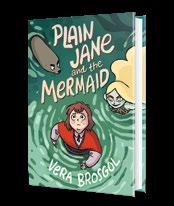

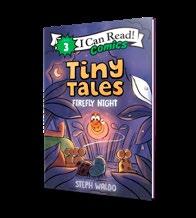
after he’s kidnapped by a gorgeous but cruel mermaid. Brosgol is a master of visual storytelling, her illustrations by turns sweetly expressive and darkly grotesque as she explores the toll that beauty standards take on women and girls.
In recent years, publishers have stepped up their game with graphic novels aimed at preschoolers and early elementary school students; Steph Waldo’s Tiny Tales: Firefly Night (HarperAlley, May 14) is an especially strong example. At the urging of an enthusiastic firefly, several diurnal creepy-crawlies decide to stay up late to see the moonflower bloom. Waldo’s adorable, big-eyed cast and vivid use of color are enticing, while her story’s
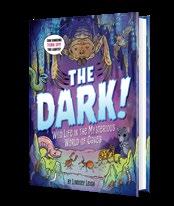
short length and simple yet effective layouts and paneling make it ideal for comics newbies.
What bizarre creatures lurk in the depths of caves? Lindsey Leigh’s The Dark!: Wild Life in the Mysterious World of Caves (Penguin Workshop, July 9) offers readers a tantalizing glimpse; here be oilbirds, remipedes, cave racer snakes, and more. Leigh loads her book with facts that never feel overwhelming. Her accurately rendered yet humorous cartoons will keep kids engaged while conveying how fascinating and just plain weird cave dwellers can be.
Mahnaz Dar is a young readers’ editor.
AN EPISTOLARY TALE told mostly in drafts as a boy completes a teacher’s requirement to write an apology. Ripped and crumpled notes tell most of the story as Jack, a brown-skinned boy with straight brown hair, grumps through the school day. An early draft reads, “DEAR ZOE, I’M SORRY YOU GOT SO MAD!!! JACK.” Lightskinned, dark-haired Ms. Rice, who looks over his drafts, writes back, “Dear Jack, Please try again. Love, Ms. Rice.” As each subsequent draft makes incremental progress, the story of what happened emerges (“I’m sorry FOR
REAL that your castle got knocked over”). Kwon’s charming art, rendered in ink, then colored and collaged digitally, tells a parallel emotional story as Jack goes from angry to chastised, then back to angry (a wonderful spread shows him expressing his rage while taking part in the day’s art assignment: “Paint Your Feelings!”), and finally thoughtful. Meanwhile, the classroom activities with their own small dramas continue around him. In a late draft, the crux of the issue becomes clear. Jack had wanted to play with Zoe and her castle, but two boys

I’m
Lukoff, Kyle | Illus. by Julie Kwon
Aug. 27, 2024 |
told him that castles were for girls. Ms. Rice replies, “Dear Jack, I’m sorry that happened to you. I’ll talk to Ben and Jeremy… You’re almost there.” Ms. Rice’s gentle and kind voice guides
Jack to a most satisfying apology and ending. Jack’s class is diverse.
A master class in apologies and in storytelling through words and art. (Picture book. 4-8)
Ackerman, Sara Holly | Illus. by Alona Millgram | Algonquin (32 pp.)
$18.99 | Sept. 3, 2024 | 9781643753577

A Jewish tradition brings a family together across generations. A grandmother and child spend the day making challah and preparing for Shabbat dinner. They take their time with each step in the recipe while bonding over the familiar ritual. While the dough rises, they play games, make art, and look at scrapbooks. When the rest of the family joins the pair for Shabbat dinner, everyone sits down to enjoy the challah in a scene of joyful togetherness. That night, the child dreams of challah. This story captures the multisensory experience of challah baking: the sound of eggs cracking into the batter, the stretchy feel of the dough, the aroma of baking wheat, and the sight of a glossy bronzed loaf. Playful illustrations reflect the joy in both flurries of activity and periods of rest. The sweet, comforting rhyming couplets scan smoothly, making for a pleasant readaloud. The step-by-step descriptions will have many kids feeling ready to bake their own challah; a recipe is included. The child and grandmother are light-skinned; additional family members vary in skin tone. Some adult characters wear yarmulkes.
A quiet celebration of the cultural and family rituals that feed us, in all kinds of ways. (Picture book. 3-8)
Ahmed, Nadia | Beaming Books (40 pp.) $18.99 | Aug. 27, 2024 | 9781506495118

A little ghost faces his fears in time for Halloween. Finn, a ghost with charming, expressive eyes, doesn’t understand why so many things terrify him: trees, the color orange, and flying, which his family does all the
time, especially on Halloween. He hides in the attic, feeling lonely. His supportive family brings him his favorite chocolates after trick-or-treating each Halloween. Alas, this year, his siblings forget. Finn resolves to confront his fears so he can trick-or-treat with his family next year. With trepidation and persistence, using self-imposed exposure therapy, he begins with trees: He touches a tree for one minute, gradually increasing the time until he can hug, then climb the tree. Ahmed clearly describes Finn’s feelings: “When Finn is afraid, his stomach swoops, his hands sweat, and he can’t move.” Her poignant black ink drawings depict Finn’s more difficult emotions: In one image he’s hunched over, surrounded by a riot of squiggly lines. Color seeps into the illustrations the more he manages his emotions; the tree begins to morph from black to brown as he gains confidence. When he reckons with his fear of flying—and even endures a frightening collision—the visuals awaken with pinks, blues, and purples. Throughout, swatches of orange add bold, optimistic hints that Finn will thrive, embraced by his family and motivated by chocolate. A sweet, seasonally inspired, social-emotional learning book. (Picture book. 3-8)
Ahmed, Roda & Charnaie Gordon Illus. by Chloe Burgett | Harper/ HarperCollins (40 pp.) | $19.99 Sept. 10, 2024 | 9780063295735
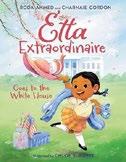
Etta Extraordinaire is back and getting ready to take a trip to the U.S. capital. As the school bus arrives in Washington, D.C., Etta’s thrilled to see the cherry blossoms blooming and the city turning “pink, pink, pink!” On the White House lawn, her teacher, Ms. Prabhu, tells the children they’ll vote on the day’s activities, “the same way they decide things” here in Washington. Chloe proposes playing hide-and-seek.
Emilio wants to play tug-of-war. Isaac hopes to visit the Presidential Library. Etta suggests having a cherry blossom party on the lawn. The kids make speeches and put their ideas to a vote, and Etta’s wins in a landslide victory. She and her classmates lay down a blanket, prepare treats, decorate the lawn, and sit down to enjoy the fruits of their labor. But when it begins to rain, the kids must move the party indoors to the White House’s Red Room, and the party is a smashing success. Kitted out in a wide-brimmed pink hat, a star-patterned blue scarf, her lucky pearls, and a plaid skirt, Etta cuts a stylish figure in Burgett’s charming digital illustrations. She’s a confident, formidable presence, though she endures a few moments of uncertainty as the weather turns rainy; readers will find her relatable. Educators who are devising lesson plans related to voting will want to incorporate this tale. Etta is Black; her class is diverse. A snazzy lesson in civics—and on rolling with the punches. (Picture book. 4-8)
Ahn, Chi-hyeon | Illus. by Gyung-hyo Kang Graphic Universe (160 pp.) | $16.99 paper Sept. 10, 2024 | 9798765627525
Series: Mystery Science Detectives
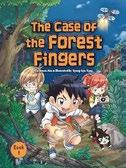
A group of ambitious youngsters take on their first case. Drawn in manga style, this graphic novel introduces the Mystery Science Club: Kihan Shin, the black-haired, energetic leader; Hannah Kang, a red-haired photographer with a black belt in Taekwondo; and Terry, the blond-haired scientist and drone expert. A black-and-white cat named Kkami rounds out the group and is the team mascot. Though the kids have taken on a few minor mysteries, mainly involving slight misunderstandings, they finally have the opportunity to solve a real case when Yunjin Ryu rushes to a club meeting. He explains that he was playing baseball with
friends when one of them hit his autographed ball into the woods. Searching for his ball alone, he skidded down a cliff, ended up in a seemingly haunted cabin, and then was attacked by zombie hands popping up from the ground. He hightailed it home, leaving his ball behind. Intrigued, the club members take their tools and retrace Ryu’s steps to retrieve the ball. Various puzzles and challenges related to the clues are interspersed between chapters. Each seemingly supernatural occurrence is debunked by scientific explanations, mixed with plenty of expressive comedy. The narrative is well paced, with sharp dialogue and deftly shaded full-color panels. A case report offers more information on the mold and fungi at the heart of the story. A sequel is strongly hinted at. Names imply Asian ancestry for most characters.
Slightly spooky and brimming with action, this mystery is definitely a crowd-pleaser. (answer key) (Graphic fiction. 9-12)
Araya, Rocio | Trans. by Sarah Moses Elsewhere Editions (38 pp.) | $19.95 Sept. 24, 2024 | 9781953861900
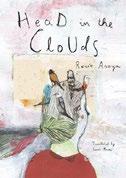
A curious mind leads to many paths.
Sofía is an inquisitive child full of questions about the world.
The teacher, though, thinks that Sofía isn’t attentive enough: “You must see so many birds with your head in the clouds!” An appealing image depicts several birds atop Sofía’s head. One day, instead of listening to the teacher’s lesson, Sofía decides to ask the questions that matter the most. The inquiries range from silly and childlike (“Does a cow’s baby know I drink its mom’s milk?”) to the accidentally profound (“Can I be good and happy at the same time?”). Yet Sofía’s teacher isn’t amused and responds, “When there are many paths, I always pick the same one.” So Sofía gives her a gift (“This little bird is for you. I see lots of
Young readers will be pulled in by this humorous charmer.
TOWED BY TOAD
them”) in the hopes that she’ll learn to think outside the box. Araya’s mixed-media art beautifully captures the controlled chaos of the mind of a child along with text, translated from Spanish, in a font that looks like scribblings. The spreads where Sofía asks a multitude of questions are infused with color—a drastic contrast to those featuring the teacher, rendered in dull grays and plain, neutral backgrounds that highlight the sometimes monotonous nature of adulthood. Characters have skin the color of the page.
A graceful look at the power of harnessing the limitless possibilities of life. (Picture book. 5-8)
Ardagh, Philip | Illus. by Ben Mantle Candlewick (32 pp.) | $17.99
Sept. 10, 2024 | 9781536235494
Series: Sunny Town Bunnies

A fluffle of raucous bunnies saves Christmas. The elves have eaten too many candy canes and can’t help Santa deliver the presents. Luckily, some bunnies happen to be sledding by and eagerly jump into Santa’s sleigh to assist. “Bunnies in a sleigh! / Bunnies in a sleigh! / Laughing and a-joking / as they head for Christmas Day!” Covered in chimney soot from top to tail, the bunnies hop around giving gifts to various animals, even donning scuba gear to make sure the octopus family isn’t left out. Another intriguing stop is the prison, where they give presents to the incarcerated squirrels, who deserve them, too (though perhaps not the gift-wrapped key). In tumultuous, lilting rhyme that tumbles from one page to the next, Ardagh expertly captures the
frenetic energy of these gift-giving cottontails. Each bunny also has distinctive attire, so eagle-eyed readers can spot the individuals and follow them through Mantle’s vibrant scenes, seeing personalities unfold through their actions. Reminding readers that this is a British import, Santa’s sleigh travels through some famous London landmarks, narrowly missing Big Ben and flying over Trafalgar Square. Fans of the protagonists’ earlier outings—Bunnies on the Bus (2020) and Bunnies in a Boat (2023)—will be pleased. Santa presents white, and the elves are a diverse bunch. Frenzied fun for everyone. (Picture book. 3-6)
Awan, Jashar | Tundra Books (48 pp.) $18.99 | Sept. 3, 2024 | 9781774883488 Series: Towed by Toad

Even helpers need help sometimes. Toad’s job as a tow truck driver is so hectic that he doesn’t have time to eat the breakfast his dad’s prepared. “No time, Pop! Can’t stop!” Toad calls, racing out the door. Toad gets caught in heavy traffic as other animals race to their destinations. When one of them breaks down, “that’s where Toad comes in,” giving the beleaguered driver and the car a lift and tow, respectively. “I’m happy to help!” he announces. Caring Dad’s on the scene again, bringing Toad lunch. Toad’s response? “No time, Pop! Can’t stop!” As the day wears on, vehicular mishaps continue. Toad “answers the call” and “tows them all.” Then—uh-oh—his own truck goes kaput! Worse yet, he can’t fix it. What’s a tow truck driver to do when he needs a tow truck driver? Who’s Toad gonna call? Would you believe a great
helper—Dad, a tow truck driver himself—comes to the rescue? Back at the family business’s garage, Toad finally finds time to eat. This rollicking story “tows” kids along with its fast-paced humor; its message that everyone occasionally needs assistance will resonate. The clipped text, heightening the sense of on-the-go movement, is comprised of brief sentences and phrases that use basic phonemic elements, making this funny, sweet tale a fine choice for emergent readers. The comical digital illustrations, featuring an all-animal cast, incorporate onomatopoeic sound effects.
Young readers will be pulled in by this humorous charmer. (Picture book. 4-7)
Banbury, Steven | Illus. by Matt Rockefeller | Little, Brown (336 pp.) | $17.99 $8.99 paper | Sept. 3, 2024 9780316572989 | 9780316572996 paper Series: The Pumpkin Princess, 1

An orphan winds up in the strange, spooky land of the undead and discovers the home and family she’s always craved. One Halloween, Eve attempts yet another escape from her awful orphanage and comes across someone completely unexpected in the forest—the Pumpkin King. He’s imposing and has a jack-o’-lantern pumpkin as a head, but Eve, who’s lanky and cued white, refuses to feel fear. Impressed by her verve, he offers to adopt her and make her the Pumpkin Princess of Hallowell Valley, a hidden land populated by all sorts of undead creatures, including vampires, werewolves, and witches. Eve has a lot to learn about her unusual new home, but for the first time ever, she has friends to help. But not everyone in Hallowell is happy about having a living being among them. There are secret, nefarious plans brewing, and in order for Eve to save her new home, she’ll have to
confront her fears. This spooky, autumnal take on the classic human-ina-magical-world scenario is a delightful blend of eerie and heartwarming. The original world feels cozy with its lovable, oddball characters, while the untrustworthy baddies make the tale more exciting. The Pumpkin King is absolutely adorable as a father figure, and his relationship with Eve is precious. The mystery element has surprising twists, but it’s Eve’s finding a place to belong and be loved that will ensnare readers. Rockefeller’s spooky spot art opens each chapter. A timeless tale of found family, full of Halloween charm. (Fantasy. 8-12)
Barrows, Annie | Illus. by Sophie Blackall Chronicle Books (108 pp.) $15.99 Oct. 1, 2024 | 9781797219707
Series: Stella & Marigold

In this newest series starter from Ivy & Bean creators Barrows and Blackall, two loving sisters navigate the twists and turns of childhood.
From the moment Marigold was born, her 3-year-old sister, Stella, was her world, and vice versa. Seven short chapters relate the adventures of imaginative second grader Stella and spiky preschooler Marigold. Barrows plunges readers into the joys, certainly, but also the deep and abiding frustrations of being a kid. Whether Marigold has a bad time at the zoo or Stella fears that she’s losing her best friend, the two
are always there for each other. The book homes in on distinct and familiar childhood moments with near-surgical skill; Barrows’ description of apple juice no longer tasting quite right when Stella is sick is particularly apt (“It tasted like throat”). The stories are certainly in the vein of Ramona Quimby (which the art directly references), in that no one in this book is saintly, beyond reproach, or so perfect that you can’t identify with them. Barrows also channels preschooler logic to an eerily accurate degree. Complementing the text, Blackall’s superb, digitally rendered art renders Stella and Marigold (who both present white) with fairly simple designs, then brings to life their imaginings with incredibly detailed images featuring everything from magnificent lions to rooster heads. All the heart. None of the pablum. Sisterhood at its finest and freshest. (Early chapter book. 6-9)
Blabey, Aaron | Cartwheel/Scholastic (14 pp.) $7.99 | Sept. 17, 2024 9781546122692 | Series: Pig the Pug

The infamous Pig the Pug walks board-book readers through a range of emotions in this new installment that’s loosely tied to the rest of the series. Blabey’s signature exaggerated style and Pig the Pug’s bug-eyed facial expressions are put to especially good use in this concept book. The first page states that “Pig the Pug has many feelings! How is he feeling today?” Readers are invited to identify Pig’s moods, from “cranky” to “EXCITED”
All the heart. None of the pablum. Sisterhood at its finest and freshest.
STELLA & MARIGOLD
to “sleepy.” Each page highlights the named emotion in large colored type, followed by a quote from a character on the page (usually Pig). Fans will recognize Pig’s selfishness and cheekiness in many of the quotes (“I want ALL my stuff!” “Aren’t I divine?”), some of which offer callbacks to previous books, while those new to the series will still find much humor in both Pig’s lines and his caricaturelike expressions. A mirror on the last page that asks, “How are YOU feeling?” gives readers the opportunity to put their emotional vocabulary to use immediately and perhaps make a Pig-like face themselves. An effective stand-alone concept book and a series add-on; followers of the titular pug will be delighted. (Board book. 0–3)
Bower, Laura | Illus. by Rekha Salin Gnome Road Publishing (32 pp.) $18.99 | Sept. 17, 2024 | 9781957655314
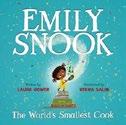
A small child learns that persistence pays off.
Grandpa has cooked with Emily since she was 2. He urges her to enter a cooking contest for kids but fails to notice the fine print: “Advanced Competition.” Emily is waist-high to the others but “tall with ambition.” The contest is irresponsibly unmonitored: She’s provided with inadequate leftover tools, must wear a too-big apron that she trips over, and is left at eye level with a boiling pot. Disasters befall each prescribed dish; improbably, the roux catches fire inside the pot. Emily is ready to quit until she spots Grandpa’s balloon with its slogan: “Believe in Yourself!” Somehow she has time to clean up, build a stool out of stale bread, and cook three new dishes, including a 10-minute sorbet, using “secret” spices she finds on a low shelf. Of course, she wins the gold cup. The other contestants instantly switch from sneering to magnanimity. The story is inspiring, if predictable, with an
implausibly sunny outcome; the four-beat verses and cheery color art are palatable. Emily has brown skin and short curly black hair in two yellow-tied side-bunches, while Grandpa is brown-skinned and bald, with side tufts of gray hair. The other contestants are racially diverse.
Seasoning with bright colors helps balance the added sugar in this can-do confection. (Picture book. 4-8)
Brashares, Ann & Ben Brashares | Simon & Schuster (384 pp.) | $18.99 | Sept. 17, 2024 9781665950817 | Series: Westfallen, 1

Six New Jersey 12-year-olds separated by decades race to ensure the “good guys” win World War II in this middle-grade work by the author of The
Sisterhood of the Traveling Pants and her brother, a children’s author and journalist.
It all starts with a ham radio that Alice, Lawrence, and Artie fool around with in 1944 and Henry, Frances, and Lukas find in 2023. It’s late April, and the 1944 kids worry about loved ones in combat, while the 2023 kids study the war in school. When, impossibly, the radio allows the kids to communicate across time, it doesn’t take long before they share information that changes history. Can the two sets of kids work across a 79-year divide to prevent the U.S.A. from becoming the Nazi-controlled dystopia of Westfallen? This propulsive thriller includes well-paced cuts between times that keep the pages turning. Like most people in their small New Jersey town, Alice, Artie, and Frances are white. In 1944, Lawrence, who’s Black, endures bigotry; in the U.S.A. of 2023, Henry’s biracial (white and Black) identity and Lukas’ Jewish one are unremarkable, but in Westfallen, Henry’s a “mischling” doing “work-learning,” and Lukas is a menial laborer. Alice’s and Henry’s dual
first-person narration zooms in on the adventure, but readers who pull back may find themselves deeply uneasy with the summary consideration paid to the real-life fates of European Jews and disabled people. The cliffhanger ending will have them hoping for more thoughtful treatment in sequels to come. Compulsively readable; morally uncomfortable. (Science fiction/ thriller. 10-13)
Capps, Heather Murphy | Carolrhoda (304 pp.) $19.99 | Aug. 6, 2024 | 9798765608296

A biracial Minnesota seventh grader’s baseball dreams are derailed by racism. Among other Black-positive values instilled in him and his sister, Wyatt Cash and his family (his white mom included) speak Swahili at home, largely because of his father’s complicated upbringing in a real-life Afrocentric community that was tragically bombed by the Philadelphia police in 1985. While his dad isn’t forthcoming about his past, Wyatt recognizes that the way his dad handles anxiety and stress—by manifesting plumes of mysterious smoke—may be connected to it. When smoke starts coming out of Wyatt’s hands, too, he learns it’s a family thing, just as the racist microaggressions he’s experiencing from his teammates, coach, so-called friends, and school officials mirror anti-Black prejudices his family has faced for generations. A remarkable counselor, unfazed by these supernatural symptoms, thoughtfully explains that epigenetics can intersect with racialized trauma, and work must be done to resolve this legacy. The story’s rich fabulism and scientific grounding don’t soften how truly difficult it is to witness Wyatt’s being broken by bigotry; the bookish student-athlete’s dreams are deferred and his personality changed by grinning white supremacists. The optimistic conclusion may not compensate for how
disheartening and triggering the series of hate crimes faced by this tween are. Still, Wyatt has a strong family, and some key friendships eventually see some muchneeded growth. A would-be star athlete faces bullying and racism in this traumatic story that’s given an optimistic spin. (author’s note, discussion questions, works cited) (Fiction. 11-14)
Carroll, Stacy Lynn | Illus. by Molly Ruttan Nancy Paulsen Books (32 pp.) | $18.99 Sept. 24, 2024 | 9780593109885

Can kindness be catching?
The Yowler family consists of pointy-eared, sharp-toothed, horned monsters who are terminally glum. In fact, “at the Yowlers’ house, grumpiness [is] a way of life.” Text full of alliteration and gentle humor describes various mildly troublesome situations that arise. Whether the family is attempting to garden, clean up, or go shopping, things end with inevitable grumbling, brawling, shrieking—and messes. Until, that is, some brown-skinned human neighbors move in next door. Appropriately named the Nicelys, they’re friendly and helpful and do strange things with their teeth (readers will realize they’re smiling)—whatever can this mean? The Yowlers find themselves reconsidering their grumpy way of life and begin to display more positive traits, including resilience and consideration, and soon they’re even smiling. By the end of the story, their pointy ears, sharp teeth, and horns are a distant memory, and the Yowlers are depicted as light-skinned humans. As a tool for social-emotional learning, this somewhat didactic tale verges on oversimplification but clearly states its explicit message about kindness in terms kids will easily understand. Funny, action-filled illustrations reminiscent of Mercer Mayer’s work round out this lesson in positivity.
An adventurous, otherworldly story that explores emotional themes.
THE DAGGERS OF IRE
A preachy but upbeat antidote to grumpiness. (Picture book. 3-6)
Cervantes,
J.C.
| Illus. by Paula Zorite Harper/HarperCollins (384 pp.)
$19.99 | Sept. 3, 2024 | 9780063312074
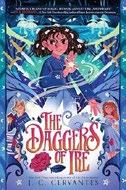
A 12-year-old witch is responsible for saving her family and town from evil. Esmerelda Santos is a bruja—a descendant of one of the four original witches, who vanished along with their special daggers. Usually, brujxes can command one element. Esme’s sister, Lenny, is of Water, and her best friend, Tiago, is of Air, but Esme is a Chaos witch. All she wants to do with her power is ease her father’s grief over her mother’s death. When she finds a heart spell, Esme believes she can use it to heal him. While she and Tiago are off gathering the ingredients, however, a storm hits, and all the witches vanish, along with the town’s magic. Esme returns to find Lenny, who’s been stabbed with a dagger. Lenny delivers a cryptic message before going up in smoke: They must find an original witch from the Legend of Ire. Esme and Tiago travel to a “banished realm where forbidden magic runs wild,” befriend a cursed fox, and find their way through portals to confront an unknown evil. If they fail, their families will be lost to Oblivion and their town of San Bosco will cease to exist. While readers must initially follow many different threads, the storyline smooths out as it develops.
Once the worldbuilding is established, readers will be rewarded by being transported into the magical, mysterious world Esme inhabits as they follow her journey of self-discovery through grief and love. Final art not seen. An adventurous, otherworldly story that explores emotional themes. (Fantasy. 8-12)
Cha, Frances | Illus. by Jaime Kim Crown (40 pp.) | $19.99 Sept. 10, 2024 | 9780593480267

Two trickster Korean goblins— or dokkaebi— struggle to adjust to life in New York City. Siblings Doki and Kebi are “settling into their new old house” after moving to the United States, as depicted in The Goblin Twins (2023). Orange-skinned, purple-haired Doki tries to enjoy a book, but blue-skinned, double-horned Kebi is perturbed because he has no friends in their new city. A hilarious sequence depicts Kebi’s unsuccessful attempts to connect with other ghoulish creatures, among them vampires and a Wednesday Addams–esque child. “Why don’t you go play some tricks on humans?” Doki suggests. Kebi confesses that it’s especially difficult to provoke the residents of their new city. Boldly colored and textured illustrations dotted with ghosts—unseen by humans—portray Kebi’s failed efforts to scare jaded New Yorkers. His oversize head and tiny body imbue his shenanigans with charm. He mixes up the trains in the subway, breaks traffic lights, and fills the streets with frightening “dokkaebi smoke,”
but the city’s residents remain unfazed. Curious, Doki joins in and ups the ante by floating the sphere off the Atlas statue at Rockefeller Center, making tables levitate in restaurants, and shrinking the Statue of Library—still nothing. But eventually the two realize that all they need is each other. Cha and Kim infuse their tale with both child-friendly chaos and a touch of sweetness. Human characters are racially diverse. An amusing tale of sibling love and mischief. (author’s note) (Picture book. 4-8)
Chaim, Shoshana | Illus. by Lori Joy Smith Greystone Kids (48 pp.) | $18.95 | Sept. 3, 2024 9781771646406 | Series: I Am Mindful

Chaim suggests stretches, movements, and poses that children can do when confronted with challenges. A little frog stands on the ladder of a slide looking nervous (“Sometimes things feel so hard”). Two nearby children—one brown-skinned, one light-skinned— chime in: “I wish I felt brave inside.” “Me too!” One has an idea: “I’m wrapping my arms around myself.” The child feels tranquil and brave, like a lion cub. The little ones continue to try different body positions and movements that channel everything from the motion of a train to the strength of a mountain. After these activities, they feel ready to tackle the tall slide. A note from the author offers “courageous cubs” encouragement and validation. In simple illustrations, both children—and the frog—demonstrate the poses and movements, an easy way for readers to see and practice the moves themselves. Each following page shows what the youngsters imagine themselves to be and how they feel, whether full of energy like bouncy balls or “happy and bright, like a shooting star!” The activities are straightforward enough that kids should be able to imitate them easily and aren’t specific to a practice like yoga (though
some motions seem to take their cues from the practice). This is a meaningful introduction to a mind-body connection for children in terms they can easily understand.
An affirming and practical guide. (Picture book. 2-5)
Kirkus Star
Cham, Jorge | Amulet/Abrams (256 pp.)
$15.99 | Sept. 17, 2024 | 9781419764103
Series: Oliver’s Great Big Universe, 2

Following his excursion into astrophysics, Oliver comes down to earth in this work that, like the first book in the series, mixes graphics and text, fact and fiction.
Eleven-year-old Oliver’s friend Sven, egged on by classmates, ingests an excess of cherry cobbler, leading to an unfortunate incident that sets up for a memorable description: “Volcanoes are what we call it when Earth barfs.” This event, plus the arrival of Aunt Dee, a volcanologist, leads Oliver to the study of earth sciences. Readers learn about the different types of volcanoes and that lava isn’t what’s most dangerous, because you can outrun it: “It’s all the other stuff…a bunch of ash, rocks, and hot gas” that will get you. Other chapters—including “A Planet Is Born,” “Crashing Continents,” and “Rocks Rock”—offer an entertaining overview with vivid real-life comparisons that will make the information stick. In order to shed their reputation as the “Epic Barf kids,” Oliver and Sven decide they must win the science fair. The main challenge? Ana Lía Quintero, who always wins. But this year, a mechanical failure with her earthquake project threatens to eliminate her, and Oliver must make a quick decision about what kind of friend to be. Cham’s chatty and accessible text and delightful black-and-white drawings bring the ethnically diverse middle
school characters and the scientific concepts to life.
Parallels—mostly delightfully gross—between human bodies and geology will hook readers on science. (bonus comic, websites, fun facts, index) (Graphic nonfiction. 8-12)
Chan, Ruth | Roaring Brook Press (288 pp.) $22.99 | $14.99 paper | Sept. 10, 2024 9781250855336 | 9781250855343 paper

Leaving everything behind and starting anew requires courage, perseverance, and patience. It’s 1993, and Ruth loves her life and friends in Toronto. So when her parents decide to move back to Hong Kong, she can’t help but focus on the negatives. Not only will she leave her school and friends behind, but she has only vague, unpleasant memories of visiting Hong Kong when she was younger, and she understands but barely speaks Cantonese. On top of that, her older brother, who’s a year from graduation, will be staying behind to attend boarding school, and her dad will be traveling extensively for work in China. This is a coming-of-age immigrant memoir with a twist that highlights the complex nature of migration: While many such stories take the characters somewhere new, Ruth and her family are ultimately returning to her parents’ home, albeit one that’s unfamiliar to Ruth. A story-within-astory retelling of Ruth’s father’s family’s flight during the Sino-Japanese War in the 1940s provides further depth and context. Chan illustrates the stories with her signature humor and wit. The panels, colored in a soothing palette, feature clean lines and vividly express the characters’ range of feelings. Many of Ruth’s reflections on her extended
Chinese family will ring true to those with Asian or immigrant families: A family tree that starts with Poh Poh and Gong Gong and ends with “NOT EVEN GONNA TRY” and an unwelcome encounter with a dish of chicken feet will have readers laughing in recognition.
Earnest, funny, and evocative. (language note, author’s note) (Graphic memoir. 8-14)
Clements, Andrew | Illus. by Brian Selznick Random House (224 pp.) | $17.99 Aug. 27, 2024 | 9780399557637

Clements’ last book, a posthumously published sequel to his beloved Frindle (1996). Sixth grader Josh Willett loves all things to do with computers— coding, creating, even doing his homework on his school laptop and submitting it online. But his hopelessly outdated English language arts teacher, Mr. N, requires students to bring physical books to class, uses a chalkboard instead of the SMART Board, and continues to insist that all assignments be handwritten, in “blue or black ink.” And neatness counts! When Josh’s search for an actual pen uncovers an old one of his mother’s from when she was in sixth grade, marked “Frindle,” Josh looks up the unfamiliar word online and finds a photo of 11-year-old Nicholas Allen, who looks a lot like a young Mr. N. Josh and his friend Vanessa investigate the mystery—and quickly discover that Mr. N. doesn’t want his past revealed. Written with Clements’ trademark humor and
featuring his classic straightforward, persistent protagonists, this work takes on the modern digital world, both good and bad, while playing homage to E.B. White’s Charlotte’s Web and Strunk and White’s The Elements of Style. This volume lacks Clements’ sure touch and isn’t quite up to par with his best, but it’s nevertheless a fitting final work from a master storyteller. Central characters present white; names cue ethnic diversity in the supporting cast. Final art not seen.
An engaging tale for the latest generation of Clements fans. (illustrator’s note) (Fiction. 8-12)
Daly, Catherine | Illus. by Genevieve Kote Kane Press (32 pp.) | $16.99
Aug. 27, 2024 | 9781662670794
Series: Dollars to Doughnuts, 3

An educational episode about how to handle one’s savings. Julian’s proud that his piggy bank is nearly full. Once he has over $350 saved up, Julian’s parents ask him to consider opening a bank account. He and his best friend, Lucy, then absorb negative depictions of banks from history and pop culture, such as bank failures during the Great Depression and a robbery on a TV show. They also meet with a banker named Rebecca who addresses their concerns and tells them about FDIC insurance. After Julian’s piggy bank briefly goes missing, Rebecca helps Julian open a savings account. His suspicion of bank accounts turns to excitement when he learns about the power of compound interest, which the
An engaging tale for the latest generation of Clements fans.
book reinforces with a couple of charts. The story ends with an amusing “Moola Man” comic (drawn by Julian), which incorporates everything he’s learned about banks and savings accounts. Filled with warm illustrations, the story puts a friendly face on some dry but important topics in financial literacy. Notably, Lucy is a math whiz who burns through money quickly, while Charlotte, a second grader who lives in Julian and Lucy’s building, has more money than Julian does, already stored in a bank. In the illustrations, Lucy appears tan-skinned, Julian reads Asian, Rebecca presents Black, and Charlotte is light-skinned.
A great introduction to banking concepts, as well as a reminder to check the interest rates on one’s accounts. (Fiction. 7-10)
David, Arihhonni | Holiday House (32 pp.) | $15.99 | Aug. 27, 2024 9780823456222 | Series: I Like To Read
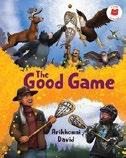
Can tiny Mouse and Squirrel hold their own in a game against larger competitors?
A young Indigenous boy stands on the sidelines as others play a game of tewa’á:raton (Kanien’kéha for lacrosse), afraid to join in because he’s too small. The child’s grandfather comforts him with the story of one of the first lacrosse games, played by forest creatures. Divided into Team Four Legs and Team Wings, the anthropomorphic animals clutch lacrosse sticks in their paws, between their teeth, and even in their antlers. Mouse and Squirrel observe, but when they try to join Team Four Legs, Bear, Wolf, Turtle, and Deer tell them they’re too little. Team Wings isn’t much kinder, until Eagle comes up with the idea of outfitting Mouse and Squirrel with homemade wings of leather and string. Their once-ridiculed size soon becomes their advantage as Mouse and Squirrel
fly past Team Four Legs and lead Team Wings to a quick victory. Mouse and Squirrel love their wings so much that they keep them—along with their new names, Bat and Flying Squirrel. David (Haudenosaunee Kanienkehaka) brings this tale to life with vivid cartoon images and simple text laced with an enduring message: Everyone—even the smallest of us—has unique gifts to offer. Youngsters who enjoy lacrosse will delight in learning about its origins. An encouraging story for emerging readers—especially those who love sports and animals. (author’s note, glossary, list of phonic features) (Early reader. 4-8)
Diño, Yxavel Magno | Bloomsbury (288 pp.) $17.99 | Sept. 10, 2024 | 9781547615131

A young warrior faces horrifying beasts and evil magic in order to rescue her sister. Twelve years ago, when Tanikala, the daughter of a great warrior, was born, a prophecy said she was destined to defeat the Great Bakunawa, a giant sea serpent who will devour the last moon and leave their world in darkness. Tani is training to become a Serpent Rider, a warrior with a personal flying elemental serpent. Unfortunately, Tani’s bakunawa egg hasn’t hatched yet. Without her serpent, she isn’t sure how she’ll protect those she loves, like her younger sister, Ligaya. Then an impatient Tani meets a woman in a vision who says she can craft a bakunawa for her. After a deadly monster attack on the village, Tani, tired of feeling helpless, makes a deal with the strange woman. Her new bakunawa is incredible, but she soon discovers that the price she must pay is her beloved sister. Desperate to save Ligaya, Tani enters the dangerous forest, faces beasts and ghouls, and finds unexpected allies and foes. But
time is running out before the Great Bakunawa’s return. Based on Filipino folklore and legend, Diño’s debut is an action-packed fantasy filled with twists and turns. Readers will relate to Tani’s struggle to figure out her identity and find her strength while living up to her destiny and her father’s reputation. Tani’s beautiful but frightening world vividly incorporates many different tales, monsters, and creatures.
An engaging adventure full of Filipino magic. (Fantasy. 8-12)
Drozd, Jerzy | Iron Circus Comics (248 pp.) | $15.00 paper Sept. 3, 2024 | 9781638991434
Series: The Inscrutable Doctor Baer
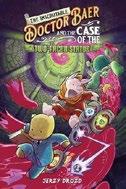
Ursine occult scholar Doctor Baer lives in gloomy seclusion with his many wards, demonic creatures who are under his stewardship. When dastardly sorcerer Gallus Lugubrious attempts to steal Baer’s precious Stone Guardian statue and it shatters, he must team up with kindhearted Pickles (a pig) and cynical Taft (a giant tortoise) to retrieve the pieces. The uptight little brown bear, who wears a blue suit and an impassive expression, has never had reason to venture beyond his front door. He faces a steep learning curve that includes encounters with a cavalcade of supernatural horrors, strange adventurers, and a talking magic staff. But the demons have secrets relating to past traumas, and as the group makes their way through unforgiving natural landscapes, Baer begins to learn how a listening ear can heal. The phantasmagorical trip takes readers to a lost city in the jungle, across snowy peaks, and to the bottom of the sea, all rendered in luscious detail. This is a story built on lore and one that’s well suited to the graphic
format. While the breathless backstory details can be overwhelming, the care taken in portraying the environment and Drozd’s magnificent command of layout balance it out. Drozd clearly draws on a tradition of older fantasy adventure comics in a way that’s too rarely seen today. The energetic action sequences make good use of the dynamism inherent in scenes of anthropomorphized animals using complicated magic.
A creative odyssey. (excerpts from Doctor Baer’s files, map) (Graphic fantasy. 8-12)
Kirkus Star
Duncan, Violet | Nancy Paulsen Books (128 pp.) | $17.99 Aug. 27, 2024 | 9780593624814
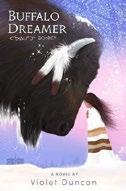
Drawing inspiration from her own family’s experiences, Duncan (Kehewin Cree/ Taino) tells the story of an Indigenous girl who confronts hard truths one summer.
Twelve-year-old Summer, her brother, Sage, her mother, who’s Cree, and her father, who’s Apache, are visiting Summer’s maternal grandparents, who live on the Cree reservation in northern Alberta. Though Summer enjoys her time with her extended family—picking sweetgrass, fishing, listening to stories—she’s been having strange dreams about an Indigenous girl named Buffalo Dreamer fleeing in the night. Unmarked graves of children have been found at a nearby residential school, and many members of the community are grappling with the abuse they faced there—including Summer’s Mosom (grandfather), who rarely talks about the experience. Summer learns more about how Indigenous children were forced into residential schools by the Canadian government. Are her dreams
In Gamerville, the children’s author and illustrator is on a quest for connection.
BY MAGGIE REAGAN
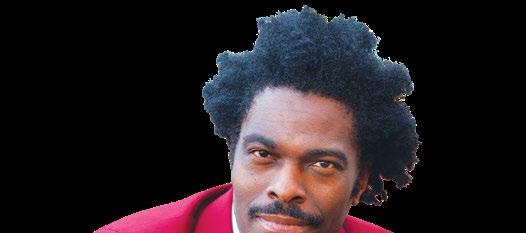
WHEN COMICS CREATOR Johnnie Christmas released his first book for young readers, Swim Team (HarperAlley, 2022), he went beyond a simple sports story to explore Black America’s fraught history with swimming. In Gamerville (HarperAlley, July 16), his second middle-grade graphic novel, he flexes those same muscles to deliver a multilayered narrative that’s really several stories at once.
Max’s favorite place is Calamity Bay, the world in his favorite video game. He’s just qualified for the semifinals of the Gamerville tournament when he gets the worst news ever: His parents have signed him up for a technology-free summer at Camp Reset. There’s no getting out of it, but as Max’s story intersects with that of other Camp Reset members, he uses the skills he has—and some new ones he’s picked up—to do the thing he feels born to do.
For Christmas, this isn’t a story that debates the merits of video games versus the outdoors; instead, he’s interested in the ways people connect to each other, and how their environment affects these connections. He spoke with Kirkus via Zoom from Miami Beach, where he was in residence at the Betsy Writer’s Room in late May. This conversation has been edited for length and clarity.
First things first: Were you a camp kid or a video game kid?
I was a video game kid. I played a lot of the Zelda games, Mario games. I loved expansive adventure-action games. Sometimes the shooter games or Grand Theft Auto, games where there’s a nice story arc with action and adventure. Now I’m playing mostly word games, like Wordle and Connections.
You essentially had to create two games for Gamerville. You made the world of Max’s favorite game, Lone Wolf of Calamity Bay, but Camp Reset is also laid out like a video game. Can you talk about designing these two different landscapes and how they influenced each other?
It’s actually four different interconnected worlds. There’s Max’s normal life and his hopes and aspira -

tions, the world of the video game (Lone Wolf of Calamity Bay), and the world of Camp Reset—and there’s also the world of the tournament and its heightened reality. They all had to respond to the others in some kind of way. It was a fun, creative challenge.
Calamity Bay is a completely technological unreality, but Camp Reset is another kind of unreality— of a past world completely outside of technology. I love playing with the juxtaposition between those two, and with the ways the denizens of each are completely committed to their particular worlds. And of course, Max is trying to figure out his place in both.
Video games can be very polarizing for adults. I loved seeing Max’s mom worry about the impact on Max’s attention span, social life,
and health, but not realizing how her worries could have the same effect. Tell us about walking that line. I didn’t want a book that denigrated video games, because they’re fun and they’re enjoyable. You can learn a lot of lessons from them, and they have great narrative value.
I wanted to say that [the most important thing is] the relationships we have, even in the video game world: between the characters, between Max and his screen, and [between Max and] his would-be coaches. We’re all looking for something. I wanted the video game world, as well as the camp world, as well as the school world and the family-life world, to be metaphors for what we’re all looking for—which is ultimately connection. And that’s what the book is about: digital connection.
Connecting to the game, but also connecting to each other.
Something that really interests me is the way you handle the nature of bullying. With the character of Dylan, a reformed bully trying to make amends, you show how bullies often make more bullies, and you’ve also created empathetic characters on all sides. When you put on a mask, you take on a persona. It’s a very powerful thing. Our online world is this relatively new culture that we’re all forming in real time, and within this new culture, we’re trying to figure out what we are.
In the book, Dylan puts on this mask and realizes that he’s actually starting to become this thing. What do you do with that person when you encounter them? You have to reconcile what we do with these people.
And I don’t have any answers. I wanted to have the characters figure it out. The readers of Gamerville and all our young people are the folks who will be making these decisions for us. They’re the people who are forming this culture; they’re native to it.
Gamerville isn’t about systemic racism in the same way that Swim Team was, but there are so few books about children of color, especially Black kids, in the natural world. In that way, this is kind of groundbreaking. Stories with Black kids often use words like asphalt and concrete and urban—unnatural, man-made elements, and racism is an unnatural, man-made structure. It really bothers me, and I try to think about how we can separate our inherent humanity from these structures.
There are islands off the coast of Vancouver, where I
The beauty of graphic novels is that we can visually display things. You can just show something, and people can feel it in their own way.
live, called the Gulf Islands. I spent most of my childhood growing up in cities, so the first winter I was there, I started realizing that my relationship to the natural world was mine. A lot of the time, stories about Black children are about them being removed into the natural world, plugged into this artificial system. [Those experiences] helped my thoughts on Gamerville quite a bit: Max’s relationship to the natural world is something that’s his. He has guides and these wonderful friends he makes along the way, but he’s going to be developing [that relationship for] himself for his entire life. It was very important to me that the camp be Black-owned for generations; these kids weren’t being plugged into another system, another middleman. I wanted it to be a Black military officer who’d found the natural world on his own and created it for all these campers.

Max avoids the entire underground level in Calamity Bay. When he reaches Camp Reset, he’s frightened by the cave system near the camp. Tell us more about illustrating this fear.
I was thinking about how to visually show isolation, and how lost one can be in isolation. Caves are dark, cavernous. You could be lost down there forever if you’re not able to find your way back. The beauty of graphic novels is that we can visually display things. You can just show something, and people can feel it in their own way. People create their own language inside. So the cave was a very important part of my showing Max’s journey from darkness, loneliness, and isolation to connectivity and light.
What was your favorite part about creating this book? The worldbuilding was almost like designing a video game, but for a graphic novel. The hard work, the discipline, came in simplifying it. The inception part is always the most fun, because you’re just dealing with what ifs. And then the hard part is making everything link together.
In this completely digital video game world, echoes of environmental messages from our actual physical world are baked into this digital, artificial game. If you’re playing along, you can see what’s happening. This artificial world echoes our concerns in the actual world, because if you lose this one, you lose that one, too.
Maggie Reagan is a children’s book editor and reviewer in Chicago.
connected to this painful history? At a community rally and, later, a powwow, survivors acknowledge their wounds and begin to help one another heal. Duncan shines a light on a devastating aspect of Indigenous history, never sugarcoating the topic yet leaving readers with hope. Her writing is seamless, tight, and immersive, making stellar use of sensory descriptions, and she braids important truths into her captivating narrative: “We are the living proof of our ancestors’ resilience and the strong spirit of our people.” Compelling yet heartbreaking— and essential reading for all young people. (glossary, author’s note) (Fiction. 10-14)
Dyckman, Ame | Illus. by Christopher Weyant | Two Lions (48 pp.) | $17.99 Sept. 3, 2024 | 9781662504129

A Romeo and Juliet story in bird form.
The red-footed boobies live on one rock, while the blue-footed boobies live on another, separated by water. Never the twain shall meet. (A wise old hermit crab who says, “Boobies are silly!” lives on a rock between them.) All is calm until the day a pair of boobies—a young female with red feet and a young male with blue feet—come into contact, realize that they have a lot in common, and fall in love. The pair’s families oppose the match, but the hermit crab performs a marriage ceremony anyway, and soon a chick is born—with purple feet. Both the red- and blue-footed boobies claim ownership, but the parents overrule them all and start a new home with the hermit crab on the in-between rock. Is there anything new here? Not really. The illustrations reinforce gender norms (the female has red feet, the male blue; the female is depicted with long eyelashes), and we’ve seen different
versions of this story before. Still, it’s a solid, enjoyable tale about overcoming fear and accepting and celebrating differences, with the likable, goofy boobies making for a fun addition. Weyant’s simple cartoons use plenty of white space. A note includes information on the real birds.
A peppy but predictable lesson in combating prejudice. (Picture book. 4-8)
Escabasse, Sophie | Colors by Kiwi Byrd
Random House Graphic (224 pp.)
$21.99 | Sept. 3, 2024 | 9780593565988

During winter break, a girl in Montreal gains the ability to see ghosts and becomes swept up in their cause. When Adèle, who’s depicted with curly black hair and pale, rosy skin, inherits the family gift of being a medium, she learns it’s linked to getting her first period. Her Gran and older sister, Helen, are there to support and guide her through the period stuff, but when it comes to navigating ghosts, Adèle is kind of on her own; Helen never gained the family power, and Gran does all she can to ignore it. When an elderly, mustachioed ghost named Jules asks for her help, Adèle hesitantly agrees. He wants her to convince his grandson to not sell his house to shady developers. Jules is part of a group of ghosts who are fighting against gentrification, a cause Gran is also passionate about. With the help of a young ghost who frequents the library, Adèle finds a way to use her voice and her new powers to help her community. The expressive,
energetic art is appealing and easy to follow. The ghosts are portrayed in monochromatic pastels of different hues, making them stand out in contrast to the rest of the black-lined, vibrantly colored elements. Although the story feels a tad overstuffed and the ending wraps up too quickly, this story has plenty of charm and a captivating cast of characters. An appealing and creative coming-ofage tale. (information about the setting, character art) (Graphic paranormal. 8-12)
Faruqi, Reem | Illus. by Nadia Alam Henry Holt (40 pp.) | $18.99 Sept. 3, 2024 | 9781250907219

An anthropomorphic house learns that you don’t need fancy decorations to feel loved. House longs to be adorned with twinkling holiday lights like its neighbors. It watched while a nearby house sparkled for Diwali; another had menorah lights in its window during Hanukkah. Christmas is drawing near, and House desperately hopes for lights of its own when young Huda and her family move in. The home fills with the aroma of cardamomscented rice and the sounds of a family game…but no one decorates. When Christmas arrives, Huda’s parents go to work so that others can celebrate. House is filled with the joyful noises of Huda’s relatives, who have come to visit; though House may not be decorated, it’s still happy: “I’m full of love and hope.” When Huda’s parents return home late that night, Amma tells a sleepy Huda
A humorous yet balanced take on a hot topic.
that she can look forward to beautiful lights for their own holiday, Eid. House is delighted at the news. When the weather turns warm, it’s House who is newly adorned with strings of glittering lights as it proudly hosts an Eid celebration inside and out. Making clear that Muslim celebrations are just as festive as holidays such as Christmas and Hanukkah, Faruqi delivers a refreshing twist on Eid tales. Brimming with details, Alam’s welcoming illustrations capture the closeness of this family; scenes of the lit houses shining in the darkness are especially moving. Vocabulary and visual cues suggest that Huda and her family are of South Asian heritage.
Simply charming. (author’s note) (Picture book. 4-9)
Foley, Greg | Disney-Hyperion (160 pp.) $24.99 | Sept. 17, 2024 | 9781368096911

Strega Nona meets the singularity in this zany comic. Dex, an almost 10-year-old “half Filipino, half American” dingo whose (offstage) parents live apart, longs to be the greatest at something…but what? Dex loves making lists, so when his teacher asks the kids to complete an assignment on what they want to be when they grow up, he starts brainstorming. When a rival nabs his first career choice (king), Dex decides to try his hand at being an inventor. His friends’ ideas for an invention “that we all need” are wild and unworkable. Then Syd the snake stresses that there’s already “too much ssstuff in the world.” So Dex creates an Infinity Room, and he and his best friend, Buckley Bat, throw together and program nanobots to eliminate excess stuff. The nanobots consume materials, only to replicate themselves exponentially, transforming trash into gray nano-goo. They’re programmed
to spread; this invention literally can’t be put back in the box. Luckily, Nono, a rogue nanobot, can digest the gray goo and reconstitute it. Some of the lively cartoon art flips so that we can make Nono vomit up the goo! All the trash returns, perhaps for a sequel, but Foley has nimbly avoided both a too-simple solution…and universal obliteration. His energetic illustrations and off-the-wall story brim with action and humor; kids will be eager for more of Dex. Frenetic, funny, fantastic, relatable— this dingo is a wild dog! (how to draw Dex and Nono, information on real nanobots) (Graphic fiction. 8-12)
Gad, Josh | Illus. by Marta Kissi Putnam (32 pp.) | $19.99
Sept. 17, 2024 | 9780593463123
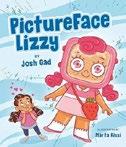
Broadway and film actor Gad tells the story of a child who needs the hottest new electronic device to fit in—or so it seems.
Eve has many material possessions, family members, and pets, including a hedgehog named Snoop Hog, a three-legged lizard, and a puppy named Bluster. But, alas, Eve’s life is still a “tragedy,” because the child doesn’t have a PictureFace Lizzy electronic toy. Eve has asked for one 12 times, and while Mom and Dad haven’t said no outright, their non-answers haven’t yielded Eve’s desired outcome. A shopping trip with two friends who do have PictureFace Lizzy toys is another reminder of what Eve doesn’t have. Even gymnastics—where Eve is top of the class—makes the child feel left out when everyone dances to pop songs played by a PictureFace Lizzy. At birthday parties, sleepovers, and in school, Eve’s always the odd one out. Finally, Eve asks again and…best surprise ever: Eve gets a Lizzy! While the new tech brings Eve up to speed with the class, everyone actually has the most fun when they
put their Lizzys away and experience life screen-free. This wholesome, funny tale tackles themes of consumerism and technology trends, while Kissi’s full-color cartoon art complements the first-person narration, capturing Eve’s flair for the dramatic. Eve’s cued as biracial, with one brown-skinned parent and one lighter-skinned parent. The Lizzy toys are customizable to resemble their owners.
A humorous yet balanced take on a hot topic. (Picture book. 4-8)
Gatto, Joe | Illus. by Luke Flowers Penguin Workshop (40 pp.) | $18.99 Sept. 3, 2024 | 9780593750193

In this picture book from comedian Gatto, a little one embarks on a nighttime detective caper while also learning some calming techniques.
Tucked into bed, a light-skinned youngster with a mop of brown hair is almost ready to go to sleep, but something’s missing. Eyes wide, mouth agape, the child wonders, “Where’s Bearry?” The snuggly teddy is lost. Armed with a household map and magnifying glass and trailed by a pup sidekick, the tot searches high and low. “He’s not in the playroom / with my robot and blocks. / He’s not in the hamper / with all the stinky socks.” More searching comes up empty, and the increasingly distraught narrator worries, “Maybe he took a trip on the ferry? / Oh no! I’m freaking out! // WHERE’S BEARRY?!?!” Luckily, the youngster remembers to take a deep breath and count down from three. These actions help soothe the intrepid detective, and suddenly, all becomes clear. (Spoiler alert: Bearry is found.) The jaunty, singsong text trips up a bit here and there but propels the mystery forward. Flowers’ colorful art captures the wide range of emotions the youngster experiences: sadness, panic, serenity, and relief.
Relatable bedtime fare.
(Picture book. 3-6)
George, Kallie | Illus. by Carmen Mok Greystone Kids (36 pp.) | $17.95 | Sept. 3, 2024
9781771647427 | Series: Sounds of Nature

On a fall hike in the mountains, a small group listens to the world around them.
An adult and three children—a preschooler with light brown skin and curly hair in two puffs and two school-age children, one with light skin, short blond hair, and a knit cap, the other sporting glasses and sharing the beige skin tone and dark hair of the adult—set off on a hike. “The mountains have lots to say… / if you listen.” Each subsequent spread starts with an onomatopoeic sound and the children recognizing the noisemaker: “Chirr, chirr. / I hear you, Chipmunk, / chattering cheerfully. / Would you like / to hike with us?” On their way to the summit, they also hear a waterfall, rustling branches, bouncing pine cones, birds hoping for dropped crumbs, footsteps, a snoring bear (imagined), snowflakes, and an echo. George highlights sights and sounds accessible to most children who are exploring the mountains, making this an adventure that young ones can replicate, especially since Mok depicts the characters taking frequent breaks to rest, snack, or satisfy their curiosity. The youngest child hitches a ride partway but is still able to tackle the terrain, and the group’s efforts have a satisfying payoff. Likely to sharpen nature-listening skills, this is ideal for sharing before a mountain hike of your own. (Picture book. 3-7)

A nail-biting, heart-pounding— and heartbreaking—adventure.
TALES FROM CABIN 23
Gold, Andrew | Illus. by Polona Lovšin
Random House (32 pp.) | $18.99
Aug. 27, 2024 | 9780593903049

In this picture book based on Gold’s popular song, a group of costumed children shriek and screech on Halloween.
Youngsters wearing skeleton outfits assemble and prepare for spooky fun. They imagine themselves as the real deal—bones come to life—while getting ready and posing for photos. As they trick-or-treat, they surprise other members of the community. Later, they put on a silly performance, with actual skeletons joining in, before heading home for some hard-earned rest. Adults familiar with the hit tune—which was recorded in 1996 and has since gone viral on social media—might pick up this one based on that recognition. The illustrations loosely take inspiration from the lyrics and serve as the primary driver for the storytelling. They make excellent use of fall colors and exude a sunset glow that truly evokes Halloween. Sometimes the text and visuals align, but at other times the images tell the story independently: Gold’s goofy lyrics describe skeletons rising from their sarcophagi to “send shiiiiivers down your spine” and “SHOCK your soul,” while the gentle visuals mostly focus on trick-or-treating, with real skeletons occasionally jumping into the fray. The result is a muddled—though still enjoyable—reading experience. Most human characters are lightskinned, though people of color appear as well.
A disjointed read that nevertheless will elicit warm seasonal feelings. (Picture book. 3-5)
Gómez, Dani | Trans. by Luisana
Armendáriz | Charlesbridge (32 pp.)
$17.99 | Sept. 3, 2024 | 9781623544850

Time changes some things—but not all.
Emma loves unicorns. Her bedroom walls are covered with unicorn posters, and she owns loads of unicorn toys and dolls. Her indulgent, tattooed, long-haired, long-bearded dad reads her stories about unicorns every night before bed. Guess what costumes they wear at Halloween, with Emma riding on Dad’s back, calling out, “GIDDY UP, UNICORN!”? Time has a way of passing, though, and interests inevitably change. As Emma grows up, her passions turn from unicorns to novels about vampires; wall space gives way to posters of singers. Eventually, Emma leaves home to start her own family; the unicorns are stored in the closet. Happily, Emma’s daughter, Elna, loves unicorns as much as her mom once did. It’s a good thing Grandpa kept all the unicorn paraphernalia. When Elna visits, Grandpa gives her plenty of unicorn-back rides and even lets her take the whole box of unicorns home. For the first time in ages, his house appears to be devoid of unicorns. Or is it? What’s that tattoo on Grandpa’s belly? This sweet, wistful import, originally published in Spain and translated from Spanish, considers the inexorable passage of time and how happy, loving memories and traditions enrich new generations. The colorful digital illustrations are filled with warmth and humor. The protagonists are light-skinned.
Unicorn buffs and all kids lucky enough to have grandparents will appreciate this tender, knowing tale. (Picture book. 4-7)
Goodwin, Doris Kearns | Adapt. by Ruby Shamir | Illus. by Amy June Bates Simon & Schuster (368 pp.) | $18.99 Sept. 3, 2024 | 9781665925723

A young readers’ version of Goodwin’s Leadership (2018), adapted by Shamir, that also incorporates material from no fewer than six of Goodwin’s previous works.
This volume looks at the lives of Abraham Lincoln, Theodore Roosevelt, Franklin Delano Roosevelt, and Lyndon Johnson and tries to explain how they grew up to become president. Each subject has one chapter devoted to his childhood, one to his presidency, and four to the time in between. Goodwin shows the traits each shared—primarily, persistence and a remarkable ability to communicate their ideas to their fellow humans—and the obstacles—poverty, illness, death of loved ones—that each overcame. Along the way, sidebars offer additional information on topics such as the political parties in Lincoln’s day, the definition of a filibuster, and the contributions of gay civil rights activist Bayard Rustin. While never muckraking, Goodwin nevertheless carefully explains each man’s limitations, noting Lincoln’s desire to send newly emancipated Black Americans overseas and Roosevelt’s internment of Japanese Americans and failure to allow Jewish refugees to enter the U.S. This is a composed, readable, and detailed account that offers some insight into the qualities leaders are born with and the qualities they develop through sheer hard work. Final art not seen.
A solid exploration of the path from childhood to presidency. (selected bibliography, URL link to citations) (Nonfiction. 10-16)
Hanna Alkaf | Balzer + Bray/ HarperCollins (224 pp.) | $15.99
Aug. 27, 2024 | 9780063283947
Series: Tales From Cabin 23, 2

The return of a long-lost sister disrupts the peace of a quiet town.
Melur, a Malaysian girl at a U.S. summer camp, wanders into the woods on a dare in order to find the Witch of Cabin 23. The Witch tells her a terrifying tale about a 12-year-old Malaysian girl named Alia who’s moved with her family from Kuala Lumpur back to Negeri Sembilan, where she grew up. Alia struggles to fit in; she also hears eerie noises and feels as though someone’s watching her. Things start to look up when her older sister, Ayu, now 21, returns after mysteriously leaving home years ago. But strange things keep happening, and her classmates report seeing a floating head in the night sky. Could it be a penanggalan, a vampiric monster that, according to Malaysian lore, preys upon children and can remove its head? Alia’s parents are thrilled at Ayu’s return, but Alia suspects that Ayu is connected to the odd occurrences, and she devises a plan to uncover the truth. The reality she confronts is far more complex than she could have ever imagined. The latest in this anthology series—each of which is written by a different author—beautifully weaves Malaysian folklore into a gripping, deeply moving thriller that grapples with the devastating toll that secrets can take upon a family. Both Melur and Alia are Muslim; Melur wears hijab, while Alia often repeats Quranic verses to herself.
A nail-biting, heart-pounding— and heartbreaking—adventure. (Horror. 8-12)
Hanson, Thor | Illus. by Matt Schu Greenwillow Books (40 pp.) | $19.99 Sept. 24, 2024 | 9780062676498

Mozart makes beautiful music with Star, a starling who can imitate many kinds of sounds. In Vienna, even when unusual pets were all the rage, local birds like starlings weren’t very popular. But the story goes that in the spring of 1784, Mozart heard a starling in a pet store sing out one of his own compositions. Though the bird had a plain appearance—“with a faint purple sheen, / and maybe some green, / And some simple spots on his back”—Mozart had to buy him. Had the avian singer, who once lived on a farm, where he was considered a schädling (pest), learned the tune directly from the composer, who often hummed as he walked around the city? The story is told in light rhyming verse, and whether or not readers know much about Mozart, they’ll enjoy seeing the ordinary bird triumph over the more vibrant and unusual specimens at the pet store. Mozart, in his bright red coat and traditional white wig (it even flies off his head in one spread), stands out in the cartoonish digital illustrations, often brown and black in tone to depict 18th-century Vienna. The pictures are enlivened by the unusual animals for sale in the shop and by peacocks and parrots out in the street. A few modern scenes are included, reminding us of Mozart’s lasting appeal.
Zeroes in on a delightful, quirky aspect of the famed composer’s life. (more about Mozart and starlings) (Informational picture book. 6-9)
Kirkus Star
Nox Winters and the Midnight Wolf
Hassan, Rochelle | Harper/ HarperCollins (368 pp.) | $19.99 Sept. 3, 2024 | 9780063314573
Series: Nox Winters Chronicles, 1

After several terrible months apart, Nox Winters and his identical twin brother, Noah, are finally together in Evergreen, Maine, where Noah is receiving treatment for a mysterious illness. The seventh graders are staying in the unsettling house of their mother’s friends Weston and Aster Day, who are oncologists. Noah, Nox’s charming, easygoing opposite, is getting worse, a setback that’s tied to a spectral wolf who enters through their window at night. Joined by levelheaded, nature-loving Thea, Aster’s daughter, Nox ventures into the local forest seeking answers in the Nightwood, a parallel world of eternal darkness. Hassan’s duology opener is a classic quest story that lies on the border between horror and the fantastic. The Nightwood is populated by creatures from mythology and nightmare: animalistic forest deities, living constellations, and a terrifying yet endearing puppet. The story moves at an assured clip as Nox and Thea use practicality to survive a world they can no longer fully understand. Nox is clever and loyal, but he’s heroic out of necessity rather than inclination. He’s propelled by a temper that’s a genuine struggle for him, making his life and relationships difficult to manage. As the true nature of Noah’s condition and the secrets of the twins’ history unfurl, so do Nox’s first forays into trusting people outside his family and accepting his own flaws and mistakes. The central cast presents white. An enjoyably strange and wildly inventive journey into the unknown. (Fantasy. 8-12)
Heald, Robin | Illus. by Andrea Blinick
Pajama Press (32 pp.) | $18.95
Sept. 17, 2024 | 9781772782899
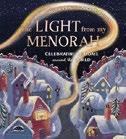
What holidays do people observe in winter?
During a cozy Hanukkah celebration at home, a light- skinned youngster gazes at the lit menorah in the family’s window. The child imagines riding the miraculous beam that it radiates, watching in wonder as the light touches communities across the globe, each celebrating a different light-filled holiday. Luminous illustrations depict diyas for Diwali, kinaras for Kwanzaa, candle wreaths for St. Lucia Day, and krathongs for Loy Krathong. Finally, the light finds “you,” wherever you are and whatever you might celebrate. Returning home, the child realizes that the real holiday miracle is the light that radiates, connecting us all. A glowing ribbon winds through the pages, providing a lovely visualization of the metaphorical light that different traditions all bring to the world. The brief section describing “you” feels less slightly inclusive than the rest of the story. Though the text lists a variety of holidays that “you” might be celebrating, the brown-skinned, long-haired child on these pages is hanging colorful ornaments on what readers are likely to assume is a Christmas tree. The book also doesn’t explicitly acknowledge children who might not celebrate a fall or winter holiday. But the final few pages return to the more inclusive celebration of the collective light that arises from our diversity. A
concluding note briefly describes the holidays portrayed. Characters are racially and culturally diverse. A shining paean to winter traditions around the globe. (Picture book. 4-8)
Hemming, Alice | Illus. by Nicola Slater
Sourcebooks Jabberwocky (32 pp.)
$18.99 | Sept. 3, 2024 | 9781464226786
Series: Squirrel & Bird

The ground is all white and cold, and Squirrel has no idea why. Awakening to find the grass is gone, Squirrel panics and calls for Bird. Ever patient Bird explains that sometimes it snows in winter, and the grass just gets covered. Bird suggests they play in the snow, but Squirrel says it’s too cold…until Bird introduces Squirrel to snowballs. Suddenly, Squirrel loves snow. Bird also explains that snowflakes are all different shapes. Squirrel’s skeptical. “They’re all small, white blobs.” Then Squirrel yells, “BIRD! There is SMOKE coming out of my mouth! Is it because I ate a snowflake?” Bird notes that sometimes it gets so cold that you can see your breath. A frozen puddle sends Squirrel sliding into a giant snow squirrel. Squirrel’s pretty sure that snow squirrel stole some hazelnuts. Bird explains that’s impossible: “It isn’t real—it’s just a SNOW squirrel.” When the snow melts overnight, Squirrel is convinced the snow squirrel took it all—but at least the hazelnuts are still there (the builder of the snow squirrel had used them for the eyes and mouth).
Hemming’s tale, which relies on speech bubbles and text in several different fonts for emphasis (and overreaction),
A shining paean to winter traditions around the globe.
THE LIGHT FROM MY MENORAH
is as funny as the first two in the series, while Slater’s digitally created, colorful illustrations add some slapstick giggles. The book finishes with a double-page spread of snow facts that address Squirrel’s concerns. May this endearing pair have more sneakily educational outings. (Picture book. 2-7)
Hoffman, Alice | Scholastic (304 pp.) $19.99 | Sept. 17, 2024 | 9781338856941
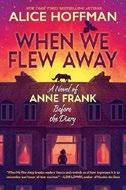
The story of Anne Frank and her family before the diary that would become an iconic work of the 20th century. Hoffman imagines the Frank family in Amsterdam—their conversations, feelings, and interactions—during the terrifying time that led up to their hiding and Anne’s writing of her diary, which was published posthumously in 1947. Anchored in historically accurate details, this story portrays Anne as both hopeful and scared, clinging to her girlhood and normality even while her personhood was being systematically stripped away. Hoffman examines Anne’s complex relationships with her mother and older sister, Margot, in heart-wrenching scenes that show them to be typical of many mothers and daughters. Historical information woven into the narrative serves as time stamps as the Franks move ever closer to their life in hiding. This context is helpful for readers and offers a startling reminder of the terror that took over Europe during World War II. Ultimately, Hoffman portrays Anne and Margot as the children they truly were, gripped with fear and telling each other stories for comfort but still eager to go for bike rides, celebrate birthdays, and try to live their lives fully. This novel serves
as an insightful companion for Frank’s own diary or as a stand-alone entry into a terrifying and unforgivable time in history. Deeply moving and beautifully written. (afterword, further reading) (Historical fiction. 9-12)
Hoffman, Sarah & Ian Hoffman | Illus. by Chris Case | Magination/American Psychological Association (32 pp.)
$17.99 | Sept. 2, 2024 | 9781433844584

Jacob—whom readers may remember from the oft-banned Jacob’s New Dress (2018)—discovers that a beloved book has been removed from the school library. Jacob adores “the penguin book”— clearly And Tango Makes Three (2005), though never referred to by name—but it’s missing! Later, his classmate Emily, who has two dads, wants to show the book to Noah, but their teacher explains that “some people are unhappy with the books we have in our library.” Jacob knows it’s because the penguins are both dads. Since Noah still doesn’t know what the book is about, the kids decide to play penguins at recess, gathering rocks and pretending to hatch eggs. The story ends with Jacob’s mother reading the book to him at bedtime and the two deciding to try to get the book reinstated in the library. The narrative seems to have been designed with adults in mind. It not only addresses naysayers who may be concerned about a child “turning gay” after reading LGBTQ+ books, but also winks and nods at those already in the know. Though it may help validate kids’ feelings around book banning, it doesn’t address their questions or concerns: The adult characters are frustratingly cagey about why books are challenged, nor do they offer concrete guidance about responding to censorship. Still, the book could be useful as an entry point for more in-depth discussions. Jacob presents white; his community is racially diverse.
An anodyne lecture that feels targeted toward the grown-ups in the room. (Picture book. 4-7)
Horvath, Polly | Margaret Ferguson/ Holiday House (256 pp.) | $18.99 Sept. 10, 2024 | 9780823455676

Four librarians secretly raise the baby they found one day in the children’s room of the Huffington, Indiana, town library. The women are friends, all single and childless (though not by choice), and each is a little quirky. By the time Essie’s 11, she’s read a great deal about the world but experienced little. Meeting G.E., a boy who looks just like her, makes her dream of being part of a large family. The two plot: Essie’s four mothers could marry the four male department store employees who are G.E.’s dads. The real outcome turns out to be slightly more complicated. The adult characters are drawn with broad, slightly stereotypical strokes: fat, white Midwesterner Doris is a terrible cook, French Jeanne-Marie is “thin and spiky” but a romantic at heart, Black Taisha has incredible skin and “a lovely froth of black hair around her head like moss,” and black-haired Lucinda has “that kind of look” that makes people think of fortunetellers (likewise, Hernandez, one of G.E.’s dads, “makes great Mexican food,” in contrast to the “regular stuff” prepared by one of his white dads). Horvath doesn’t simplify her vocabulary or philosophical musings for her audience, tossing in, without translation, French phrases and a little Yiddish. The low-tech, late-20thcentury, small-town setting offers a safe, well-staffed library: It’s a lovely daydream for readers who think that E.L. Konigsburg’s Claudia Kincaid had the right idea (but should have run away to a library instead of the Met). Amusing. (Fiction. 9-12)
We Are the Builders!
Iyer, Deepa | Illus. by Romina Galotta Simon & Schuster (40 pp.) | $18.99 Sept. 17, 2024 | 9781665932431

Law yer and racial justice advocate Iyer has adapted her “social change ecosystem map”—a framework that explains how people can make a difference—into a picture book for young activists.
It’s Community Day, a chance for kids and grown-ups alike to volunteer. A guide named Ramla walks everyone through a variety of roles involved in effecting social change, including builders, caregivers, and storytellers. On each page, Ramla describes a different role and asks: Who wants to join in? These questions are posed to the book’s characters, but they can easily be interpreted as a call to action for readers, too. The book’s rhyming, often poetic text and its use of repetition make it a good read-aloud option. Iyer links some roles to specific actions, such as the experimenters, who upcycle old rags and bottles into backpacks. Others are described more abstractly, such as the weavers, who “find what connects / you and me.” The backmatter offers thought-provoking questions for readers but doesn’t explore these roles more in depth or include specific task suggestions. The watercolor and colored pencil illustrations are filled with details, inviting curious youngsters to find something new on each reread. The community is diverse; the only named character, Ramla, is a hijabi with dark brown skin.
Though light on practical details, this book will inspire social justice–minded readers. (author’s note, social change ecosystem map) (Picture book. 4-8)

An accidental open door leads to a second chance during the holiday season.
A STRAY DOG FOR CHRISTMAS
Janowitz, Jessie | Sourcebooks
Young Readers (368 pp.) | $16.99
Sept. 3, 2024 | 9781728272504
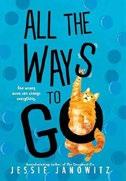
A New York City boy whose stress over winning chess matches takes him out of the zone intentionally throws an important match—but losing a chess camp scholarship as a result changes his world. Milo and his mom end up spending the summer in Princeton, New Jersey, with a girl named Roxie, her philosophy professor mother, Nava, and their cats. The two women met through an online group for single moms; both used sperm donors to conceive. Milo, 12, and Roxie, 10, attend a day camp that’s filled with younger children, but fortunately, the two are designated counselors-in-training. After the kids meet some grad students who are playing Go, they become intrigued by the complex Asian strategy game. Obsessed, they visit a university library to do research (“free-range” Roxie shows Milo how to sneak in at night after hours) and persuade the counselors to let them teach simplified Go to the campers. Milo, who’s longing for his grandma and best friend Henry, and Roxie, who’s very intelligent but struggles with social cues, grow closer, devote themselves to Go, and figure out various personal issues. Milo’s humorous first-person narration focuses on the philosophical intricacies of Go and his growing relationship with Roxie. Comical interludes show texts between Milo and his grandmother
and Henry. Milo and his mom present as Ashkenazi Jews; Roxie and Nava are Persian Jews. A sweet story about friendship between an unlikely pair and the intrigue of an ancient strategy game. (author’s note, information about Go, resources) (Fiction. 8-12)
Jokinen, Jack | Illus. by Wendy Tan
Sourcebooks eXplore (40 pp.)
$14.99 | Sept. 3, 2024 | 9781728283920

An accidental open door leads to a second chance during the holiday season. Jokinen draws from an actual event that went viral in 2019. A nameless dog—who, we’re told, “would soon be called Suzy”—wanders the streets during a snowstorm. She sees a door blown open by the wind. She enters the warm, inviting home and cozies up on the rug to sleep. The next morning, the family is in for a surprise! Suzy meets humans Emily and Jack—and, perhaps the most important heart to win over, George, the family’s dog. Each time she meets a new face, she silently watches, wondering if they will like her. A quick, impulsive kiss on George’s nose cements their friendship. Though Emily and Jack have a one-month-old baby, they don’t hesitate to take Suzy in; she’s here to stay. Tan’s art is a bit static but full of bright, Christmassy reds and greens, along with a golden warmth that glows almost as brightly as the family’s generosity and love.
This is a touching story of an unexpected gift who wandered in and found a forever home. An author’s note includes photos of Suzy and the Jokinen family, offers more context for the real-life story, and urges readers to adopt a pet in need rather than purchasing one. The family presents white. A heartwarming reminder to adopt, not shop. (Picture book. 3-6)
Kalla, Siski | Clavis (32 pp.) | $19.95 Aug. 6, 2024 | 9798890630902

A young boy bonds with an atypical dog. Sammy is a dog expert; he knows what ALL dogs like! When his family finally welcomes a dog into their home, he thinks he knows just what to do. But Gertie, a floppy-eared, brownish-gray canine of medium size, doesn’t seem interested in anything Sammy offers. She doesn’t chase balls or enjoy playing with other pooches at the dog park. When Gertie gets up and leaves after Sammy attempts to cuddle with her, Sammy apologizes and just sits quietly with her for a while as he reflects on times when he’s felt uncomfortable. After a while, when Gertie makes clear that she’s ready, Sammy builds her a cozy hideout and introduces her to different activities so she can choose which she prefers— she especially likes listening to Sammy read. Now Sammy loves being a Gertie expert! Though great for dog lovers, this book is also an excellent way to help kids consider differences. Many neurodivergent children will see themselves in Gertie—and even in Sammy. Kalla balances text and images well; her well-chosen words provide helpful context for the visuals. With thick, sketchy outlines and wonderfully patterned detailing, the watercolorlike illustrations are just precious. Sammy has tan skin and brown hair.
Comforting and endearing in equal measure. (Picture book. 4-8)
Kapit, Sarah | Illus. by Genevieve Kote Henry Holt (128 pp.) | $17.99 | Sept. 3, 2024 9781250881090 | Series: Rachel Friedman, 2

Spirited young Rachel is back for her second outing, and she’s determined to have “the best Hanukkah ever.”
After a new classmate dismisses her
Hanukkah traditions in favor of Christmas, Rachel and her best friend, Maya, create a list of “eight super-fun things to do” for the Jewish holiday. But her plans for her favorite holiday immediately go awry. Maya gets sick, Rachel’s brother, Aaron, acts too grown up for fun Hanukkah activities such as building a LEGO menorah, and her dad forgets the potatoes for latkes! As this low-stakes farce unfolds, Rachel confronts increasingly aggravating obstacles to the Hanukkah of her dreams. But after several mishaps culminate in Aaron breaking his leg, her previously aloof brother articulates what’s really behind Rachel’s whirlwind of activity: She feels left out by society’s focus on Christmas. Kote’s sprightly black-and-white illustrations depict Rachel as pale-skinned with curly dark hair; her appealingly expressive face conveys her big emotions. As in the first book, the show belongs to Rachel, who remains the most fully developed character; Aaron receives more depth in this outing, while Rachel’s father and Maya recede into the background. In the artwork, Maya is dark-skinned.
A pleasant follow-up for fans of this spunky heroine, and one that may resonate with readers who don’t celebrate Christmas. (Fiction. 6-9)
Killick, Jennifer | Delacorte (240 pp.)
$17.99 | Sept. 17, 2024 | 9780593896990
Series: Creatures & Teachers, 2
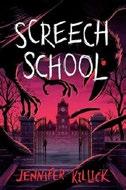
In this follow-up to Dread Detention (2023), a group of middle schoolers find themselves pitted against more terrifying creatures. Angelo and his friends Hallie, Naira, and Gustav hope they’ve seen the last of the Latchitts, an elderly couple formerly employed by their school. Angered because the kids had mistreated their granddaughter, Colette, the Latchitts sought revenge, using nursery rhymes to orchestrate attacks by large and horrifying creatures. The couple have since disappeared, and Angelo and company have even made amends with—and befriended— Colette. But ominous flocks of birds begin appearing; seven particularly large, bloodthirsty ones nearly kill Angelo’s favorite pig, Klaus. The much-anticipated school dance is approaching, but first, the school is hosting a sports day. With the entire student body outside, it’s the perfect situation for an attack—and that’s only the beginning. The characters are well developed and believable as they deal with big life situations in different ways; jokey Gus opens up to his friends about wearing a colostomy bag, while Angelo’s family struggles with poverty. Killick has a knack for funny dialogue that’s well placed between hair-raising situations, creating an irresistibly compelling story, and the birds in this tale are even creepier than the spiders in the last; things get downright gory. Because those unfamiliar with the first book may have a harder time keeping up, reading in order is recommended. Characters’ races and ethnicities aren’t mentioned.
A great balance of humor, heart, and horror. (Horror. 10-14)
Big Jim Begins is the 13th installment in the series of graphic novels.
Dav Pilkey is bringing Dog Man back for a 13th adventure.
Scholastic will publish Pilkey’s Big Jim Begins
later this year, the press announced in a news release. It will be the latest installment of the author and illustrator’s graphic novel series about a part-canine, part-human police officer who fights crime in his hometown.
Pilkey’s series began in 2016 with Dog Man, which introduced the crime-fighting pup to young readers. Other books in the series include A Tale of Two Kitties, Lord of the Fleas, For Whom the Ball Rolls, and, most recently, The Scarlet Shedder.
An animated film based on the first book, directed by Peter Hastings, is scheduled for release in January 2025.
Big Jim Begins, Scholastic says, “explores the origin story of Pilkey’s beloved Dog Man characters,” including

the titular creature, a cat with a cupcake addiction.
“With this new book, I wanted to share the origin story of my characters, as readers get to know more about Big Jim—a character who is playful, kind, overly optimistic and often misunderstood, and who sometimes gets into trouble despite having the best intentions,” Pilkey said in a statement.
Dec. 3.—M.S.

For reviews of the Dog Man books, visit Kirkus online.


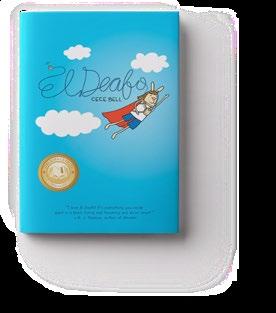


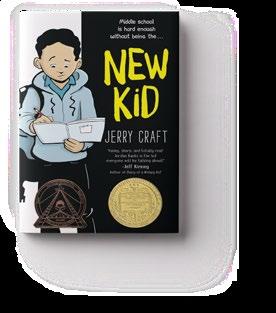
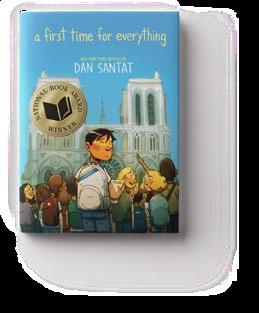

Kleinrock, Liz & Caroline Kusin Pritchard Illus. by Iris Gottlieb | Harper/ HarperCollins (128 pp.) | $19.99
Sept. 24, 2024 | 9780063285712

This wide-ranging collection of short biographies highlights 36 Jewish figures from around the globe and across centuries. Explicitly pushing back against homogenous depictions of Jewish people, the authors demonstrate the ethnic, racial, and gender diversity of Jews. Each spread includes a brief biography paired with a stylized portrait reminiscent of those in Elena Favilli and Francesca Cavallo’s Good Night Stories for Rebel Girls (2016). A pull quote or sidebar accompanies each subject; sidebars include “Highlighting Jewish Paralympic Athletes,” “Jewish Stringed Music,” and “Ethiopian Jews in Israel.” Kleinrock and Pritchard’s roster of subjects makes a compelling case for the vastness and variety of Jewish experience—from a contemporary Ethiopian American teen to a 16th-century Portuguese philanthropist—while still allowing them to acknowledge better-known figures. The entry on Raquel Montoya-Lewis, an associate justice of the Washington Supreme Court and an enrolled member of the Pueblo Isleta Indian tribe, discusses her mission to reimagine criminal justice for Indigenous people; the sidebar name-checks Ruth Bader Ginsburg and Elena Kagan. The bios are organized around themes of Jewish principles such as Pikuach Nefesh (translated from the Hebrew as “to save a life”) and Adam Yachid (translated as the “unique value of every person”); each section includes an introduction to an organization that centers diverse Jewish experiences.
A celebration of progressive Judaism and an inclusive primer on Jews making a difference in the world. (resources) (Nonfiction. 8-12)
An Out-of-This-World
Klostermann, Penny Parker | Illus. by Estrela Lourenço | Godwin Books (32 pp.)
$18.99 | Sept. 3, 2024 | 9781250870308
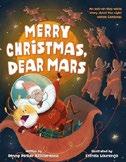
Sa nta finally visits Mars in an intergalactic twist on Clement C. Moore’s “A Visit From St. Nicholas.” One young Martian is filled with excitement on Christmas Eve. Could this be the year that the red planet finally gets a visit from Santa? After going to bed, the little Martian is soon awakened by a clamor that could only be Santa himself. Disaster strikes when Santa’s sleigh begins to malfunction and crash-lands on the surface of Mars. The Martian must summon the Outer Space Rescue Division for help: “Come Hubble and Gamma! / Come Barlow and Oort! / Come Kelvin and Nova! / Come Quasar and Vort!” Using an array of tools and blueprints, technicians rush to the rescue, checking everything from the cockpit to the cocoa dispenser. After Santa and the technicians have put things right, a relieved Santa goes on his way—full of cookies and polar-ice juice—but not before filling the stockings of the snoozing Martians. Playful, bouncy rhyming couplets are modeled after the original poem, with familiar themes sprinkled throughout and plenty of gadgets and gizmos for aspiring engineers and outer-space lovers
Poets weigh in on childhood faux pas that still haunt them.
alike. Dynamic illustrations convey movement and excitement in muted tones, with tons of fun, extraterrestrial details to spot. Martians have fuzzy, round heads like cotton balls, with large eyes, fluffy tails, and colorful antennae. Santa is tan-skinned. A fresh, interstellar Christmas adventure that’s sure to be a read-aloud staple for the season. (Picture book. 3-7)
Koffsky, Ann Diament | Illus. by Abigail Rajunov | Little Bee Books (32 pp.) | $18.99
Sept. 10, 2024 | 9781499816099

From the moment young Estee Ackerman picked up a Ping-Pong paddle, she fell in love with the game. Estee started winning against her family and then entered tournaments, but never on Saturdays, the Jewish Shabbat, a day of rest. At age 11, in 2013, she qualified for the finals at the U.S. National Table Tennis Championships. But when she realized she was scheduled to play on a Saturday, Estee decided that she’d follow the tradition of not working or playing athletic games on Shabbat. “She was sad she had missed the chance at a gold medal. But she knew she had made the choice that was right for her.” When a reporter wrote about her dilemma, other articles followed, and many supported her difficult decision. Luckily, next year, finals were scheduled for a Monday, and Estee won! The straightforward text highlights Estee’s skill and independence. Those with religious ideals will most appreciate this book, but other thoughtful readers will understand the importance of Estee making up her own mind, especially when her family says, “It’s up to you, Estee.” The illustrations have an action-oriented cartoon quality and incorporate onomatopoeic Ping-Pong ball sounds. Filled with swirling stars, the Shabbat
scenes shine with familial warmth. Estee’s family is light-skinned, and her dad and brother wear yarmulkes. Backmatter notes that Estee is currently enrolled in Yeshiva University and training in the hopes of joining the U.S. Olympic Table Tennis Team. A noteworthy tale of a young Jewish athlete taking a personal stand. (in Estee’s own words) (Informational picture book. 6-8)
Konczak, Joanna | Illus. by Ewa PoklewskaKoziełło | Trans. by Kate Webster NorthSouth (184 pp.) | $27.95 Sept. 10, 2024 | 9780735845701
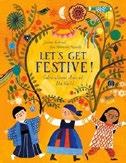
It’s time to celebrate!
Grouped by themes such as “Welcoming the New Year,” “Celebrations of Nature,” “For the Dead,” and “Carnivals,” this treasure trove, translated from Polish, provides information about customs, costumes and masks, foods, and stories and will inspire schools, libraries, and communities to learn more. Additional resources will be needed (cookbooks with holiday recipes, photographs of clothing and masks, picture books retelling the legends mentioned, and, of course, memories from those who celebrate these holidays), but this is a wonderful, albeit dense, starting point. It should be used section by section, like a reference book, when readers want to know more about a particular holiday. (Unfortunately, it lacks an index and bibliography.) Europe (especially Eastern Europe, home of the author and illustrator) and Asia receive somewhat more coverage than other regions, but the book is nevertheless inclusive; it examines Juneteenth—which was recently made a federal U.S. holiday—Pride Month, and South Africa’s Youth Day, which has since become known as the Day of
the African Child. Important celebrations from major religions are featured, among them Diwali, Ramadan and Eid al-Fitr, and St. Jordan’s Day. Readers will find plenty of noteworthy and useful material, accompanied by stylized, vivid, folk art–esque illustrations.
A jam-packed compendium of holiday information. (Nonfiction. 7-12)
Larsen, Mylisa | Clarion/ HarperCollins (240 pp.) | $18.99 Sept. 17, 2024 | 9780063324664

Fourteen-year-old Quentin “Quagmire” Tiarello takes care of his mother, who has undiagnosed bipolar disorder. Sometimes his mom disappears for a couple of days. While he waits for her to return after “a spin,” Quag, who presents white, tries to survive on his own, even if that means scavenging from a pizza parlor’s dumpster. He already knows that her illness must remain secret, so he avoids the nosy neighbor and keeps to himself. But after his crush, Cassie, invites him to join her and her friends at the YMCA’s ArtCamp, Quag signs on to operate the soundboard for their radio play. Eventually, though, his mom shows up outside the Y, and Quag is taken for a wild ride: She whisks him far away from their home in central New York, leaving his friends in the dark. Quag realizes, though, that he can’t keep his mother safe anymore. After seeking help from his uncle, Quag must decide whether or not to open up to his friends. The novel realistically and empathetically addresses struggles around mental illness: Quag takes on heavy adult responsibilities with intelligence and compassion, and, despite his mother’s
abandonment of him, readers understand Quag’s love for her as he recounts her more resilient and caring moments. Short passages about birds interspersed throughout the narrative reflect Quag’s personal growth. Readers will find themselves emotionally invested in this journey. An original narrative voice filled with humor and poignant truth telling. (author’s note with resources) (Fiction. 10-14)
Ed. by Irene Latham & Charles Waters Illus. by Mercè López | Carolrhoda (40 pp.) $18.99 | Oct. 1, 2024 | 9781728492100

Poets weigh in on childhood boo-boos and faux pas that still haunt them.
“My mother used to tell me, / ‘Think before you do.’ / I wish I would have stopped and thought / before I used the glue.” If readers are more disquieted than soothed by the notion that they, too, may wind up agonizing over flubs years, even decades, later, most of the poets at least try to point to positive life lessons learned. Not that they’re always convincing: Allan Wolf, for instance, claims that he learned to forgive himself for a soccer own goal he nonetheless still remembers scoring in fourth grade, and Tabatha Yeatts’ memories of performing well on a summer camp stage despite blowing off the rehearsals comes off as more of a humblebrag. Still, Linda Sue Park’s embarrassment at mispronouncing a word in class, and Jaime Adoff’s for insisting on pitching when he could barely get a baseball to the plate, had salutary results on their respective self-images, while Margarita Engle learned the value of thinking for herself after cutting off her braids at a schoolmate’s suggestion, as did Kim Rogers (Wichita) after playing the role of a white settler in an Oklahoma
Land Run Day celebration. López reflects the multiracial cast of the contributors in her bright and energetic views of young people amid diverse family or other groups. Comforting reminders that nobody’s perfect, infused with lessons large and small. (about the poets) (Picture book poetry. 6-9)
LeBox, Annette | Illus. by Crystal Smith | Groundwood (32 pp.) | $19.99 Sept. 3, 2024 | 9781773069357

A celebration of the Wood Wide Web that connects an aspen grove with its forest community. LeBox explains how an aspen sprouts “children” from “her” roots. The entire stand is actually one organism, which has “lively conversations” with other types of trees thanks to an underground mycelial network that consumes, stores, and shares water and sugars as conditions and needs change. Meanwhile, as depicted by Smith’s lush and lovely digitally painted woodscapes, the forest also shelters and feeds a host of wildlife from bears to butterflies. Mushrooms grow in profusion, and aspen leaves turn golden, all in their proper seasons; a longer cycle completes itself at last when the Mother Tree “takes her last breath,” falling in a storm to become a decomposing nurse log. Though the book ramps up the anthropomorphism, it’s nevertheless an enticing introduction. In her afterword, the author decries the obliteration of complex forest ecosystems by commercial lumber interests and pays tribute to the work of naturalist Suzanne Simard in discovering many of these subtle, hidden natural connections. She also supplies useful lists of print and video resources for readers drawn by the
glowing art and prose to dig further into the subject.
Lyrical and intriguing, if heavy-handed on the personification. (Informational picture book. 6-9)
Lee, Lori M. | Rick Riordan Presents/ Disney (432 pp.) | $17.99 | Sept. 10, 2024 9781368083416 | Series: Pahua Moua, 2

In this follow-up to Pahua and the Soul Stealer (2021), all that stands between the world and destruction is one (prospective) shaman warrior. After inadvertently breaking one of the seals that’s imprisoning angry thunder god Xov, Pahua Moua knows that she needs to repair it—after all, she’s the reincarnation of the hero Shee Yee. But Pahua is not quite 12, and though she’s received an invitation to tour the School for Shamanic Arts and Spiritual Mastery, she isn’t a shaman warrior yet. She hasn’t even been officially accepted. Pahua decides that repairing the seal can also serve as her hero’s quest and secure her place at the school. Along with sarcastic cat spirit Miv and her new friend, shaman warrior Zhong, Pahua journeys through familiar lands and into new ones and comes face to face with dragons. Completing her quest will require allies, sacrifice, and an exploration of her relationships with her family members and Zhong.
Pahua’s signature humor and confidence shine through, even as she grapples with being in Shee Yee’s
shadow, the consequences of a past life she doesn’t even remember, and the impact of her own actions. Steeped in Hmong mythology and brimming with Hmong American culture, this strong sequel leaves room for more adventures to come. A wonderful balance of adventure, wit, and tough decisions. (glossary, author’s note) (Fantasy. 8-12)
Lemon, J.S. | Farrar, Straus and Giroux (208 pp.) | $17.99
Sept. 10, 2024 | 9780374392178

Middle school is a time of change for everyone, but especially for Greta, who undergoes a major transformation. Everything feels different in seventh grade. Greta Goodwin’s classmates seem obsessed with their developing bodies and having boyfriends. Meanwhile, Greta’s dreading an upcoming move to a new house that’s farther away from her best friend, Lotti Messina. When a boy named Derek invites Greta to a party, she’s excited about the attention but nervous about what the experience will entail. When Lotti quickly pairs off with a different boy, Greta is left alone with Derek, and everything turns sour. In the aftermath, Greta doesn’t feel right in her body, but then she starts to transform, shedding her skin and turning orange…and that’s just the beginning. At first, the experience is scary and embarrassing, but she gradually begins to feel powerful, beautiful, and at ease with herself. This
A wonderful balance of adventure, wit, and tough decisions.
PAHUA AND THE DRAGON’S SECRET
peculiar tale is a pitch-perfect encapsulation of middle school. Lemon demonstrates a deep understanding of the richness and intensity of adolescent friendship. The narrative is ripe for discussion; its unique direction might be too mind-boggling for some, but for others it will land perfectly and resonate deeply. Sexual assault is sensitively handled, and the backmatter offers further guidance. Most characters appear white.
Friendship, healing, and being at peace with one’s self are at the heart of this moving and original story. (Fiction. 10-14)
Lewis, Aura with Farai Simoyi | Illus. by Aura Lewis | Beach Lane/Simon & Schuster (40 pp.)
$18.99 | Aug. 13, 2024 | 9781665918299

During a period of segregation, Black fashion icon and designer Zelda Wynn Valdes (19012001) revolutionized the industry.
As a girl, Zelda loved the “soothing hum” of her grandmother’s sewing machine. She caught the fashion bug early, surprising her grandmother with a beautiful dress she’d designed and sewn by herself. To fulfill her passion, she first worked in her uncle’s dress shop mending and stitching while designing dresses on the side. Her dresses became so popular that she opened “the first Black-owned” boutique in New York City; she served “women of all colors, shapes, and sizes.” As a Black woman, however, Zelda was “cut right out of haute couture” due to racism and sexism. But she persisted by working hard, and she eventually made dresses for celebrities such as Aretha Franklin, Josephine Baker, and Ella Fitzgerald. She designed costumes for the Dance Theatre of Harlem and transformed the field by dyeing ballerinas’ tights to match their skin colors, bringing “a rainbow to the stage.” Zelda mentored other Black
artists who wanted to work in fashion, always keeping in mind her dream of “making people beautiful.” Lewis’ cheerful illustrations evoke vintage fashion magazines, chock-full of sketches of bold patterned dresses. In a graceful touch, retro-style endpapers match dresses on both Zelda and her grandmother; one of the patterns also serves as the background for a spread splayed with magazine accolades (“Show Stopping!”) that Zelda received.
An upbeat, inspiring biography of a gifted and forward-thinking designer. (more about Zelda, sources) (Picture-book biography. 4-8)
Lloyd, Natalie | Scholastic (368 pp.)
$17.99 | Sept. 3, 2024 | 9781338858600

New friends help each other find their missing loved ones. After an embarrassing incident at the pool, Roxie Darling is dreading sixth grade. Granny, who’s a folk singer, offered to take her on tour, suggesting she do virtual school, but then Granny seemingly took off without her, leaving Roxie devastated. Meanwhile, Grayson Patch, who uses a walker because of her brittle bones, is perfectly happy to have a new foster home for the two days until her beloved sister, Beanie, turns 18 and can become her guardian. But Beanie doesn’t pick her up as planned and stops responding to messages. Assisted by the rest of their self-declared group of misfits in Club Yeehaw, the girls team up to find the missing “heart person” they each long for, even as a local meteorological phenomenon known as the Witching Wind comes howling down from the hills. Roxie and Grayson, who are cued white, burst to exuberant life in this warmhearted story. The members of the racially diverse supporting cast at times feel too idealized to be real, relatable people. Fans of fabulism will
embrace the wild winds and the town legends about their origin, while realistic fiction devotees will appreciate the naturally developing friendships, strong family bonds, and straightforward portrayals of bullying, foster care, dementia, and rural life. A powerful paean to human connection with a dash of magic. (Fiction. 8-12)
Mahoney, Kristi | Illus. by Chantelle Thorne & Burgen Thorne | Gnome Road Publishing (32 pp.) | $18.99 Sept. 3, 2024 | 9781957655284
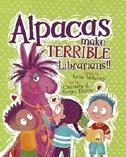
A cloven-hoofed librarian can’t be too bad…right?
A pinkish-purple-haired, blue-lidded alpaca has suddenly and inexplicably taken over the library. Alpacas may be soft and cuddly, but as the narrator (and title) warns, “Alpacas make TERRIBLE librarians!” They make distracting sounds, and their angry noises (“AHHH HEEE HAWWW HEEE”) are even louder than their calm ones (“Cluck cluck cluck cluck hum hum hum hum”). Alpacas love to host storytime outside (“If there’s one thing this librarian loves, it’s grass”), but if you need to use the bathroom once you’re out there, the alpaca will direct you to the “communal dung pile.” Most importantly, don’t try to check out a book about a llama—the alpaca will get very upset, and a slobbery reprimand might come flying your way. Packed with alpaca facts, the cheeky narrative might also start a discussion on censorship with young readers (the alpaca tosses out all books about other animals). Bright illustrations and energetic text placement, with tilted angles and bold-faced words, add to the chaos the alpaca brings. The younger, human library enthusiasts are a diverse bunch. Raucous storytime fun.
(Picture book. 4-7)
Marwan, Zahra | Feiwel & Friends (40 pp.)
$19.99 | Sept. 17, 2024 | 9781250859631

Weary of city life, Vincent van Gogh retreats to the country to paint vibrant images of nature while waiting for fellow artist Paul Gauguin to join him.
“Refined” Paris regards Van Gogh’s cherished sunflower paintings as “inelegant.” After meeting Gauguin, an artist who’s equally committed to vivid hues and floral motifs, Van Gogh departs for the famed “yellow house,” where he’s inspired to paint “brighter and more colorful” art. He waits for Gauguin’s eventual arrival; the book culminates in a lush image of the two friends trekking through a golden Van Gogh–esque wheat field. The narrative contains enough information, explanation, and artistic examples to serve as a satisfying introduction to the painter for younger readers, but, as Marwan makes clear in an affectionate author’s note, the heart of the book is Van Gogh’s waiting and preparing for Gauguin’s arrival. Readers may not be as invested. The relationship between the artists feels underdeveloped, which weakens the anticipation, and the many pages devoted to waiting drag. Within the short, sincere narrative, poignant paragraphs describe colorful canvases. Yet some generic lines of text feel like filler. Marwan’s illustrations, rendered in watercolor, ink, pen, and pencil, are also unbalanced. An image of the two artists ensconced in a color wheel is brilliantly designed, as are bold, sumptuous sunflower homages.
Other spreads feel curiously washed out and insubstantial. An earnest but uneven account of an artist whose talent blossomed like his beloved sunflowers. (Informational picture book. 4-9)
Matula, Christina & Erica Lyons
Illus. by Tracy Subisak | Quill Tree Books/ HarperCollins (32 pp.) | $19.99
Sept. 10, 2024 | 9780063254718

A family observes two autumn holidays in this multicultural celebration. Ruby’s family is preparing for the Mid-Autumn Festival and Sukkot. Ruby and Nainai go to the Chinese market to buy fresh fruit, flowers, lanterns, and mooncakes filled with lotus seed paste and sweet red bean. Then Ruby and Zayde go to the Jewish grocer for fruits mentioned in the Torah such as figs and dates, plus the four species used in a Sukkot ritual. The family builds a sukkah, a hut made of plywood and evergreen branches, and decorates it with lanterns, including one that represents the jade rabbit from the Mid-Autumn Festival legend. Next, Ruby comes up with a perfect plan to combine both holidays: whipping up mooncakes that incorporate the traditional flavors of Sukkot and are festooned with Stars of David. The recipe is included at the book’s conclusion. While the mooncakes bake, the family briefly shares the stories of both holidays, which often occur simultaneously due to the lunar
Here’s a party kids would be happy to attend—and a book they’ll want to return to.
MATTHEW’S
BIRTHDAY PARTY
calendar. The colorful digital illustrations include Chinese brushwork—a lovely touch. The authors and illustrator effectively convey the fundamentals of both holidays to newcomers while also providing readers of Chinese and Jewish descent with a wonderful mirror that reflects their experiences. A much-needed exploration of the intersection of two significant Chinese and Jewish holidays. (authors’ and illustrator’s notes, information on the holidays) (Picture book. 4-10)
Mena, Pato | Trans. by Cecilia Ross NubeOcho (48 pp.) | $17.99 | Sept. 17, 2024
9788410074187 | Series: Somos8

A father and child make an imaginative trek to a party. Daddy is walking Sophia to Matthew’s birthday party. On the way, Sophia poses fanciful questions about how they might get there if they were various creatures. What if they were cats, frogs, magpies, rhinoceroses, aliens, ghosts, or witches? Daddy, not missing a beat, responds with creative, humorous answers—and in delightful, rollicking rhyme, no less—while the comical, bulgy-eyed illustrations simultaneously depict the pair in these guises. It’s a good thing the duo’s walk to the party apparently takes a while, allowing each inspired adventure to play out to its “logical” conclusion. Sophia and Daddy—unseen in human form until this point—finally arrive at their destination and are warmly greeted by Matthew and a caregiver. After receiving Daddy and Sophia’s gift, Matthew asks Sophia in to play. In an amusing final twist, Matthew invites the rest of the “guys” to join them. This refreshingly funny and thought-provoking tale, translated from Spanish, will make a wonderful read-aloud at birthday parties. Children will have a ball pondering Sophia’s quirky queries, devising “what-if?” scenarios of their own and
coming up with answers (rhymes not required). Daddy and brown-haired Sophia are pale-skinned; the party hosts are tan-skinned.
Here’s a party kids would be happy to attend—and a book they’ll want to return to. (Picture book. 4-7)
(32 pp.) | $19.99 Sept. 17, 2024 | 9781250867438

In actor Mendes’ debut picture book, an anxious young sleeper learns to overcome scary nighttime thoughts with help from Mami. A cry shatters the peaceful night. “MAMI! There’s a monster under my bed!” Mami rushes to Desi’s room, where no monsters await. Instead, worries plague the young girl. Is Desi’s brain the real monster? Mami quells those fears. After all, the brain holds many jobs (“learning new things, solving problems”), but sometimes it brings unwanted thoughts, almost like a bully. With encouragement from her mom, Desi realizes that she’s the boss of her rogue mind. She can try to separate herself from pushy thoughts to feel calm; she can even blow negative thoughts away with the might of positive ones. It just takes a little patience. Brava! Perhaps bedtime isn’t so scary. Mendes tackles the delicate matter of nighttime woes—familiar to children and adults alike—with compassion, framing her tale as a discussion between mother and daughter. The often clunky text disrupts the otherwise serene tone. Still, though the advice is a bit pat, many readers will find it useful. Rich with purples, blues, and pinks among
interludes of puffy white clouds, Bryant’s pitch-perfect artwork serves the text well; Desi’s anthropomorphic brain, clad in a nightcap, is an especially fun addition. Desi and Mami read Latine. Practical, if somewhat fluffy, bedtime guidance, hampered by muddled prose. (Picture book. 3-6)
Méndez, Yamile Saied | Algonquin (336 pp.) $16.99 | Sept. 17, 2024 | 9781643753980

A 12-year-old soccer star contends with joining an all-girls soccer team for the first time. Valeria “Magic” Salomón is used to standing out as both the only girl in the league and the best player on the team in her Utah hometown. But the news that Tía Antonella has passed away in Argentina arrives just as Magic gets her first period and embarrassingly bleeds through her white shorts in front of everyone during a State Cup match. This perfect storm of calamities throws Magic off her game. After they lose, she’s kicked off the team. Worse, her grandfather is the coach; Valeria has been raised by her paternal grandparents (she doesn’t know her birth mother, and her father, who was 17 when she was born, lives in Argentina). Though she knows Abuelo is grieving for his daughter, Valeria still feels betrayed that he’s let the assistant coach cut her, and she’s increasingly frustrated by Abuelo’s emotional distance. When Maxwell, Tía Antonella’s son, joins them in the U.S. and is given her spot on her old team, Magic has had enough. This tough and resilient protagonist is easy to root for as she talks her way onto a girls’
soccer team, despite having missed the tryouts. The narrative and action flow smoothly as Magic nervously navigates friendships with girls on her new team, adjusts to having a coach who prioritizes teamwork over relying on a hotshot, and navigates changing family dynamics at home.
Fast paced and tenderhearted. (Fiction. 9-13)
Méndez, Yamile Saied | Illus. by Sara Palacios | Harper/HarperCollins (40 pp.) $19.99 | Sept. 3, 2024 | 9780063234970

It’s Mami’s first birthday without Grandma Monona.
Sebi and Star want to help Mami have a wonderful day, even though they all miss Monona, who’s recently died. Younger sibling Sebi suggests they make empanadas for Mami while she’s at work, just like Grandma Monona used to do. The kids and Papi crack open the recipe box and get started but are stumped when the recipe reads “a pinch of this” and “a dash of that” and then refers to a mysterious “secret ingredient.” Hoping that a shopping trip will inspire them, they walk to the market. A friendly neighbor calls the empanadas “pockets of love” and explains to Star that every country has its own version of a stuffed-dough comfort food. Even though the form and filling differ, they’re all “filled with love and a taste from home.”
The family members finish their shopping and start cooking, and Mami’s delighted by the homemade empanadas. The family realizes that the secret ingredient was love all along. Cozy illustrations feel like a big hug, full of delicious details such as examples of other cuisines from around the world. The heartwarming tale beautifully depicts how love and tradition can create new memories, even in the face of loss. Sebi and Star, as well as their family and most neighbors, have brown skin and
brown hair; the use of Spanish cues the family as Latine. A celebration of family, culture, and the healing power of homemade empanadas. (author’s note, recipes) (Picture book. 5-9)
Mills, Jean | Pajama Press (240 pp.)
$18.95 | Sept. 10, 2024 | 9781772783223

A young violinist learns to rock out. Flora loves to play tunes for Auntie Flora, her namesake and great-great-aunt, who lives with her family. She also enjoys playing classical music with the Arden String Quartet, where she’s first violin. When retired rock star Theo DeLuca moves to town after the tragic death of his young daughter, his son, Simon, becomes Flora’s classmate. Simon invites her to join him for the local Battle of the Bands competition, and Flora accepts after jamming out to rock music with him. But she finds that this decision creates tension within the quartet, who are also part of the competition. Further adding to her troubles is Auntie Flora’s hospitalization for pneumonia, which is making the younger Flora anxious for her life. All is neatly resolved in the end, perhaps too much so. Flora feels underdeveloped as a character, without enough description beyond her interest in music to make her feel fully dimensional. The secondary characters, including Simon and Auntie Flora, are even less nuanced, generally possessing an attribute or two but not feeling especially realistic. The
narrative voice is generic, and particularly lacking is any meaningful description of playing music; at one point during the rock group’s practice, Flora aligns with the book’s tendency to tell rather than show, describing her experience as, “It’s magical. It’s exciting. It’s amazing.” The ultimate result is a tale that falls flat. Major characters present white. An uninspiring musical journey. (author interview) (Fiction. 8-12)
Moolani Mehra, Namita | Illus. by Beena Mistry | Kids Can (40 pp.) | $21.99 Sept. 3, 2024 | 9781525307355

A child’s world is upended during India’s Partition. Veena loves her family’s kitchen, a place “full of warmth and words.” She especially adores the buttery, round rotis that the women in her family make using local grains. She practices, and although her first attempts are misshapen, she’s soon able to make perfectly round rotis. Everything changes when India wins its independence from Great Britain and is subsequently partitioned into two countries—India and Pakistan— divided along religious lines. While many believe nothing will change, her father presciently declares, “India will no longer be the same.” Sure enough, Veena and her family are forced to flee their home in the middle of the night. They end up in a refugee camp, where they eat strangely hard, red rotis. Veena heads to the camp kitchen, where she finds a sense of belonging as she makes
A moving celebration of cultural and personal resilience.
VEENA AND THE RED ROTI
rotis. When Veena and her family finally relocate to Delhi, India, she brings her rotis and the memories they hold into a brand-new kitchen and life. Inspired by the author’s grandparents’ experiences, this picture book provides a tender, optimistic look at one of the subcontinent’s darkest chapters. Though the book includes a map, readers may initially find it unclear whether Veena and her family are crossing into Pakistan or India. Still, the tale has a strong, specific emotional core, enhanced by gentle earth-toned images that leaven the often difficult subject matter.
A moving celebration of cultural and personal resilience. (Picture book. 3-7)
Moore, Clement C. | Illus. by Jane Chapman Sourcebooks Jabberwocky (40 pp.)
$18.99 | Sept. 3, 2024 | 9781464222580

Christmas Eve, replete with adorable animals: What could be more festive? Papa Bear narrates this delightful, all-animal version of Moore’s perennially favorite holiday classic. He and Mama Bear have just settled down with their family for the night on Christmas Eve when a “clatter” outside awakens him. Lo and behold, he sees a “miniature sleigh and eight tiny dog-deer, / With a polar bear driver,” who, in this telling, subs for jolly, red-suited and red-capped St. Nick. In this very cheery adaptation, dogs of different breeds retain the names of the reindeer fleet in the original, so kids familiar with that poem may very well call out their monikers as the book is read aloud. The verse remains the same as in the 19th-century version, except where animal-themed word changes—as noted above—are required to suit these most adorable, child-appealing acrylic illustrations. The artwork depicts not only the pajama-clad bear family and furry pooches adorned with striped antler headbands, but also winsome
FACE IS A POEM
mice, owls, cats, foxes, raccoons, a hedgehog, and a squirrel or two. The bears have decorated their home for the holiday colorfully, and the cubs have bedded down cozily with their stuffed toys. This is a sweet, endearing way to introduce young children to Moore’s Christmas poem.
A Christmas charmer worth making room for. (the origins of “’Twas the Night Before Christmas”) (Picture book. 3-7)
Retold by Moore, Katrina | Illus. by Cornelia Li Trans. by Jaime Chu | Harper/HarperCollins (40 pp.) | $19.99 | Sept. 3, 2024
9780063295803 | Series: Everlasting Tales

Set long ago, “when the Earth was very young,” this story explains the origins of the Chinese moon goddess.
Chang’e is full of love. Her love is returned—by the trees, the animals, the wind, and, most of all, her husband, Hou-Yi. The pair travel together “to protect the people and create caring communities.” One day, 10 scorching suns appear in the sky. With life on Earth on the brink of destruction, Chang’e and Hou-Yi cannot stand by. A formidable archer, Hou-Yi pierces the suns with his arrows until only one remains. In thanks, the heavenly Jade Emperor and his goddess wife, Xiwangmu, give them an elixir that grants them immortality. But there’s only enough for one of them, so the lovers decide to live out the rest of their lives as humans—together. When Peng Meng, Hou Yi’s jealous apprentice, schemes to steal the elixir for himself, Chang’e sacrifices their mortal future together and drinks the elixir
herself. As explained in the author’s note, the legend of Chang’e has many variations. Moore centers her retelling on the couple’s kindhearted qualities and their enduring love. As moon goddess, Chang’e watches over the Earth for all eternity. Hou-Yi spends the rest of his living days devoted to honoring Chang’e and their shared passion of community care, and the story of her sacrifice sparks a celebration in her honor: the Mid-Autumn Festival. Li’s painterly illustrations beautifully capture Moore’s text. A lovely retelling. (Mandarin version of the tale) (Picture book. 4-8)
Morstad, Julie | Tundra Books (48 pp.) $18.99 | Sept. 24, 2024 | 9780735267565

An ode to the visage.
“Have you ever stopped and looked, / really looked… / at a face?” This spacious text offers many opportunities. Various human and a few nonhuman faces with different skin tones, shapes, and features are splayed across the pages in black and white and in color. Some look out head-on; others are sideways or tilted back. The faces are portrayed in crowds and alone, talking and silent, boxed in and expansive, even scattered across the stars. Morstad’s whimsical art evokes cubism and surrealism, while her spare narration poses questions and muses in aphorisms. “A face is a poem / with all the parts put together, / adding up to someone / you love.” Each face presents a character, and Morstad has taken care to depict a diversity of ages and identities. This poetic
exploration unfolds in a loving and inventive way, inviting thoughtful appreciation and conversation. Vibrant depictions of flowers and butterflies add elegant texture, underlining the idea that faces are part of a larger, wondrous world. A full-bleed spread showing dozens of kids with different expressions in auditorium-style seating feels particularly vivid. The final illustration, depicting adults kissing a baby, all with warm, richly rendered complexions, ends the journey of discovery on an intimate note. Certain to speak to young hearts and minds. (Picture book. 2-6)
Nesbet, Anne | Candlewick (256 pp.)
$18.99 | Sept. 10, 2024 | 9781536234725
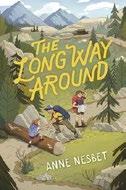
A family camping trip in the mountains turns interesting after an earthquake. Eleven-yearold Vivian is so excited to be going camping with her 12-yearold cousin, Owen, and her 8-year-old sister, Amy. She’s talked her mother and Uncle Mike (both veterans of the outdoors) into camping at Sequoia National Park and, what’s more, letting the kids stay by themselves for 24 hours (the adults will camp just over a short mountain pass). Dusk comes, and Owen, who loves to cook, fixes a stellar meal on his little camp stove; the kids are blissful in their independence. Then comes the earthquake, shaking rocks down onto the trail and blocking the way back to the adults. Taking charge of the frightened Amy and disassociating Owen, Vivian determines that their only choice is to walk out the long way. While Owen has packed more food than necessary for one overnight, it’s not enough. Nevertheless, they start out.
This is a tale of adventure and survival, but it’s far from grim; instead, it’s filled with effervescent writing and humorous dialogue. Vivian’s confidence and her joie de vivre in the beauty of her surroundings embrace Amy and Owen—as well as readers—with the usefulness of a positive attitude. If a story about three kids alone in the mountains with little food could ever be described as cheerful and uplifting, this one is it. All main characters read white.
A sparkling tale of survival. (map) (Adventure. 8-12)
Kirkus Star Chronicles of
Ness, Patrick | Illus. by Tim Miller Walker US/Candlewick (208 pp.)
$17.99 | Sept. 3, 2024 | 9781536235937

Some are born great, some achieve greatness, and some have greatness thrust upon them, as this monitor lizard soon learns. Soon after Principal Wombat assures Zeke that she hasn’t selected him to be a hall monitor just because he’s a monitor lizard, he proves fairly inept at the job. He almost immediately punches local bully Pelicarnassus in the beak after a nasty encounter. Unfortunately, Pelicarnassus is the son of a supervillain, and after that fact is revealed, some of the wilder elements of this anthropomorphic school story come to the fore. For instance, because of an ancient family curse, the entire
country of France appeared on Zeke’s knee after the death of his father. Ness clearly has a talent for balancing heart with mind-blowing silliness and whimsy. Such elements combine perfectly when Zeke’s mother, suffering from depression after the passing of Zeke’s father, is followed by a literal black dog at all times. All this is punctuated by Miller’s ink drawings of the characters, perfectly matching Ness’ equally deadpan recounting of the action. Yet in the end, it’s Zeke’s slow growth into a hero that will touch readers’ hearts, gargantuan pelican robot suits and tiny fighter jets notwithstanding. Heart and weirdness in equal measure prove you should never underestimate the power of a lizard! (Fiction. 8-12)
Ohi, Debbie Ridpath | Simon & Schuster (48 pp.) | $18.99 Sept. 17, 2024 | 9781481416306

A precocious young reader has a lot of questions. When Hana wonders where rain comes from, her mom suggests a book that might answer her question. “I’m going to read ALL THE BOOKS,” Hana decides. “That way I’ll be able to answer all the questions.” She begins her task with gusto and quickly devours all her own nonfiction books and all her adventure, funny, and spooky fiction before making her way through her brother Kenji’s books and all the rest in the house: “Mystery books! Self-help books! Romance! Science fiction!” After Hana reads all the books in the neighborhood, her mom takes her to the local library,
where the librarian helps her find as many books as she can read, as quickly as possible—but a visit to the big central library quickly overwhelms the determined patron. If no one can read all the books, what’s the point of reading any? Luckily, Hana’s mom and a wise librarian propose that she share her love of reading with friends and family—and even the scruffy family dog joins in the fun. Accompanied by muted, simple artwork, the straightforward, somewhat preachy story is light on drama or tension, though Hana’s enthusiasm will resonate with young bibliophiles. Hana and her family are brown-skinned with straight dark hair; her community is diverse. Slightly self-congratulatory but sweet encouragement for library patrons. (Picture book. 5-8)
OHora, Zachariah | Tundra Books (48 pp.) $18.99 | Sept. 24, 2024 | 9781774883945
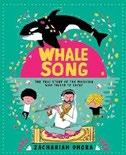
Music touches lives human and otherwise in this true zoo tale from the 1970s.
A jazz flautist named (ironically) Paul Horn meets captive orcas Haida and Chimo at an aquarium on British Columbia’s Victoria Island, along with a scientist, Dr. Paul Spong, who’s been studying the effects of recorded music on the whales. With Dr. Spong’s encouragement, Horn agrees to sit poolside with his two sons and play live. Astonishingly, the marine mammals not only listen attentively, but also respond with calls of their own. Sometime later, after Chimo dies, Horn returns with his children to revive the grieving, failing Haida with dancing and happy tunes. OHora relates the encounters in rhapsodic, occasionally over-the-top tones—“Gorgeous melodies filled the air.” “For a moment, they were all free in a realm
of pure joy”—before concluding with poignant sentiments about the suffering of orcas in captivity and further information about the apex predators, about Horn, and about Spong’s ongoing research. In illustrations “inspired by music on vinyl,” abstract tufts of sound float up from the flute as the orcas swim and splash in claustrophobic surroundings. Chimo’s rare partial albinism is accurately depicted. Human figures are uniformly pink-skinned, but they’re likewise drawn with individualized features. Schmaltzy but affecting.
(Informational picture book. 6-9)
Oso, Maisha | Illus. by Candice Bradley | Orchard/Scholastic (40 pp.) $18.99 | Aug. 6, 2024 | 9781338849974
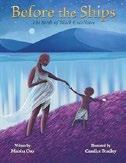
A celebration of Pan-African achievement that spans much of the continent and its pre-colonial history. In this tribute to Africa before the trans-Atlantic slave trade, Bradley relies on vivid digital illustrations to highlight brightly textured indigo seas, lush scenes of regal leaders striking commanding poses as giraffes roam nearby, and warm, high-rising structures of worship. The accompanying narration uses prose and verse to superb effect to establish imagery of emerging civilizations, thriving communities, and wondrous accomplishments. Centering an audience of brown readers, Oso emphasizes that “in Africa, we were royalty, / reigning, ruling entire empires. / Kings and queens of great renown / in shades of brown—just like you.” Bradley imbues each movement with a gentle intimacy, whether depicting great warriors of Carthage and Kush, griots passing
down stories, or youngsters sketching constellations in the sands of the Sahara, “our magical minds uncovering the mysteries of the galaxy.” Oso connects it all to the modern-day diaspora: “Here we stand, after the ships, / as amazing as we’ve always been.” In an author’s note, she emphasizes the importance of learning about the history of Black peoples apart from slavery and colonialism—a subject that far too often goes unacknowledged in textbooks. This enchanting picture book thoughtfully fills that gap.
A beautifully bold dedication to Black greatness. (Picture book. 4-8)
Oso, Maisha | Illus. by London Ladd Harper/HarperCollins (32 pp.) | $19.99 Sept. 17, 2024 | 9780063249103
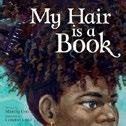
“My hair is a book. / Watch me open it, / part it, / take a look.”
So begins this creative homage to the plethora of bold adjectives, nouns, verbs, and nicknames that people of African descent use to describe their hair and hairstyles—descriptors that also apply to books. Like books, hair conveys histories; like books, Black hair has often come under scrutiny or deemed unacceptable. Oso’s metaphors illustrate how Black hair tells the story of those who wear it; hair announces its wearer’s beauty to the world, be it cornrowed, locked, twisted, or curled. The author also nods cleverly and generously to other Black-authored books: Camille Yarbrough and Carole Byard’s Cornrows (1979), Derrick Barnes and Gordon C. James’ Crown: Ode to the Fresh Cut (2017), Kwame Alexander and Kadir Nelson’s The Undefeated (2019), Grace Byers and Keturah A. Bobo’s I Am Enough (2018), and even Alex Haley’s Roots (1976). Some of Ladd’s
stunning acrylic, cut-paper, and tissue paper collage illustrations depict recognizable historical figures such as Shirley Chisholm, Malcolm X, and Madam C.J. Walker (the first American woman millionaire, who made her fortune on Black hair products), while others portray Black kids, cooks, and athletes, all of whom take pride in their hair despite those who might judge them. The Afro pick on the cover, with a Black Power fist protruding from a girl’s capacious updo, sets this book’s unapologetically pro-Black and celebratory tone.
A stellar work that belongs in every collection serving young people.
(author’s note) (Picture book. 4-8)
Perkins, Mitali | Illus. by Naveen Selvanathan Farrar, Straus and Giroux (40 pp.)
$19.99 | Sept. 17, 2024 | 9780374388980
Series: The Between Books

With the help of her neighbors, a South Asian girl finds meaning in the word namaste It’s a hot day, and Maya is missing her grandfather, who’s in India but who always has ideas to chase away boredom. Maya remembers a question he once asked her: “What’s between your hands when you namaste the world?” Before Maya can think too hard about her answer, her neighbor Mrs. Jones asks for her assistance retrieving her cat from a bush. After helping Mrs. Jones, Maya poses her grandfather’s questions to those she encounters. An artist responds with truth. Maya’s babysitter, returning from a protest, says that there’s justice between her hands. And Maya’s dance teacher, who stops by on her way to serve food at a nearby shelter, replies with mercy. Mrs. Jones periodically interrupts, asking for more help; by story’s end, Maya realizes that between her hands, there is love. And no matter how small Maya’s hands may feel, she knows love gives her plenty of big things to do. Though at times the
text feels preachy, Perkins conveys a meaningful message. She seamlessly interweaves multiple storylines in just a few words, telling a layered tale using simple, child-friendly language, aided by Selvanathan’s vibrant, detailed illustrations, which push the narrative forward. Close-ups of Maya’s diverse friends and neighbors, set against swirling backgrounds, infuse them with a warm glow. Proof that even the smallest hands can wield giant power. (Picture book. 3-6)
Red | Illus. by
Jack Button
Sweet Cherry Publishing (32 pp.)
$16.95 | Sept. 24, 2024 | 9781802634730

Who knew pirates started the tradition of delivering Christmas gifts?
Our tale begins long ago. Nic and Kris, the young Beard twins, sail their pirate ship. Dark-haired, brown-skinned Nic loves stealing and brawling; blond-haired, tan-skinned, kindhearted Kris prefers carving toys. One day, Kris finds a necklace that’s washed up. Determined to have it for himself, Nic snatches the necklace and forces Kris onto the plank. Kris falls overboard, eventually drifting to an icy land, where an elf welcomes him. All the elves who live here have broken sleighs. Kris repairs them and teaches the elves to make toys. Kris happily remains on Elf Island for many years, carving toys and caring for reindeer. Both brothers, still far apart, grow older. At last, sad, friendless Nic, his hair now white, decides to search for his long-lost twin. The brothers reunite, and Nic apologizes. Kris suggests they “sail the skies” together in the pirate ship—hauled by reindeer—and deliver toys the night before what “we now call Christmas.”
The author adds, “The brothers Beard have many names, / like Kris Kringle and Saint Nic,” and challenges readers to guess which brother they’ve seen. This offbeat, thinly plotted origin story, told in bouncy though
occasionally clumsy verse, may leave readers cold, especially those less familiar with the name Kris Kringle. The colorful illustrations are lively but otherwise undistinguished. Still, die-hard pirate fans will likely be pleased. The book includes a QR code that accesses an audio version.
A so-so-yo-ho Christmas offering. (Picture book. 5-8)
$19.99 | Sept. 10, 2024 | 9798765607985

African pouched rats and their Cambodian handlers work together to find hidden land mines left over from a long-ago war.
This story stars Malen, who’s told that land mine discovery is “too difficult” and “not meant for young women.” People say similar things about Magawa, a giant African pouched rat: “too difficult,” “not meant for rats.” Malen, who grew up in Cambodia, where hidden explosives have rendered much of the land unsafe, doesn’t listen.
Neither do the Tanzanians who train Magawa, one of many HeroRATS who have a “smelling superpower”: They can sniff out explosives. After finishing their training, Magawa and other “deminer” rats journey to Cambodia, where they work with Malen and her colleagues. For this book, co-author Riley worked with Meas, a staff member at APOPO, an organization that trains animals to detect land mines. (APOPO is an acronym of its Dutch name.) Lee’s illustrations depict the mine-discovery process: the ropes that demarcate the areas to be searched, as well as the harnessed rats that sniff in an orderly way until they find explosives to be dug up. The focus of this gently told narrative is the search; actual mine clearing happens offstage. Details of the “long war” are left to the backmatter,
which includes a timeline and a map and notes that these clever rats and their brave handlers are searching for American bombs dropped during the Vietnam War, as well as Khmer Rouge mines from the 1970s. Readers will also find background on the real Malen and Magawa here.
An unusual subject, sensitively handled. (authors’ and illustrator’s notes, information on the HeroRATS of APOPO, rat-training instructions, pronunciation guide) (Informational picture book. 6-10)
Rosenstock, Barb | Illus. by Katherine Roy Norton Young Readers (32 pp.)
$18.99 | Sept. 10, 2024 | 9781324016076

From the broken-off tip of a sargassum plant, a whole community grows in the Sargasso Sea. This appealing title illustrates the remarkable variety of “the ocean’s floating golden rainforest,” as marine biologist and oceanographer Sylvia Earle puts it in her afterword. Set on and off the shores of Bermuda, the book depicts racially diverse beachgoers making their own whirlpool as Rosenstock describes the enormous whirling area of the Atlantic Ocean known as the Sargasso Sea, the result of “five currents [swirling] billions of gallons of water clockwise.” Next, she introduces the sargassum, an algae that reproduces by growing anew from broken-off bits. Step by step, the sargassum grows, and other living creatures—crabs, shrimp, swordfish— come. They graze on it, take shelter in it, and feed on smaller inhabitants. Gradually, the population builds up until we see humpback whales and then a happy Black-presenting human swimmer. The author makes clear how interdependent these creatures are and describes the complexity of their world.
This deftly told narrative would be grand fun to read aloud. The creatures are introduced in triplet lines: “Crusty bryozoans / feathery hydroids. / Spiraled tube worms.” Rosenstock’s concise text exudes energy and makes wonderful use of alliteration: “They scavenge. Snatching and shredding.” “Water-striders speed on the surface.” Roy’s gorgeous, watercolorlike illustrations swirl with vibrant hues and would show well to a group. Youngsters will be sucked into this engaging, informative account of a most unusual ecosystem. (map, research note, too much sargassum?, sources) (Informational picture book. 4-8)
Saltzberg, Barney | Neal Porter/ Holiday House (40 pp.) | $18.99 Sept. 10, 2024 | 9780823456390

In this collection of humorous poems, Saltzberg examines the nature of dogginess from nose to tail.
Many of the book’s entries adopt the narrative voice of the dogs themselves. In “My Nose Knows,” a canine describes its renowned sense of smell to its human: “Like when you’re in the kitchen / and I’m sleeping down the hall, / if you eat a little snack / I smell it through the wall.” The poem’s upbeat last lines cleverly explore a familiar doggy trait: “When I meet another dog (you might
think we’re nuts) / the proper way we say hello / is smelling other butts!” Alternate rhyme schemes predominate, as in “Slowing Down,” about an older dog: “She was always exploring outside in the yard. / Now she curls up on the rug. / She has always been cuddly. / Now we have more time to hug.” A solitary haiku, “Haikoodle,” pictures an orange-collared black pooch sitting in an armchair, striking a “Who, me?” air. “Doodle in my chair / There’s no room for me to sit / Bothers me a bit.” The metaphorical description of dog drool in “Slow-Motion Drip” alone makes this work a must-have. Saltzberg’s hilarious spot illustrations deftly contrast simple black line drawings with textures that convey a panoply of fur colors. Small color bursts are reserved for accessories such as collars and chewed socks. A final poem, narrated by “the superior pet,” portends a feline companion volume. Utterly delightful and beautifully designed. (Picture book/poetry. 4-8)
Kirkus Star
San Miguel, Samantha | Union Square Kids (304 pp.) | $17.99 | Sept. 10, 2024 9781454954170 | Series: Spineless, 2

Returning to the late-19th-century world of Spineless (2022), readers join siblings Lulu and Frankie Davenport along with best friend Algie Emsworth as they reunite in Florida for a summer that doesn’t turn out as expected.
Saltzberg examines the nature of dogginess from nose to tail.
Home after a tedious term at boarding school, 12-year-old Lulu can’t wait to go sailing. But 13-year-old Frankie isn’t being great company, their father is distracted, and Algie has gotten a job at the general store to help his family out financially. On top of that, Lulu hears an eerie wailing and is made uneasy by rumors that 200-year-old pirate queen Capt. Ale is haunting the town. When Lulu meets Vic Cazador, a boy her age whose father is a customs officer, things fortunately take an upturn. Vic is blind from a bout of measles two years previously, and as he and Lulu bond over their shared lack of confidence—Vic because his controlling father is overprotective and Lulu because Frankie is so competent—they support each other while learning about their own strengths. The plot is original and surprising, with themes about belief in oneself and sibling rivalry that stay true to the age of the audience; the story also incorporates well-presented ideas about morality, ethics, family, and the frailties of adults. Lulu and Frankie are white and Cuban American; Algie is white, and Vic is Cuban American.
A clever plot, taut writing, and sophisticated emotional themes bring a remarkable depth to this sequel. (author’s note) (Historical adventure. 9-13)
Saxton, K.H. | Union Square Kids (336 pp.) $16.99 | Sept. 17, 2024 | 9781454950158
Series: The A&A Detective Agency, 2

Middle school sleuths Asha Singh and Alex Foster expand their circle and their knowledge of history in this thrilling second series entry. Someone claiming to be “the Witch of Waverly College” is leaving clues for town leaders to find, including one delivered via a rock thrown through a
window with a cryptic note attached. The chairman of the local Fairfleet Institute is given until Halloween to solve the mystery, and he asks the tween detectives (who are well respected from solving a previous case) for their help. Robberies of mausoleums have also occurred at the Willow Grove Cemetery, and all signs connect them to the story of a 1690 witch trial (two years before the famous events in Salem), during which local woman Hannah Grimthorpe was tried and executed. With many of their eccentric mentors unavailable to help, Alex (who reads white) and Asha (who’s Indian American) learn to lean on others as their tightknit friendship, and their detective agency, both grow. With support from their community, basset hound Aggie, and skills learned in middle school, they ultimately solve the case. Rich descriptive language elevates the well-paced plot and immersive setting. The large cast of racially diverse characters engage in smart, punchy dialogue and show moments of sincere accountability and reflection. The story’s deeper themes—including the nature of truth and the questioning of legacies—are rooted in relevant, present-day realities.
A smart, standout mystery that’s cleverly delineated with equal parts charm and care. (binary and Morse code guides) (Mystery. 8-12)
Shepardson, Tina | Illus. by Bong Hyun
Shin | Gnome Road Publishing (32 pp.)
$18.99 | Sept. 17, 2024 | 9781957655307

A girl learns lessons in forgiveness and kindness. Courtney’s next-door neighbor and teacher, Ms. Smith, catches her picking up an apple that fell from Ms. Smith’s tree. Displeased that Courtney didn’t ask permission, Ms. Smith tells
SHARK NIGHT
Courtney’s parents what happened. Courtney’s disappointed in herself; that apple isn’t appetizing anymore. Courtney dreads returning to school. How to make things right? Prepare an apple treat? Write an explanatory letter? Courtney bites into an apple; seeds burst out, giving her an idea. She collects, washes, and wraps the seeds attractively, with a note attached. At school, she presents the package to Ms. Smith, who’s pleased, especially with the “I Am Sorry” note. Ms. Smith concedes that she, too, once took something without asking first and “felt rotten.” She and Courtney agree to plant the seeds together. The final scene shows Courtney planting a bed of “sorry seeds.” The message of the book, narrated by Courtney in first person, is that saying sorry isn’t so hard. Really meaning it isn’t hard, though doing so may initially come at a cost. But admitting things feels good afterward—and the stronger friendships that result are invaluable. Some readers may believe that Ms. Smith overreacted, which might spur discussion. The digital illustrations, created with mixed media, are lively and warm. Courtney is, appropriately, apple-cheeked. She and her parents are light-skinned; Ms. Smith is brown-skinned. Background characters are diverse.
A sweet story that plants good food for thought. (Picture book. 4-7)

Shiga, Jason | Abrams (160 pp.) | $14.99
Aug. 27, 2024 | 9781419757839
Series: Adventuregame Comics, 3

Shiga’s latest in the series is a Choose Your Own Adventure–style tale of vengeance. Following an instructional introduction about how to navigate the winding panels of this graphic novel, readers assume the perspective of an infant in 1798 Nagoya, Japan. The baby’s father tells him to decide between two objects; humorously, both lead to a life devoted to revenge. Years pass, and the young boy must choose whether to train as a samurai like his father or to follow in his mother’s footsteps as a ninja. The protagonist’s upbringing determines which special abilities he’ll possess as he makes his way through Nagoya Castle, where he attempts to steal and then get rid of a bracelet that imbues its wearer with magical powers. Along the way, readers encounter pitfalls and complications. This is a more tricky, cerebral adventure than “hack and slash”–type games. Shiga cleverly allows readers to play through the same scenarios as either a samurai or a ninja; the author/illustrator alternates between gray and green shading to distinguish between the two roles. Different approaches to puzzles, games of chance, and more will have readers racing to unlock all the endings. Shiga’s artwork is minimalist but elegant. Like
previous books in the series, this is a stand-alone adventure that can be enjoyed on its own, but those eager for more should pick up the earlier installments.
With a scenario this engaging, every path is a winner. (Graphic fiction. 8-12)
Smith, Cynthia Leitich | Heartdrum (240 pp.)
$18.99 | Sept. 17, 2024 | 9780062870001

Humans and animals join forces, becoming an unexpected group of heroes working together to save the day. Smith (Muscogee) opens with a Muscogee greeting and reintroduces characters many readers will know from her other books. Great-Grandfather Bat, a well-known ballplayer and revered elder, ponders his injured wing and its impact on the Great Ball Game. Bat catches a ride with Grampa Halfmoon from Chicago to Georgia, heading to a rematch between the Birds and Animals. Young Ray Halfmoon, family friend Melanie, and Gray Squirrel join them. A fascinating circular structure connects the storylines, which contain expertly crafted humorous snippets, and the connection between humans and animal relatives will be evident to readers. Ray, Grampa, and Mel reunite with relatives. Grampa rekindles his connection with a former love interest. Mel faces inner turmoil as she finishes a school assignment while riding along a similar route her ancestors took on the Trail of Tears. When Grampa’s rez truck breaks down, pursuing stalkers add a mysterious twist. The novel also addresses important modern-day issues: Habitat loss, protection of the Earth and its animals, historical truths, and
references to Native children’s literature are cleverly embedded in the story, and secondary characters with admirable careers support Indigenous readers in envisioning their own goals.
A unique and noteworthy tale that weaves together past and present with humor through stellar, multilayered writing. (map, glossary, author’s note) (Modern folklore. 10-14)
Spradlin, Michael P. | McElderry (160 pp.)
$17.99 | $7.99 paper | Sept. 24, 2024 9781665947206 | 9781665947213 paper Series: The Web of the Spider, 1

Tensions rise when a cadre of Hitler Youth arrives in a young student’s Bavarian town. “They stood out like skunks in their brown shirts, black pants, and jackboots.” Rolf is upset to see the deteriorating relationship between his always-angry older brother, Romer, and their widowed father. But he’s more disturbed by evidence that Romer is drifting toward sinister, spiderlike Hans and the squad of uniformed thugs behind him—particularly after the distribution of recruitment leaflets is followed by arson and the beating of a local Jewish merchant as bystanders watch…some approvingly. Matters come to a head when Hitler speaks at a mass rally; Rolf comes away from the experience firm in his conviction that the Nazi takeover must be resisted. This fast-moving, stirring tale is set in 1929, but along with a timeline that begins with Hitler’s birth and ends in 1935, the author intersperses helpful flashbacks about the end of the First World War, the 1923 Beer Hall Putsch, and other events presented as news stories. He also makes explicit the book’s cautionary purpose: “It’s common for us
who live in democracies around the world to say, ‘it can’t happen here,’” he writes in his afterword. “It can.” Clear of stance and cogent of theme. (glossary) (Historical fiction. 11-13)
Stine, R.L. | Blackstone (250 pp.) $16.99 | July 2, 2024 | 9798874712341
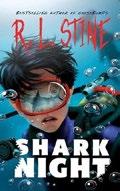
Boy meets shark for the delectation of a TV audience. What could go wrong?
Twelve-year-old Liam Brachman has no intention of being the star of his filmmaker mom’s new shark tank show for the Danger Channel, but when the hired actor suddenly goes down with a last-minute injury, Liam finds himself in the water—facing not the promised harmless hammerhead but a terrifyingly toothy bull shark! That’s only the first in a succession of nasty shocks for Liam that Stine spins out to improbable but entertaining lengths thanks to more all-too-eager filmmakers urging him into a flimsy-looking shark cage, an encounter with a tentacled sea monster, a swim in a piranha lagoon, and the like. Each seemingly inevitable moment of doom leads to one narrow escape after another. For all of this, Liam’s worst nemesis is actually Rosa, his scene-stealing little sister from hell, who chants cutely horrific ditties (“It’s shark time, / It’s shark time, / I can’t wait, I can’t wait / For Liam to be bait…”) while repeatedly showing off a perfectly fiendish gift for getting her big brother into pickles. As it turns out, aside from Liam’s terror, nothing here is quite as it seems— and yet, even though no actual blood is spilled, a final twist suggests that that might not continue to be the case. Main characters present white. A finny frolic to delight younger Goosebumps fans. (Horror. 8-11)
Stringfellow, Lisa | Quill Tree Books/ HarperCollins (224 pp.) | $18.99 Aug. 20, 2024 | 9780063043480
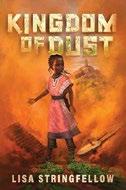
A girl is forced out of her home and into the unknown as she tries to save the kingdom of Kun in this West Africa–inspired fantasy. Twelve-yearold Amara has always felt different—cursed, even. Left as an infant on her mother Zirachi’s doorstep, she only knows her simple farm life in Danel, her village. Sadly, all the land is drying up as the Zare desert expands, spreading famine. Despite their meager crops, Amara, who has a crescent-shaped birthmark on her neck, readies herself for the New Yam Festival, hoping that the creation goddess, Oala, will end the drought. According to Zirachi, Kun used to be filled with lush abundance, and the griots could perform magic to ensure its bounty. No one has seen or heard of the griots in years, however, and none can remember their stories. As Zirachi and Amara return from the festival, the Nkume, or king’s guard, attack them and try to abduct Amara. Forced to flee, Amara searches for the griots, hoping they’ll be able to help her bring Kun back to its glory and unravel the mystery surrounding her birth. The plot revs up quickly, keeping the pages turning. Amara’s journey from village girl to defender of her kingdom is wonderful to follow. Each obstacle she faces adds another layer to her self-realization.
It’s difficult to be different and even harder to be brave, but this book is easy to enjoy.
A delightful fable. (glossary and pronunciation guide) (Fantasy. 8-12)
Strong, Karen | Simon & Schuster (240 pp.) $17.99 | Aug. 20, 2024 | 9781665904506

Af ter moving into her late grandmother’s haunted home, a girl attempts to make friends while hiding her inherited powers as a paranormal medium.
Despite her newfound anxiety over her gift following a near-fatal spectral encounter, Black seventh grader Wednesday Thomas sees and interacts with ghosts every day, everywhere she goes. These spirits include harmless wisp and guide ghosts; she tries to avoid the wicked ones—malevolent, violent shape-shifters who terrorize both the living and the dead. But Wednesday must face her fears when she’s invited to join the top-secret Dead Club at school. She agrees to help new buddies Miki Okada and Danni-Lynn Porter communicate with Violet Delgado, their recently deceased friend, who appeared to them on Halloween, desperate for help. Although she’s warned away from the group by estranged member Alexa Scott and unnerved by her own growing sense of dread about a sinister force watching her, Wednesday attempts to fulfill Violet’s final wish with the help of her new crew. While the story, which features a
racially diverse cast, includes dark and scary moments, the heavy themes are buoyed by representations of strong familial support and protective, loving friendships that endure even through conflict. Wednesday displays bravery, compassion, and creativity in overcoming both life challenges and nefarious spirits. A strongly characterized paranormal coming-of-age story that grapples with relatable issues. (Paranormal. 8-12)
Illus. by Swaney, Julianna | Bloomsbury (32 pp.) $18.99 | Sept. 17, 2024 | 9781547614912

A family prepares for Christmas to the tune of the titular carol. This whitepresenting family lives in a tidy row house that’s within a short drive of a Christmas tree lot. They buy their tree, bring it home, decorate it, stop by the Christmas market, make cookies, go caroling in the neighborhood, and finally welcome extended family for Christmas Eve and Christmas Day. The unremarkable (and uncredited) rhyming text seems meant to be sung rather than read, but uneven scansion and the absence of a refrain may have readers struggling to keep tune. Exactly where do the emphases land in “We unbox our decorations, / Unwrap ornaments and hang them…”? Swaney’s matte, muted illustrations have a mildly folk-art vibe, with details splayed out on the spreads, but they do little to enliven the experience. The family seems to be made up of a mom, a dad, two kids, and two dogs, all cheerily going through their holiday motions; they’re so unmemorable as characters that little listeners may have difficulty finding them among the busier tableaux, which reveal a racially diverse community all united in the celebration of Christmas. The extended family includes a white
grandparent, three brown-skinned cousins, and two aunts (one white, one brown-skinned).
Lacking even figgy pudding, this outing underwhelms. (Picture book. 4-7)
Szpirglas, Jeff | Illus. by Andrew P. Barr Orca (192 pp.) | $14.95 paper Sept. 17, 2024 | 9781459838017 Series: Book of Screams, 2

In this sequel to Book of Screams (2023), a girl tries to save herself from a vial of cursed ink.
Tanya thinks she’s dispatched author Joel Southland, who was using the ink to steal readers’ nightmares for his stories. Now in possession of a vial of the ink, Tanya struggles to control it long enough to figure out how to rid herself of it. But the ink has a mind of its own, and Tanya finds herself stealing people’s dreams despite herself. Tanya and her former friend Niah head to the well that is the ink’s source—a decision that might turn out to be a huge mistake. The nightmares that Tanya’s collected and typed up—and which are interspersed throughout the book— will put many people at risk if they end up getting published. In the stories, everyday interactions between students, teachers, and parents become fraught with monstrous danger. Already uncomfortable settings such as a graveyard and a dentist’s office reveal their true horrifying natures, and ordinary objects such as pencils and teddy bears take on malignant intent. Ominous illustrations enhance the creep factor but are sometimes abstracted to a degree that may be less enticing for younger readers. Some tales are convoluted or slow-moving compared with those in the first volume. Still, readers will be suitably disturbed. In the artwork,
Tanya presents white, while Niah is Black; some diversity among background characters is indicated through names. More unnerving, nightmarish fare. (Horror. 9-12)
Takeuchi, Chihiro | Berbay Publishing (40 pp.) $18.99 | Oct. 1, 2024 | 9781922610690

What a difference a year can make. The Tanakas have moved into a new neighborhood. While keeping up with the family over the course of a year, readers are asked to respond to queries on each page, set in type that’s a different color than the main text. On a spread depicting the community enjoying the cherry blossoms in the park, readers are invited to count the trees and to find a cat in a stroller. On another spread, where the Tanakas are getting ready for summer vacation, kids are asked to identify the flowers growing by the family’s house. Children will delight in finding other, unasked-for items, since the bright, flat visuals feature numerous vibrant neighborhood activities. This entertaining Australian import lets little ones hone their visual-literacy skills, practice counting, and develop color appreciation. The Tanakas take center stage throughout, since their new home is literally in the middle of each illustration; a slim, illustrated captioned panel on the right-hand side of most pages offers another take on what they’re doing. Seasonal shifts are reflected in background-color changes; the winter page depicts characters celebrating Christmas and Hanukkah. Names and other details cue the pinkskinned Tanakas as Japanese; background residents vary in terms of skin color. The book uses Briticisms such as pram and Mum .
Lots of spirited, stimulating good fun. (Picture book. 3-6)
Tanco, Miguel | Tundra Books (56 pp.) $18.99 | Sept. 10, 2024 | 9781774885802

A child abuzz with questions about the natural world finds essential tools for addressing them. Gifted with a free-floating imagination, the young narrator—who’s depicted with brown skin and multiple long, tight braids—wonders why the starlit night sky is dark, why snow is white even though water is transparent, if it might be possible to walk on the ceiling or sail the seas in a paper boat, and other common conundrums. A teacher’s suggestion that a visit to the library might help answer those questions leads (as it would) to the life-altering revelation that “there’s a name for the spark I feel inside. It’s called physics!” And then, as Tanco’s depictions of the child’s airy visions and ingenious inventions suddenly switch to images of research notebook pages with simple line drawings, so, too, does the narrative turn to basic science notes: on gravity, light absorption and reflection, Archimedes’ principle, and other fundamentals certain to be helpful to young readers prone to generating similar queries and visions of their own. The child’s supportive parents and sibs are likewise brownskinned; students in a classroom scene are racially diverse.
An inventive way to link posing questions with looking for answers. (Informational picture book. 7-9)

For more by Miguel Tanco, visit Kirkus online.
CHILDREN'S
A tale of celebration crafted with lyrical language and rhythmic refrains.
IT’S POWWOW TIME!
Taylor, Jolie | Illus. by Brandon Dorman Shadow Mountain (128 pp.) | $22.99 Sept. 3, 2024 | 9781639933075

Lighthearted verses, many presented in graphic format, feature siblings, monsters, wild creatures, flights of fancy, and daring deeds. In breezy, loose-jointed rhymes, Taylor moves freely between quotidian and fantasy settings. A sibling’s indignant rejection of a suggestion that little brother Max is “really slow” (“Others see what Max can’t do / but I see what he can”), for instance, is followed by a ballad of a lad so indecisive that he spends 100 years in front of a vending machine and a teacher’s gleeful revelation that she has hairy “monster feet.” The titular theme, which extends to specific labels for many of the poems and a “Feeling Index” at the end, not only includes non-emotions such as “Peer Pressure,” but also arbitrarily assigns just one feeling even to entries that contain several…and sometimes getting it wrong to boot. Still, in a mix of lavishly detailed sequential panels and enveloping single-page illustrations, Dorman catches all sorts of fantastical creatures, joining a large, racially diverse cast of children (including one young wheelchair user) in brisk action. Readers will find them all stimulating company—even a “humdrum” dragon bored with blasting castles who decides to take up a more
peaceable hobby (knitting) and the Laziest Lady Ever: “But some people may argue my talent’s a bore / since I’ve laid here so long my face stuck to the floor.”
Strains to fit what feels like a forcibly imposed theme but should nevertheless find fans. (Poetry. 9-11)
Troian, Martha | Illus. by Hawlii Pichette Greenwillow Books (32 pp.) | $19.99 Sept. 10, 2024 | 9780063116665

A young Indigenous boy prepares for a special day. Morning greets Bineshii as he rises, excited to dance at his first powwow. He gets ready, then heads to the ceremony with his family. Bineshii gathers his courage on the sidelines, tapping his fingers to the beat of the drum as new dance categories are introduced. He participates as a dancer at his own pace. With the support of his loving community, Bineshii discovers the confidence to learn new traditions. The day ends with Bineshii watching fireworks before going back home, proud of his accomplishments. Skillfully incorporating onomatopoeia, Troian (Lac Seul First Nation) brings to life the graceful movement and energy of a dancer. The drumbeat is established by phrases like “THUMP, THUMP, THUMP” and “weh ya heh ya ya.” As readers flip through the pages, excitement grows. Pichette’s (Mushkego Cree) rich illustrations are vibrant and dynamic with a unique shading technique that conveys action and elicits joy. Readers unfamiliar with powwows will find
this a dynamic window into the experience; they’ll share Bineshii’s pleasure as the book draws to a close. A tale of celebration crafted with lyrical language and rhythmic refrains. (author’s note) (Picture book. 4-8)
Watts, Bernadette | NorthSouth (40 pp.)
$19.95 | Sept. 10, 2024 | 9780735845565

In a tale spun from truth, a kind writer helps a child keep in touch with her lost doll. As the story goes (related years later by a friend of the writer), once when Franz Kafka was walking in a Berlin park, he met a mother whose child, Saskia, was in tears. Learning that the child had lost her doll Christiana, he began bringing her postcards he’d gathered in his travels with notes from the doll about her visits to places such as Paris and Venice. The original missives being lost, Watts follows Larissa Theule—author of Kafka and the Doll (2021), illustrated by Rebecca Green—in crafting imagined ones…and in adding both names and a tidier ending of her own. Here, Franz finds a doll in a secondhand shop and oversees a joyful reunion just before he dies (offstage) from pneumonia: “‘No,’ said her mother. ‘We will not meet Franz again. He has gone to another place.’” (Though Saskia initially notices that Christiana looks different, Franz explains that the doll’s travels have aged her.) The spare but emotional tale will charm readers; they’ll pore over the lavishly detailed scenes of the solitary writer’s apartment, packed with mementos and domestic items, as well as views of small figures strolling wide European streets and of the errant doll posing with landmarks such as the
Eiffel Tower in the background scenes. The cast is light-skinned throughout. Sensitive, tender, and gorgeously illustrated. (afterword) (Picture book. 6-9)
Star
Weatherford, Carole Boston | Illus. by Ekua Holmes | Candlewick (32 pp.)
$18.99 | Sept. 3, 2024 | 9780763697945

Two acclaimed creators have teamed up for an unqualified and unapologetic ode to Black hair. An opening double-page spread of colorful planets, aligned in a star-spangled night sky, is followed by a depiction of Black women wearing crowns and beaming. (The backmatter explains that in 2019, Black women all over the world “made history as the titleholders of five major beauty pageants.”) In rhyming verse, Weatherford pays tribute to the textures, styles, and intricate patterns of Black hair, as well as adornments, coverings, and products used to care for it. Metaphors and similes abound (“Like waterfalls, our hair cascades,” “each strand a story without end”).
Accompanying Weatherford’s potent words, Holmes’ stunning collage illustrations, in a plethora of textures, colors, and patterns, accentuate characters’ beautiful brown skin. Many scenes highlight the important role that hair care plays in bringing Black women and girls together, including a depiction of a darkskinned mother reading a story to her baby; both sport matching Afros, with a bright yellow sunflower adorning each head. An especially striking image depicts a rainy day, bathed in blues and purples, with three women wearing a hijab, a headwrap, and a gele and carrying yellow and orange patchwork umbrellas, alongside a woman
wearing a patchwork wide-brimmed hat—a stirring tribute to Black women’s beauty and verve. A breathtakingly gorgeous book that no reader should be without. (glossary) (Picture book. 4-8)
Wells, Rosemary | Paula Wiseman/ Simon & Schuster (32 pp.) | $18.99 Sept. 17, 2024 | 9781665943871

The titular genius models the process of language acquisition among the very young.
Koko, a trademark Wells gray-and-white bunny, has “an inbox behind [his] ears.” All day, every day, Koko’s parents and grandparents consciously “fill up that inbox” with words of love, songs, and rhymes. These words appear in boldface in the text and again as free-floating pictorial elements swirling around Koko on their way into his ears. In the lower-right-hand corner of every double-page spread, Wells positions an old-fashioned wooden letter tray in which all the words Koko hears stack up. “Everything Mama, Daddy, Gran, and Gramps said and sang zinged right into Koko’s inbox…until it was so full that all of a sudden…clickety-click ping! Koko’s outbox geared up and kicked in!” Here readers see both the teetering stack of words in Koko’s inbox and an outbox with Hello! in it. On subsequent pages, the inbox has been replaced with an outbox into which Koko’s growing expressive vocabulary piles up. As a metaphor aimed at adults, the book excels. As a story for children, it falls flat; the inbox imagery will likely go over little ones’ heads. Fans of Wells’ mischievous plotting will be disappointed, a final twist offering only thin gruel compared to the exploits of Ruby, Max, and Nora.
A developmentally accurate model more likely to appeal to caregivers than its intended audience. (Picture book. 3-5)
Wendig, Chuck | Little, Brown (384 pp.)
$16.99 | Sept. 10, 2024 | 9780316572590
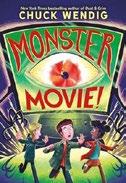
A timorous sixth grader is the only one who keeps his head, literally, after a private viewing of the scariest movie ever made. This work is more allegory than unvarnished shockfest—but along with creating a monster creepy enough to squick even hardened readers out, Wendig expertly ratchets up the terror and suspense to a feverish pitch. Already subject to panic attacks, Ethan reluctantly bows to heavy pressure from best friends Harley and Olivia to take a quick peek at a classmate’s showing of the legendary, impossible-to-get Demons of Death 4: Death Fingers. He arrives at Kevin’s house just in time to see the TV sprout limbs and, horribly, a mouth to nip off the heads of his whole sixth grade, leaving their still-breathing bodies otherwise intact beneath necks covered in “smooth Silly Putty skin patches.” TV Head next gets to all the adults who are at school for parents’ night and then everyone else in town. Summoning the courage to tackle the eerie, seemingly irresistible monster head on and rescue its victims proves so life-changing for Ethan that he’s even able, afterward, to persuade his parents to stop discouraging his interest in art. The book includes a pitch to let kids watch (developmentally appropriate) horror films as part of their preparation for real life: “It’s like a vaccine.” Olivia is Black; other major characters present white.
A bit message-heavy, but top of the class when it comes to frights.
(Horror. 9-12)

Westerfeld, Scott | Illus. by Jessica Lanan
Roaring Brook Press (32 pp.) | $18.99
Sept. 10, 2024 | 9781250799326

What we are all made of, from a universal perspective. As Westerfeld rightly points out in his debut picture book, we join every living thing in being composed of rain and sunshine, of iron and certain other elements in “stones and soil”—all of which our DNA endows with the “ticktock of the living world.”
“Some of you was waiting deep in the earth, / ready to be drawn up by the roots of plants,” he muses. He goes on to unpack these lyrically presented notions in the afterword, explaining how DNA chemically codes everybody’s plan, that all living things are largely water, and that most depend on the sun’s energy in direct and indirect ways. In luminous watercolor and gouache illustrations, Lanan follows a brown-skinned family as they stroll past fruit trees and over puddles and hidden roots in an idealized landscape. As the seasons wheel by in their cycles, the mother shows increasing signs of pregnancy. Eventually, her older child watches wide-eyed as she nurses a newborn beneath a radiant burst of flowers; the child goes on to play joyfully in the snow and, in the summer, with the growing little sibling.
A glowing celebration of life, of time, and of how every part of
creation connects with every other. (Informational picture book. 6-9)
Wills, S.J. | Simon & Schuster (320 pp.)
$18.99 | Aug. 27, 2024 | 9781665938037
Series: Bite Risk, 2
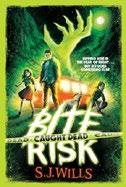
There’s a new monster in Tremorglade. Once a month, teens and adults worldwide turn into Rippers, or werewolflike beasts. For the residents of Tremorglade, this transformation isn’t scary and dangerous like it once was, though—not since Sel and his friends exposed the medical corporation that was using them for an experiment. Now, Sel’s biggest problem is his separation from best friend Elena, who’s moved far away. But then Rippers start getting bitten and hurt during Howl nights and experiencing strange aftereffects from their injuries. With the help of his neighbor Mika, a bold 11-yearold with hip dysplasia, as well as a mysterious newcomer to town, Sel once again sets out to uncover the truth, this time about the new creature that’s bigger and badder than the Rippers. Like Bite Risk (2023), the first book in the series, this high-octane tale is filled with action from start to finish and has the perfect amount of spookiness and gore. The beginning quickly catches readers up on prior events before jumping right into the new challenge. Exciting twists will keep readers hooked and guessing until
A layered, moving musing on grief, connection (and lack thereof), and identity.
the satisfying ending wraps up this dilemma while promising more to come. While this is mostly Sel’s story, the inclusion of some chapters featuring Mika’s and Elena’s perspectives adds extra depth and intrigue. Sel presents white; Mika is implied Japanese American, and Elena is cued Latine. Creepy and completely captivating. (Paranormal. 10-14)
Wolf, Allan | Illus. by Keisha Morris Candlewick (40 pp.) | $18.99
Sept. 10, 2024 | 9781536223477

Learn how to release big feelings like a pro. Everyone’s felt big, even overwhelming, emotions at times. We know we should let them go, but we don’t always know how. This book shows kids how to let off steam productively. Some of the soothing strategies may work well for grownups, too. The result? Improved mental health, equanimity, a better sense of perspective, and maybe even a laugh or two—some of the 10 ideas demonstrated herein will elicit giggles, such as hanging upside down like a bat, lying flat like a cat, playing a game of tic-tac-toe (solo, so you can win), and doing a silly dance and singing “Ooh la la!” In gentle, conversational verse, the author lists some of the physical symptoms kids might experience pre-tantrum: breath that “becomes a hurricane,” a “hot and red” face, hands turning to fists. He also sympathizes with reasons for children’s explosive feelings: not getting something they want, having a bad day, or feeling disturbed by loud noises or bright lights. Before blowing your top, he says, breathe deeply and launch into some of these champion tantrum blockers. The colorful, textured illustrations,
created with tissue-paper collage and finished digitally, depict racially diverse characters.
Books teaching kids to be champs are always welcome. This one goes a long way toward that goal. (Picture book. 4-7)
Yang, Kao Kalia | Dutton (208 pp.)
$17.99 | Sept. 17, 2024 | 9781984816337

In Yang’s middle-grade debut, a Hmong American boy makes sense of his place in the world. In Part 1, readers meet Malcolm, who, through chapters written from the perspectives of his immediate family and elementary school teachers, grows from a kindergartener to a fifth grader. The youngest child of an older, working-class couple who came to Minnesota as refugees, Malcolm lives with his oldest sister, True, and her husband during the week so he can attend a private school; on weekends, he returns to his parents’ prairie home. Although this arrangement was a decision made with love, his family grapples with regrets and hopes. Meanwhile, many of his white teachers treat him differently due to their own biases. In Part 2, 11-yearold Malcolm takes over the narrative, revealing an introspective, sensitive, and lost young person. Malcolm collects family stories in order to “travel from the life I was living” and to connect with his family history. All four of his grandparents were shamans, and the shamans’ spirits are calling to Malcolm. After embarking on a spiritual journey, he finds himself literally immersed in the stories from his family’s history—stories from before he was alive, stories that aren’t without trauma. Lyrical, evocative prose deftly captures Malcolm’s longing for
a sense of belonging; Yang has crafted a layered, profoundly moving musing on grief, connection (and lack thereof), and identity. A true gem. (Fiction. 11-14)
Youssefian, Shidan & Roshan Youssefian Illus. by Mahui Duque | Andrews McMeel
Publishing (208 pp.) | $14.99 paper
Sept. 3, 2024 | 9781524885946
Series: Life Really Socks, 1

Where do socks go when they get lost in the wash? Open this graphic novel and find out. Freddy may be stinky, but he loves life with his partner, Peter, on their active boy’s feet. But when he’s whirled through the spin cycle, he finds himself in a laundry-themed land of pairless peers called the “Sock-Verse”—specifically, in the city of “Washingtown.” If you think that’s a feeble pun, just wait for the “temple of loom,” “a feeling in my gusset,” “a needle in a hay sock,” and “lost soles.” While Freddy meets several amiable socks, he just wants to go home and reunite with Peter. His ensuing quest feels as though it’s been through the rinse/repeat cycle so many times that it’s lost its luster. The shapeless story wanders as Freddy deciphers symbols on an “ancient scroll” (a laundry tag) in order to find the wise gatekeeper, who may be able to help him return “foot-side.” Just when the narrative seems stretched to its limit, it meanders on, blending genres like a threadbare mixture of fibers. It’s a buddy story about “mismatched” friends, a search for a lost brother, and a satire about mystics vs. skeptics (which will go over readers’ heads). The cartoon art exploits every moment of action, adding plenty of onomatopoeia, but it’s not enough to save this one. Will have readers hoping the protagonist puts a sock in it. (Graphic fiction. 8-12)
Zhao, Kyla | Putnam (240 pp.) | $17.99 Sept. 17, 2024 | 9780593615867
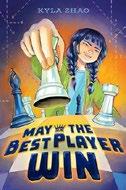
For a seventh grade chess champion, does success take away from her love for the game? May Li’s middle school chess team performed well at the California state championship and has earned a berth at Nationals. May, who’s Chinese American, even received a trophy for being the top female player! But her success sours her friendship with teammate Ralph Morris, her main competition for team captain. Ralph goes so far as to belittle her accomplishments because she’s a girl. As Nationals approach, May feels pressured to perform, which erodes her confidence and causes strife with everyone around her. Zhao captures the anxiety of a tween who’s juggling the expectations of adults, adoring new fans, and friends-turned-rivals. Fortunately, an unexpected friendship with popular soccer goalie Mario Cruz allows May to share her struggles with the pressure of success; their conversations also demonstrate surprising commonalities between soccer and chess. The chapter titles (for example, “Battery” and “Sacrifice”) are drawn from chess terminology and briefly defined, teaching readers about the game while reflecting the story’s progression. The supporting characters, both adults and peers, are well developed, and the chess games are thrilling. In her middle-grade debut, former competitive chess player Zhao explores gender bias as well as performance stress, and the book’s valuable life lessons will speak to anyone who’s lost their love for a pursuit.
An emotionally intelligent work that explores socially relevant themes. (author’s note) (Fiction. 8-12)

I STARTED READING
graphic novels many years ago, after noticing flocks of students making a beeline for the 741.5 section of my school library. Graphic novels pulled kids in during recess and tempted them to make quick library pit stops before heading home— even (maybe especially) the kids who supposedly “didn’t like to read.” My brain got an interesting workout as I learned this new way of reading, and soon I was hooked.
It was a thrill to be among the jury members who selected Gengoroh Tagame’s graphic novel series My

Brother’s Husband, translated from Japanese by Anne Ishii, for the inaugural Global Literature in Libraries Initiative Translated YA Book Prize, as well as one of the judges who chose Harmony Becker’s Himawari House as the winner of the Kirkus Prize for Young Readers’ Literature in 2022. Formal awards, after all, can help confer legitimacy on a format that’s already won a place in readers’ hearts.
Each year, the selection of YA graphic novels seems to grow richer and more compelling. These 2024 titles use the format in


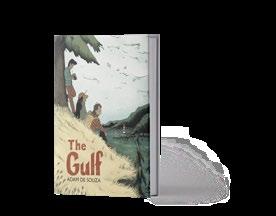
intriguing ways to tell engaging stories.
Two titles that delve into family relationships with sincerity are Agnes Lee’s 49 Days (Levine Querido, March 5) and Rosena Fung’s Age 16 (Annick Press, July 2). Lee’s debut is a strikingly original, exquisitely expressive meditation on grief that follows a deceased Korean American girl through the Buddhist liminal space called bardo, as well as the loved ones she’s left behind. In Fung’s first work for teens, she skillfully uses color to show three women in a family—in 1954 Guangdong, 1972 Hong Kong, and 2000 Toronto— whose lives are movingly intertwined as they grapple with internalized misogyny and generational trauma.

Many teens find catharsis in reading books that explore difficult times and offer a message of hope. They won’t go wrong with Ernesto Saade’s Just Another Story: A Graphic Migration Account (Graphic Universe, April 2)

Our Beautiful Darkness, written by Ondjaki, illustrated by António Jorge Gonçalves and translated by Lyn Miller-Lachmann (Unruly, July 23). Saade’s heartfelt portrayal of his aunt’s and young cousin’s dangerous journey from El Salvador to the U.S. is filled with both desperation and
moments of touching human connection; it also shows their post-migration lives with great nuance. Our Beautiful Darkness is a work of tremendous lyricism—one that features poetic text by an Angolan author and an American translator, with bold illustrations by a Portuguese artist—in which two young lovers discuss matters both profound and quotidian during a blackout.
The visual nature of graphic novels makes them ideally suited to portraying the powerful human experience of the natural world, as demonstrated in Adam de Souza’s The Gulf (Tundra Books, March 5) and Jen Wang’s Ash’s Cabin (First Second, Aug. 13). In de Souza’s evocative, enticing work, three disaffected Vancouver teens set off for an island commune; their journey requires them to navigate interpersonal tensions, inclement weather, and a wild and varied landscape. Acclaimed graphic novelist Wang’s gut-wrenching story introduces readers to lonely Ash, who seeks solace by attempting to live off the land in their beloved late grandfather’s cabin in the ruggedly beautiful California wilderness.
Laura Simeon is a young readers’ editor.
A star football player makes a life-changing wish that comes to haunt him.
Kincade Webster III attends high school on an athletic scholarship—he’s one of the few Black students at the exclusive, mostly white Neeson Preparatory Academy in Virginia. With his dad dying of lung cancer, Cade dreams of making it in the NFL so that he’ll be able to support his mom and younger sister. He also wants to someday help his childhood best friend, Booker, and Booker’s sister, Gabby, leave their neighborhood of Jacobs Court. Meanwhile, the
school’s football games are frequently being canceled due to anonymous bomb threats. Fearing for his own safety after a white woman on the bus misinterprets Cade’s helpful gesture as criminal and riles up an angry crowd, he flees, ending up hiding from the police in a pawn shop. Following a strange interaction with the eccentric shopkeeper, Cade utters the fateful words, “I wish everyone would stop acting so scared around me,” thus triggering a series of chaotic, otherworldly consequences and leading him to Ruin Road, or “the road between realms.” Giles’ robust

descriptions of the setting and nuanced characterization provide this intricately plotted story with incredible depth. Occasional perspective shifts deftly flesh out the landscape of suspenseful supernatural
elements, and abhorrent acts of racism bring a sobering sense of reality to this magic-filled story. A riveting thriller that seamlessly incorporates powerful social themes. (Paranormal thriller. 14-18)

Adia, Jade | Disney-Hyperion (416 pp.)
$18.99 | Aug. 27, 2024 | 9781368090117

In Adia’s sophomore novel, a 16-year-old Black girl’s plan to build a fallout shelter to help manage her depression and complicated family life gets derailed.
Syracuse, New York, transplant Niarah Holloway is an antisocial, video game–playing, doomsday prepper who’s just trying to make it through the end of sophomore year at her new school in Los Angeles. Her lack of preparation for her end-ofyear project leads to her impromptu presentation using items from her Every Day Carry survival kit—and the nickname “Doomsday Girl.” Niarah’s poor attendance also lands her in the office of the guidance counselor, where she learns she must complete the capstone assignment and gym requirement over the summer to avoid repeating 10th grade. Instead of pursuing her original summer plan to construct Camp Doom, her fortified bunker, she’s forced to enroll in Mexican American classmate Marco “Mac” Torres’ Color Outside wilderness group, which is anathema to “Indoor Kid” Niarah. Over the summer, conflict with her parents, challenges to her pessimistic mindset, and feelings for Mac shake Niarah up. The emotional tenor of the narrative will resonate with many readers: The author thoroughly examines depression and family trauma, while also weaving poignant moments, cute romantic encounters, and a generous
helping of humor into this satisfying story that has appealing leads. An engaging read that contains both the hard realities and beautiful aspects of teen life. (content warning, resources) (Fiction. 13-18)
Anyakwo, Diana | IgKids (288 pp.)
$18.95 | Aug. 13, 2024 | 9781632461650
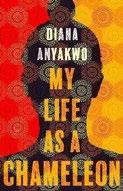
Split between two cultural identities, a Nigerian and Irish girl navigates difficult family and school experiences. It’s 1990, and 16-year-old Lily, who’s living in Manchester, England, prepares for a return to her birthplace of Nigeria for the fifth anniversary of her father’s death. Flashbacks to her childhood in 1980s Lagos introduce readers to a young, quiet Lily who’s contending with being the youngest sibling by far (Maggie, Luke, and Sophie are 7, 9, and 13 years older, respectively), having an emotionally distant Nigerian father who’s battling mental illness, and an Irish mother whom she yearns to be closer to. With her father’s mental health worsening and political turmoil, including military coups, creating danger, Lily’s sent to Manchester to live with Luke and the family of his girlfriend, who’s also Nigerian and Irish. “I hate the way everything keeps changing.…All I have is myself,” Lily later confesses— although she’s determined to grapple with the series of life-altering changes she faces. Anyakwo’s debut, which was originally released in 2023 to critical acclaim in the U.K. and Ireland, offers readers an emotional story of survival,
grief, and tenacity. The parallel timelines unfold over the novel’s three parts, adding interesting cultural context and space for Lily’s evolution. Though somber at times, the story’s heaviness is warranted, with the author exploring themes of physical abuse, colorism, and racism in a well-developed setting.
A touching story of resilience. (author’s note) (Fiction. 13-18)
Arnold, David | Illus. by Jose Pimienta Colors by C.A.P. Ward | Viking (256 pp.) $24.99 | Sept. 3, 2024 | 9780593620908

Four teens grapple with common problems in an uncommon time.
In this stand-alone apocalyptic graphic novel, friends Ty, Burger, Fib, and Miles are at the crossroads of post–high school life. While their world bears some similarities to ours, these young people face something entirely (and happily) foreign: squizzies. The virus-infected squirrels have glowing, bubble gum pink eyes, the ability to fly, and murderous intent. As a result, people must wear bespoke hazmat suits called hazzies every time they go outside. The friends embark on a quixotic quest to locate Stu, their missing boss, and over the course of a fateful night, they face dangers both within their circle and in the world at large. Arnold’s text skillfully portrays post-adolescent banalities against a harrowing and violent backdrop; those sensitive to animal death and violence may be upset at the frequency and gruesomeness with which the squizzies are dispatched. While the story spotlights the interpersonal dynamics, those who prefer robust worldbuilding may be disappointed, as details about the squizzies are scant at best. In a dreamy palette of pink and lavender hues, Pimienta’s illustrations leap off the page in a feat of
visual wizardry. Most of the central characters are light-skinned; Burger has brown skin and Afro-textured hair, and the cast contains diversity in gender identity and sexual orientation. A delightfully disturbing and dystopian snapshot of friendship. (Graphic science fiction. 14-18)
Boardman, Adam Allsuch Flying Eye Books (128 pp.) | $21.99 Sept. 3, 2024 | 9781838749101

An illustrated introduction to the world of urban legends past and present. In this full-color guide, author and illustrator Boardman breaks down the history of urban legends from around the world and across time, opening with a section called “Premodernity” and closing with the “Metamodern Era.” In his introduction, he explains the difference between myths and legends, describes the different types of people who investigate urban legends, and shows how these stories proliferate. The older tales covered include the Loch Ness Monster, vampires, and lost cities such as Ys and El Dorado. Readers will also learn about Spring-Heeled Jack, a notorious criminal from 19th-century England, and 1990s chain emails warning people about black market organ thieves. The book covers fan favorites—cryptids, UFOs, and Slenderman. While the visual appeal is high thanks to the stylish, colorful art, each topic gets only a cursory treatment, letting down those looking for a deeper dive. The repetition in this very short work soon becomes tiresome as well, with details repeated throughout each section. Nevertheless, those new to the subject may enjoy this guide, which lends itself well to casual browsing. The backmatter includes a glossary, further reading
(which contains—but doesn’t differentiate between—fiction and nonfiction), further watching (a puzzlingly eclectic mix that includes both the 1960s Scooby-Doo TV series and The Blair Witch Project), and an index. A quick visual guide for beginners that’s visually engaging but lacks depth. (Graphic nonfiction. 12-14)
Brophy, Aislinn | Putnam (432 pp.)
$19.99 | Sept. 17, 2024 | 9780593354551

A memory spell goes awry, causing a witch and a nonmagical girl in Boston to forget each other every time they break up. In order for Luna Gold and Aoife Walsh to date, Luna must lift the Veil for Aoife, allowing her to perceive the existence of magic. Luna, a fat Black lesbian witch, must also cast a memory spell that will cause Aoife, a biracial (white and Black) bisexual mundane, to forget about her if the two break up. But once the spells are cast, a flood of memories comes back—and both girls realize they’ve dated before. So begins a cycle of meet-cutes and breakups in which Luna and Aoife seem destined to find each other—but also destined to be pulled apart. Meanwhile, Aoife’s parents continue to cross her boundaries as they share information about her on their blog, The Wonderful Walshes, and pressure from Luna’s grandmother is mounting in anticipation of Luna’s taking her grandmother’s seat on the Witch Council. The girls are on a path to discovering whether they can make their relationship work, but equally as pressing is whether they’ll be able to stand up to their families. There’s an authenticity to the teens’ sweeter moments as well as their moments of struggle. Chapters alternate between their first-person perspectives, making for rich characterization that supports the action-filled storyline.
A compelling urban fantasy about love, familial obligations, and one’s power over fate. (Fantasy. 13-18)
Kirkus Star
Bruzas, Alena | Rocky Pond Books/ Penguin (256 pp.) | $18.99
Sept. 10, 2024 | 9780593616208

A young woman goes hungry— and falls in love—in the Virginia Company’s colony of James Fort. The year is 1609, and Ellis has traveled alone across the ocean from England to be an indentured servant to Henry Collins. She’s come to seek a better life, her family back home fractured by death and poverty, but she soon learns that this land is no undiscovered Eden, ripe for the taking. Tensions are rising between the Indigenous Powhatan people and the invading European settlers, and the cruelty of claim-laying extends to Ellis’ own hearth, where Henry treats her as property and abuses both her and his pregnant wife. Meanwhile, winter draws ever closer, and with it the specter of starvation. A bright light in all this darkness is Jane, a spritely young woman who loves Ellis fiercely and shamelessly. Ellis loves her, too—as secretly as she can, given Henry’s violent disapproval. The two are friends with Rowan, a deeply kind young man who’s come to the settlement alone; he’s their companion in misadventure as they seek sustenance and survival. Bruzas pulls no punches with her lean, lyrical prose. Ellis’ voice is entirely convincing, her quiet observations of people and situations around her perfectly embedded in her own experiences even as they elucidate for a contemporary audience the brutal harm done by her settlement. Ruthless and tender by turns: a triumph of historical fiction. (content note, author’s note, end note, select bibliography) (Historical fiction. 14-18)
Kirkus Star
Buffini, Moira | Harper/HarperCollins (384 pp.)
$19.99 | Sept. 3, 2024 | 9780063358218 Series: The Torch Trilogy, 1

Thousands of years after the Light People destroyed Earth, two factions are at war in a racially diverse world: the Brightlings and the Aylish. Elsa and Rye, residents of Northaven, a pretty coastal town in Brightland, are in love. They also share a dangerous secret as Torches, those with the ability to use songlight, a form of telepathic communication. Torches are labeled unhumans; they’re either lobotomized and made to do the most unpleasant and dangerous jobs or turned into Sirens and forced to hunt others with songlight. As terrible fates loom—Elsa will be married off to a stranger, and Rye will be shipped out to fight with other cadets—the young lovers make plans to run away. But before they can escape, Rye’s abilities are discovered, and he’s outed by Piper, Elsa’s conformist brother. Rye is sentenced to be sent to the Chrysalid House for unhumans. In her anguish, Elsa goes down to the sea: “In songlight, I roar with white, inchoate pain.” This emotional release connects her with Nightingale, a powerful fellow Torch. Meanwhile, patriotic darling Sister Swan, the Flower of Brightland, is harboring a secret with serious political implications. The multiple immersive perspectives and the anticipation this narrative will create in readers make this first installment in a planned trilogy unputdownable. In her debut novel,
award-winning playwright Buffini captures the human spirit and all its messy and beautifully complex emotions. A brilliant character study that examines the effects of war, genocide, and misogyny. (Dystopian. 14-18)
Bulla, Michael Gray | Quill Tree Books/ HarperCollins (336 pp.) | $19.99 Sept. 3, 2024 | 9780063091757

A trans teen mourns his brother’s death. Sixteen-year-old Caleb is being haunted by a cat. Ever since the heroin overdose death of his older brother, Jack, the white high school junior has been followed by a mysterious black cat, whom he names Ghost. No one else can see the cat, which has a blurry, shadowy face, but it subtly seems to guide Caleb toward making connections with different people who can help him deal with the aftermath of loss. His grief over his brother is ameliorated somewhat by his best friend, Tanya, a trans girl who immigrated from India with her supportive parents, and his love interest, Emmett, a white, trans, nonbinary, and genderfluid musician. The book has moments of rich emotion, mostly in the description of Jack’s relapses and the trauma that spurred his addiction, but the storytelling is flat overall: Caleb describes how he feels without making readers feel alongside him. All the characters are carefully drawn to the point where they feel less than robust and real, particularly Emmett, who comes across more like an idealized
Captures the human spirit and all its messy and beautifully complex emotions.
adult than a smitten adolescent. The quiet plot unfolds slowly, with the most minor of revelations pulling it along. More cautious than powerful. (Fiction. 14-18)
Calonita, Jen | Disney-Hyperion (368 pp.) | $18.99 | Sept. 3, 2024 9781368089586 | Series: The Enchanters, 1

Cinderella’s fairy godmother takes center stage in this series opener. Renée Dubois, a young governess in the kingdom of Aurelais, believes in fairies—she owes her life to one who rescued her in childhood from the fire that killed her parents. After rescuing a young charge who shares her passion for the magical beings, Renée needs a second, rule-breaking fairy rescue herself. And this one, by making her a “part-fairy,” changes her life forever: She’ll remain young while in Faerie Province but will age rapidly as soon as she returns to the human world. Unfazed by her snooty fairy critics, Renée cultivates a gift for magical gardening, develops a crush on the fairy queen’s nephew, Tresor, and is mentored by dorm housemother and professional fairy godmother Nelley, who recognizes her as prime godmother material. Renée’s thrilled to attend the Summer Solstice Ball with Tresor, but when an ailing Nelley begs her to step in as backup godmother, Renée must leave the ball on an urgent mission that returns the narrative to familiar “Cinderella” territory. This slow-paced story is unfortunately weighed down by a cumbersome backstory, generic characters, tired tropes, and low stakes. Faerie Province—its dorms, classrooms, rules, and assignments described in flowery detail—suggests a beautifully decorated (and overprotective) boarding school. Human characters are cued white. A sugary treat for patient readers who are fans of faerie and all things Disney. (Fantasy. 12-16)
Casomar, Jordan K. | MTV Books/ Simon & Schuster (336 pp.) | $19.99
Sept. 10, 2024 | 9781665932097

Zeke thinks it’s destiny that they be together, but his best friend, Imogen, disagrees.
Sixteen-year-old
Zeke Ladoja is tall, handsome, and a star baseball player. His dad is fighting cancer, and Zeke has to put baseball on hold so he can help the family out financially, but he still has bestie Imogen Parker, who’s smart, kind, beautiful, and an unabashed lover of historical romance books. Everyone has told them since they were kids that they’re meant for each other. Imogen isn’t allowed to date until she’s 16, so Zeke bides his time, showing her what a great guy and perfect boyfriend material he is. Imogen does love Zeke; she’s just never had romantic feelings for him, and Trevor Cook, the new kid, has caught her eye in a big way. With Imogen’s 16th birthday approaching, Zeke plans a grand romantic gesture that backfires. And when he refuses to take no for an answer, the consequences are disastrous. Told in Zeke’s and Imogen’s alternating first-person perspectives, Casomar’s debut features energetic, engaging dialogue but relies heavily on dramatic soap opera moments to drive the narrative. While the novel explores important themes around self-esteem and listening to others, the character development fails to make the leads endearing enough to fully invest in. All main characters are Black or Latine. A strong start, youthful vibes, and an important message, but over-the-top theatrics keep this one from soaring. (Fiction. 14-18)

CLOWN IN A CORNFIELD 3
Cesare, Adam | HarperTeen (448 pp.)
$19.99 | Aug. 20, 2024 | 9780063325012 Series: Clown in a Cornfield, 3

A survivor of multiple massacres hunts down the people she holds responsible in this third installment in Cesare’s hit Clown in a Cornfield series.
Quinn Maybrook is back, and she’s bound and determined to track down all the parties who spearheaded the previous tragedies in Kettle Springs. She’s armed with a list of names, some Frendo masks, assorted weapons, and Johnny, her kidnapping-victim-turnedally. Also riding shotgun with her is the ghost of Arthur Hill, Kettle Springs’ original homicidal maniac, whose body somehow disappeared before it could be buried. As she crosses off the names on her list, however, Quinn begins to realize that someone even more vicious than she is one step ahead of her. Meanwhile, in the newly incorporated Kettle Springs township, the Frendo followers’ fanaticism is reaching new heights, ramping up to a frenzy and setting the whole town on a deadly collision course with Quinn and her rage. The book opens with a bloody bang and spares no gore or bloodshed throughout. With plenty of callbacks to earlier names and events, having read the first two books in the series is imperative to understanding the cult of Frendo. The atmospheric writing and frenetic pacing make for an unputdownable read, and the final girl trope is perfectly executed. Most characters are coded white; Johnny reads Black. Gruesome, ghastly, and satisfying. (Horror. 14-18)
Chhibber, Preeti | Kokila (304 pp.)
$19.99 | Sept. 24, 2024 | 9780593461884
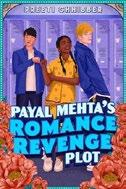
A teen devises a plan to make her crush fall for her. Ever since that fateful first day of freshman year, Indian American Payal Mehta has been enamored with blondhaired, blue-eyed classmate Jon Slate. Fast-forward three years: Payal encounters Jon at a party, and after she bravely suggests they hang out, Jon vomits on her shoes. Later, when Payal is injured at school, squeamish Jon vomits again (fortunately near, but not on, her). When he buys her lunch as an apology, Payal is sure their love story is just beginning. They seem to be hitting it off over Taco Bell until Jon, who’s white, says things that make it clear that her being a brown girl rules out any romantic possibilities. Her best friends, Neil Patel and Divya Bhatt, and even her prickly school rival, Korean American Philip Kim, advise Payal to move on. But, still hung up on Jon’s description of her as “funny and cute,” Payal convinces herself that she can make him fall for her. She promises to let Philip take full credit for their psych project if he helps her, overriding his initial criticism of what he dubs “Operation End Racism With Love.” Payal’s naïveté is comically delusional, but her determination to make herself appealing to Jon offers insights into how people can suppress parts of who they are in order to feel accepted, as well as the importance of being genuinely embraced.
A cute romance that explores valuable themes around self-esteem.
(Romance. 13-18)
This lively, accessible, and inspiring history deserves a wide readership.
REPRESENT
Cole, Bill | Illus. by Sarah Green Magination/American Psychological Association (144 pp.) | $16.99
Sept. 10, 2024 | 9781433843532
Series: Extraordinary Women in Psychology

A charmingly illustrated biography that highlights psychologist Carol Gilligan’s life and achievements. Gilligan is famed for her contributions to understanding people’s voices: “how they were used, not used, and even silenced.” As a young woman involved in the Civil Rights Movement, she pondered why the voices of certain groups, especially women and people of color, were routinely ignored or dismissed by members of various professional fields ranging from law to psychology, education, and medicine. In part through the 1982 publication of her book In a Different Voice, Gilligan established a model of moral decision-making and reasoning that she called an Ethic of Care (in contrast to the widely used Ethic of Justice model that privileged traditionally male processes). She also developed a revolutionary interview style she dubbed the Listening Guide Method. Beyond discussing Gilligan’s life and studies, Cole highlights key figures and psychological concepts in the world of psychology, explaining them in digestible segments. Green’s soft and expressive artwork brings additional life to this easy-to-follow biography. Tools that encourage readers to think more deeply about the content are interspersed throughout the book, providing further
learning opportunities. Individual readers and educators alike will find the balance of information, suggested activities, and additional fun facts to be an effective way to learn about this pioneer of inclusivity in psychology. A straightforward and effective exploration of a remarkable scholar and her influence. (timeline, glossary, further reading, bibliography, photo credits) (Biography. 12-18)
Cotugno, S.H. | Putnam (240 pp.)
$24.99 | Sept. 24, 2024 | 9780593524473
Series: The Glass Scientists, 2

Dr. Jekyll must confront Mr. Hyde’s waking nightmares—and his own heart—in order to save the Society for Arcane Science in this second series entry.
Dr. Jekyll and the society have two weeks to raise enough funding to keep their sanctuary for rogue scientists from going bankrupt. There’s just one problem: Hyde. Locked away in Jekyll’s mind without parole, Hyde unleashes a gaggle of nightmarish hallucinations that plague Jekyll everywhere he goes. The frights prove enough to give Hyde a moment of control over their body, and he sets himself free. But when Hyde leads the cops right to his beloved Blackfog Bazaar, he puts the society’s Grand Exhibition at risk once again. The only way for Jekyll to regain his autonomy is to discover the truth of Hyde’s origins, face their unhappiness, and come to terms with their lost love, Dr. Robert
Lanyon. The emphasis on a smaller cast of characters gives this volume structure, depth of character, and a dynamic plot. The work features gorgeous illustrations and well-handled issues surrounding LGBTQ+ friendships and romance, classism, and subversion of the patriarchy. There’s a mismatch, however, between the cartoonlike style of the art, which cues a younger audience, and the content, which follows adult characters. Jekyll and Hyde are queer and read white; secondary characters are diverse in ethnicity, gender, and sexuality. A visually enticing work that effectively explores complex themes. (prequel short story, character sketches and illustration notes, creator notes, alternate covers) (Graphic horror. 15-18)
Dugan, Jennifer | Illus. by Kit Seaton Putnam (256 pp.) | $24.99 Aug. 27, 2024 | 9780593529843
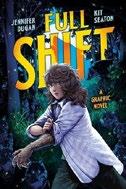
A werewolf struggles with her senses of self and belonging. Tessa was born a werewolf, but her abilities lag behind those of others in her extended family; she still can’t fully shift, and honestly, she doesn’t even want to. Her dad was the only one who made her feel comfortable about her wolf, but he passed away. It’s hard enough that white-presenting Tessa has a longstanding secret crush on her friend Maddie (who’s cued Indian American), let alone adding her supernatural status into the mix. When rumors swirl about hunters in the area seeking to “cure” werewolves by turning them human, Tessa sees a chance to make her life easier, but she soon discovers that their intentions are far more sinister. A miscommunication leads to Maddie’s learning the truth about Tessa’s werewolf identity—and, as a result, Maddie unwittingly becomes a target of the hunters. To save her family
and her crush, Tessa must embrace her full self. The easy-to-follow panels (even in chaotic action scenes) combined with inviting art make it a breeze to zip through this entertaining, straightforward tale. While Dugan doesn’t delve too deeply into the themes, she includes just enough substance to make the work gratifying. The balance between action and humor is held together by Tessa as an appealing lead. The queer teen is prickly, sometimes awkward, and often relatable as she tries to figure out who she is and her place in the world, all while dealing with grief. A satisfying supernatural story. (Graphic paranormal. 13-18)
Dvojack, Sarah | Union Square & Co. (464 pp.)
$19.99 | Sept. 3, 2024 | 9781454953906
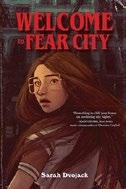
A girl and her city are both cursed. It’s a sweltering summer in 1977 Manhattan, and Sylvie Stroud, a white girl whose birth mom entered into an open adoption arrangement, can see the past. Ever since the blackout of 1965 when she was 5, she’s found that touching any physical material that’s more than 10 years old triggers an overwhelming cascade of all the (apparently post-colonial) people who existed in that space. When Sylvie repeatedly sees a brutal murder outside her Irish dance school, though, she becomes compelled to solve the mystery of the girl’s attack, which leads her to a shocking revelation. The teen also learns that her brother (who’s also an adoptee), her crush, and her friends have been drawn into the danger, which encompasses both a historical town home and an abandoned mansion. Unfortunately, this story, with its belabored prose and many underdeveloped strands, suffers from a plot that spins its wheels rather than getting into the meat of the mystery. Sylvie’s professed love for Irish dance never quite makes it onto the page, and too much of the story hinges
on moments that are described as “too coincidental to be a coincidence.” The dense thicket of 1970s references will interest teen readers who are curious about that decade, while leaving others feeling stranded. Final art not seen. Drags like an August heat wave.
(Horror. 14-18)
Kirkus Star
Dyson, Michael Eric & Marc Favreau Little, Brown (256 pp.) | $19.99
Sept. 10, 2024 | 9780759557062
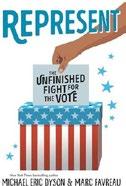
An explanation of how Americans have fought for a precious right, one that’s central to democracy— and how it’s still threatened today. Although the struggle for representation lies at the heart of U.S. history, Dyson and Favreau persuasively argue that the Founding Fathers abhorred the “people power” of true democracy, preferring the power of money and chattel slavery. States overwhelmingly restricted the voting rights of women, those who didn’t own property, Native Americans, free Black people, and, later, those of Chinese descent. But the roughly two-thirds of the population who were disenfranchised continually fought for the vote, and their stories vividly unfold in three parts: “Promises,” “Awakening,” and “Two Roads.” These sections cover 19th-century efforts to expand access to the ballot as the population grew and the electorate shrank “under the pressure of mob violence and discriminatory laws”; 20th-century battles, for example, for women’s and Native American suffrage and equal access for Black voters; and finally, present-day obstacles, including the gutting of the Voting Rights Act and the impact of disinformation spread by dark-money groups. Nevertheless, the authors stress the positives in their clear, well-paced account, showing the courage, persistence, and sacrifices of those who
have advanced and exercised voting rights and introducing readers to a diverse range of activists they should know about. This lively, accessible, and inspiring history deserves a wide readership. A concise, readable account of the struggle for equality, freedom, and democracy in the U.S. (authors’ note, ideas for taking action, timeline, further reading, source notes, index) (Nonfiction. 13-18)
Ellzey, Lauren Melissa | Bold Strokes Books (240 pp.) | $15.95 paper July 9, 2024 | 9781636796550
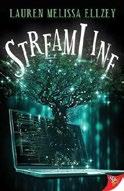
A teenager prefers her life in the MMORPG Garlandía. Diana, a lesbian recent high school graduate with a Black mom and white dad, barely leaves the apartment. Out in the world, she feels constantly judged and evaluated for her clothing and makeup and belittled for her autism. Online as Lune, she’s an up-and-coming streamer showcasing her gaming skills, and she has friends in fellow players Taurus and Needles (and a persistent troll who shows up to harass her). After the trio finish a difficult mission together with low health, it seems that an undignified death in a blizzard is in store for their characters. Enter Nocht, Garlandía’s top player, who never reveals her real face or voice. Nocht heals them and then asks Lune to join her in a mission. Diana is excited about spending time with her crush and idol but wonders why Nocht is interested in someone who’s playing at a much lower level. Diana’s experiences and relationships are evocative of those of many social outsiders. Refreshingly, while she’s affected by her autism, it’s never treated as something that’s wrong with her. Her portrayal avoids stereotypes, clearly showing that her issues are caused by a world that refuses to make space for her neurodivergence. The game systems of Garlandía are poorly
executed, however, with a baffling in-game economy and combat system that will make those in the know flinch. Strong characterization marred by video game worldbuilding that’s best enjoyed by non-gamers. (Fiction. 14-18)
Farrar, Amy & Tabitha Moriarty | Twenty-First Century/Lerner (112 pp.) | $38.65 PLB
Sept. 10, 2024 | 9798765626979 | Series: Healthy Living Library

A self-education guide to ADHD for teens and those who support them. This comprehensive yet concise work offers seven chapters’ worth of information, organized into topics covering the history of ADHD and its causes, as well as diagnosis, treatment, coping strategies, and relevant laws. The weaker final chapter discusses ADHD research and the future, focusing on how scientists might further explore this disability, but the content is drawn from dated and less robust sources. The authors present clear and accurate information for readers wishing to understand their disability and advocate for themselves or for research purposes. The bar graphs, diagrams, sidebars, and photos will attract their attention, although the green-on-green color scheme for the graphs will be challenging for some. Organizational features, such as subheaders and black sidebars with white text, invite readers to skim the clearly marked topics as needed; teens, especially those with ADHD, are more likely to dip into this work than read it cover to cover. The book presents eye-opening facts about medications (including their abuse and side effects) and explains the value of support groups. Other information helps caregivers acknowledge the importance of their role in the lives of teens with ADHD. This
accessible work also helps to dispel common myths.
A useful compilation of secondary research that supports self-advocacy and caregiving. (glossary, source notes, bibliography, resources, further reading, index, photo credits) (Nonfiction. 12-18)
Ferguson, Jen | Heartdrum (352 pp.)
$18.99 | Sept. 24, 2024 | 9780063334229

Molly has just graduated high school in Edmonton, Alberta, and she’s heading off to hike the Pacific Crest Trail: “the hardest and best thing we’d ever do.”
Since her brother, Hank, is recovering from an accident that’s left him with traumatic brain injury, 17-year-old Molly sets out with his best friend, Traylor. She’s using this trip to get some space from her family as she contemplates her next steps: She planned to become a doctor and help her Métis community, but now that doesn’t feel like the right path. A summer outdoors, listening to tunes with the person she blames for her brother’s accident, should take her mind off her impending future. Tray is in love with Molly; he knew when he was 13 that he’d marry her and has been waiting for her to catch on. High-achieving Molly has an all-or-nothing mentality that holds her back but feels realistic for her age. She suffers from the burden of others’ expectations, and hiking the trail gives her time and space for self-reflection. The book jumps around in time, shifting among three youths’ perspectives as it explores disability and fat activism and fatphobia, with a side of romance. Although the novel is long, it doesn’t fully engage with all of its plots and subplots, which makes for an unsatisfying read.
A novel for patient readers that doesn’t dig deeply enough into the important issues it explores. (content note, author’s note, recipe, note from Cynthia Leitich Smith) (Fiction. 13-18)
Goodman, Shawn | Rocky Pond
Books/Penguin (208 pp.) | $18.99
Sept. 24, 2024 | 9780593697528

A practical guide for teens who wish to improve relationships with their parents. Drawing from his experiences as someone who faced familial challenges as a teen and now works as a high school psychologist, Goodman provides step-by-step approaches to help teens repair their broken connections with their parents. He begins by helping readers identify their type of “problem parents”: overly critical, argumentative, overinvolved, uninvolved, distracted, emotionally unavailable, or unpredictable. Depending on the specific parental behaviors, Goodman suggests tailored strategies designed to improve interactions, complete with sample scripts. He also emphasizes the importance of teens’ prioritizing their own well-being and setting boundaries. While the book shines a light on complex family dynamics, offering hope and practical solutions, many teenagers may find it hard to apply Goodman’s strategies: He assumes a level of openness in communication that may not exist in all families, particularly those with more hierarchical norms in which open dialogue about personal feelings is uncommon or even frowned upon. Goodman also assumes a willingness on the part of parents to engage in dialogue and consider their children’s perspectives, which isn’t always the case. The book doesn’t address situations such as parental queerphobia or cultural differences with immigrant parents.
Ultimately, the book’s effectiveness depends on its use by emotionally mature teens and parents who are receptive to critical feedback. A limited but potentially useful jumping-off point. (resources) (Nonfiction. 12-18)
Gregovic, Lydia | Delacorte (400 pp.)
$19.99 | Sept. 3, 2024 | 9780593572375

Something’s rotten in the province of Sussex.
Twelve families rule over the Smoke, a U.K.-inspired nation, where the citizens battle to maintain control against an encroaching fog that brings death and destruction in the form of monstrous Phantoms. When Silas Darling, Merrick’s father and Sussex’s Manor Lord, dies unexpectedly, Merrick must abandon her New London social season and return to her ancestral home, Norland House. Surrounded by her older sister, Essie (who’s set to inherit the title Merrick desires for herself), and cousins (who are concerned mostly with propriety), she struggles to find answers. When Sussex and the family’s seat are threatened by mysterious border breaches and attacks, Merrick enters into a tenuous alliance with sentry Killian Brandon to unravel a Gordian knot of family secrets. The measured pacing, combined with Merrick’s emotional arc, together create magnificent tension. The worldbuilding skews gothic, thanks to the creepy manor house and mist-infected landscapes that are befitting of a Brontë sisters novel—albeit with the addition of possessed corpses that consume human flesh. The gender politics of this world allow women to inherit titles and fight Phantoms, yet they have little agency to act on their own behalf without entering into advantageous, heteronormative marriages, an aspect of the fantasy
with a journey of cultural exploration.
THE UNFINISHED
world that readers may find confusing. Primary characters read white. A page-turner of a fantasy-horror debut from a promising new voice. (guide to manors and ruling families) (Fantasy. 13-18)
Hendrix, John | Abrams Fanfare (224 pp.) $24.99 | Sept. 24, 2024 | 9781419746345

Interweaving prose and graphic art, Hendrix explores the lives, faith, intellectual world, and long, complex friendship of two titans of modern fantasy. As in The Faithful Spy (2018), Hendrix’s hybrid-format biography of Dietrich Bonhoeffer, this volume charges hard into deep and difficult territory— tracking, for instance, C.S. “Jack” Lewis’ progression from naïve believer to staunch atheist to profoundly religious thinker and probing reasons for the friction that grew between him and his close friend J.R.R. “Tollers” Tolkien in the 1950s. Tracing the shaping of their novels while contrasting the styles and personalities of the pair as they egged one another on, Hendrix also fills in the intellectual background with discursions into the differences between fairy tales and myths, largely delivered in extended graphic segments by an affectionately caricatured wizard and lion as they squire readers through a metaphorical series of significantly labeled doors. Though the author sets off direct quotes with asterisks and carefully sources them, he invents some dialogue; for a happily-ever-after ending, he’s also
Challenging but replete with stimulating insights. (author’s note, context on myths and fairy tales, notes on research and authenticity, glossary, endnotes, bibliography, index) (Graphic biography. 14-18)
Isaacs, Cheryl | Heartdrum (336 pp.)
$19.99 | Sept. 10, 2024 | 9780063287389
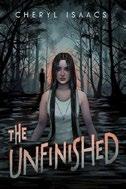
In the forest outside Crook’s Falls lies an unnaturally still body of black water that hides—until it’s hungry. Legends say that the pond is connected to the Ragged Man, who lurks in the shadows: “Walk with him, and you don’t come back.” When Avery, a Kanyen’kehá:ka (Mohawk) high school athlete with a white dad, defies warnings and ventures off the trail during a run, she discovers the deep black water that awakens endless nightmares. Sensing an eerie presence, Avery flees but can’t escape the water’s calls. She’s never felt connected to “the culture [that’s] supposed to be mine” and hesitates to seek the truth until the danger becomes undeniable as her nightmares intensify and people
>>> invented a loving reconciliation scene. Hendrix’s claim (although rooted in Eurocentric bias) that “these two tweedy middle-aged academics just so happened to re-enchant the world” carries plenty of heft. The monochrome art is charming and cues a younger audience than the text, which is complex conceptually as well as in its vocabulary and cultural and historical references.
The author/illustrator of Gender Queer employs comics to make gender-affirming health information widely accessible.
BY MATHANGI SUBRAMANIAN
IN THE SPRING of 2020, comic book author and illustrator Maia Kobabe (who uses e, em , and eir pronouns) was in search of a new project. E had just published Gender Queer: A Memoir (Oni Press, 2019), which, for the past three years, has been the most challenged book in America. In the memoir, e talks about binding, a gender-affirming practice that the University of California, San Francisco’s Transgender Care Navigation Program defines as “the use of tight fitting sports bras, shirts, ace bandages, or a specially made binder to provide a flat chest contour.” Social epidemiologist Dr. Sarah Peitzmeier, who currently works at the University of Michigan, had enjoyed Kobabe’s book and, noticing the content on binding, emailed em asking if e wanted to collaborate on translating the results of Peitzmeier’s research about binding into a comic. Maia agreed, and the result is Breathe (Dutton, May 7), which uses composite characters to translate Peitzmeier’s findings into practical, inclusive language accessible to those who need the information most.
Over Google Meet, I spoke to Kobabe about eir love of locations and homes, eir experience collaborating with an academic, and eir feelings about the struggles against censorship and for gender-affirming care. Our conversation has been edited for length and clarity.


rather than your own?
I’ve done some journalism and nonfiction comics in the past. But it was a new experience to work with a co-author who’s a researcher, not a fellow artist or a writer.
different experiences over time.
If you never met the participants, how did you come up with sketches for the characters?
What was your initial vision for the project?
Sarah [Peitzmeier] has done studies on many queer health–related topics, but she realized that her academic papers were not accessible to the communities she was trying to reach. Our first idea was to make a zine that we’d release online for free or print inexpensively
for use by LGBTQ centers, therapists, and doctors’ offices. It was only after we’d been working on [the project] for almost three years that my agent suggested pitching it as a book.
The text is taken directly from Dr. Peitzmeier’s interviews. What was it like working with existing words
Sarah sent me a compilation of quotes from interviews she and her team had done with 25 trans and nonbinary folks who had bound at various points in their lives. Her research team had compiled the quotes into thematic groups in a 35-page Word document, so I wasn’t reading just one individual’s transcript. Sarah’s team had grouped the quotes by people who had run into a specific health issue, or had similar insights about gender euphoria and mental health, or people who had been binding on and off for decades and had had really
We invented people around the stories. The research encompasses people from, I think, 18 years old into their 60s, and people of different body types, people of different races. It was a diverse group, and we wanted to reflect that while also showing some of the common threads that many people experience. Looking at the demographics of the participants, I thought one of the characters should be white, one should be Black, one should be Latinx. One should be a high school student and one should be in their 50s. Some should want top surgery, while others should feel unsure
about it. We wanted to be able to show those different experiences.
I came up with eight different character options, and we talked about which ones seemed like the best fit for each storyline and how to get the best range.
The character you called “C” felt Asian American, which made me feel represented. That was the intention, so that’s great!
The characters all inhabit such distinct visual settings. How did you illustrate their worlds, considering you couldn’t meet them and visit their spaces?
I really enjoy designing locations and homes, and I also think it’s important for visual storytelling. I found a gallery online on Autostraddle where over 150 queer people had submitted pictures of their bedrooms. There were all these beautiful pictures of queer spaces, sometimes empty, sometimes with people, couples, pets. I remember picking specific bedrooms for inspiration. The first character in Breathe is in their early 20s and is a recent college grad. I decided their bedroom was going to have posters and fairy lights, and they’re also really into fashion, so they’ve got a big closet.
For the youngest character, who’s 19, I have a friend who’s the parent of two nonbinary high schoolers. I actually snapped a picture of one of these high schooler’s beds that was covered in Squishmallows and stuffed
animals and had a pride flag on the wall. I was like, All right, this is the bedroom for this character!
This book is coming out at a time when gender-affirming care is under unprecedented attack. How does it feel to see the work go to print at this moment?
Trans health care in general is a deeply under-research ed topic. So many people who are not trans, not doctors, and not experts will make wild claims about which kinds of health care procedures should and should not be allowed for trans people, without ever having spoken to a trans person in their life. It’s very frustrating.
As someone in the trans community, I know people
who describe having gone on hormones as quieting this loud, annoying sound in their brain, like an alarm bell they hadn’t realized they’d been living with their whole life. Suddenly they feel like they can think more clearly, because their brain isn’t screaming at them all day. This is just one anecdotal example, but I can promise you that the ability to transition deeply improves people’s lives. It has improved mine.
This particular project gained more and more urgency the longer we worked on it. Sarah reached out to me before the challenges to trans health care we’re seeing now. We started this book feeling it was important, but as we worked on it, the
It was a new experience to work with a co-author who’s a researcher, not a fellow artist or a writer.

Breathe: Journeys to Healthy Binding
Kobabe, Maia & Sarah Peitzmeier
book felt more and more necessary. Binding is one gender- affirming tool that’s very hard to ban, since it’s not prescribed by a doctor. It’s important to teach people about binding safely, especially if it becomes the last resort left to trans and nonbinary teens in states that have banned trans-affirming care for minors.
What can readers do to support you and other authors of banned books?
The main thing I would say is, “Please utilize your public library.” It’s especially helpful to put books on hold before they come out. If libraries get a lot of these pre-order holds, they’ll know that the book is going to be in demand, and they’ll buy additional copies. If a book you want isn’t available in the library, suggest that they purchase it!
Even though I’ve been the most challenged author in the U.S. for the past three years, I’m not as close to the front lines of this [issue] as public librarians and school librarians are. People come into their workplaces and accuse them of unbelievable things; they’re under so much pressure and are working so hard to keep libraries open, books on shelves, and information available. So please use your library, thank your librarian, and, if a book is challenged in your area, please show up and support the freedom to read.
Mathangi Subramanian is a novelist, essayist, and founder of Moon Rabbit Writing Studio.
begin to disappear. When Key, the boy who’s her best friend and romantic interest, vanishes, Avery seeks guidance from Elders and learns more about the black water and the Ragged Man. In a desperate attempt to save Key and her town, she navigates a chilling mystery, torn between following wisdom passed down by her Elders and risking everything for love. Against a haunting backdrop, debut novelist Isaacs, who is Kanyen’kehá:ka and white, skillfully portrays a young woman’s struggles with the fallout of having distanced herself from her ancestors, showing how she comes to acknowledge this disconnect—grounded in avoidance of pain and discomfort—and wrestles with the resulting regret.
A harrowing work that combines suspense with a coming-of-age journey of cultural exploration. (Kanyen’kéha glossary, note from Cynthia Leitich Smith) (Supernatural. 13-18)
Jasinska, Alicia | Peachtree Teen (384 pp.)
$19.99 | Sept. 10, 2024 | 9781682637364

A water nymph and an exorcist form a strange alliance.
Gisela is a rusałka—a girl who’s bound in spirit form to the river where she died. After almost a year of her watery existence, she longs to become human again and return to her family. According to water goblin Wojciech, the rusałki’s protector and father figure, this requires a kiss from a mortal. To local exorcist Kazik, however, Gisela’s love-seeking antics are a constant
source of irritation and alarm. He finally captures her, but at the triumphant moment, his powers fade, leaving him unable to exorcise her. Gisela—now in frog form—escapes with the help of Aleksey, a handsome human boy. When exorcist and rusałka cross paths again, Gisela proposes an accord: If Kazik helps her get the kiss she needs, she’ll stop bothering him. She even has a new romantic fixation on her savior, Aleksey. But Aleksey is Kazik’s crush—and might not be all that he seems. As they plot together, Gisela and Kazik find themselves drawn both to one another and to Aleksey. Lovingly detailed Slavic folklore forms the basis of this gripping fantasy, with particular focus on the water and forest spirits. The mystery of Gisela’s death provides a strong and unsettling undercurrent, helping to up the ante and ground the romantic hijinks. The subversion of a typical love triangle will also delight readers. Engaging and immersive—a delight from start to finish. (pronunciation guide, content note, resources) (Fantasy. 14-18)
Harlem Renaissance I Wish I’d Known
Johnson, George M. | Illus. by Charly Palmer Farrar, Straus and Giroux (144 pp.)
$18.99 | Sept. 24, 2024 | 9780374391249

Johnson, author of the acclaimed memoir All Boys Aren’t Blue (2020), presents profiles of 12 notable queer Black people from the Harlem Renaissance.
Lovingly detailed Slavic folklore forms the basis of this gripping fantasy. THIS FATAL KISS
This work introduces readers to figures including Langston Hughes, Ma Rainey, Zora Neale Hurston, and Countee Cullen. Johnson laments growing up learning about “white heterosexual men” who were presented as “our saviors.” They explain that “as a Black queer child, I had the right to know that Black queer people existed before me.…They paved the road for me to walk on. Yet that road was hidden from me and so many others.” This book shines a light on Black figures from “one of the queerest historical periods,” honoring the legacies of these musicians, artists, and authors and offering their lives as representation for the present generation. Throughout the biographies, mostly about five pages in length, Johnson weaves their own personal narrative, drawing parallels between the historical figures and society today. These elements frequently contribute additional layers of depth and relatability, as, for example, with their description of the impact of Josephine Baker’s internalized homophobia on her gay son and Claude McKay’s rejection of elitism within Black nationalism. Johnson’s own poems are interspersed throughout, further illustrating their passion for this history. Double-page spreads featuring Palmer’s vibrantly colored portraits open each narrative, adding further life to the subjects. A sincere and beautifully illustrated ode to queer Black figures who shaped the Harlem Renaissance. (sources/recommended reading) (Nonfiction. 14-18)
Kappel Jensen, Gry | Trans. by Jennifer Alexander | Arctis Books (430 pp.)
$18.00 | Sept. 17, 2024 | 9781646900138
Series: The Rosenholm Trilogy, 2

The second book in the Rosenholm Trilogy, which is translated from Danish, reunites readers with magical boarding school students Malou, Chamo -
mile, Kirstine, and Victoria as they try to discover a murderer’s identity. The girls’ second year at Rosenholm Academy has begun, and the friends are back together in their dorm. They’re determined to find out who killed Trine, the former Rosenholm student who vanished in 1989; her ghost manifested to Victoria in Roses & Violets (2023). After Trine writes “SAY SORRY” on Victoria’s fogged-up bathroom mirror, the girls work to decipher this cryptic message, leading them to Trine’s childhood home and her previously unknown sister, an odd, possibly dangerous recluse. Kappel Jensen weaves imaginative descriptions of the magical lessons (the girls’ studies include intriguing Norse and Celtic mythology) into a good old-fashioned whodunit, and the story adroitly deepens each girl’s character while forging new connections among the cast members. Romantic and sexual desires are integrated within the plot, both in present-day attractions and through ancient fertility rites that honor the seasons from a perspective of female empowerment. The abundant conflict at times gets messily, graphically, and time-consumingly violent, an indulgence that threatens to lacerate the intricate, well-developed plot. Some stones left unturned at the very end neatly set up the intrigue for the third book. Central characters are cued white. This intriguing and intricate story is a winner. (Fantasy. 14-18)
Kaufman, Amie | Knopf (432 pp.)
$19.99 | Sept. 17, 2024 | 9780593479322
Series: The Isles of the Gods, 2

way to banish them…or die trying. Warlike Barrica has been strengthened. Macean, her brother god, is bound in sleep. Selly, meanwhile, doesn’t feel much like a hero; her love, Leander, sacrificed himself to become Barrica’s Messenger, and even with Selly bound to him as his anchor, it’s only a matter of time before the magic raging within him tears them apart. When the gateways holding Barrica and Macean back from the world are blown open, the nations of Alinor and Mellacea find themselves plunging headlong toward war, their people irrevocably caught up in the tide. Only a few remain able to see clearly—will their combined strength and knowledge be enough to prevent the destruction of their world? Although various characters’ soul-searching and prevaricating is unduly protracted in places, the plot overall thrums with tension, racing toward a conclusion that never feels foregone. Where this sequel shines in comparison to 2023’s The Isles of the Gods is in the depths of the intimate relationships among the characters and the ferocity with which they fight for their lives. Kaufman’s evocative prose and richly detailed worldbuilding are a treat. Characters’ physical traits are minimally described. An absorbing sequel that satisfyingly ties up loose ends. (map) (Fantasy. 12-18)
Kress, Adrienne | Illus. by Alex Arizmendi Adapt. by Christopher Hastings AFK/Scholastic (160 pp.) | $14.99 paper Aug. 6, 2024 | 9781339032276
Series: Bendy Graphic Novel, 1
The last time the gods went to war, they turned a nation to dust. Now, at “the heart of the world,” the gods walk again, and a group of unlikely heroes must find a

When Buddy accepts a job at Mister Drew’s cartoon studio, he has unsettling encounters that point to something mysterious and sinister hiding behind the seemingly harmless Bendy cartoons. This graphic novel based on the Bendy and the Ink Machine horror
video game franchise takes place shortly after the Second World War. The persuasive and powerful Mister Drew appears positioned to make a difference in Buddy’s life. The boy lives with his widowed mom and Polish grandfather on New York City’s Lower East Side, and the money he’ll earn from his job as the studio’s gofer will help support them. As a bonus, he also gets to be an art apprentice. Buddy befriends Dot, who works in the story department, and the pair begin to investigate clues, their curiosity piqued by snippets from overheard conversations, a scary creature lurking in the shadows, and disturbing sights, such as an employee with ink dripping from his mouth. Buddy narrates the story, his inner thoughts appearing in rectangular boxes set against illustrations executed in gold with white highlights and black lines and shading. Even with this limited palette, Arizmendi’s art includes an incredible amount of texture and depth. Readers unfamiliar with the video game may have trouble settling into the story, and many plot points are left unexplained, making this work most likely to appeal to Bendy fans or graphic novel enthusiasts who appreciate great art. Captivating illustrations carry a so-so story. (Graphic horror. 12-16)
Kulwicki, Michelle | Page Street (384 pp.)
$18.99 | Sept. 24, 2024 | 9798890039606
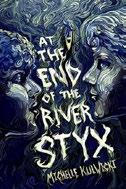
Two boys from different worlds find one another through grief. In Greece 499 years ago, 18-year-old Zan sacrificed himself to the Ferryman of the River Styx to save his mother’s life. His centuries spent leading souls to the Ferryman are nearly up when something unexpected happens a year before his servitude ends: He meets Bastian, a boy living in present-day Portland, Oregon, who’s deeply troubled by the untimely death of his own mother.
Zan has one job: to lead Bastian to the ghoulish Ferryman, who will devour his soul. But something about Bastian is different. Bastian’s friends and twin brother are determined to help him heal from the trauma of losing his mother. He keeps finding Zan in what initially seem to be recurring dreams, but as Bastian finds himself drawn further into Zan’s world (which is cobbled together from past souls’ memories), the two find their connection growing. Zan must decide whether he can sacrifice Bastian to the Ferryman and finally end his sentence— or serve for 500 more years. Bastian, meanwhile, must consider his own mortality. Told in alternating perspectives, this queer contemporary spin on Greek mythology is a thoughtful portrait of grief and healing. Bastian’s guilt and sadness are palpable and will resonate with readers as they cheer him on. Bastian is racially ambiguous; his mother had “warm ochre” skin. Poignant and hopeful. (Fiction. 14-18)
Lockette, Tim | Triangle Square Books for Young Readers (240 pp.) | $18.95 Sept. 17, 2024 | 9781644213988
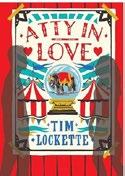
When a dedicated animal rights activist gets between a hunky boy and his captive elephant, is heartbreak inevitable?
Fresh from the terrifying and terrific travails detailed in Atty at Law (2020), 13-year-old bisexual girl Atticus T. Peale is currently focused on persuading the authorities of her Alabama county to turn the local dog pound into a no-kill shelter. Her horizons are broadened by near-simultaneous meetings at the county fair with inscrutable, alluring Emory Mumbford and Elizabeth III, the sad-eyed old elephant he gently and lovingly tends on his family’s ranch. For Atty, it’s double love at first sight—but how will Emory respond to her sincere and principled need to see Elizabeth freed? And for that matter, what would “freedom” for an elephant raised in
captivity even look like? Into this poignant and funny tale of teen angst, Lockette weaves sensitive, reasoned considerations of both ethical and commonsense animal rights issues on the way to a court date, an imperfect but nontragic resolution, and a decisive split. As a parting gift for concerned readers, the author appends a tantalizingly brief interview with Katherine Meyer, director of Harvard Law School’s Animal Law and Policy Clinic. Atty, her dad, and Emory are white; Atty’s stepmother and little stepbrother are Black. Serious at heart, but as droll as it is demanding. (Fiction. 12-14)
Lutz, Leslie | Holiday House (320 pp.) $18.99 | Sept. 24, 2024 | 9780823454945

A teen psychic takes a mindbending journey to save his town. The Alvarado Hotel is calling to Quinn O’Brien, his best friend, June Pilsner, and his crush, Selena Garcia, in their dreams. This long-abandoned property was once the glamourous lifeblood of Gypsum, Texas (population 1,021), drawing in Hollywood starlets and directors. Quinn is trying to balance his growing feelings for Selena, grief over his grandmother’s death, and the looming foreclosure on his family’s land. As he tries to take on more fortunetelling clients to pay the bills, Quinn’s ventures into the darkness beyond become more and more dangerous. Something—or someone—is beckoning to him and his friends from the deep, asking to be freed. Lutz ably captures the desperation of adult problems being foisted onto young shoulders. As Quinn grapples with Gram’s death, he also faces the repercussions of his growing psychic gift, both from the supernatural and from his friends, who are growing concerned about his powers. The historical plotline and the journal entries threaded throughout the story are illuminating and entertaining. As the teens try to piece
together what’s happening and save the day, horror fans will root for them to succeed while cringing at each false step they take. The evocatively remote setting will keep readers immersed in the moment. Quinn and June read white; Selena is cued Latine.
An imaginative supernatural thriller novel set in a small town you won’t soon forget. (Paranormal. 14-18)
Meyer, Tracy Hewitt | BHC Press (274 pp.) $23.99 | Sept. 10, 2024 | 9781643974002 Series: Blackthorn Peak, 2

Months after their escape from the Blackthorn Peak Lunatic Asylum, Shaun and his friends find themselves once again threatened by the Agency in this sequel to Generation Annihilation (2023).
Their fear about which authorities may be partnered with the Agency in its goals of experimenting on and eliminating all teenagers has kept the group isolated in Shaun’s grandfather’s cabin. Hiding is especially critical, given Shaun’s and most of the others’ criminal backgrounds. Yet, despite their anxieties and Shaun’s growing hopelessness, they may be the only ones who can keep the Agency and its nefarious leader from wiping out their entire generation once operations start up again at the asylum. Lacking even the initial intrigue of the first book, this sequel struggles to find its motivation until the final quarter, wasting time juggling an unnecessarily large cast via the same jerky plot developments and over-reliance on repetition that plagued the previous volume. Shaun’s “swell of pride and justice” over murdering his abusive stepfather, as well as his violent fantasies, together undermine the baseless faith the others have in his supposed altruistic tendencies. Meanwhile, the exaggerated villainy displayed by the Agency’s head disrupts any suspension of disbelief. A last-minute monologue and tedious
reveals add needless drama that fails to feed either plot or characterization before the soap opera–worthy epilogue. Central characters are cued white. A poorly executed and dragging follow-up that further squanders the first book’s potential. (Thriller. 14-18)
Miyuli | WEBTOON Unscrolled (320 pp.)
$18.99 paper | Sept. 3, 2024 | 9781998854837
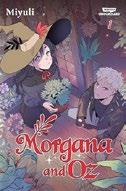
A witch and a vampire-turnedcat team up in this compilation of entries from a popular WEBTOON comic series. Morgana only wants her magic to not be so erratic; it’d be nice to actually get a spell right once in a while. Her family has more ambitious aspirations, however: Her mom wants peace between the witches and a dangerous vampire clan. Their relationship has been tense for some time, but when an attempt at conciliation goes south, the problems escalate. In the chaos, Morgana accidentally transforms one of the vampires, Oz, into a little white, red-eyed cat. Turning him back, when she can’t even manage making tea, might be tough, and Oz’s clan thinks he’s been kidnapped and won’t let this go. Between possible traitors and a brewing war, Morgana must do her best to help Oz so she can help her family. As the stakes rise, vampires start becoming sick with a craving for witches’ blood, thanks to a curse supposedly inflicted on them by Morgana’s family. Morgana doesn’t know what to do, or whom to turn to. Could a mysterious new arrival be an ally? The adorable full-color art in contrasting tones of purples, rich browns, and pastels portrays scenes that are at times laugh-out-loud funny. Morgana is a sweetly naïve protagonist, and the intrigue is engrossing.
An adorable adventure with a thrilling ending: Readers will be excited for the next volume. (Manga. 13-18)
Grapples with fear, shame, self-doubt, identity, and love.
TRIGGER
Moore, C.G. | Little Island (208 pp.) $12.99 paper | Sept. 10, 2024 | 9781915071538
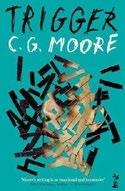
In the wake of a life-altering night, a gay teen in the British Isles fights for survival, closure, and justice. Jay Walker awakens in a park covered in blood and bruises; he was drugged and raped, but shadows cloak his memory of what happened. He and his boyfriend, Jackson, were at the club. Why did Jackson leave him? Why won’t he answer Jay’s messages? “Stats help me understand,” Jay says in his first-person verse narrative, but they offer the grim likelihood that someone he knows was responsible. Still, these numbers are only “maybes and possibilities”: Jay needs to know the truth. Confused by his boyfriend’s behavior, he goes to Jackson’s house, where he finds evidence that leads to even more questions—a Mac and a Rolex. How could a boy with a struggling single mum afford these expensive items? The poems’ short lines capture the fragmented nature of Jay’s memories and the frantic frustration of his feelings. As Jay recovers physically, his parents and his best friend, Lau, surround him with support, but Jay feels out of place in his old life. He grapples with fear, shame, self-doubt, questions of identity, and his understanding of love. Therapy and a support group play important roles in his journey toward confronting what happened and discovering how to keep living. Most characters are cued white. A survivor’s story portrayed with honest heaviness and caring vulnerability. (author’s note, resources) (Verse fiction. 14-18)
Mount, Sara Rowe | ReferencePoint Press (64 pp.) | $33.95 Sept. 15, 2024 | 9781678208189

A succinct overview of the mental health crisis that many adolescents are currently experiencing. The book’s introduction explains the current struggles that many teens face due to the heightened stressors of the long-term effects of social media and the Covid-19 pandemic. Throughout the five concise chapters that follow, teenagers share their experiences with mental health distress, how they felt, and which resources (for example, therapy, talking circles, crisis hotlines, and open communication with a trusted adult) helped provide them with short- and long-term relief. Mount highlights several groups identified by public health experts as being at higher risk for mental health distress: LGBTQ+ teens, teens of color, and teenage girls. The research she cites provides value by driving home points from credible sources—the Centers for Disease Control and Prevention, the U.S. surgeon general, and the American Academy of Pediatrics—all supported with quantifiable data. The text includes suggested talking points, such as what to say to a friend during a tough time: “How can I support you right now?” and “Would you prefer to talk right now or could you use a distraction?” This book is incredibly valuable and in the right hands could be lifesaving. Stock photos showing racially diverse teens punctuate the text, along with sidebars that contain additional useful information.
A valuable, empathetic guide for teens who need information, whether for themselves or for peers, on mental health distress. (source notes, resources and information, index, picture credits) (Nonfiction. 12-18)
Murphy, Cynthia | Delacorte (304 pp.) | $12.99 paper Sept. 24, 2024 | 9780593809662

Letters from an unknown sender lead a transplanted English girl toward the answers in an old murder case. Despite some misgivings, Paige Carmichael is determined to make the best of her new life in the U.S., including finding things to love about the very old, very big, potentially haunted house her dad insisted on. The pool and the view of the Atlantic from her bedroom are nice, as are Madison and Carter Garcia-Moore, the twins who live on the same street and who quickly take Paige under their wing. A poster for a local memorial event for the victims of a 1990s killer known as the Shorehaven Ripper sparks Paige’s raging true-crime obsession, to say nothing of the ominous letter that appears in her mailbox suggesting that something important may be hidden in the walls of her house. That something turns out to be the diary of one of the murdered girls, which Paige must quickly use to untangle her family’s connections to the story before she becomes a victim herself. Though Murphy covers a whole lot of ground with the topics in this novel, everything fits together smoothly for an enjoyably confounding mystery. The incredibly fast pace doesn’t leave much room for character development, though the characters are complex and well balanced enough and with mostly believable motivations, making this an excellent choice for voracious teen thriller readers. Main characters read white; the twins have two moms.
Compellingly puzzling. (Thriller. 13-18)
Nazemian, Abdi | Harper/ HarperCollins (320 pp.) | $19.99 Sept. 10, 2024 | 9780063339637

A teen boy finds himself after a tragic loss.
Iranian American high schooler Kamran Khorramian’s life is in upheaval. Two years ago, Kam’s boyfriend, Ash Greene, who’s cued white, disappeared during a camping trip in Joshua Tree National Park. Everyone, including Bodie Omidi, Kam’s lifelong best friend (who’s also gay and Iranian American), wants him to move on, but he just can’t let go—not as long as he believes that Ash could still be alive. The narrative structure engagingly alternates between Kam’s freshman and junior years. In freshman year, Kam and Ash meet and bond over a shared love of the music of Lana Del Rey, but Ash’s unpredictable behavior makes their relationship hard. In junior year, Kam struggles with grief, racially charged ostracization, and figuring out his future. Kam also has to learn to cope with the impact of substance abuse in his family, finding support and understanding in Alateen during junior year. Both timelines converge in an emotional denouement. The storytelling relies heavily on Kam’s amnesia surrounding the night of Ash’s disappearance, which feels cliched, and the ending is sweet but feels tonally disparate from the rest of the book. Ultimately, however, many of the novel’s elements come together to create a poignant and enjoyable whole that sensitively but honestly
explores relationships, grief, identity, and addiction.
A bittersweet and sincere coming-ofage story. (author’s note) (Fiction. 14-18)
Phenix, Akana | Blackstone (458 pp.)
$17.99 paper | Aug. 6, 2024 | 9798212913577
Series: The Empire Wars, 1

Two young women, trapped on different sides of a tyrannical regime, become connected through their shared oppression.
Eighteen-yearold Coa Rangecroft has been forced to enter the Great Hunt, an annual tradition that takes place over the course of seven days in the totalitarian Arctic nation called the Allied Force. Soldiers target and hunt down the foreign participants, and the family members of anyone they kill are publicly executed afterward. Few of the hunted even survive until the fifth day, but Coa is harboring a secret: She’s a fireborn who possesses magic, a rare ability among the world’s remaining population. Fellow captive Hazen Creed appears to be onto Coa’s powers, and, despite being a fellow Great Hunt competitor, he also seems to be looking out for her. Coa finds she may have yet another ally in Ife Størmbane, a princess from the Makari-African Empire who’s married into the most powerful family of the Allied Forces; she has plans to do far more than just save Coa. Debut author Fenix’s poignant storytelling will evoke strong emotions from readers. While the story contains a lot of exposition, the robust
Has an eeriness that’s complemented by quippy jokes and gaming references.
SUCH LOVELY SKIN
worldbuilding is supported by the alternating first-person perspectives of Coa and Ife. Most characters are white; Ife is dark-skinned. An absorbing fantasy novel with dystopian themes that explores human endurance in its varied forms. (author’s note) (Fantasy. 14-18)
Ramos, NoNieqa | Carolrhoda Lab (368 pp.)
$19.99 | Sept. 10, 2024 | 9781728492322
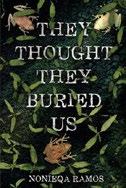
A sophomore is about to find out what happens when a dream school is really a nightmare. Yuiza Rivera-Vásquez (she / her and they / them) is accepted to a prestigious, predominantly white, girls’ boarding school, Our Lady of Perpetual Mercy, which is located upstate, hours from their home in the Bronx. She would rather stay home and make horror movies with her friends, but Mami is insisting she go and pursue a bigger future. After arriving on campus, it doesn’t take long for Yuiza and her mom to notice the statues of Christopher Columbus, Lewis and Clark, and Robert E. Lee, not to mention the school motto, “Manifest your destiny,” and the students of color doing service jobs for work-study. At night, wrapped in a Puerto Rican flag their mother gifted them, Yuiza starts to have dreams that point to the school’s long, sordid past. At times, the story is framed like a movie script (complete with alternate endings) from one of Yuiza’s beloved horror films. Against a mildly supernatural backdrop, Ramos demonstrates and comments on the worst elements of white supremacy, past and present. The claustrophobic setting is well executed, the social commentary around historical injustices is compelling, and the well-drawn characters include strong Puerto
Rican representation. The messaging isn’t always seamlessly incorporated into the story, however, and experienced genre readers may delight in—or feel less than surprised by—the horror tropes that the final act leans heavily into.
Strongly atmospheric but wavering in its execution. (Horror. 14-18)
Rice, Luanne | Scholastic (320 pp.)
$18.99 | Sept. 17, 2024 | 9781338739534

In the latest from bestseller Rice, a teen searches for her sister’s killer with the help of his latest victim. It’s been eight months since Oli’s sister, Eloise, was murdered, and the police still haven’t found her killer. Keen naturalist Oli takes solace in spending time outdoors alone and with her friends from the school nature club, including her crush, Matt. While she’s visiting the site where Eloise’s body was found by some hikers, Oli ends up rescuing Iris, a girl who’s been buried alive in the same location. Iris’ memory is spotty, but she knows that the kidnapper still has her sister, Hayley, and that he’ll kill her if they go to the police. So the girls team up to find Eloise’s killer and rescue Hayley themselves, traveling along the Connecticut shoreline. Along the way, they find connections to the ghostly Sibylline sisters, who allegedly were oracles nearly a century ago. After a leisurely start, the plot ratchets up to breakneck speed. The killer’s unusual motive, ample information about the flora and fauna of southern New England, and a whisper of the supernatural all add interest to this story about the power of sisterhood. Main characters present white.
A fast-paced thriller with particular appeal for fans of nature and family stories. (Thriller. 12-18)
Schlote-Bonne, Tatiana Page Street (304 pp.) | $18.99 Sept. 17, 2024 | 9798890030764
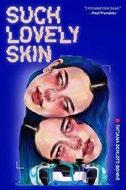
The game knows her darkest secret—and it might be trying to kill her.
Wracked with guilt over her little sister’s recent death, 17-year-old Vivian Reynolds leaps at the opportunity to play an online escape room horror game called Locked In that was anonymously emailed to her. In hopes that her return to streaming will help financially support her parents, Viv starts a practice playthrough by herself to test the waters. When the game asks her to confess a secret, Viv admits that she killed her sister. Uncanny events follow in the aftermath of her surreptitious confession, resulting in her parents and peers losing trust in her. With the help of Ash, a fellow social outcast, Viv becomes sure that a demonic clone is trying to ruin her life by committing heinous acts in her name. Told in Viv’s first-person perspective, the story has an eeriness that’s complemented by quippy jokes and gaming references. The plot twists are numerous and satisfying, helping to build suspense as readers try to figure out the mystery. Classic horror imagery is paired with a flawed protagonist who reckons with the guilt and grief caused by her habit of lying and her obsession with streaming. Viv’s mom is white, and her dad is Japanese American; Ash reads white. A fast-paced supernatural mystery ideal for fans of horror games. (content warning) (Horror. 15-18)

Sheen, Barbara | ReferencePoint Press (64 pp.) | $33.95 Sept. 15, 2024 | 9781678208042

Evidence of the many ways that immigrants are not a threat to, but rather a mainstay of, the U.S. economy.
Backing up the subtitle’s claim from the start, Sheen begins with two easily read pages of infographics on areas including taxes and spending, entrepreneurs, occupations, and the wage distribution of immigrants and native-born workers. Although she provides many relevant examples of documented immigrants’ contributions to U.S. productivity and prosperity, she also cites research showing that undocumented immigrants pay far more into the system than they extract from it: “over $30 billion in federal, state, and local taxes annually” that support public benefits they can’t utilize. Immigrants often perform “messy, physically demanding jobs” that otherwise would go unfilled by native-born workers. A brief history of immigration—and anti-immigrant abuses past and present—precedes an overview of immigrants’ contributions to building, revitalizing, and maintaining strong communities. The third chapter explores immigrants’ cultural contributions, explaining how they’ve both enriched the culture and stimulated the economy, for example, through celebrations like St. Patrick’s Day and Lunar New Year, as well as through ethnic food industries and pop culture. In the chapter entitled “Shaping the Future,” Sheen cites the examples of Jan Koum, the Ukrainianborn founder of WhatsApp, and Eric Yuan, the Chinese-born creator of Zoom, among others. Abundant color photos show diversity in race, gender, and religion.
A well-written, thoroughly supported, and accessible presentation of
moving, and beautifully written.
immigrants’ essential economic role. (picture credits, source notes, for further research, websites, index) (Nonfiction. 12-16)
Talley, Robin | Little, Brown (384 pp.)
$18.99 | Sept. 24, 2024 | 9780316565318

A Prohibition-era murder mystery with queer coming-ofage themes. Gertie is a senior at the Washington Female Seminary, a finishing school for the daughters of political bigwigs located in Washington, D.C.’s Dupont Circle. One night, alongside her friends Milly and Clara, Gertie sneaks out to a speak-easy, which is promptly raided by officers from the dry squad. The girls escape, and when they return to the seminary, they find that their beloved headmistress, Mrs. Rose, is dead, reportedly from consuming liquor tainted with poisons by federal agents to discourage drinking. Now the seminary may be closed due to the scandal, and Gertie is determined to clear Mrs. Rose’s reputation and save her school. The streets of the nation’s capital in 1927 come alive through Talley’s well-researched descriptions. Gertie and her friends navigate streetcars, cabs, and wintry walks while trailing a slew of mysterious characters across historic neighborhoods. Amid these investigations, Gertie often finds herself distracted; she can’t help contemplating the behaviors of certain speak-easy patrons, the so-called pansies and violets. Perhaps more distracting are Milly and Clara, the friends Gertie has suddenly realized are both quite alluring. Fans of Talley’s lesbian histories will enjoy her latest, and the page-turning mystery will
appeal to new readers. Most characters are white; the story explores Clara’s Jewish identity in a predominantly Christian environment.
A compelling mystery grounded in a well-developed setting. (Historical mystery. 14-18)
Thao, Dustin | Wednesday Books (304 pp.)
$20.00 | Sept. 3, 2024 | 9781250762061

A grief-stricken Chicago teen finds solace in a meetcute romance. After his best friend, Daniel, passes away, Eric finds his life completely uprooted. Instead of attending his first year of college, he fills his days working to avoid his grief, first at a catering company, then in the box office of a prestigious theater. Through frequent flashbacks, Eric’s crush on Daniel plays out alongside their school trip to Japan, where he met the handsome Haru. The two spontaneously wandered together, attending a Star Festival commemorating forbidden lovers. Eric was devastated when he lost Haru’s phone number. Back in the present day, after his sister, Jasmine, announces that she’s leaving for Amsterdam, Eric spirals further. His only solace is Haru’s magical reappearance. As Eric spends time with Haru, he slowly regains his interest in life and filming the world around him. The novel unfortunately requires an immense amount of suspension of disbelief from readers. While the film references and the themes of family and love are intriguing, Haru’s presence detracts from the overarching exploration of grief, and the romance is meandering and difficult to believe in, although it does
offer an intriguing commentary on the meet-cute trope. Fortunately, the major plot twist manages to be completely surprising without feeling random, and it brings Eric’s character arc full circle. Eric is Vietnamese American; Daniel is Colombian and white, and Haru is Japanese. A genuinely shocking reveal isn’t enough to save this book. (Romance. 14-18)
Vidal, Juan | Holiday House (336 pp.)
$18.99 | Sept. 3, 2024 | 9780823457113

In Vidal’s YA debut, a grieving teen takes his father’s ashes on a healing journey to Colombia. Marcos Cadena’s life turns upside down when Papi unexpectedly dies in a motorcycle accident. On top of that, Marcos’ closest friends leave Miami the summer before junior year of high school, and he struggles to cope with his grief. But resourceful, athletic Marcos soon finds solace in writing poetry and in the magical realism he finds in his father’s old copy of One Hundred Years of Solitude by Gabriel García Márquez. Márquez lived in Cartagena, the city where Papi was born. Composed in verse, Marcos’ story is warmly studded with memories of his loving dad—from the way Papi danced while he cooked to how he taught Marcos never to start a fight but to always defend himself. When Ma takes Marcos and his sister to Cartagena to pay a final tribute to his dad, Marcos meets Camilo, a teen cab driver with a tragic past who shares his affinity for Nobel laureate Márquez. The boys become fast friends, exploring Cartagena and shooting hoops together— until a dark secret that Camilo initially hides from Marcos threatens their newfound bond, potentially putting both boys in danger. A responsible son, protective older brother, and caring friend, sensitive Marcos will win readers’ hearts as he tries to navigate the complexities of
both mourning and friendship with forgiveness and compassion. Heartfelt, moving, and beautifully written. (Verse fiction. 14-18)
Winters, Julian | Viking (352 pp.) | $12.99 paper
Aug. 20, 2024 | 9780593624425

After a disastrous public fiasco, a disgruntled African prince unexpectedly finds love, friendship, and himself. Viral video ranting about his country’s popular prime minister? Check. Public breakup with said prime minister’s son? Check. Ultimate betrayal by his best friend? Check. Despite his best efforts, 17-year-old Jadon, troublemaking prince of the beautiful island kingdom of Îles de la Réverie, feels like he keeps checking all the wrong boxes. Banished to Los Angeles to spend a semester at an elite private school, Jadon is desperate to rehabilitate his image, but he struggles to connect with his new classmates and continues to say and do unprincely things. All his efforts feel pointless until he meets pink-haired classmate Reiss Hayes, an aspiring filmmaker, one of the few other Black students, and someone around whom Jadon finally feels like himself. Reiss tempts Jadon to do the one thing he said he wouldn’t: date. Jadon is a likable but unfortunately opaque character: Winters skips or reduces to a single line some critical moments of potential insight into his inner life, flattening his character. As a result, the coming-ofage story and its related themes of Blackness, queerness, otherness, and belonging, although interesting, feel unevenly developed. The romantic and familial relationships, however, are highlights, as is the book’s rich racial and sexual diversity. The royal family’s reconnection journey is heartwarming, and Jadon’s relationship with Reiss
features cute moments, healthy communication, and a nice dollop of drama. Black, queer, royal romance wish fulfillment. (Romance. 12-18)
Zail, Suzy | Walker Books Australia (384 pp.) $19.99 | Sept. 10, 2024 | 9781760659394

A fictionalized adaptation for teens of the Holocaust survival story Zail shared in her self-published adult memoir, The Tattooed Flower (2006).
Switching between Australia in 1982 and Europe during the Holocaust, this work presents two distinct first-person narratives connected by one life. The late-20th-century storyline is a work of shallow realistic fiction about teenage Lisa, whose comfortable life is disrupted when her beloved father is diagnosed with amyotrophic lateral sclerosis. The World War II storyline follows Emil, a Jewish boy from Czechoslovakia who manages against all odds to live through multiple Nazi camps before eventually emigrating to Australia. Only Emil comes alive on the page; Lisa exists mostly as a collection of ’80s pop-culture references and feelings about her father’s revelations. Until his diagnosis, he never revealed his childhood experiences to her. Other characters, including Lisa’s Hungarian mother (whose own Holocaust story is barely mentioned), serve only as window dressing. And yet it’s impossible not to feel the palpable loss as Emil grows sicker and parcels out his past over the course of one Shabbat after another; his experiences (largely drawn from Zail’s father’s life) make the novel succeed despite its other flaws. Major characters are coded white; jarringly, given his own experiences with being dehumanized, Emil describes arriving in Australia and hoping “to spot a kangaroo or a black man with a spear.” An important but unevenly told story. (author’s note, Holocaust and ALS resources) (Historical fiction. 12-16)
Scholastic will publish Suzanne Collins’ Sunrise on the Reaping next March.
Suzanne Collins is taking readers back to Panem. Scholastic will publish Sunrise on the Reaping, the fifth book in the author’s phenomenally successful Hunger
SPONSORED CONTENT
Games series, next year, the press announced in a news release.
Collins kicked off her series in 2008 with The Hunger Games, a young adult work of science fiction featuring Katniss Everdeen, a 16-year-old girl in the dystopian country of Panem, who competes in an epic televised battle with other young people. The book became a massive bestseller, as did its two sequels, Catching Fire and Mockingjay, and a prequel, The Ballad of Songbirds and Snakes
The books spawned five film adaptations, with Jennifer Lawrence starring in the first four, and Tom Blyth and Rachel Zegler as the leads in The Ballad of Songbirds and Snakes
This review originally ran online July 21, 2023
A graphic novel takes the form of a teenage doodler’s diary in 1987.
Nick Pope’s family just moved across town, meaning he’s starting his sophomore year at a new high school with new classmates. So far, it isn’t going well. Nick has two purple birthmarks around his eyes, so he always looks as if he’s just been punched in the face. His new classmates call him Raccoon. At home, he has no one to talk to. His older sister, April, is away at college. His sixth-grader brother, Jamie, has already kissed a girl (something Nick has never done). Then Nick starts to make
some friends. There’s Preston, a music lover who always wears the denim jacket that belonged to his dead brother. There’s also Sharita, the pregnant girl he meets in study hall. Plus, there’s Coach Pierson, his accounting teacher who seems to pay him special attention, though Nick doesn’t know how he feels about it. Nick wants to be an artist and, with Preston’s encouragement, he is selected for a committee of six students to paint a mural downtown. But just as Nick begins to feel as if he’s found a place for himself, he learns there are downsides to any sort of relationship. Especially in
Sunrise on the Reaping will also be a prequel to the original novel, but will take place after The Ballad of Songbirds and Snakes. The new book, Scholastic says, “will revisit the world of Panem twenty-four years before the events of The Hunger Games, starting on the morning of the reaping of the Fiftieth Hunger Games, also known as the Second Quarter Quell.”
“The story…lent itself to a deeper dive into the use of propaganda and the power of those who control the narrative,” Collins said in a

For reviews of the Hunger Games books, visit Kirkus online.
statement. “The question ‘Real or not real?’ seems more pressing to me every day.”
Sunrise on the Reaping is scheduled for publication on March 18, 2025.—M.S.

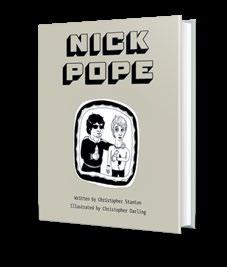
high school, where things start to get very adult very quickly. Stanton’s writing perfectly captures Nick’s angsty teenage insecurity. Here he describes a missed connection with a pretty girl at a mall: “I felt the back of my neck get all prickly” and then “she turned and looked at me. She glanced at me like I was a dead mouse. That’s how a lot of people look at me. I smiled at her like I practice in the mirror. I pictured us on the dance
Nick Pope Stanton, Christopher; illus. by Christopher Darling Amazon Digital Services 142 pp. | $17.60 | May 5, 2023 9798393139346
floor together and a Billy Joel song playing....Then she walked past and it was all over.” Just as compelling are the blackand-white illustrations by Darling, who died in 2018. They delightfully replicate the drawings a creative loner would make in his journal. By turns gritty and sweet, the book deftly captures the confusion of adolescence.
A finely executed, wonderfully evocative tale of teen discovery.







GRAPHIC NOVELS LEND themselves to depicting the frenzy of combat. Illustrators can give readers an aerial shot of colliding sides and then zoom in on, say, a bayonet and a body, showing the gore and splatter with a Tarantino-esque clarity. The following editors’ picks evoke the bloodshed of battles in fields and cities, from a cannibalistic cult operating during WWI to a sibling duo navigating the Russian Civil War to a Black superhero/DEI officer looking to exact justice.
Sam Freeman and Sam Romesburg’s Hound , illustrated by Rodrigo Vásquez and with lettering by Justin Birch, is set during WWI and adds a grisly supernatural element. A young British private is sent to the front to join the Hounds, so called because of the snouts of their omnipresent gas masks. The private soon learns of their wartime sport: The Hounds release tortured captive German soldiers, morph into semi-human monsters, then hunt and devour the men. “This stark,
unsettling story is told by Freeman and Romesburg with confidently effective understatement,” says our critic in a starred review. “They seem well aware that excess verbiage is the enemy of mood. And that mood is greatly enhanced by Vásquez’s vivid, jittery, full-color artwork, full of scratchy line-work that underscores the gruesome horrors that Private Barrow both witnesses and perpetrates; as he’s told when he’s a boy, ‘In this life, we will hurt those that don’t deserve it.’ A visceral and neatly executed graphic parable of war’s dehumanizing power.”
Edenfrost, another wartime graphic novel with a supernatural twist, is set during the Russian Civil War. Amit Tishler’s story, illustrated by Bruno Frenda, follows Yuli and Alex, siblings desperate to reach their extended family in Kyiv while hunted by officers of the White army. Fortunately, the duo has a “monster made of rock and ice” whom they can summon to do their

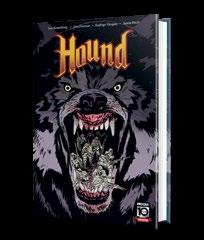
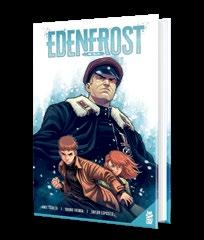
bidding. Says our reviewer, “Frenda’s realistic, full-color artwork…captivates, sometimes ably carrying the story alone, and rendering various fight and battle sequences with a cinematic flair—albeit with a level of gore that may not be suitable for younger readers. Avid comic-book fans will find that the overall style successfully captures the feeling of classic 20th-century war comics. An impressive, pulse-pounding start to a new series that will leave readers eager for another compilation.”
During a rash of kidnappings, Chris Withers, a former special forces soldier turned social psychologist, has noticed that only white people seem to get justice from the many working superheroes in Dale City. David Washington’s Black

Defender: The Awakening (illustrated by Zhengis Tasbolatov) charts Withers’ determination to deliver justice for all, creating an alter ego named Black Defender to do so. Our reviewer notes, “There’s nothing subtle or arch about Washington’s treatment of the topic, which actually works in the book’s favor; by the time Black Defender squares off with a clueless white superhero who has just reflexively rescued a crooked cop, the reader has totally bought in. Paired with excellent illustrations by Tasbolatov, this graphic novel more than delivers on the promise of its premise. A social justice–minded superhero for the Black Lives Matter era.”
Chaya Schechner is the president of Kirkus Indie.
In Reida’s mystery novel, a street in a tony Atlanta suburb acquires a well-deserved nickname: Murder Avenue.
Adelaide McKenzie can’t believe her good fortune: After growing up in a trailer park, she now resides with her handsome surgeon husband, William, in a huge white mansion that looks like a wedding cake, “the kind you don’t want to slice into because it’s too fancy to eat.” But happy as she is, she knows fairy tales aren’t real. Flaws and secrets, ranging from minor to major, abound among many of her neighbors, including Ray Willis (“There’s something almost reptilian about the way she blinks”); Helen Beecham, who waits each day for 4:00, “an acceptable
time for her first Moscow Mule”; adulterer Conner Boyle; homophobe Beverly Grant; racist HOA president Pam Muenster; and neo-Nazi Tripp Schulman. Faith Martin, earning money for college during her gap year, weaves in and out of the homes, doing housework and running errands for the residents.
After an extravagant party, two of those people are murdered. Faith is shocked to find that after the murders, there is no sign that such crimes occurred (“Everyone wants to pretend nothing bad can ever happen in a place like this”).
But when the killings continue, tensions understandably ratchet up, as do accusations and media coverage. In addition to her

Reida, Sarah | Keylight Books | 320 pp.
$15.39 | $15.38 paper | April 30, 2024
9781684429639 | 9781684429646 paper
evil characters, the author also provides quite a lot of laughs, even as the body count ramps up. (When resident Soon-Li Jung opts for a home elliptical machine instead of a gym membership, the device is only used to hold wet laundry: “It might not help with her heart rate, but it can
dry six sweaters at once.”) The killings aren’t grisly and there are some sweet bits, but rough language keeps this mystery from being strictly cozy. A fast pace and a strong ending are welcome features. Immersive and compelling—this neighborhood’s a nice place to visit, but you wouldn’t want to die there. 144
Reida
Pete
and Suzie
Ahearne, Samantha | Illus. by Julie Sneeden | Orion (36 pp.) | $26.76 Oct. 22, 2023 | 9798987414002

A pelican and a seagull become unlikely friends in Ahearne’s picture book.
Ever since the “bird Olympics,” during which a seagull stole a fish from a pelican mid-performance, pelican-seagull relations have been fairly hostile. Pelicans are quiet and love to do yoga; seagulls are loud and constantly partying. One Saturday, Suzie Seagull’s brother dares her to speak to the pelicans during one of their yoga sessions. She finds that they’re very welcoming and excited for her to join their workout. A pelican named Pete introduces her to his mother, the instructor, who envelops her in a big hug. The other seagulls are puzzled by Suzie’s disappearance and panic at the thought that the pelicans have eaten her. Then Suzie reappears to admonish her peers after having had a wonderful time. She and Pete become the best of friends. Ahearne’s debut picture book is silly, thoughtful, and meaningful, by turns. Its lesson about overcoming one’s preconceived notions to create lasting friendship is invaluable, although its delivery is confusing at times. For example, the narrative takes a brief turn into explaining chakras in such detail that readers may wonder what the book’s primary subject is intended to be. Sneeden’s full-color cartoon images burst with movement and energy, especially when the seagulls are anxious about Suzie. A well-illustrated story of rivalry and friendship for young readers.

Arnold, Rebecca | Greenleaf Book Group Press (242 pp.) | $24.95 June 10, 2024 | 9798886451856

Leadership and executive coach Arnold offers heart-centered advice for creating a purposeful life.
The author recounts a career journey that included earning a law doctorate from Northeastern University in 2004, working with the U.S. Department of Education as a presidential management fellow, and choosing to be a full-time, stay-at-home parent. This depth of her experience shows in her self-help book, which relates her approach to building a life of meaning. Arnold aims to help her own clients realize their potential and offers some insights into her process. The concept of peace is at the core of her method: “internal peace,” situated in the body; “existential peace,” defined by one’s gifts, values, and purpose; and “relational peace,” which is attained through creating connections with oneself and others. She addresses each category in separate sections, further broken down into chapters, each including exercises and synopses of salient points. (Arnold suggests that the best way to use her book is to move mindfully from start to finish, but the summaries suggest that she probably knows that at least a few readers won’t follow that advice.) The first third of the book is dedicated to paying attention to one’s body, developing somatic techniques for learning from physical unease, and using movement to avoid experiencing self-defeating emotional states. In the section on cultivating existential peace, Arnold effectively encourages readers to let their knowledge of their own mortality help to clarify what they want for themselves, to learn
from failure, and to make confident decisions in challenging situations— all of which are essential to developing good relationships with others. While aficionados of self-help literature will understand that Arnold is building on the work of other writers, her lessons on the usefulness of reflecting on one’s impending death are unusual in a book directed at leaders (and would-be leaders). The author also acknowledges that achieving success isn’t a purely personal matter but, rather, one that’s circumscribed by systemic barriers like sexism, racism, and antigay sentiment, which is also a notable approach. A wide-ranging and impressively holistic approach to achieving personal and professional success.
Brady, Hollis | Palo Alto Publishing (272 pp.) | $14.99 paper April 6, 2024 | 9798987727720
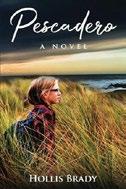
In Brady’s novel, four young people search for a home in a place they no longer recognize. Fourteen-yearold Hilde Sabin’s life is turned upside down when her mother moves the family from Wisconsin to Pescadero, California, without her father. Changes are happening faster than she can adjust to them, and even protective older brother Ethan becomes distant, so she finds a new home in the community with the local pastor, who helps protect and provide for the undocumented workers of Pescadero. She also grows closer to Gabriel, the farmhand her mother hires, who saves every dollar with the goal of helping his younger brother, Joaquín, cross the Mexican border into the United States. Hilde’s nickname is “Scout,” an apparent reference to To Kill a Mockingbird ’s Scout Finch; Ethan calls her this at key moments in the narrative, highlighting the importance of love and tolerance.
Readers also follow Joaquín as he struggles to survive the desert, experiences a detention center, witnesses death, and runs from corrupt “coyotes” who prey on desperation. Brady treats heavy topics with gentle care while not shying away from hard realities, as when one coyote tells Joaquín, “It’s better they deport you than scrape your bones up off the desert floor.” The author allows readers to experience the emotional beats while also maintaining a fast pace, even during the most difficult moments. At one point, Ethan tells Hilde, “It just seems like to do the right thing, sometimes you gotta do the wrong thing”; each of the characters find themselves forever changed after doing “the wrong thing,” and readers are right there with them.
An earnest, honest, and engaging tale of broken and repaired families.
Callaro, P.A. | Epigraph Books (187 pp.) | $16.95 paper | March 1, 2024 | 9781960090522

Ne w York City and the wide range of people who call it home are at the center of the 12 stories in Callaro’s collection.
In “A Seduction of Oleanders,” a young woman from Vermont, who’s been transformed from a “country rube to an adroit city navigator” by four years at New York University, battles with her mother about returning to her home state. “The Derev’ya Social Club” sees Russian émigrés in a cafe in Brighton Beach, Brooklyn, gossiping and nibbling biscuits while images of “Stravinsky, Plisetskaya, and Gorbachev” look on from the walls; after years of friendship, how well do the émigrés really know each other? “The Cold Room” ventures back to 1974, as a straitlaced 16-yearold boy from a similarly straitlaced family gets a job at a supermarket, only to find that the rules of adult life aren’t quite as clear as he’d imagined. In “Uncle John,” Julian Serra, a “native
An often vivid collection of urban tales that’s full of memorable characters.
New Yorker with no interest in mock pleasantries,” heads back to his home city after years in California; he’s forced to confront his own abrasive nature as he lends a hand to an elderly and astute family friend. These and the other tales in Callaro’s collection feature believable and distinct characters; for instance, it’s easy to imagine Julian’s temper flaring as he berates waitstaff, as well as his compassion emerging for an old man. However, other characters’ backgrounds are relegated to dry exposition, as in “The Derev’ya Social Club,” in which Alexi’s father is vaguely described as “a man of culture who always carried some book of poetry in his suit pocket.” Still, the stories often contain keen insights, as when the boy from “The Cold Room” is left to ponder: If life’s rules are so often “ephemeral notions to be discarded,” then what, if anything, is worthy of trust?
An often vivid collection of urban tales that’s full of memorable characters.
Chhay, Tha & Matthew Raudsepp BookBaby (212 pp.) | $17.76 paper Feb. 7, 2024 | 9798350934571

Chhay and Raudsepp tell the true story of a refugee’s flight from Cambodia to the United States. Chhay was 9 years old when the Khmer Rouge came to power. Led by the ruthless Pol Pot, the regime would kill two million people during its brief reign, leaving
Cambodia in ruins. Like all other city dwellers, Chhay and his family were forced to relocate to the countryside, where they labored as farm workers under the threat of death. They were the lucky ones; former government workers, educated people, and members of ethnic minorities were simply killed. When the regime was overthrown by the Vietnamese in 1979, Chhay’s immediate family reunited in their home city, but life did not return to normal. After the fall of the Khmer Rouge, Chhay recalls, “We knew we were free from that horrible village life, but it was hard to release the shackles that had been implanted in our minds. There was no structure or guidance, just our fight to stay alive, and we did not know what way of life lay ahead for us.” This memoir primarily recounts Chhay’s life following the Khmer period, a time during which he traveled the country as a boy merchant, fled across a mine-strewn border to Thailand, spent nearly six years in a refugee camp, and eventually made his way to a new life in Seattle. The authors capture, in Chhay’s understated voice, both the nightmarish landscapes of war and the new, unknown world of America: “I was amazed as I-5 went right alongside several tall buildings of glass and steel that reached way up into the sky. I had never seen such huge buildings before. All the cars everywhere amazed me as well. There were so many new, modern, and beautiful cars everywhere.” The memoir serves as an affecting reminder that even after conflicts end and dictatorships fall, the suffering continues. Chhay’s chronicle is a story about finding a way to live in the aftermath of catastrophe when the old ways of living are no longer possible. A heartbreaking memoir, told with restraint, of oppression and its aftermath.
Christie, Emmie | Self (294 pp.) | $10.99 paper | Feb. 6, 2024 | 9798988990512

A shape-shifting fox fights to keep the planes of existence connected and save the innocent from a malignant evil in Christie’s debut YA fantasy novel.
Saida is a shape-shifting fox (“foxan”) who has the ability to travel between planes of reality, each one related to a specific sense. For centuries, the 300-year-old Saida has kept the planes vibrant and closely connected by transplanting magic between the worlds. But now the worlds are dying—the magic is inexplicably being drained from the once-vibrant sensory planes. When the foxan meets Alesio, an amateur singer in the Sound realm who’s half-deaf in one ear, she knows immediately that he is special; his voice is literally magical, but he’s afflicted by “overgrown magic.” Before Saida can trim his excess sorcerous energy, they become entangled with a monstrous being Saida calls Watthe, a creature who’s obsessed with consuming magic— especially Saida’s. With Alesio as her unintended companion, Saida must figure out a way to stop the monster before the worlds become separated forever and all magic is lost. While the uniqueness of the story’s worldbuilding and magic system is noteworthy, it’s the thematic threads throughout that make this novel compelling, particularly for young readers: Saida has been hurt in a previous relationship—she is
“fragmented,” just like the sensory planes. (And though she is 300 years old, she has a teenage mentality and naïveté.) During her adventure with Alesio, she discovers not only her inner strength and her self-esteem, but also what love truly means: “Love isn’t about cages, or about someone forcing you to love them back. That’s selfishness. Love, real love, is about helping the other person because you want to. Because you care about them, and that’s all that matters.”
A sweet fantasy adventure that will resonate with YA readers.
Dingus, Peter | Speculative FictionReview (329 pp.) | $16.00 paper Jan. 14, 2024 | 9798989220007
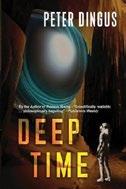
In Dingus’ SF novel, a ruthless company that controls Earth risks war with an alliance of outer-planet colonies over control of an alien sphere.
The author sets this space-faring tale in the year 2240, well after Earth has been taken over by the amoral, profit-driven mega-capitalists who ruined it. A Saturn Commonwealth of human colonies in deep space maintains a free democracy. Miner Serena Roe works on Commonwealth territory; she was once a forced-conscript in the hated company’s military wing, and her body still carries advanced cybernetics, which were supposedly deactivated after she received a discharge for refusing to commit atrocities against Mars labor-union
A sweet fantasy adventure that will resonate with YA readers.
rebels. Serena is still employed by the same company, and on duty belowground on Saturn’s largest moon, Titan, when she witnesses a deliberate explosion and survives an assassination attempt. It turns out that a ruthless company executive has learned of “the artifact”—an uncanny, physics-defying alien sphere under Titan’s surface. Intending to weaponize the object’s technology, the company sends warships to seize the Commonwealth land, as the artifact itself seems immovable. Meanwhile, Serena finds herself drawn to the sphere, as her supposedly offline implants curiously respond to it—and she hasn’t forgotten that “somebody wants me dead, me in particular.” Dingus includes many familiar ingredients in this first-contact SF scenario; the sphere, for instance, calls to mind Arthur C. Clarke’s “monolith” in 2001: A Space Odyssey (1968). However, this story becomes more of a military-intrigue thriller as murderous forces of the company go up against the outgunned but resourceful fleet of the Commonwealth—space-born folk who, à la Robert A. Heinlein’s work, have become a wiser culture than the materialist bullies back on Earth. Their conflict provides nail-biting moments, almost elbowing aside content about the wondrous alien whatsit and its purpose, which may remind readers of Carl Sagan’s Contact (1985). Like Sagan and Clarke, Dingus is a scientist, and he brings a sense of verisimilitude to the unearthly epic without overwhelming the narrative with technological jargon; he also conjures a tough, sympathetic main character.
A savvy, mind-expanding outer-space tale that imbues a familiar premise with suspense.

For more Indie content, visit Kirkus online.
Dutton, Geoffrey | Guernica Editions (200 pp.) | $17.95 paper Sept. 1, 2024 | 9781771838986
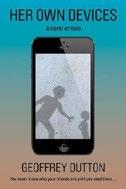
A single mother can’t leave her social conscience behind in Dutton’s suspenseful drama.
In this loose sequel to the author’s Turkey Shoot (2018), Anna Burmeister is in transition, raising her 5-year-old son, Ramadi, in Piraeus, Greece, while still mourning his father, Mahmoud, who was killed in the earlier book. Mahmoud isn’t as far away as she thinks, as he’s been denied entry to Paradise (“Where I find myself now is very strange and lonely, a plane I have all to myself. Perhaps this is perdition and I am doomed to isolation for eternity”). One day, Anna witnesses a young boy, Sami, being abducted. The kidnapper is freed in court by a judge, to the disgust of Anna, who has already organized the Children’s Protective League of Greater Athens in an effort to shine a spotlight on child trafficking. She recruits her hacker friend, Ottovio, to surveil the trafficker who got off, as well as his associates. Anna also assembles a motley crew of allies from media, social services, law enforcement, and her friend group to be ready to pounce on the traffickers when they make their next move. When Ramadi spies two men grabbing Naila, a young refugee girl, Anna rallies all her forces, marching on the traffickers’ hideout. Dutton has hit upon a novel method to construct a character: Anna is presented as a real person whose story has been lightly fictionalized by the author of the two books that feature her (by the time readers reach the end, they will likely have forgotten about this somewhat confusing conceit). Dutton introduces a ton of characters to keep track of, who tend to appear briefly and then vanish for dozens of pages. Waiting for an actual abduction seems to take forever, and it’s apparent to everyone but Anna
which side a cop whom she believes to be corrupt is really on. The preceding novel was Mahmoud’s story—this book is Anna’s tale, and the anarchist is appropriately making up her life as she goes along, leading with her heart. An urgent crusade to keep children safe drives this colorful, fictional biography.
Evans, Vyvyan | Nephilim Publishing (400 pp.) | $14.99 paper | May 7, 2024 9781739996246 | Series: Songs of the Sage, 2

The second installment of Evans’ Songs of the Sage series continues its narrative of a future society divided by IQ scores. This genreblending story—equal parts apocalyptic SF, arcane mystery, and mainstream thriller—is set in the early 22nd century, when the world’s population is separated into social classes based on intellect, with the lowest labeled the “Unskills.” A great many people fall into this category, and they’re “uncertified for work”; in an increasingly automated world run by artificial intelligence, some feel that Unskills are “useless eaters” holding humankind back from a glorious destiny. When a global pandemic quickly afflicts more than a billion people—all of them Unskilled—High Commissioner Lilith King, Interpol’s Special Representative to the United Nations, is brought in to investigate. King, whose own family line is murky, has unexplained powers that allow her to detect powerful beings—and she uses them to begin to unravel a nefarious conspiracy that, if successful, could lead to “the single greatest act of genocide in the history of the world.” Accompanied by Dr. Kace Westwood—whose Unskilled brother was murdered by radicals—she embarks
on an investigation that leads them from the catacombs underneath Paris to the rainforests of South America to enclaves in the Swiss Alps. What they uncover is unimaginable, involving doomsday cults, interdimensional rifts, and alien invasion. Grand-scale storytelling of this type is immensely difficult to do well, but Evans masterfully twists together multiple storylines with ease. The pacing is relentless throughout, as is the action, with jaw-dropping set pieces that rival any in a Mission: Impossible movie. But the two elements that make this novel stand out are its deep character development and its thematic profundity. Evans portrays Lilith so insightfully—especially her brutal backstory—that readers will feel a close connection to her, and the novel’s not-so-subtle commentary on the dangers of blind faith in technology and authority is powerful indeed. A truly extraordinary SF saga of epic scope.
Fish, M. Steven with Laila Aghaie Rivertowns Books (370 pp.) | $34.95 $19.95 paper | May 14, 2024 9781953943538 | 9781953943521 paper
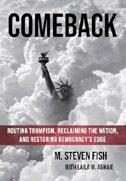
Fish and Aghaie chart a path to defeating Trumpism in this nonfiction book. On November 9, 2016, Fish recalls following the news of Donald Trump’s presidential victory: “I collapsed onto the couch, spent and dejected.” His wife, co-author Aghaie, reminded him that his “life’s work has been the study of democracy” in faraway places as a political scientist whose research had brought him to the front line of Ukrainian coal workers’ strikes, Solidarity-infused church services in communist Poland, and whispered
harrowing narrative of a difficult existence.
METTE HANSDATTER
interviews in dictatorial Uzbekistan—and that he now had “the responsibility, the privilege, of fighting for democracy” in his home country. The book begins with a somber introductory piece, “Democracy on the Line,” that surveys the state of the contemporary Republican Party. The authors’ cogent analysis argues that ideological conservatism in itself is not a threat, noting that Republicans from Ronald Reagan to John McCain were “far more consistent God-and-country conservative than Trump” in their tax policies, spending on social programs, and skepticism of big government. Ironically, per the book, many “genuine conservatives,” such as David Brooks and Tom Nichols, have left Republican ranks as the party has fallen under the spell of authoritarian Trumpism. Beyond the scathing introductory survey of Trump’s grip on the Republican establishment, the book focuses on the Democratic Party’s tepid response, which has been unable to mount a compelling countermovement to rid American politics of, in the authors’ view, the xenophobic, violent, and antidemocratic ethos of Trump.
Divided into four parts, the book first surveys today’s politics, rejecting common myths that dominate the “Standard Story” of contemporary narratives with chapters that argue that fears of economic decline or constitutional flaws like the Electoral College are not to blame for our democratic crisis. Part 2 explores the Republican obsession with “a high-dominance political style” (exemplified by their glee when Trump “owns the libs”) that, per the authors, thrives on divisive rhetoric, eschews compromise, and normalizes coercion and cruelty. This
approach is contrasted with, in the authors’ estimation, the ineffective, low-dominance style deployed by Democrats, whose “pathologically risk-averse and poll-driven” approach means that they refuse to meaningfully engage with any politically difficult, hot-button issues (aside from abortion). Fish and Aghaie assert that, for many Americans who don’t closely follow politics, it’s difficult to see the Democratic Party as a vibrant, fresh, and determined alternative. Part 3 of the book centers on the necessity of Democrats to retake the mantle of patriotism from Republicans by championing a “National-Democratic Narrative” that juxtaposes American democracy against the authoritarian, nativist rhetoric of Trumpism. The book concludes with a collection of historical vignettes and primary source excerpts written by America’s greatest pro-democratic voices, reminding readers that a central aspect of U.S. history has been the expansion of democracy at both the grassroots and national levels. Those profiled include Black activists like Frederick Douglass and Mary McLeod Bethune (whose acclaimed 1939 speech, “What American Democracy Means to Me,” concludes the book) and U.S. presidents from Franklin Roosevelt to Ronald Reagan, whose eloquent defenses of democracy stand in stark contrast to Trump’s actions. A professor at the University of California, Berkeley, Fish displays his academic bona fides with almost 400 scholarly endnotes, while Aghaie’s background as an educational consultant for community-based organizations informs the book’s accessible, grounded writing style. A well-researched, proactive guidebook for defeating Trumpism.
Florin, Phyllis | Self (179 pp.) | $10.00 paper Jan. 25, 2024 | 9798870128399
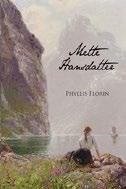
Florin’s historical novel fictionalizes the life of her Norwegian greatgrandmother during courtship, marriage, and years of motherhood.
In the late 1800s, Mette Hansdatter, an impoverished, fatherless 17-year-old girl, serves as a farmhand and weaver to support herself and her mother. Mette and her childhood companion, Finn Olesson, fall in love and plan their marriage. He will soon immigrate to America and call for her with a ticket overseas. However, her fear of family tensions, and her fear of God, lead her to make heartbreaking decisions to stay near her mother and on Norwegian soil. Florin’s story ably explores themes of free will and determinism, the heartbreaking life of women in agrarian societies, and dogmatic interpretations of divine will. It also serves as a tragic narrative of hardscrabble motherhood, the loss of children, and the experience of catastrophic postpartum depression and mental illness. But the book also has many beautiful descriptions of the Norwegian landscape, as when Finn, early on, observes the sea as he thinks of soon leaving the country behind him: “The afternoon sun glinted off the surface of the water where two grebes floated. Fimreite mountain rose on the other side, now thick with cloudberries, and the air was rich with the smell of the sea and the sweet musty fragrance of the hay that dried in the fields.” The author also beautifully weaves Norwegian folklore into the story and skillfully presents Mette’s interior conflicts, smartly building a sense of tension throughout. The story limns the lives of women when they were expected to serve their husbands, and when many left all decisions in life to God and authority. Florin treads gently, fostering a sense of hope as Mette demonstrates her artistry as a
weaver. She also effectively nods toward aspects of age and mental health that remain underdiscussed, even in the modern world.
A beautiful yet harrowing narrative of a difficult existence.
Gadeken, K.R. | Self (331 pp.) | $20.00 $13.99 paper | June 2, 2024 9798990421318 | 9798990421301 paper

In Gadeken’s YA debut and prospective series launch, people survive on a strange planet with no recollection of how they got there.
Eighteen-yearold Eff Sharp has no idea how she wound up stranded on an unknown world. She has only “snippets” of memories of Earth and her parents, but this is definitely not Earth; an orange dwarf star paints the sky a marigold hue. After three months of solitude, she’s shocked to see other humans—two men, who take her back to their colony, Nabukko. The colony is inhabited by a few hundred people who, though they remember more than Eff, they don’t know the circumstances that led them to this planet. Eff gradually befriends the colonists, helping to forage for “anything edible” and scavenge for supplies. She finds herself drawn to a couple of guys who open up to her. That’s quite a feat, as most of the Nabukko residents are reluctant to divulge anything about themselves or where they’re from. This lack of candor ultimately leads to a startling revelation and ensuing accusation. Gadeken’s story thrives on mysterious details, from seemingly random pods housing supplies to the colonists’ evasive responses to virtually all of Eff’s questions. While not all of her questions are resolved in this series opener, some answers come to light, and not just in the final act. The enormous cast comprises a bevy of distinct personalities. An understated love triangle serves as an effective backdrop
for discussions about survival, the protagonist’s slowly returning memories, and Eff’s vibrant, bizarre dreams and visions. The author masterfully depicts the environment, including the dense Black Forest and Nabukko’s well-constructed buildings (as well as signs of the planet’s unnerving creatures). The prose brims with vivid metaphors—pipes running between tanks in the hydro and aquaponics building resemble a “sea of mechanical jellyfish.” The astonishing ending will leave readers craving a sequel. Superlative characters and worldbuilding ensure this SF tale will linger for some time.
Giroux, Eric | New Salem Books (306 pp.)
$17.95 paper | June 18, 2024 | 9781734224047

Working for a newspaper changes a misfit girl’s life in many ways in Giroux’s novel. Pennacook, Massachusetts, is a town beset by constant floods in which menacing wild boars roam the streets/canals, people ride balance-bikes or pedal boats, and grocery store robots have banded together in the woods. Readers meet the novel’s protagonist, Wendy Zhou, during her difficult middle school years—Wendy’s father has recently died, no one in Pennacook can pronounce her last name, and her coming out as gay during a school dance goes disastrously wrong when her crush rejects and insults her. Writing for the Pennacook Beat newspaper gives Wendy a purpose, and she and the other kid reporters in her school-sponsored program uncover a case of corruption revealing the reasons for the floods and hordes of feral pigs—and the truth behind an idealistic-sounding scheme to cover the town with a giant dome. Interspersed with teen Wendy’s exploits are depictions of Wendy in the year 2032 as she nears college graduation. Both Wendy and her Pennacook
Beat editor, Graham Bundt, are flawed characters, but the author makes them likable by showing their growth.
Graham has a drinking problem and allows the newspaper to be co-opted for propaganda, but he’s worth redemption—he inspires kids to write and cares about the town he inhabits.
Wendy can be unkind to her mom; she’s also an unreliable narrator, revealing late in the story that she has lied about some of her personal details. Still, the reader is on Wendy’s side when she learns to care deeply for someone and discovers her own strength. Though the story is frothy, Giroux embeds many serious themes in the narrative, including self-acceptance, suicide, sexuality, and racism. The book also convincingly explores the fragility of democracy, which is threatened in Pennacook. As Graham observes, quoting his hero, John Adams, “There never was a democracy yet that did not commit suicide.”
A strange and fluffy confection with a thought-provoking core.
Haynes, Stan | Self (354 pp.) | $17.99 paper March 27, 2024 | 9781737766957
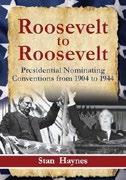
Hay nes presents a detailed account of the U.S. presidential nominating conventions and candidates from 1904 to 1944, with a particular emphasis on the Roosevelts. The author, a former trial attorney, opens with the event that would change American politics “forever”: William McKinley’s assassination and the subsequent swearing in of Theodore Roosevelt as the country’s 26th president. From there, chapters exhaustively cover the intrigues and anecdotes from every subsequent nominating convention over a 40-year
period. Lyrics to campaign songs introduce the sections, including gems like “Herbert Hoover promised us two chickens in each pot, / But breadlines and Depression were the only things we got.” The author discusses nominees for each party, as well as the sometimes dubious methods by which they were chosen—Franklin Roosevelt, for example, received swift backlash for trying to secretly change the two-thirds rule for the 1932 nomination, while Wendell Willkie, an active Democrat, managed to win the Republican nomination in 1940. Haynes also dives into the various social issues that affected each nomination process (such as the women’s suffrage movement and the voting rights of Blacks) and provides facts about the voting process itself. The book provides a truly astonishing amount of detail about the people, events, and settings for each convention, as evidenced by this description of Philadelphia’s Convention Hall (home to the 1940 Republican convention): “The arena, exposed to the sun during daytime, had a modest air conditioning system, but that provided little relief from outside temperatures that rose to ninety degrees on most days that the convention met, especially with more than 16,000 people packed inside. One observer called it ‘a filthy, sweaty hell of sealed-in heat.’” Some of these details may appeal to only the most hardcore history buffs, especially when delivered by the author’s largely dry narrative voice. But many of the anecdotes, like one describing alcohol flowing “freely for conventioneers” six months into Prohibition, paint a fascinating portrait of the time. A meticulously researched, thought-provoking look at the mechanics of American politics.
Hess, Jeffery | Down & Out Books
(294 pp.) | $21.00 paper
March 25, 2024 | 9781643963600

In Hess’ collection of short stories, folks dabble in assorted unlawful acts for a variety of reasons. In the title story, 15-year-old Jimmy relishes speeding down the highway in his uncle Billy’s Jaguar. Billy gives the boy access to things he can’t otherwise get, like beer. But when the uncle’s transgressions (namely what’s in the Jag’s trunk) put the boy in danger, Jimmy realizes he may need to find someone else to look up to. This collection’s 19 stories primarily take place in Florida across various eras, including the modern day, the 1980s, and the period of the Korean War. The tales feature a host of characters committing crimes, from participating in a prison riot (which becomes an inmate’s chance for escape) to a thuggish man’s revenge on the woman he believes cheated on him. “Barrow Girls” finds sisters Josie and Rachel planning an abduction, though their shared motive isn’t as venomous as readers may anticipate. Indeed, a handful of characters throughout the book become entangled in criminal endeavors through dumb luck. That’s certainly the case for Rand in “Young Sweedy”; he’s a hitchhiker who goes from passenger to getaway driver for the person who picks him up. (While he willingly turns outlaw, he questions
his choice once cops are in pursuit.) On occasion, crime enters the narratives in unexpected ways: “Calvin’s Storm” zeroes in on an intellectually disabled man who searches for his sister’s cat outside despite a lightning-heavy rainstorm. His sister and caretaker, desperate to track him down before he’s hurt, makes an unusual decision to get the help she needs.
Hess’ largely appealing cast brightens many of these stories of malfeasance featuring threats, violence, and even murder. “Stealing Sunshine” introduces Natalia, a career thief whom a reputed bounty hunter sniffs out; she opens the tale in the guise of Sunshine the Clown, shod in floppy shoes and donning a pink wig. In the novella-length “Brahman Manor Breakdown,” con artists Sam and Rachel are akin to regular working Joes as they yearn for a vacation after eight months of nonstop hustling. Scotland Ross, who headlines his own series of books written by the author, pops up in more than one story, including the wonderfully noirish “Kyla’s Condition.” In this yarn, Scotland, on the day of his prison release, joins his safecracking pal Tommy in knocking off a casino located shockingly close to the penitentiary. The author’s taut, unadorned prose energizes the stories with swift action, rapid-fire dialogue, and an unwavering pace: “I finger the Zippo faster and faster in my pocket. I flip it open, flick the wheel. Feel the heat. The guy with the gun steals a peek over his shoulder toward the island and then levels the gun back on me.” Several of the stories clock in at only a few pages, but that’s plenty of space for Hess to deliver keen insights into his remarkable cast. Charismatic characters breathe life into these engaging crime stories.

Jimerson, Micheal E. | Elwood Jimerson Farms (310 pp.) | $24.99
$19.99 paper | June 11, 2024
9798218409852 | 9798218377724 paper

Murder, meth, and matrimonial discord bedevil a former Texas Ranger in Jimerson’s second series mystery, following White Gold (2022).
Fifty-something E.J. Kane, a former Texas Ranger and now head of security for Devekon Energy, has an arthritic knee, a stressful job, and a damaged family life. The death of his son, Konner, a Marine who died while deployed “half a world away,” marked the beginning of the unraveling of E.J.’s “quilt of a perfect family.” He and his wife, powerful trial lawyer Rebecca Johnson, divorced after the tragedy. E.J. also rescued their daughter, Sharla, a meth addict, after she was abducted and raped by sex traffickers; she now struggles with whether to get an abortion. Because of his difficult family situation, E.J. identifies with the Blakes, whose daughter, Melinda, was murdered a year ago. Crooked Sheriff Benjamin “B.B.” Berryhill can’t be bothered with the Blakes’ unsolved case, but B.B.’s son, a police detective, vows to help, as does E.J. Meanwhile, E.J. is consumed by the fact that Aryan Triangle member and murderer G.H. Burton has been released from prison; his conviction—hard fought by Rebecca—was overturned. This character-driven novel is just as much a tale of family troubles as it is a mystery. A familiar story of meth addiction affectingly spills across the pages, as does the pain of a divorce that one side doesn’t want, in addition to problems of aging. The book’s initial fast pace establishes E.J.’s gruff but helpful character, but he also questions if he’s a lawman who’s outlived his era. The dialogue stays sharp, and descriptions can be strong (“He carried her like a sack of feed swinging wildly”). One
flaw is that so much of the story relies on readers knowing what happened in the previous book in the series—or at least requires Jimerson to recap those events. But the author, a Texas attorney, has the real-life experience to back up his storyline, and he gets bonus points for referencing Chuck Norris.
A well-paced thriller that engagingly tangles its hero’s personal and professional lives.
Kalfel, Jesse | Fulton Books (526 pp.)
$27.95 paper | June 1, 2023
9781639859009 | Series: Fenn Cooper, 1

A freelance journalist’s latest assignment threatens to give new meaning to the word deadline when he comes upon a murder mystery with century-old roots. New York reporter Fenn Cooper is desperate for a story with “a wow factor,” something his editor calls “grab-me-by-the-balls oomph.” His latest—interviews with sex workers about why they do what they do—did not cut it. “Your next story needs to hit the ball out of the park,” Cooper’s editor demands before assigning him a piece about the last vestige of the traditional three-ring circus: the one-ring traveling circus. Easy peasy? Anything but. Meanwhile, in California, executive Marvin Brinks faces his own deadline desperation. He’s been embezzling from his Hollywood studio to finance his expensive lifestyle and obsession with acquiring fine art and rare books. The plot thickens when Brinks learns that Chinese bankrollers are interested in investing and will want a look at the studio’s finances— he has one week to cook the books. The storylines converge when Cooper meets a denizen of the midway with distant ties to Brinks’ studio and an old contract that threatens to expose Brinks’ crimes, prompting the
executive to hire an assassin to find the contract and eliminate anyone connected to it. Kalfel introduces a problematic protagonist in Cooper, a commitment-phobe who is not above cheating on his latest girlfriend with the sex workers he’s profiling. A “charming bastard” is still a bastard, and this one has an off-putting predilection for socially inappropriate remarks. Once readers get past questions about why Cooper would spend hundreds of dollars of his own money on a spec story, or why he doesn’t try to sell it to another outlet when his editor turns it down, the plot kicks in with a vivid evocation of circus life and some finely etched characters, including a diminutive fortuneteller and a sideshow act with some serious baggage.
Step right up for a sometimes cliched, sometimes surprising murder mystery.
Kerl, John | Bowker (93 pp.) | $7.50 paper April 22, 2024 | 9798990179813

Kerl’s poetry collection offers snapshots from a man’s life. The author explores the landscape of human experience and the physical world in this book of poems that span several decades. From the start, Kerl identifies himself as someone who prefers to “amble slowly under the murky sky / and stark black-green / branched and leafy silhouettes” and ponder the “muted brilliance” of the moon (“Shades of grey”). In “Spring,” he struggles to focus on the “dry pages” of a book when “spring comes blowing, / all overhead and through me.” Soon, a stranger with “dark brilliant eyes” and a “slightly smiling glance” catches the speaker’s eye. But the pursuit of love also brings anxiety; he worries, “It’s too soon / It’s too late / It will end badly / It will begin badly / Someone, somewhere, will laugh at my audacity”
(“Complexity”). As a parent who thought he would teach his child about life, he instead finds he is the one learning from his “young one.” The poet ends on a peaceful note, sitting on a pier with a lover the same week he receives the news of a forthcoming grandson. Kerl’s language is approachable but his imagery is intricate—he describes raindrops that “landed with tiptoes / to shiver silver and soft in the porchlight” (“Porchlight”) and stars that “showed wan and flat on the pallid sky” (“Not much”). The author is equally adept at describing people, recalling in “Simplicity” a woman whose “eyes are cool opals / set in the midst of a sea of desire.” The only superfluous elements of this book are the dates on the poems (each reads as timeless) and the author’s “apology” explaining what he left out. A deeply evocative poetry collection that awakens the senses and touches the heart.
LaBrie, Aimee | Leapfrog Press (208 pp.) | $16.95 paper
June 11, 2024 | 9781948585927

LaBrie’s collection of misanthropic short stories offers meditations on death, dying, grief, and organ donation. These stories contemplate and analyze the human condition from a somewhat depressive perspective. The author speaks to a variety of contemporary topics, from the perils of dating and loneliness (as in “The Double Negative
Boyfriend,” “I Know What You Want to Do,” and “Advice to the Love Loin”) to melancholic interpretations of topics such as motherhood (“Feral”) and body image (“Pygmalion, Before and After: A Weight Loss Journey”), to contemporary human-pet relationships (“Feral,” “Animal Shelter,” and “How to get rid of an elderly dog”). Each story is deliciously heartbreaking and rich in lonesome imagery; most captivating is a too-brief series of seemingly related, though never explicitly linked, tales exploring the experiences of nurses, grieving families, and transplant coordinators. The first in the sequence is “What We Learned,” which details a list of more granular tasks expected of nurses (“how to start a catheter, how to handle hypothermia to avoid amputation, how to stay alert with handsy doctors, how to buy work shoes that won’t raise blisters on your heels, how to nap while standing”). This list evolves and overflows into “Rage,” in which a nurse at an eating disorder clinic must cope with the stress of working with profoundly ill patients, and rein in her tendency toward anger and gallows humor. The end describes an altercation between the protagonist and an unstable man on a subway car; the book seamlessly transitions into “The Eyes Stay,” a story told from the perspective of a grieving mother whose son has just passed from traumatic brain injury. The focus effectively shifts to the transplant coordinator and her compatriots in the following two stories. Though brief, this segment of the book shines as a compelling glimpse into medical care, mortality, and the grieving process: It’s cathartic while maintaining LaBrie’s characteristic wit and irony.
Exemplary storytelling that grapples with important themes.
A vivid portrait of a man’s life that’s by turns rollicking and soulful.
DEALS, DANGER, DESTINY
LaCasse, John & Barbara Kindness
Sunbury Press (302 pp.) | $24.95 paper
July 29, 2023 | 9798888191064

Businessman
LaCasse, with co-writer Kindness, looks back on luxuries and tragedies with lots of philosophizing in this freewheeling memoir.
LaCasse recaps episodes from his long work life, including a stint as a radio broadcaster in the British Virgin Islands, from which he was deported after he reported on corrupt land grabs by American gangsters. He also tells of his time as a warehouse worker at a U.S. Army depot, where he made fake shipments to Vietnam to ensnare black-market criminals who were selling American equipment to the Viet Cong. Much of the book covers LaCasse’s career as a Seattle yacht broker of luxury vessels. After selling his brokerage, LaCasse turned to academic pursuits, getting kicked out of several universities for arguing with professors before earning a doctorate in education from Northcentral University’s online program. The book switches gears in later chapters, which comprise a whimsical conversation between LaCasse and the spirit of St. Thomas Aquinas—with the devil occasionally chiming in—at a cafe in Paris, where they discuss his life, dualism, quantum mechanics, and various platonic soul mates that the author has met via his podcast, Tension . LaCasse’s narrative is a ramble of shaggy-dog anecdotes, most good-natured but some fraught, such as one about a time when he prevented a suicidal person from diving off a Seattle bridge. The author’s voice is colorful and acerbically funny when relating the antics of a rich man who “walks his wife down the ramp to see the astoundingly impressive mega yacht he just purchased, and she refuses to step on board. ‘It’s ugly,’ she says. Sam turns to me and says, ‘Sell
it ,’ and they walk back to their car.”
But the book also has plangent passages of loss and remembrance, as when LaCasse recollects his son Jeff’s death following a car crash. The result is a lively and absorbing read.
A vivid portrait of a man’s life that’s by turns rollicking and soulful.
Lezotte, Suzanne | Aristata Press (228 pp.)
$26.80 | $14.44 paper | Oct. 21, 2023 9798987852439 | 9798987852422 paper

Former journalist Lezotte offers a memoir of how her family’s lives changed after her child’s unexpected diagnosis. When the author’s infant son, Owen, was 7 days old, doctors told her that he had Down syndrome. She quickly found that she was subtly distancing herself from her child, even in her choice of words when referring to him; for example, she told an old friend, “the baby has Down syndrome” instead of “ my baby.” She attempted to transform her thinking, but she found it difficult; she writes that her husband, Erik, celebrated that Owen had “won the prize of life,” but she privately felt that “maybe it would have been better if he had died.” It was a startling and shocking thought, and it led her to change her attitude toward her son: “I knew deep down there was a reserve in me that would rise up to become his greatest ally and his fiercest bodyguard.” Her sister Marie’s comments were convincing: “You know, it’s time you got over it. He’s here. He has Down syndrome. Deal with it.” Later, when Lezotte found that special-education students in a local school were being separated from the rest of the student body, she asked herself what was best for her child while also engaging in self-analysis: “Was fighting for inclusion for me, so I could toot my own horn
and be the hero of the story?” The searing honesty of this and other moments in Lezotte’s memoir makes it a worthy read, and it gives the work a feeling of authenticity and transparency. For example, the author writes that she encouraged Owen to attend a high school dance without a date, which paid off when he mingled with a group of fellow single guys; it’s an appealing, genuine scene, and it’s one that, the author writes, galvanized her faith in her son. Although the writing sometimes lacks specificity, such as a sparsely described scene of a dinner in Venice, Italy, the memoir makes up for it with its bravery and frankness.
A candid story of one mother’s rocky parenting journey.
Licuanan, Brian F. | BL Press and Publications (274 pp.) | $24.99 paper May 1, 2024 | 9798987830987

Licuanan offers a comprehensive guide to providing help to people who don’t necessarily welcome it. In his nonfiction debut, the author, a psychologist and educator, discusses the vital importance of what he calls an “impact person” in substance abuse recovery—the term refers to involved individuals “with the ability to help, assist, or change someone’s life for the better.” Licuanan clarifies that there are limits to what such people can do; the author stresses the importance of drawing a clear “We are done” line in the sand, setting a boundary past which “you are simply finished supporting their unhealthy lifestyle.” Licuanan’s overview encompasses both mental health disorders (including schizophrenia and PTSD) and substance abuse
disorders (involving alcohol, methamphetamine, and other drugs) and draws on his experience dealing with such clients and the people in their lives. Rather than providing specific intervention techniques for any of these situations, he offers a more general set of tools, including active listening, empathy, and the setting of healthy boundaries, all designed to help families and other “impact people” in what the author refers to as “the Pre-treatment Zone,” in which people are desperate to get their loved ones into some kind of treatment. (“The support system in the Pre-treatment Zone is experiencing intense fear, anxiety, loss, confusion, and desperation. They may believe their loved one is no longer able to care for their basic needs adequately and might be in danger of harming self or others.”) Licuanan breaks down all of his advice very clearly into a great many practical necessities, with key tasks in the process delegated to the “captain” and the “co-captain” of the assistance team, along with the whole coalition of assisting individuals. (These tasks can involve preparing backup plans and contingencies in case law enforcement has to be involved.) People in these helping coalitions will find Licuanan’s combination of optimism and pragmatism invaluable; this book is full of very useful wisdom.
A clear and essential guide to helping loved ones when they hit rock bottom.
Kirkus Star
Mermin, Rob | Illus. by Karen E. Gersch
Rootstock Publishing (340 pp.)
$19.99 paper | May 28, 2024 | 9781578691562

A personal history of the modern circus by a circus performer and owner. Mermin, who “ran off to join the circus” in 1969 and
A wise, insightful, and always-entertaining recollection of a journey of self-discovery.
DANCING ON COALS
founded his own circus, chronicles life under the big top. The author recounts having to convince his skeptical mother of the worthiness of his ambitions; her dismissal inspired the name of Mermin’s own show, Circus Smirkus. This memoir begins with stories of Mermin’s participation in late-20th-century European circuses, such as Circus Benneweis and Circus Hoffman, and includes photos at the beginning of each section and Gersch’s sketches of clowns, tents, and other circus elements. Throughout, Mermin highlights his relationships with well-known performers, especially his mentor, the renowned mime Marcel Marceau (who never performed with a circus until Mermin persuaded him to perform in Circus Smirkus). The author catalogs the early years of building Circus Smirkus, a small Vermont-based affair that followed the model of traditional European circuses and employed young performers. One of the most interesting elements of the book charts how Mermin fostered a glorious multicultural stage, inviting “coaches and circus kids from Russia, Latvia, Ukraine, Mongolia, Kazakhstan, Hungary, Georgia, Moldova, Canada, China, Cuba, Brazil, Indonesia, Israel, Palestine, Ethiopia, Great Britain, New Zealand, states from all around the US, as well as ten First Nation tribes, the Sioux, Yakama, Hunkpapa, Cree, Santee, Dakota, Oglala, Navaho, Azteca, and Cherokee.” Mermin also includes his own “coming out” as Jewish to an antisemitic fellow performer. One glaring oversight— the memoir pays scant attention to controversies over circuses, particularly the abuse of animals. Circuses
continue to evolve, however, and Mermin reassures readers that the circus as an art form is very much alive, noting that his own circus will continue on after his retirement. A fascinating tour de force that displays the enduring, unique appeal of the circus.
Michaels, A.B. | Red Trumpet Press (466 pp.) $16.99 paper | May 21, 2024 | 9781733786348 Series: A Barrister Perris Mystery, 1

Early-20th-century San Francisco is roiled by a streetcar workers’ strike and a related murder in Michaels’ mystery novel.
Jonathan Henry Perris left a successful law practice in England for the excitement of San Francisco, a city racing to rebuild after the disastrous destruction of the 1906 earthquake. He has opened a small law practice, Jonathan Perris and Associates, and staffed it with two fresh-out-of-lawschool attorneys, Cordelia Hammersmith and Oliver Bean; Dove Rebane, a private investigator; and office manager Althea. Of late, Jonathan has been dating the beautiful Austrian heiress Magdalena (Lena) von Mendelssohn, who, he learns, is a woman of many secrets (“She and Jonathan had struck up a conversation and discovered they did indeed have some overlapping interests, not the least of which was a healthy physical attraction to one another”). In the early-morning hours following Jonathan and Lena’s evening of theater and dinner, the police come
to Jonathan’s house and arrest him for Lena’s brutal murder—her body has been discovered on the floor of an infamous bordello, with Jonathan’s card and a ticket stub found in her pocket. Meanwhile, a trial involving a murder that took place during a riot by striking streetcar workers has just concluded with the conviction of a young man, Emmett Barnes; Jonathan’s firm is hired to handle Emmett’s appeal. As the team investigates, they find the two cases beginning to overlap in unexpected ways. Michaels’ action-packed mystery boasts a wealth of back stories, possible suspects, and potential motives. The author has assembled a rogue’s gallery of blackmailers, corrupt politicians, artistic socialists (who call themselves “the Incendiaries”), and jealous lovers. Cordelia emerges as a formidable protagonist, and Jonathan has a backstory that’s only partially revealed, paving the way for a potentially intriguing sequel. Several unexpected turns of the plot and a voluminous list of characters threaten to make the narrative unwieldy, but it is held together by solidly composed prose, a bit of humor, and a sprinkling of historical tidbits.
A sturdy series opener, with two engaging central protagonists and a few surprises.
Moore, Cynthia | She Writes Press (175 pp.) | March 1, 2025

Moore presents a wide-ranging memoir as an artist, spiritual seeker, and overachiever. The author was a child living in the Bahamas when local Bahamians were “rebelling against three hundred years of British domination”; in response, her English mother and stepfather moved the family to Geneva in 1963. There, Moore was enrolled in a finishing school that she found cold,
gray, and stodgy. She resolved to make the best of her situation with a plan: “I conclude that henceforth, I must be the best. I must be so exceptional that no one will overlook me.” Several years later, when she was 19, this drive led her to train in a revolutionary form of physical theater in the Netherlands, which involved regularly flinging herself across the room, into walls, and returning to a primitive state for an attentive audience. Soon, however, she’d had enough of the avant-garde theater world and decided to leave for a few years; she joined another theater group in the San Francisco Bay Area in 1973—this time, to great success. Slowly, however, Moore experienced an awakening by reading the works of various female writers (including Virginia Woolf, Colette, and Anaïs Nin), moved into solo shows, and eventually left the theater world behind. Throughout this book-length exploration of her personal growth, Moore details her relationships with neurotic, artistic men before she decided to marry an auto mechanic, settle down, and have two children. Moore presents an account of quite a notable life spiked with sharp, often funny dialogue, whether she’s detailing the initial courting of her husband or her first sessions as a therapist-in-training later in life: “‘Tell me what’s happening,’ I murmured in a soothing tone, holding my chin in one hand and crossing my legs so I would at least look like a therapist.” Moore frequently recounts experiencing profound moments, seeming to come to grips with great revelations—only to carry on with her life as before. For readers, though, this habit is not frustrating but relatable, and those taking note will walk away with some wisdom.
A wise, insightful, and always-entertaining recollection of a journey of self-discovery.

Perron, Mike | BookBaby (270 pp.)
$60.00 paper | May 3, 2024 | 9798350946956

Perron, an entrepreneur, shares the advertisements he believes were key to his success.
In 1995, the author opened a paint store, The Paint Depot, in the U.S. Virgin Islands, a small territory that, at the time, had a population of a mere 60,000 people. Nevertheless, he quickly built the business into a highly profitable one—10 times more profitable per employee than the average American retailer. A former copywriter, Perron asserts that the store’s success was the result of relentless advertising campaigns (he reports that he spends more on advertising than all of his competitors combined). The advertisements themselves are aesthetically uncomplicated. Nearly all of them follow the same style: Unadorned by any pictures, they combine bold headlines and logos with dense blocks of text. Within this format, the ads are surprisingly inventive and humorous—the author characterizes them as the result of “sustained creative thinking.” During an election season, he ran mock political ads pitting his two brands of paint, Benjamin Moore and Martin Senour, against each other. At another time, he ran personal ads under their names. (“Single gallon looking for married couple. If you’re into a little roll on the walls call me. Martin Senour.”) As the title of the book promises, the text includes more than 200 examples of Perron’s ads, which are entertaining but finally become exhausting to read. However, one shouldn’t read the book for its entertainment value alone—in these pages, the author provides a veritable master class on the power of advertising. From his running commentary on the ads emerges an accessible tutorial on the craft of copywriting—he articulates helpful guidance on how to grab a prospective customer’s attention
and what to do with it once one has it. This is a deeply informative and practical guide that should be of great value to any business owner. A helpful introduction to commercial advertising.
Rice, Dan | Wild Rose Press (400 pp.) | $19.99 paper | June 19, 2024 | 9781509254675
Series: The Allison Lee Chronicles, 3
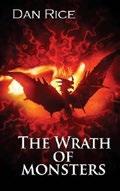
A girl finds herself and her friends caught up in a war between monsters and faeries in Rice’s YA urban fantasy novel. In this final volume of the Allison Lee Chronicles, the titular character is under virtual house arrest. The authorities fear her because she’s a half-skaag, the offspring of a human father and a skaag mother (a skaag is a cross between a supersized alligator and a gargantuan eel). That’s not all that’s making Allison discontent: Her young faery friend Bria is being held at a military base. Her ex-boyfriend, Haji, then blows up his house with magic and gets shipped to that same base. Allison secretly gives an interview to a reporter about the interred children to generate a public outcry, but it backfires when the faeries attack the base to take back Bria. After a power outage hits the West Coast, it’s traced to magic being used near Mauna Kea, Hawaii. War breaks out between the faeries and the skaags. With Bria and Haji still recuperating, Allison, her father the archmagus, her human friend Dalia, and the dragon Dr. Radcliffe must pick a side. They reluctantly ally with the faeries—even if they can’t be trusted—because “if the skaags win, they will end humankind as we know it.” Rice succeeds in making this installment of his YA series accessible to readers old and new, blending in enough backstory from the first two books for new readers to hop on without getting lost amid the ample
cast. This approach is essential—a lot happens in this jam-packed opus. Foremost in Rice’s narrative is the theme of Allison and her friends fighting the urge to become monsters, real or figurative. Like many teen girls, Allison also spends much time wrestling with her feelings for her romantic prospects, whether it’s her ex, Haji, or her crush, Jett. The story stagnates somewhat during the repetitive, extended battle scenes, but Rice’s characters sparkle as they bring this adventure to a satisfactory close. A sharp cast and absorbing monsters help this series entry to shine.
Seeripat, Arvashni | Self (280 pp.)
$18.00 | $12.99 paper | April 12, 2024 9798989650927 | 9798989650903 paper
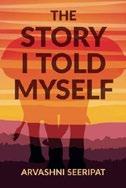
In Seeripat’s novel, a desperate Indian woman on the run with her two small children pays a steep price to keep her family safe from the horrors of indentured servitude.
It’s the late 1800s, and the only chance that Shivali Tewari and her family have at survival lies far away on a South African sugar cane plantation in Port Natal (now Durban), where they hope to find work as laborers Fleeing the misogyny of her native Indian village of Ishapur, Shivali lives only to protect her daughter, Uma, and son, Hari. Although she’s plagued by guilt after killing her violent husband, Shivali will kill again if she must. For weeks, the family bears the oppressive confinement of the holding yard, waiting for the S.S. Umzimkulu to finally fulfill its quota of cheap human labor and set sail for the new land. However, the ship is a nightmarish place where “fights among men and the rape of women and men were regular events with consequences that would haunt us forever.”
Themes of brutality are contrasted with those of familial love and kindness throughout Seeripat’s often moving saga. Shivali, Uma, Hari, and newly adopted members of their ragtag family are sent to Thompson’s Farm upon arrival in Port Natal, and they spend the next 10 years attempting to pursue lives of meaning and purpose under the yoke of institutionalized racism and colonial degradation. Seeripat is especially effective at relating the family’s grim odyssey by alternating between the first-person perspectives of Shivali, Uma, and Hari; at one point, for instance, Uma reminds readers, “The English didn’t really want women on the plantations. They were scared we would have babies and then there would be more Brown people than white ones in Natal. Imagine the horror of Brown people taking over! ” Shivali’s inner turmoil is truly heartbreaking, and Uma’s unlikely romance with the plantation owner’s son, Richard, is rendered with all the beauty and ugliness that their world has to offer.
A deeply emotional story about the Indian diaspora.
Shapiro, Kim Herdman | Level Best Books (300 pp.) | $16.95 paper March 12, 2024 | 9781685126032
Series: A Wynter Island Mystery, 2

The murder of a starlet with a checkered past throws a small community into turmoil in Shapiro’s second mystery novel in the Wynter Island series.
As journalist Kate Thomas grabs her morning coffee, the first thing she hears is that TV star Rosalie Morgann is coming to town. Even more surprising to Kate is that Rosalie is actually Rose Morgan, a former Wynter Island, British Columbia, local who skipped town after having many affairs with married men. Rosalie wants to be interviewed on the local community television station CWYN, of which Kate is the manager. That request seems simple enough, but tragedy strikes when Rosalie suddenly dies on air, apparently poisoned by her own drink. Kate now turns sleuth, and every islander who had issues with Rose/Rosalie’s past behavior becomes a potential suspect. Shapiro does a great job of weaving together the many characters’ stories, and she gives them each distinct personalities; Kate describes the two town gossips at the story’s beginning thusly: “It would have been easy to place both of them in two white t-shirts with the words ‘Extrovert’ written on one and ‘Introvert’ written on the other.” She also pays careful attention to Indigenous characters living on the local Tsawout First Nation reserve, and she shows how such communities deal with entrenched racism, which adds an important dimension to the story. Occasionally, Kate is a frustrating protagonist; her investigation leads her to ask many questions and knock on many doors, but doing so makes her come across as an unlikable busybody at times. Some of her meditations are insightful, however, such as her reading of Rosalie’s character: “Forgiveness wasn’t necessarily her destination. Understanding her own failings and accepting responsibility for any harm she’d done was the point.” It’s this
A deeply emotional story about the Indian diaspora.
THE STORY I TOLD MYSELF
compassion that will compel readers to delve into the mystery alongside her. An often compelling whodunit with strong characterization.
Simoudis, Evangelos | Amplify Publishing (240 pp.) | $28.00 June 4, 2024 | 9798891380615

Simoudis presents a comprehensive discussion of the ways in which new technology will profoundly alter the automotive customer experience. According to the author, the managing director at Synapse Partners, the automotive industry is entering a “period of radical transformation” largely driven by the ecological concerns of consumers who desire less environmentally harmful vehicles. This gathering demand has spawned a new generation of vehicles based on alternative fuel powertrains as well as vehicles whose functions are primarily enabled through software. Per Simoudis, however, the automotive industry has yet to fully capitalize on the opportunities this new consumer landscape offers; as more vehicles are equipped with sophisticated AI technology, manufacturers will more effectively collect and analyze customer data. The data the author has in mind is far-ranging—the full spectrum of “predicted mobility-related customer needs,” including information about trips and destinations, spending habits, and even the use of public transportation to complete a journey. This move to “customer-centricity” fundamentally shifts the relationship between a manufacturer and customer—the former becomes the steward of a “cradle-to-grave vehicle journey” that only terminates when the customer ceases to own the vehicle and covers every feature of the vehicle. Simoudis assesses the significance
of this emerging “flagship experience” with encyclopedic thoroughness, covering its technological, economic, and organizational features with impressive clarity and rigor. The author also lucidly unpacks the philosophical underpinnings of the shifts in the industry, identifying a “new mobility” movement that places greater emphasis on safety, environmental responsibility, convenience, and affordability. A conspicuous omission is the absence of any sustained discussion of the dangers posed to consumers by making even more of their private data minable for profit, a crucial issue of the day. Still, this remains an indispensable text for anyone interested in the automotive industry.
An impressively expert introduction to major new trends in the car business.
Sisco, Cody | Self (402 pp.) | $19.91 paper | Aug. 16, 2024 | 9781953954077

In Sisco’s speculative novel, a young man who wants to find his grandfather’s killer is deemed a threat due to his mental illness.
Several years ago, in an alternate history set in the “American Union of Nations,” a man with a mental illness known as Mirror Resonance Syndrome (MRS) killed people in an act of chaos and extreme violence in the town of Carmichael. In the incident’s aftermath came the Carmichael edicts, which have since subjugated those with MRS (sufferers are hyperemotional and prone to daydreaming and periods of mental blankness) to being treated as less than human, looked at with suspicion, and forced to live on “ranches” they can never leave. Despite being part of the famous Eastmore family (his grandfather, Jefferson Eastmore, cured cancer), Victor has effectively had his life stolen from him due to his MRS diagnosis. Jefferson died recently, and Victor believes he was murdered—maybe even assassinated—and he wants to find out
who was responsible. Victor’s mental illness may be the key to the mystery; his friend Ozie tells him that Jefferson was trying to challenge the status quo for the treatment of those with MRS (he wanted to find a cure), a position that’s widely considered radical and may have made him some enemies. The country is also beset by the rise of addiction to drugs known as stims, which have had serious, ongoing consequences for people like Victor’s friend Elena (“She could tell him about the flood of stims the Corps had unleashed to hook as many people as possible”) and, by extension, Victor himself. Sisco has created an immersive cyberpunk world as the setting for an elaborate murder mystery and conspiracy thriller; the copious amount of worldbuilding detail is truly impressive. Victor is a relatable hero with eclectic friends in Ozie and Elena (as well as an herbalist, Pearl, who aids him in dealing with the symptoms of his condition). The world and the characters work together to effectively form a cohesive story about how easy it is for society to classify a group of people as dangerous outsiders. A fantastic SF thriller with a sincere and important message.
Slomba, Gregory S. | Illus. by Emily Hurst Pritchett | Self (199 pp.)
$21.99 | $12.99 paper | April 15, 2023 9798391451617 | 9781461003618 paper Series: Sharky and the Jewel, 1

A boy is sent to an alternate universe to fight pirates and save a world in Slomba’s middlegrade fantasy. Twelve-year-old Eric, camping out in his backyard, jolts awake from the recurring nightmare he’s had ever since his father’s death, the result of a fall during a hiking trip they’d taken together. That’s when he sees a large, white owl, perched on the oak tree above him. Introducing himself in fluent English, the owl says his name is Stig and that he’s there to bring Eric to the Gatekeeper, the
overseer of doors leading to other worlds. Eric and Stig, it transpires, have been chosen to save a fishing village held captive by the evil pirate Captain Sharky. If they fail, the village—and that entire world—will succumb to the “darker power” that has kept Sharky alive for hundreds of years. Eric and Stig’s arrival in the village strikes the mayor’s spirited daughter, Kate, as the fulfillment of a legendary prophecy about two “Deliverers” destined to come save them from the pirates. This stirring fantasy brims with high-stakes action and is humanized by smart dialogue (the loquacious Stig adds humor) and deepened by rich backstories and father-son conflicts, including Eric’s internal struggle with guilt over his father’s fall and a dwarf father’s rejection of his son, Hallo, who is Eric’s new friend. The author’s detailed worldbuilding encompasses serious battle scenes on water and on land fought with a variety of weapons, a lavish dwarf kingdom under the towering Iron Mountains, and a bleak landscape permeated by “the dry smell of the dead forest” and home to monstrous bat creatures. It is there that Eric, Stig, Hallo, and Kate go on a quest for a legendary jewel with the power to defeat the pirates and cleanse the darkness threatening the world. With more doors to other worlds to explore, it’s a good bet that Eric and Stig will be back.
Imaginative, character-rich, and lively—a promising start to a new fantasy series.

Stagner, Patsy | BookBaby (270 pp.)
$14.99 paper | June 6, 2024 | 9798350947991
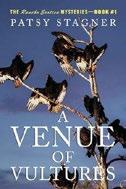
In Stagner’s mystery novel, a pair of retired sisters find a dead body on their property and become the prime suspects in a murder investigation.
Sisters Claire Browning and Avery Halverson decide to retire from their stressful jobs as legal assistants to a quiet home in rural East Texas nestled within a gated community called Rancho Exotica. Their bucolic tranquility is shattered when the book’s titular “venue” of vultures leads them to a dead body in a densely wooded section of their property. The deceased turns out to be a neighbor, Thorne Mondae, who was clearly murdered—he was found with a hunting arrow lodged in his heart. Because Claire recently had an angry confrontation with him (she yelled at him for trespassing on her property while hunting), she becomes a person of interest in his murder investigation. She’s so fretful she’ll be arrested that she withholds from the police a video her trail camera took of the killer—a “shadowy figure” neither of the sisters can identify—since it captures Claire as well, placing her at the scene of the crime. Claire and Avery join forces with Jay Vidocq, the dreamy head of security at Rancho Exotica and a former Dallas homicide detective. As the investigation deepens, the list of suspects grows— Thorne turns out to have been an unsavory man with a dark past—and the relationship between Avery and Jay turns romantic. Much of this crime drama is
deeply formulaic and melodramatic; here, Avery explains her turn as an amateur sleuth: “When Thorne Mondae was murdered in our forest and we became suspects, our world turned upside down. We need to restore that world to its rightful position. That’s why I want so much to discover who killed Mr. Mondae.” But this delightfully cozy detective story, which is as humorous as it is intelligently conceived, does have a lightsome companionability to it. Readers who enjoy the work of Agatha Christie are sure to like this novel as well—it’s fun and largely undemanding entertainment. An engagingly witty whodunit brimming with inventive twists and turns.
Stewart, Geoff | Self (215 pp.) | $10.00 paper Dec. 10, 2021 | 9798782307653

This free-wheeling polemic argues it’s time for Australians to stand up to a corrupt establishment. Stewart begins by saluting the iconically plucky Australian populace—among them, pre-colonial aborigines, who lived a “culturally rich, refined and satisfying life”; later mavericks, from Robin Hood–like outlaw Ned Kelly to brassy feminist Germaine Greer; and the current crop of ordinary farmers, miners, small businesspeople, and innovators. Keeping this last group down, the author contends, is a rogue’s gallery of pernicious institutions. Pride of place goes to government bureaucrats—Stewart likens them to parasitic aphids. He also attacks the finance industry (“You puffed up, fat lazy arrogant bankers, you should not be proud of stealing the savings of trusting little old ladies”); schools that “force children to…grovel before the power of the state” until they become “frightened little snowflakes”; the “pustule of politicians” in Parliament; “young, green zealots” and their “loony, lazy, Lefty lamentations”; and British aristocrats, whom he calls “deeply flawed and
depraved dipsticks” who perpetrated a “genocide” on Australian soldiers by roping them into the world wars. The author’s argument leans right—he’s intensely skeptical of illegal immigration and big government—but he takes on concentrated economic power as well. Stewart lays out a vision of a society that’s autonomous and adaptable, structured not around centralized institutions but families and villages. He offers a raft of policy proposals, some wistful (banning lawyers from Parliament because they have a vested interest in passing complicated laws that provoke suits) and others more serious (the author suggests having companies run by German-style councils with worker representation). Stewart’s punchy prose revels in aggressive alliteration, but he also provides a thoughtful, probing social critique. (“Medical treatment is mistaken for health care, social work for the improvement of community life, police protection for safety, military poise for national security, the rat race for productive work.”) The result is a provocative challenge to Australia’s entrenched interests.
An energetic populist manifesto that scores hits on a wide range of targets.
Teacher Terrel & Ballerina Konora | Illus. by Stella Maris | Once Upon a Dance (36 pp.) $24.99 | $9.99 paper | May 21, 2024 9781955555944 | 9781955555937 paper
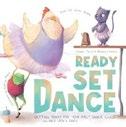
Teacher Terrel and Ballerina Konora, a mother-daughter duo known as Once Upon a Dance, portray the essentials of a first dance class in this picture book. Bella, a chicken, and her friend Quinn, a frog, are finally old enough to take their first ballet class. When they see the older students dance, they feel intimidated until they meet their teacher, Kittina, a cat, who reminds them that nobody’s that good on their first day. Kittina teaches the
kids some basic positions before they practice graceful movement with scarves and try leaping in the air like a frog: “Quinn, it’s not fair, stop showing off: you ARE a frog!” Maris’ whimsical pastel-and-pencil illustrations emphasize the characters and include tiny text that adds texture; as the class practices dance positions on a white background, each is subtly labeled—arabesque, releve —like whimsical, handwritten notes. The prose is cheerful and funny, as when the class’s length is compared to “the time it takes to eat ten plates of spaghetti.” The story also offers specifics that will help future dance students know what to expect, such as the “crawl test” to make sure the clothes they wear to class won’t get in the way. Overall, the story captures a sense of excitement and wonder.
A humorous, warm, and encouraging introduction to dance.
Towle, Sarah | She Writes Press (424 pp.) $18.95 paper | June 18, 2024 | 9781647425791

Towle, an educator and activist, confronts America’s immigration system in this debut non fiction book.
“Whatever the answer” to America’s immigration crisis, writes the author, “a dream deferred—dried up like a raisin in the sun—is indeed justice denied.” To refugees, asylum seekers, and immigrants from around the world, America has long stood as a haven of peace, prosperity, and freedom. Over the last two decades, however, the U.S. has been at the forefront of a new global paradigm that prioritizes national security above human rights, per Towle’s eye-opening narrative. Focusing on what she calls the “Border Industrial Complex,” the author outlines the ways in which the U.S. and Europe have forged a system of “global apartheid” through draconian visa requirements, passport controls, border walls, and other
anti-immigration policies. The book offers readers an astute analysis that provides a well-researched overview of the current immigration system as well as historical context for the ways in which racism and xenophobia have shaped American policy in the past. Bipartisan in her critiques, Towle traces the modern roots of America’s anti-immigration ethos from Reagan through Clinton to the post-9/11 Bush administration, though she also holds the Obama and Biden administrations to account for their subsequent complicity. The book stands out by centering the lived experiences of the victims of Immigration and Customs Enforcement (ICE), particularly the subagency known as Enforcement and Removals Operations (“aka ICE Air, ‘the deportation machine’”). Working with the Texas A&M University School of Law Immigrant Rights Clinic and the Cameroon Advocacy Network and privileged with white skin that allowed her to “cross borders with relative ease,” Towle shares her firsthand experiences at the U.S.-Mexican border, where she met freedom-seekers whose home countries spanned from Central America to Cameroon. The author’s observation that merely seeing and documenting the experiences of victims is a “subversive act” powerfully underscores the stories of mothers ripped away from their children, men detained indefinitely without due process during the Covid-19 pandemic that “turned prisons into death traps,” and asylum-seekers returned to the violent battlefields of war-torn countries. A powerful exposé of the human costs of America’s immigration policies.
Upton, Lee | Sagging Meniscus Press (310 pp.) $21.95 paper | May 3, 2024 | 9781952386893

A would-be biographer pursues two potential paydays in Upton’s comic novel. Tabitha Acrete is 50, divorced, and in need of
some cash. She’s a biographer by trade, and though her last effort— Annie: Her Life Story, about her deceased dog—was a flop, she has two prospective subjects who she hopes will rejuvenate her career. One is Brent Vintner, an actor “so good looking they should bottle that man and spray him on belligerent people as a form of crowd control.” The other is Piper Fields, a renowned children’s book author whose career has taken a hit since the discovery that she writes erotic novels on the side. Both Brent and Piper happen to be in Tabitha’s hometown of Midlothian for the next several months, which should give Tabitha plenty of time to pry into the recesses of their private lives. The only problem is that Tabitha’s past celebrity profiles were so poorly received that she’s basically blacklisted—a fact that she misrepresents to her publisher. As Tabitha attempts, with mixed results, to worm her way into the lives of Brent and Piper, she also grapples with the legacy of her deceased ex-husband’s ashes, the colorful patrons of her nephew Leon’s bar (called The End of the World), an unwanted intern, and the fact that she might not be a very good biographer at all. Upton’s prose is razor-sharp—as filtered through the unpredictable and slightly delusional perspective of Tabitha, it takes on a magical, frenetic quality. Here, Tabitha tries to justify why a biographer isn’t really a writer: “As a biographer I’m ferreting out truth, outlining a life until the contours are visible. It never feels like writing to me. I’m not inventing anything. I’m releasing a life, clarifying a life. I’m more like a painter or a photographer than a writer. I hardly even work in—in—words.” Though many madcap events occur, it’s Tabitha’s humorous and hypnotic voice that propels the story.
A delightfully meta novel about a woman writing her way out of calamity.

Walker, Keith | Saddle Road Press (140 pp.)
$20.00 paper | June 10, 2024 | 9798987954195

Walker’s debut poetry collection looks, in part, to the past for reflective verses on life, loss, and human suffering.
These short works tell a story—one that reads like a poetic family memoir, an account of grief and loss, a coming-ofage narrative, and vignettes of adult life and work. The book begins with childhood reflections and shares a raw, sometimes painful picture of an imperfect suburban existence in years gone by. It unfolds to glimpse attentively into the lives of people in pain, with each poem a tale unto itself. Rhythmic, thoughtful language contrasts gritty imagery of liquor stores, and factories, or of a deathbed, as in “The Baby Monitor”: “We bought a baby monitor to hear / my mother in her rented bed / in the living room. / Small red lights followed each breath.” Mortality whispers throughout the book, making an appearance every few pages as a stark reminder, while the author’s free verse poetry paints a grim picture of the world’s injustices. The final poems take a spiritual turn, reflecting on faith and religion, as well as poignant moments in nature, as in “Home Remedy for Writer’s Block,” which reflects on a pond: “Widening ripples / say something perfect / to something perfect / in you.” Walker’s works have a dreamlike quality, with images like scattered puzzle pieces, leaving questions lingering about the texts’ origin and meaning. As a snapshot of the Southern experience, with visits to the industrial North, the collection acknowledges the painful qualities of humanity while also holding space for the beauty of living. Overall, this book flows like a river, one poem into the next, creating a whole narrative that mirrors readers’ own fractured places.
A deeply reflective set of poems with a mature perspective.
Watson, Anne L. | Photos by Aaron Shepard Shepard Publications (74 pp.) | $25.00 paper Sept. 1, 2024 | 9781620356272

Watson, a writer of several books about innovative crafting, offers a thorough introduction to a clever new craft.
The author’s charming guide presents advice on creating decorations and useful household items from polymer clay with the help of an unexpected set of tools: cookie dough molds. The book, which is divided into two sections, is appropriate for crafters at every level. It begins with tips on materials, including a comprehensive list of mold brands and where to find them. Items like these are relatively uncommon in contemporary kitchens, but crafters who might be daunted by the idea of using them to work with clay will be reassured by Watson’s detailed instructions on their employment and maintenance. Readers will find it hard to resist Watson’s excitement throughout these pages: “It’s a match! Cookie molds and polymer clay are perfect crafting companions!” Still, her eager outbursts are tempered with levelheaded advice about clay safety and meticulously researched information about different types of materials, adhesives, and tools. In the book’s second part, Watson describes 32 projects that will allow readers to practice the skills they’ve just learned. They include an easy, one-piece Halloween basket charm and a more intricate majolica box, and each project’s difficulty is ranked on a scale from Beginning to Intermediate to Advanced. Shepard, Watson’s husband, has photographed her creations at every step of their construction, making even the most complicated projects accessible for ambitious crafters. With easy-to-follow instructions and more than 170 photos, Watson’s book is the authoritative guide to a relatively obscure crafting art, as well as a treat to read.
A comprehensive, organized, and deliciously readable manual that provides instruction with enthusiasm and ease.

